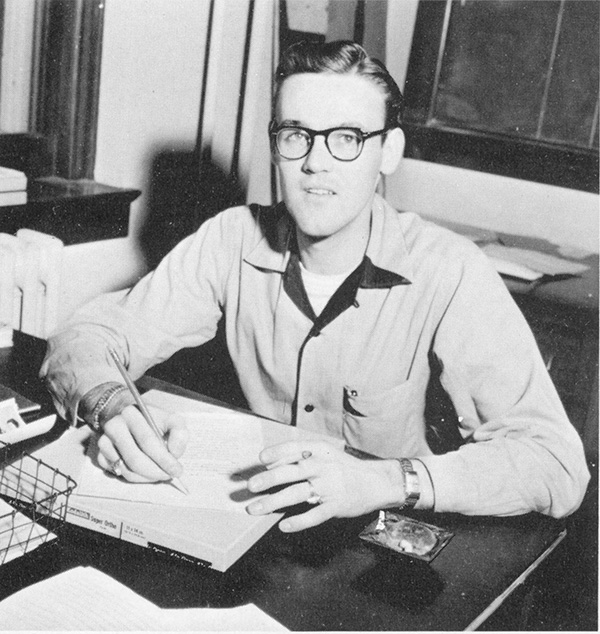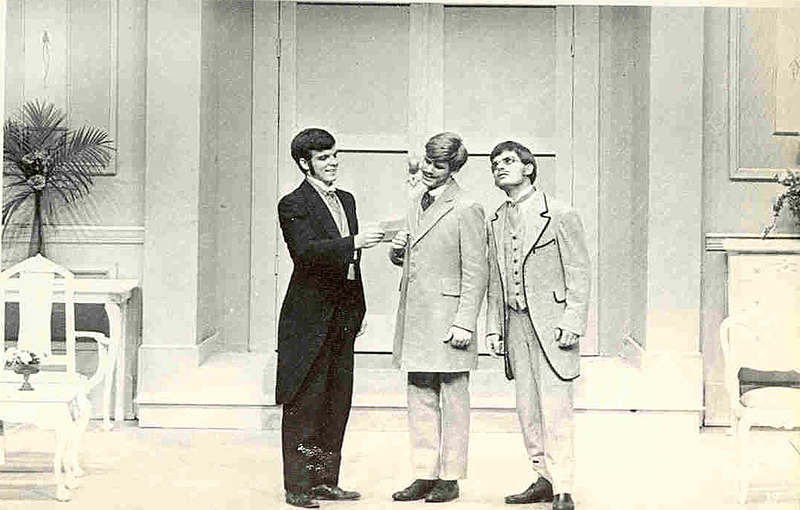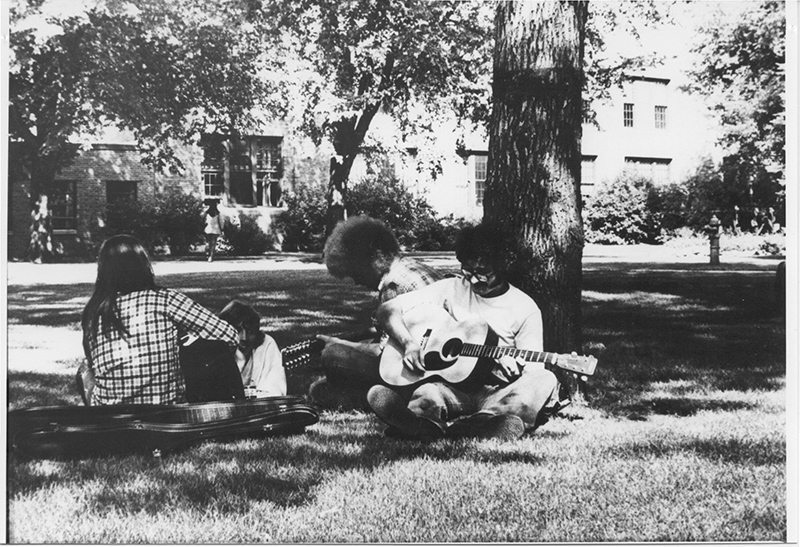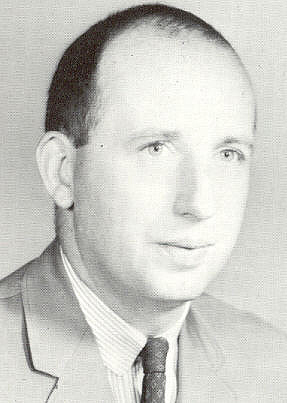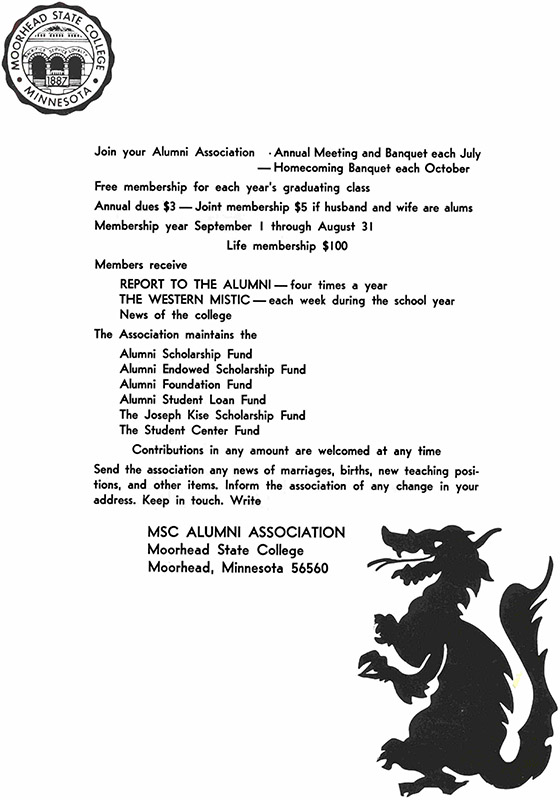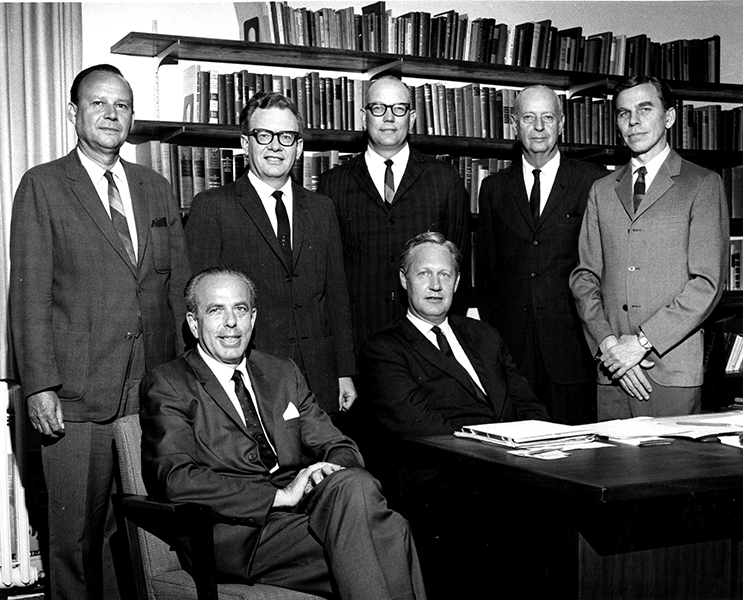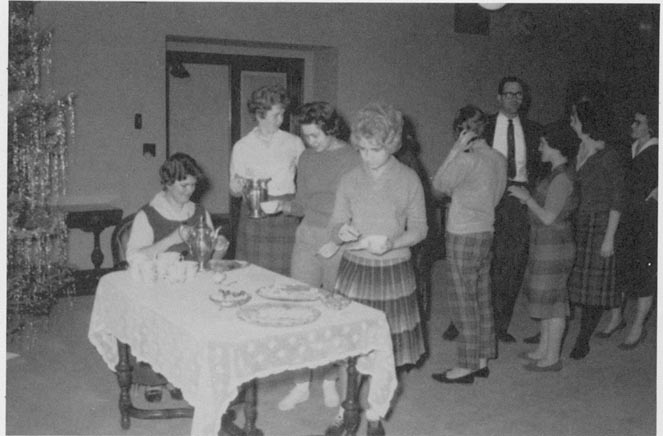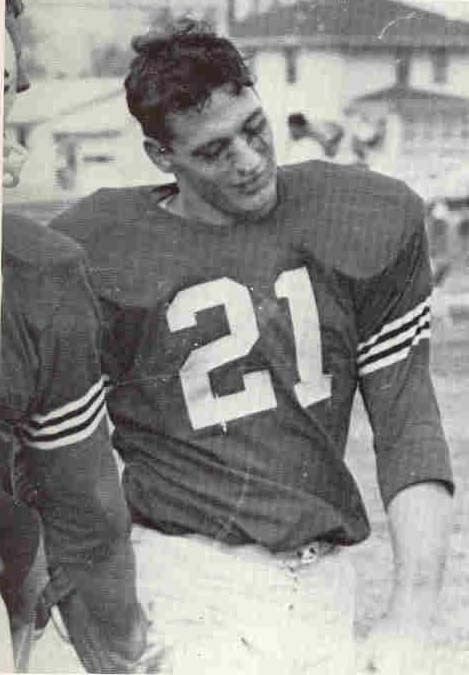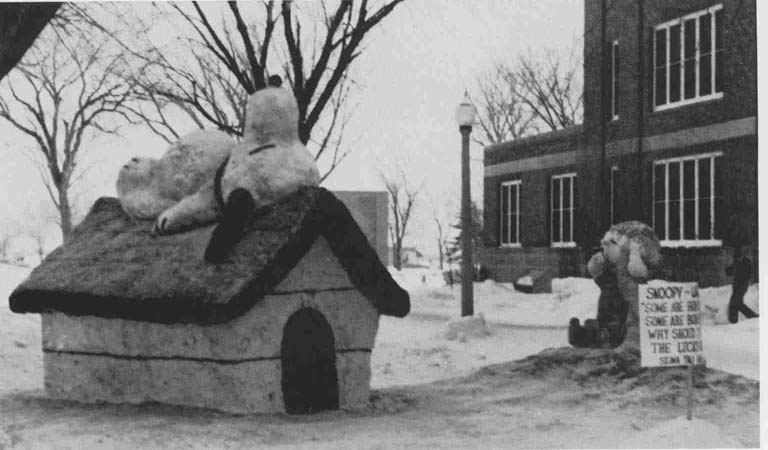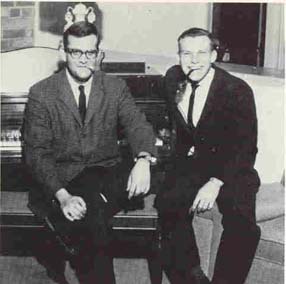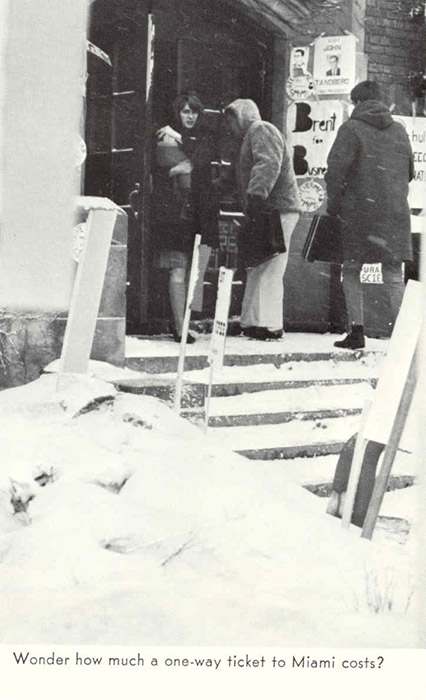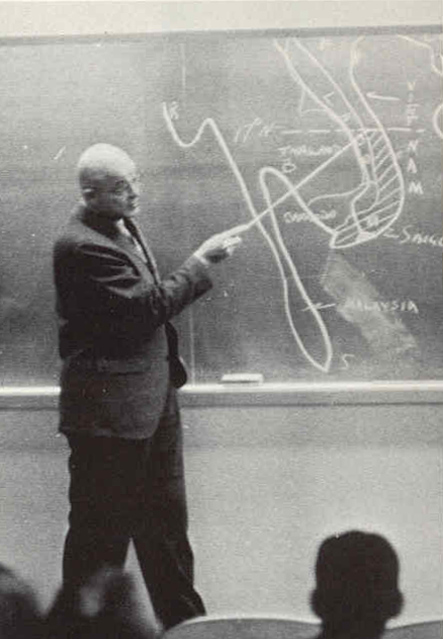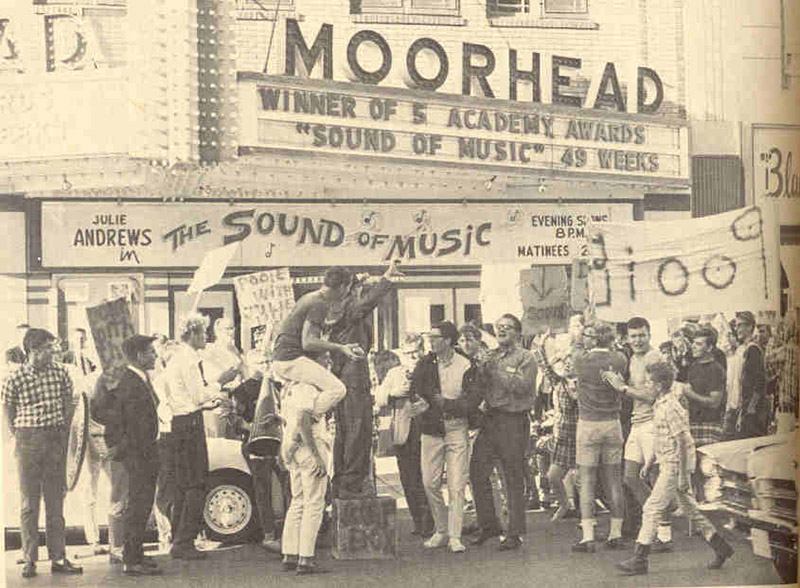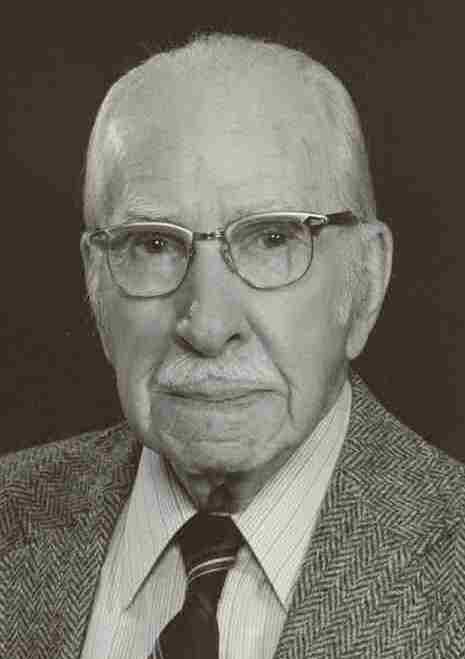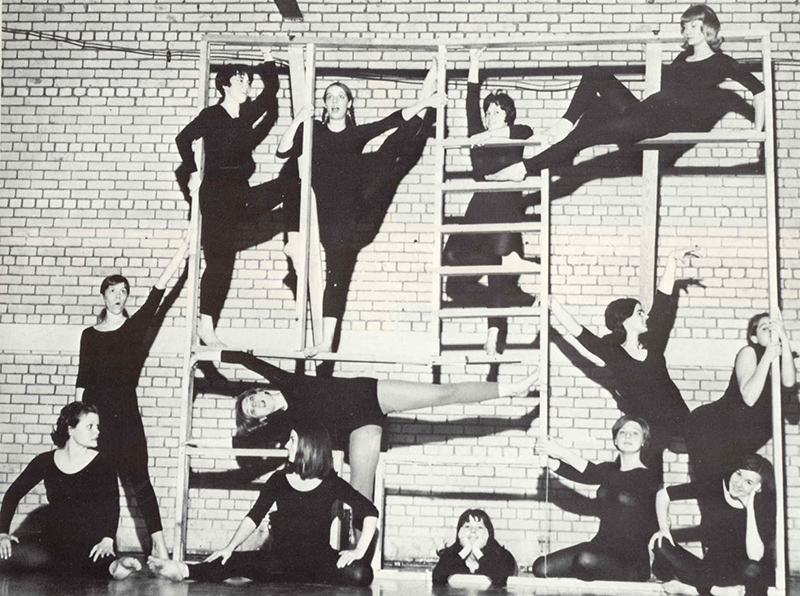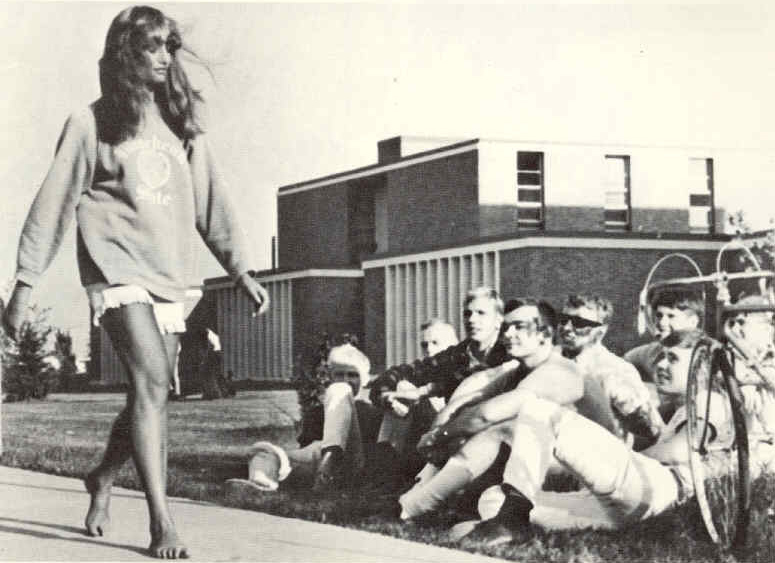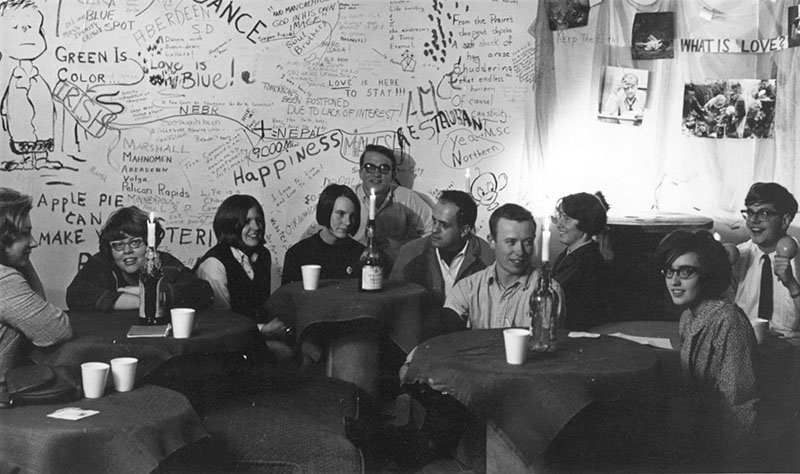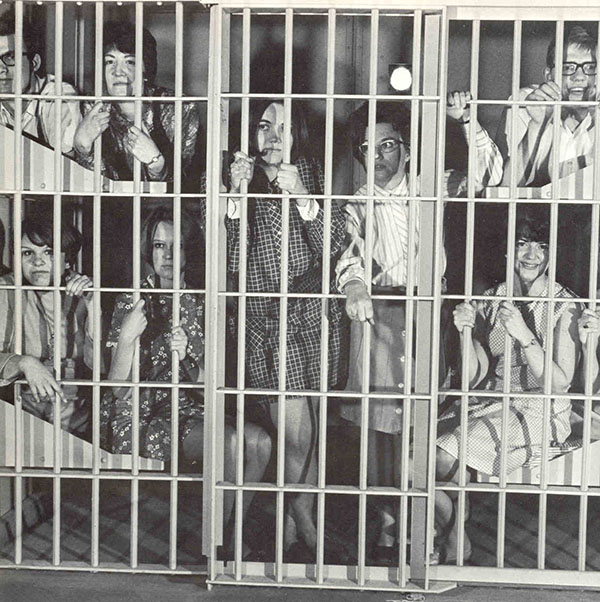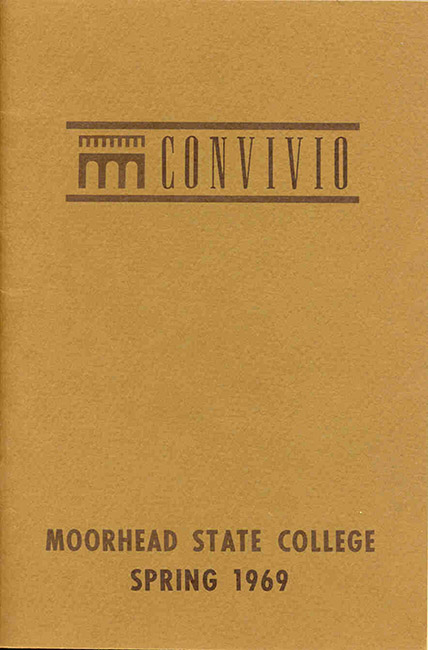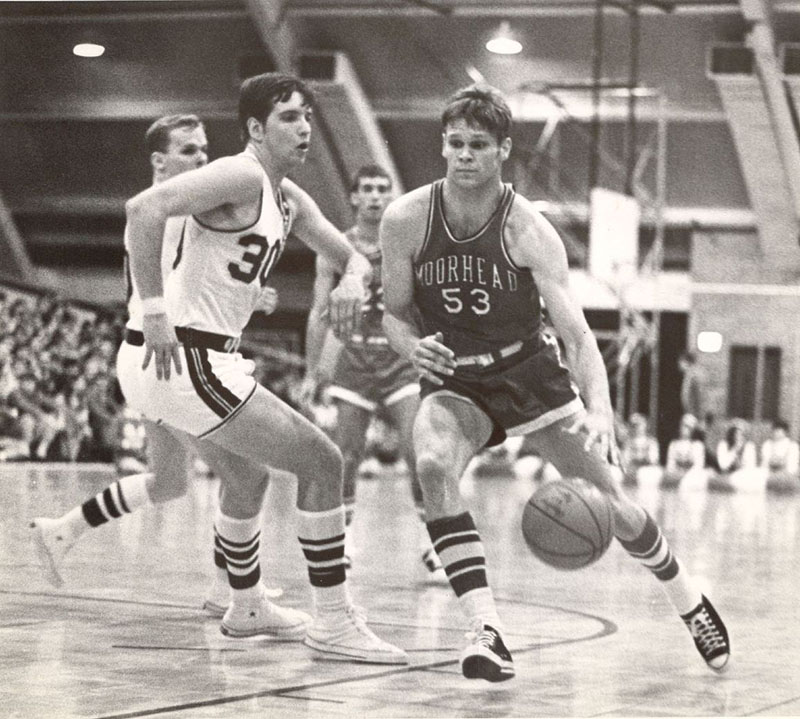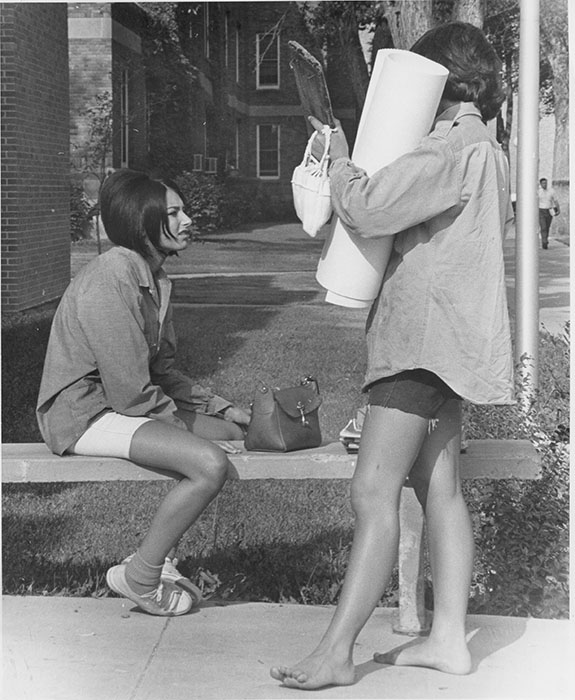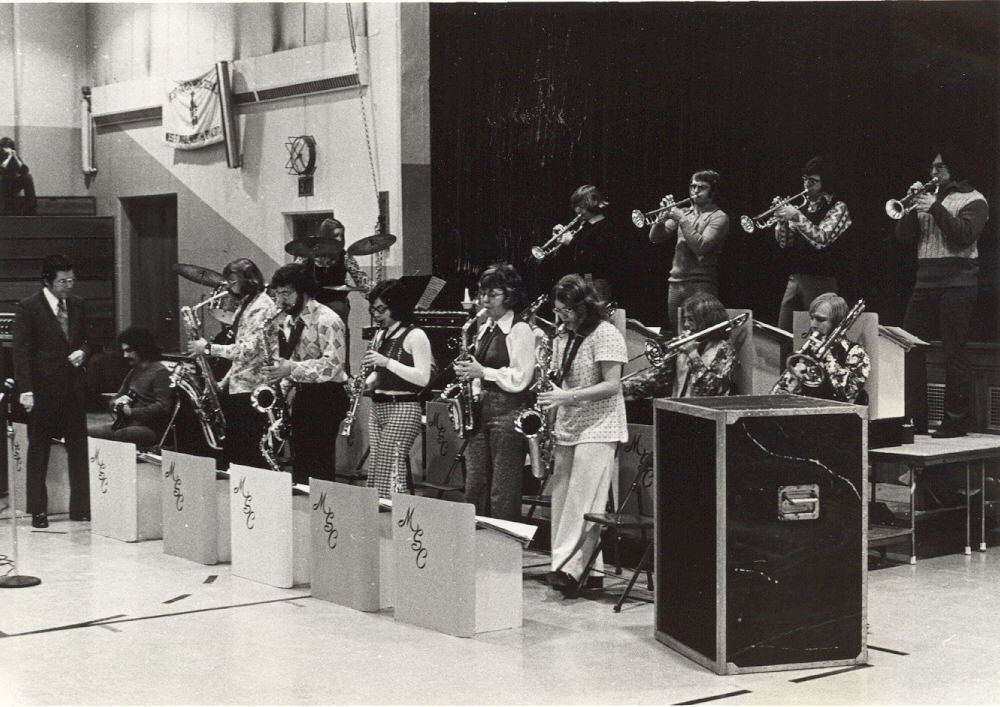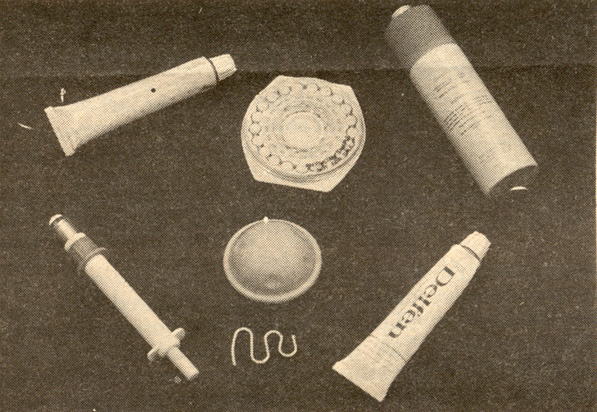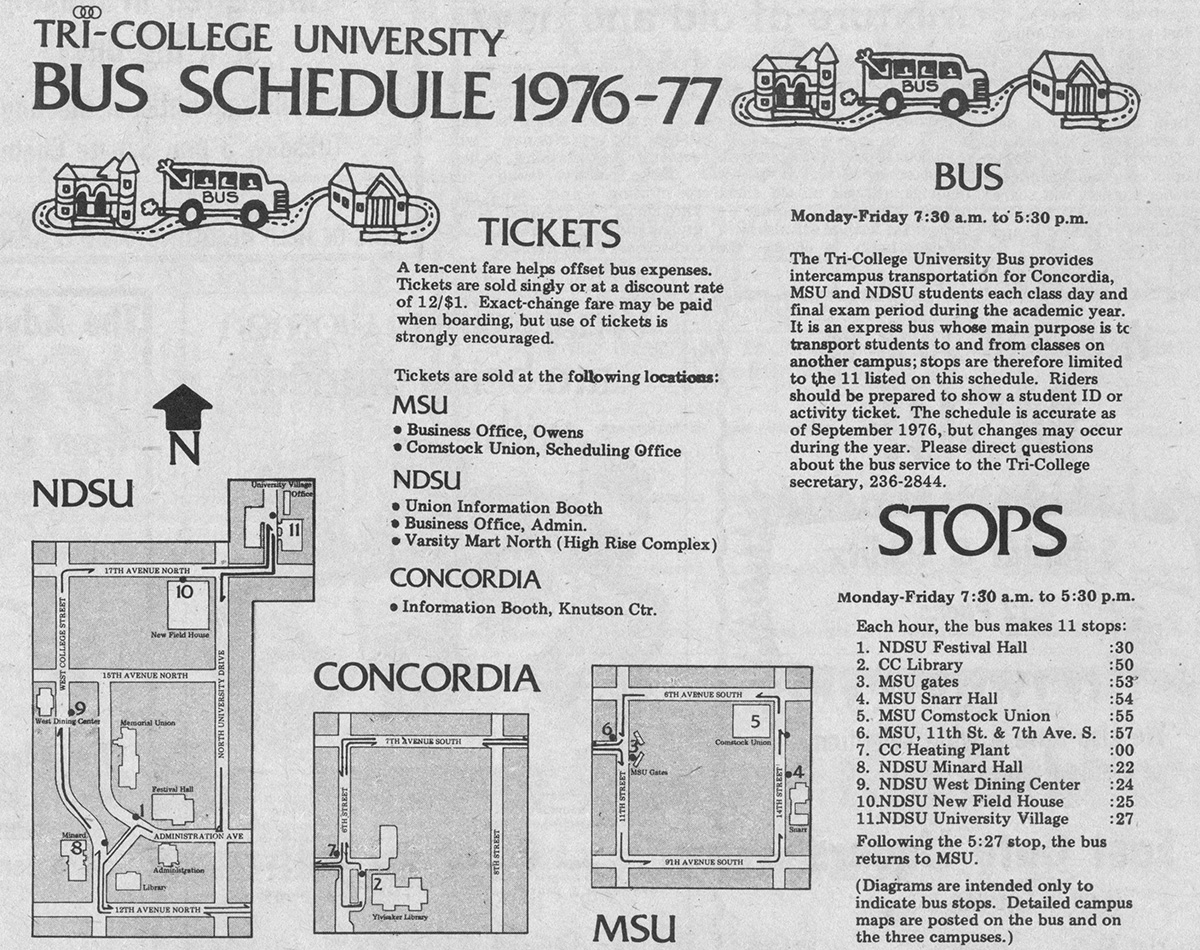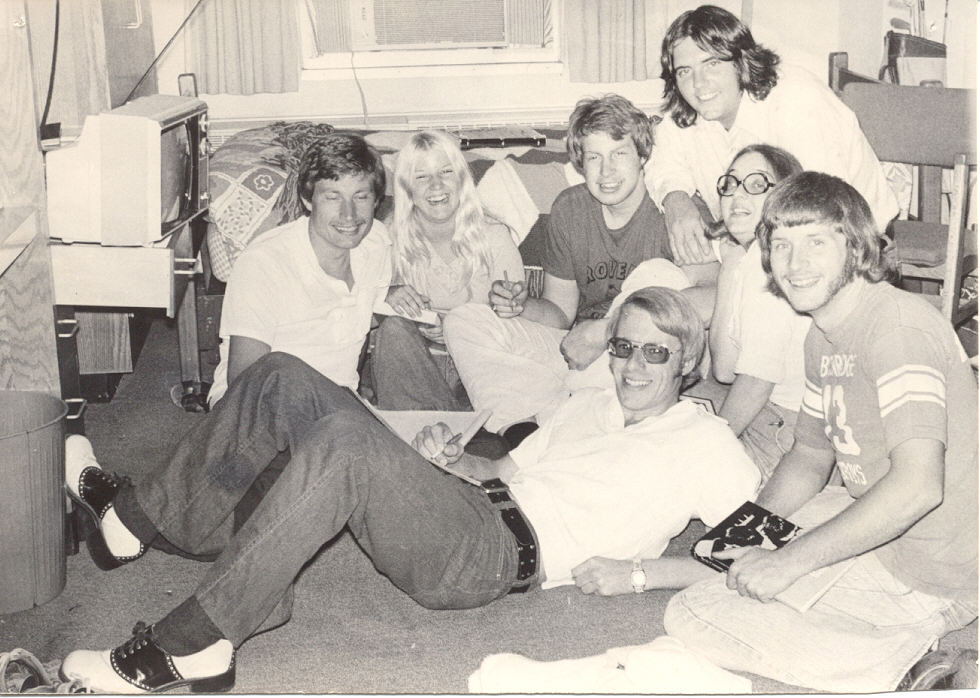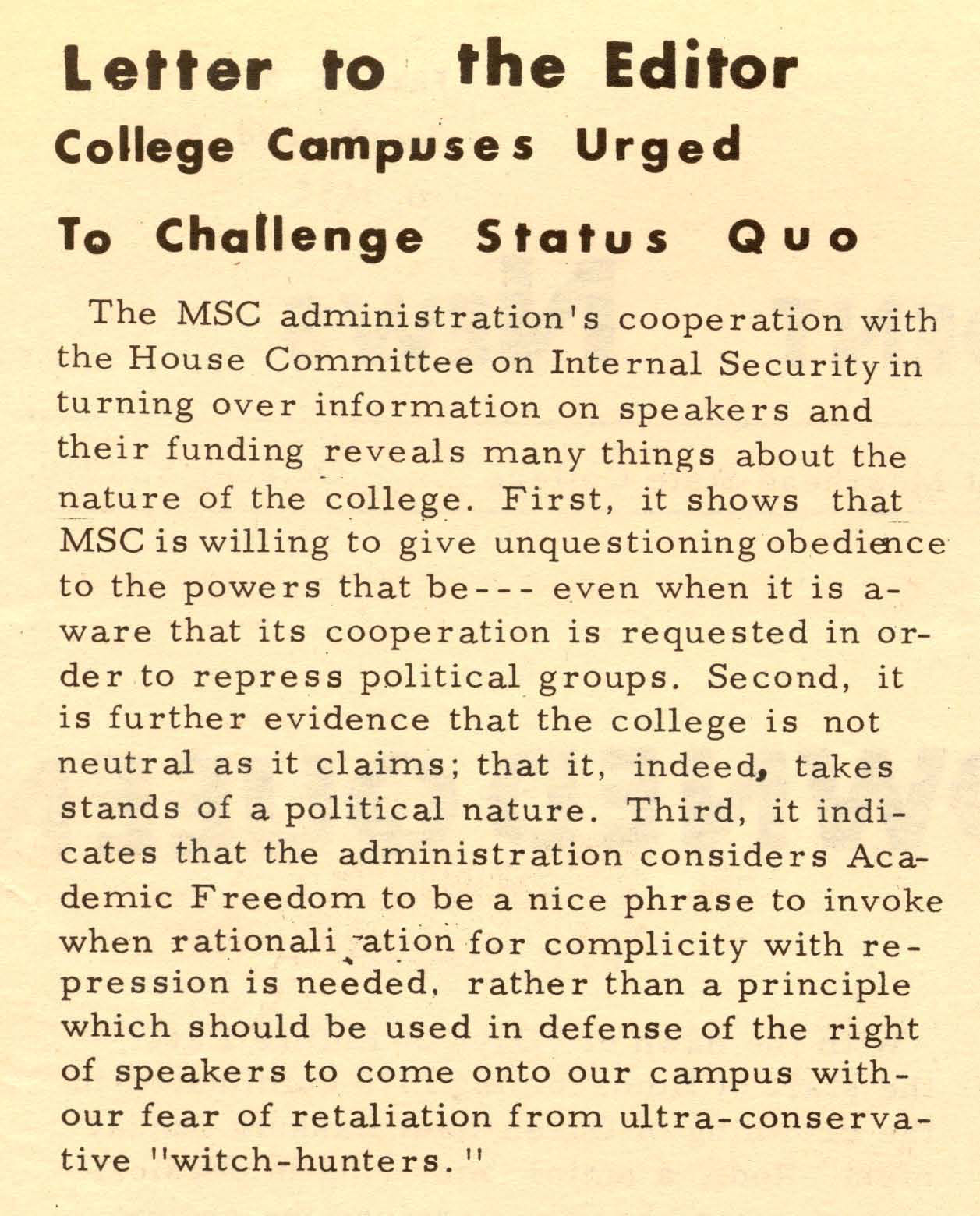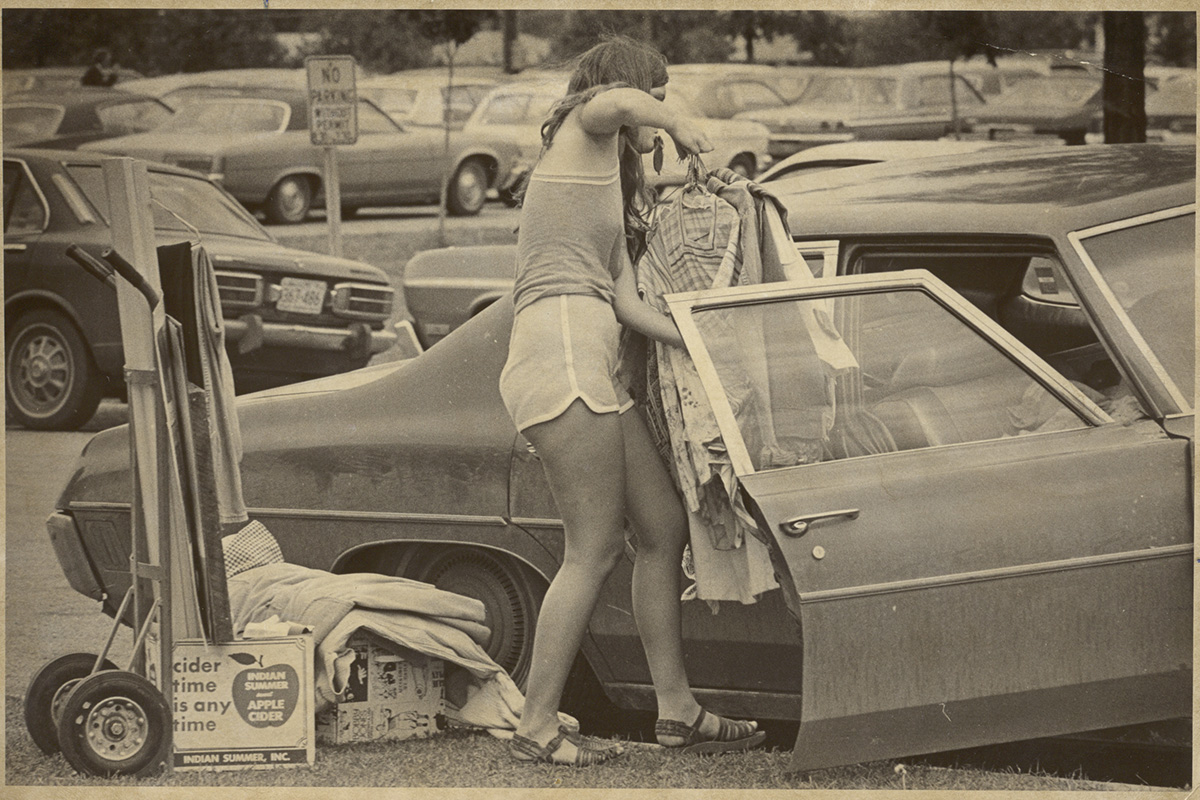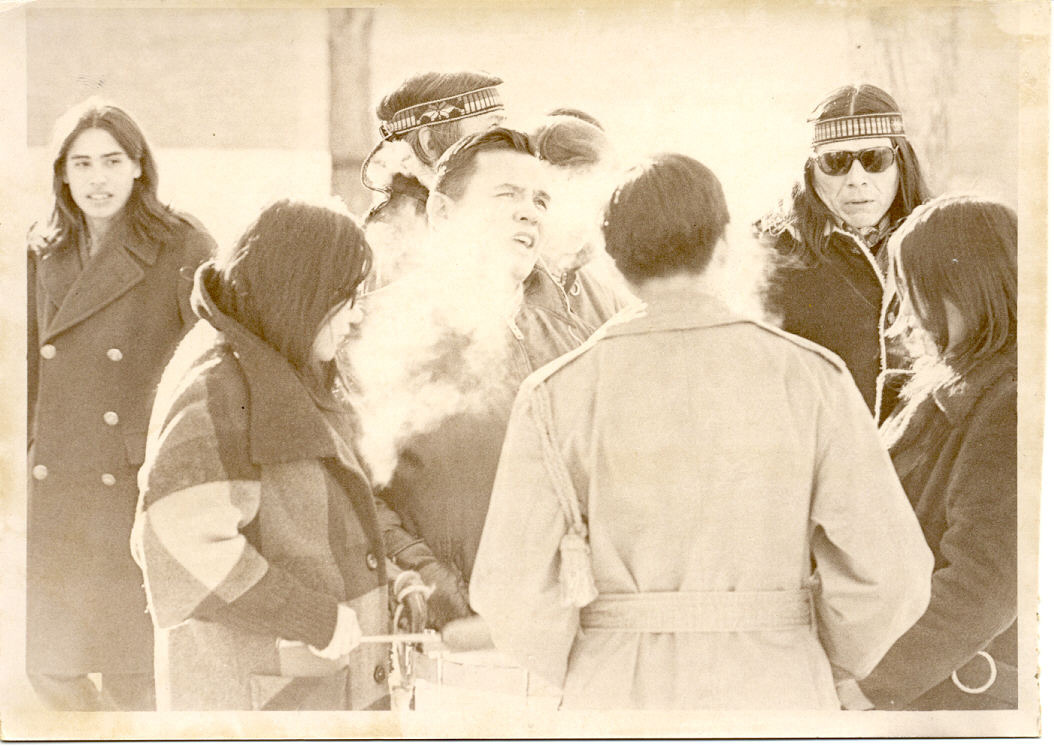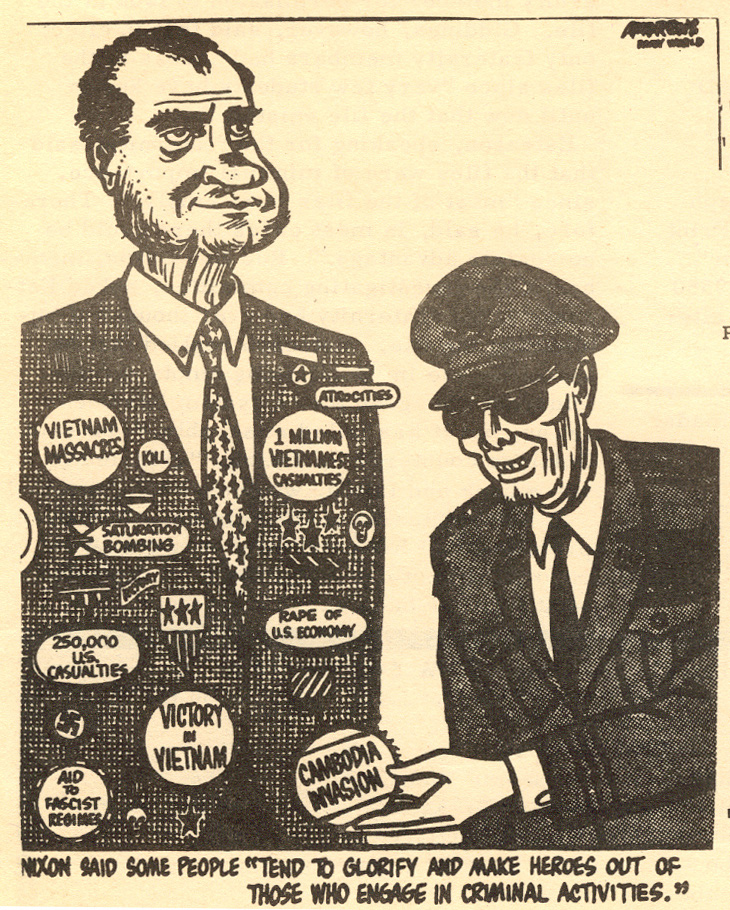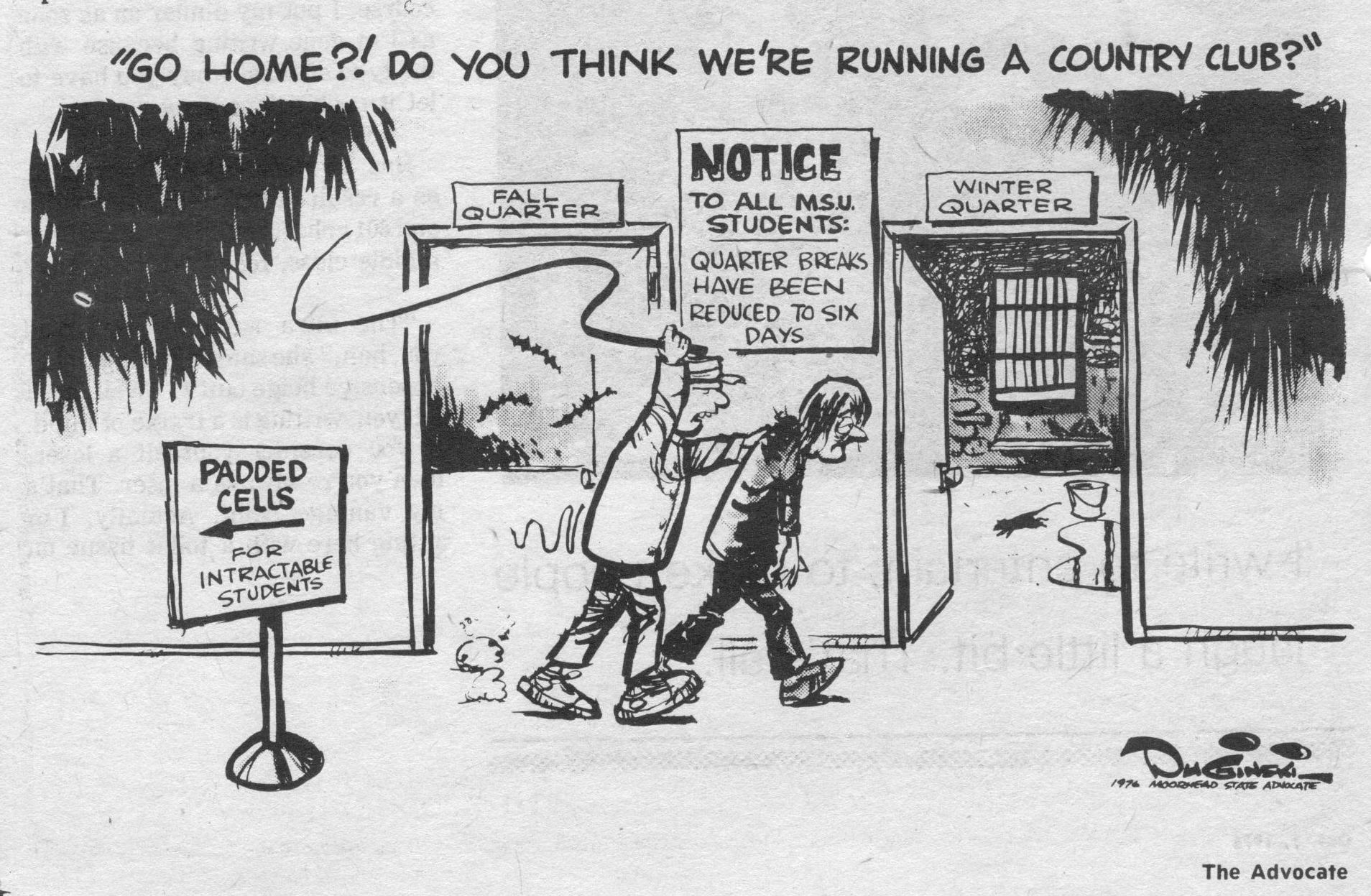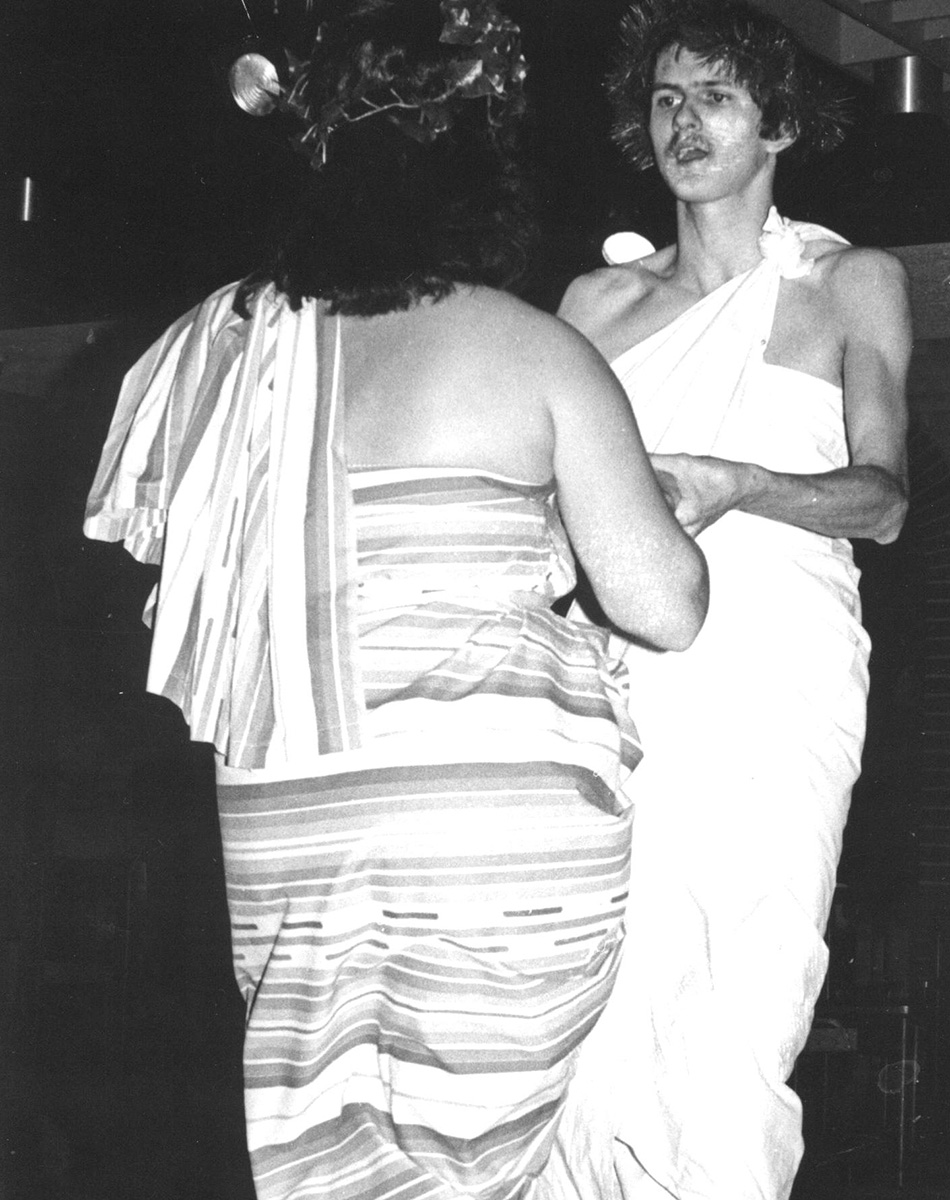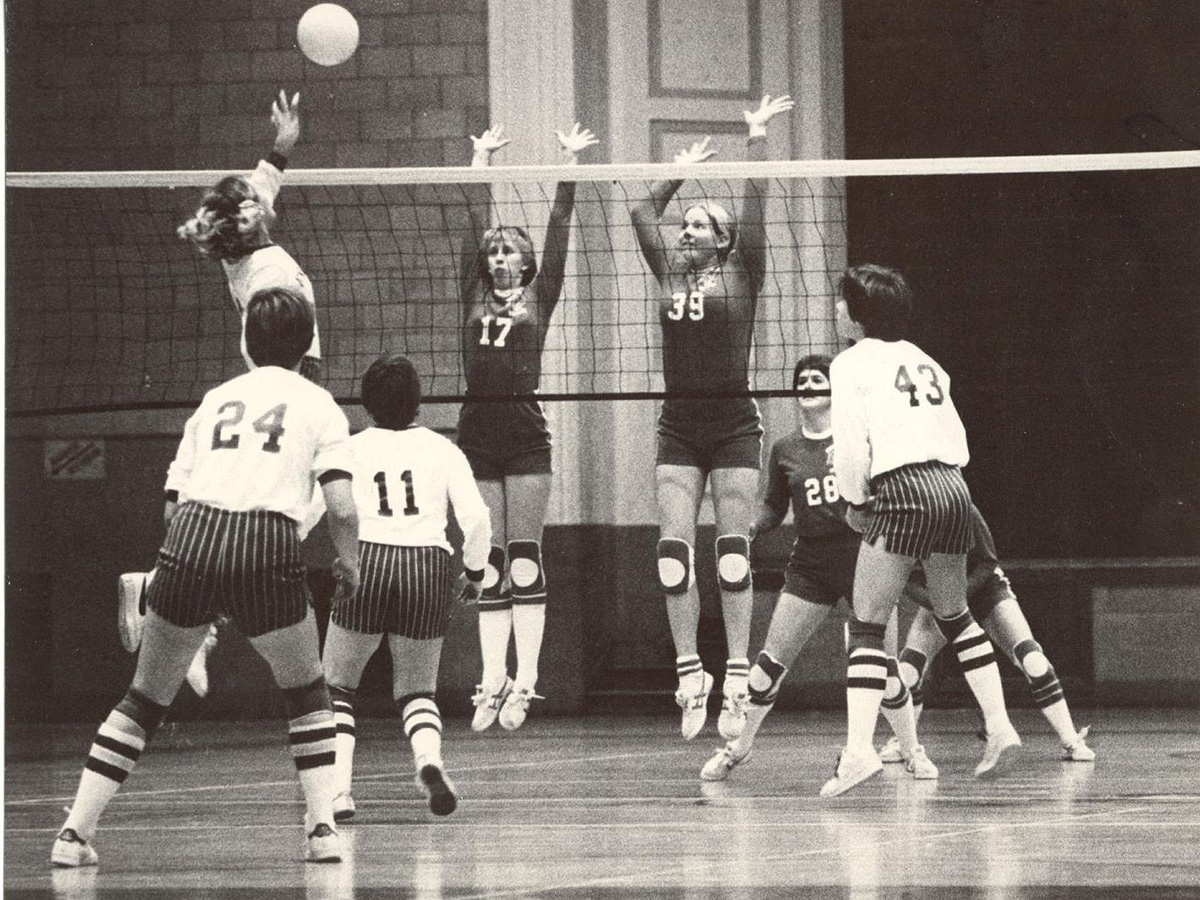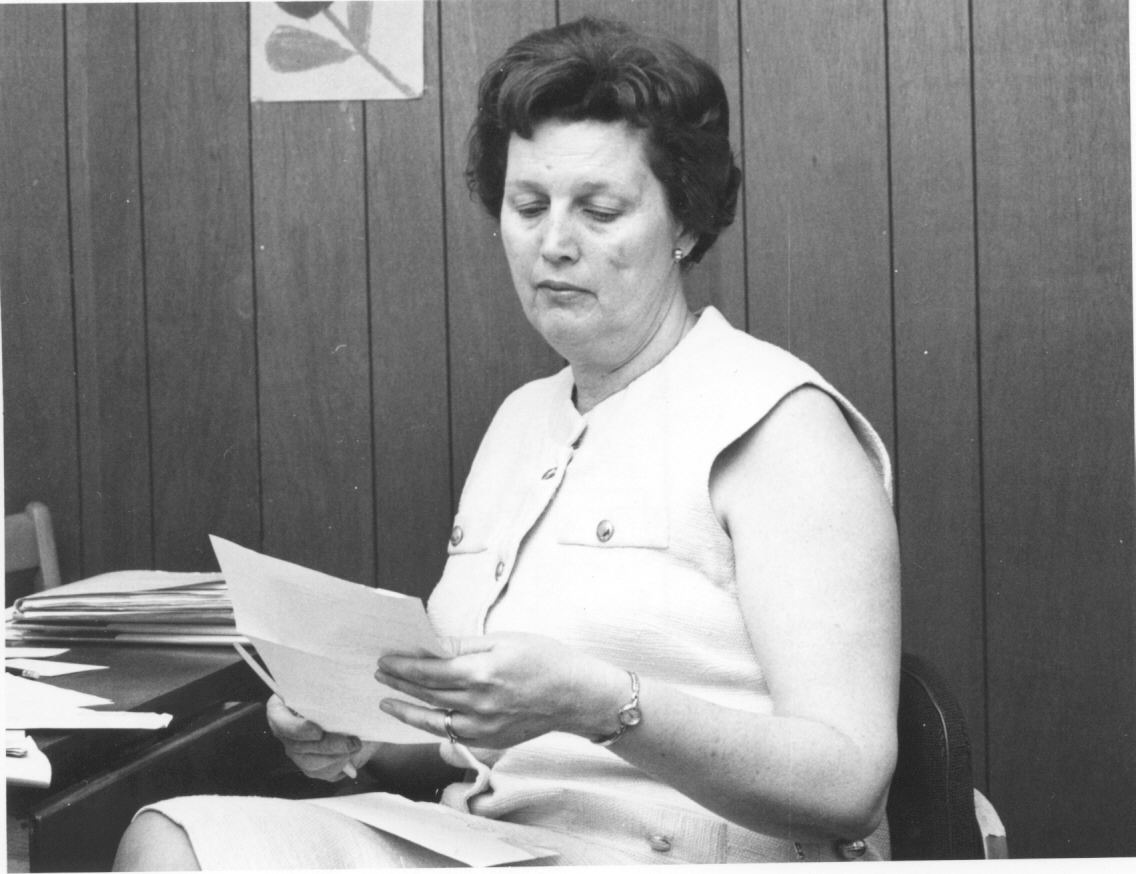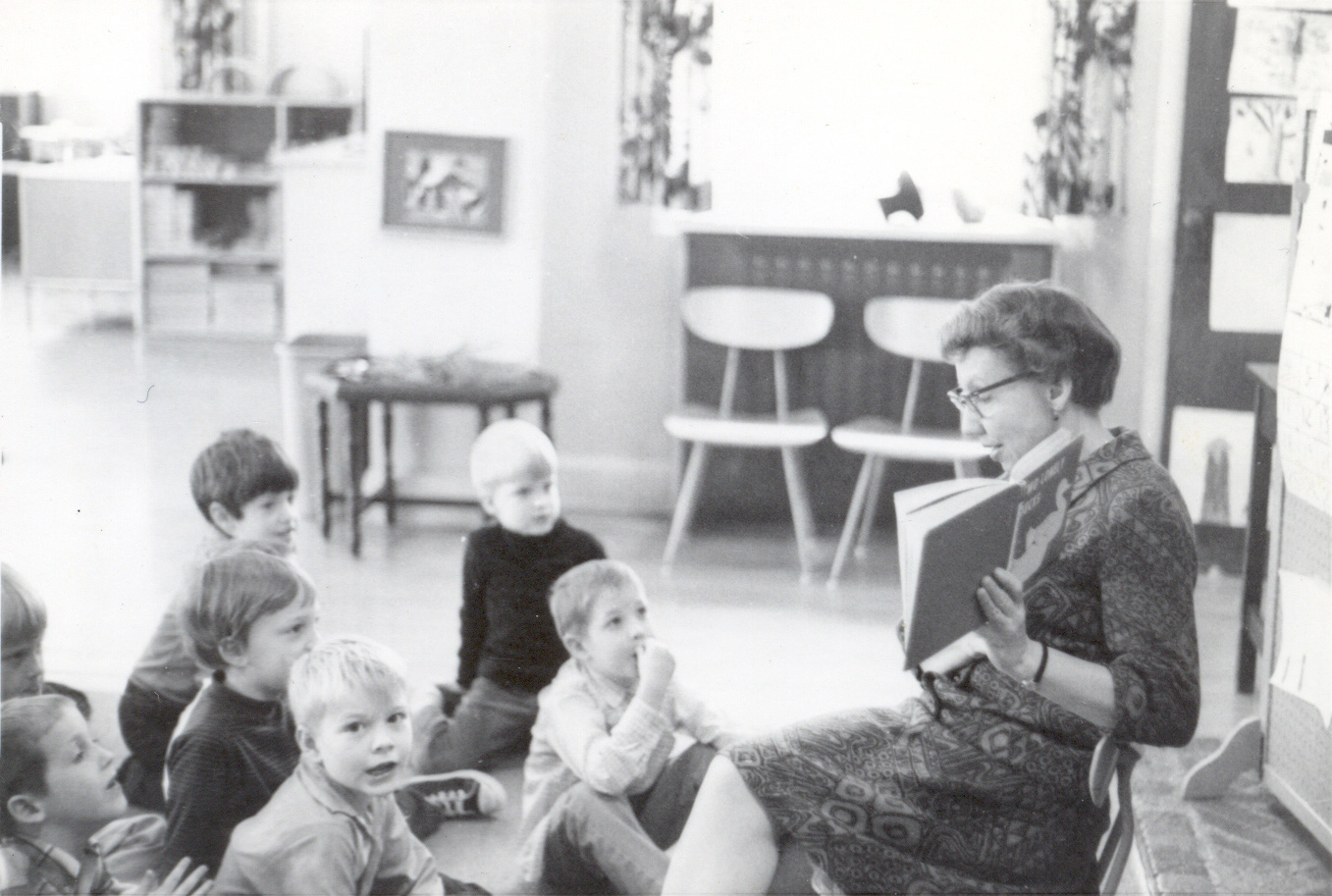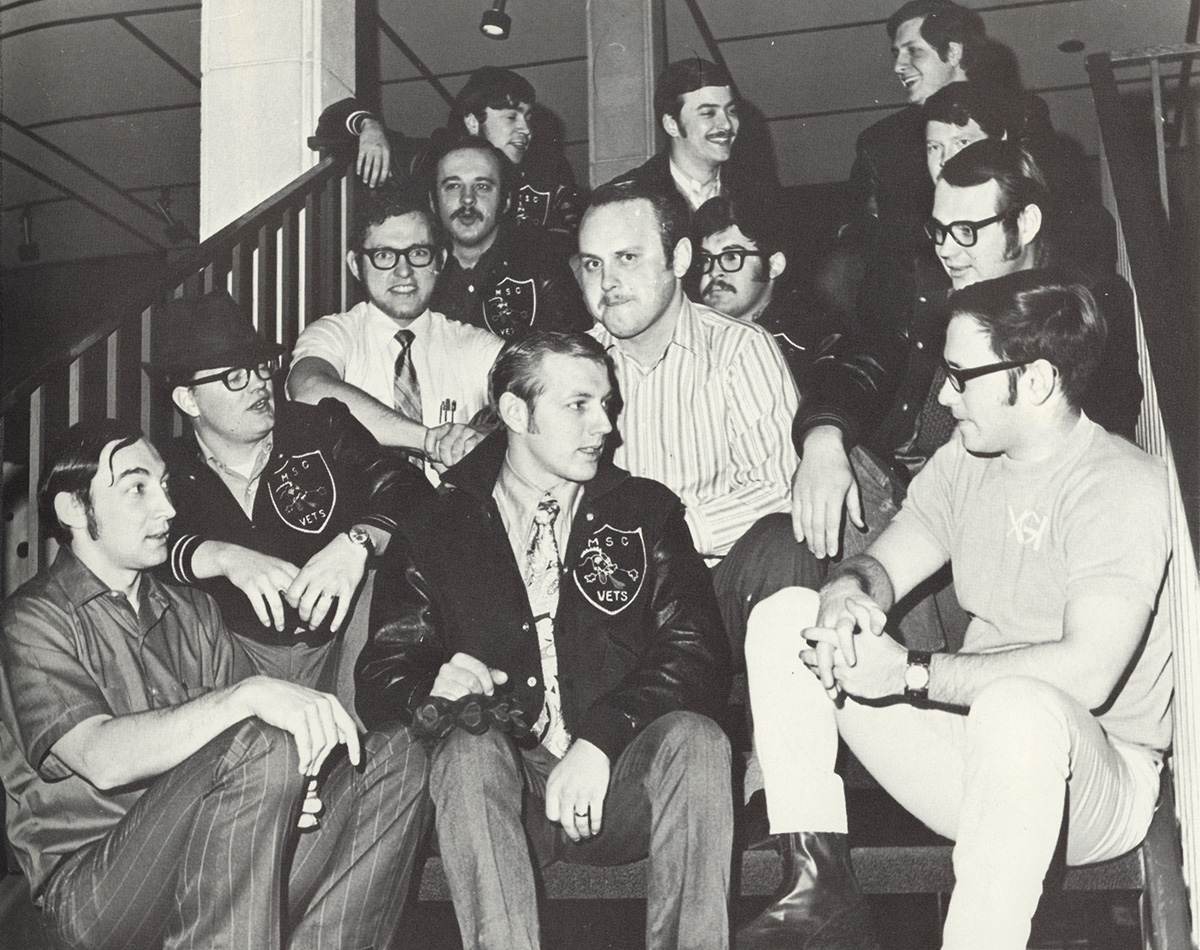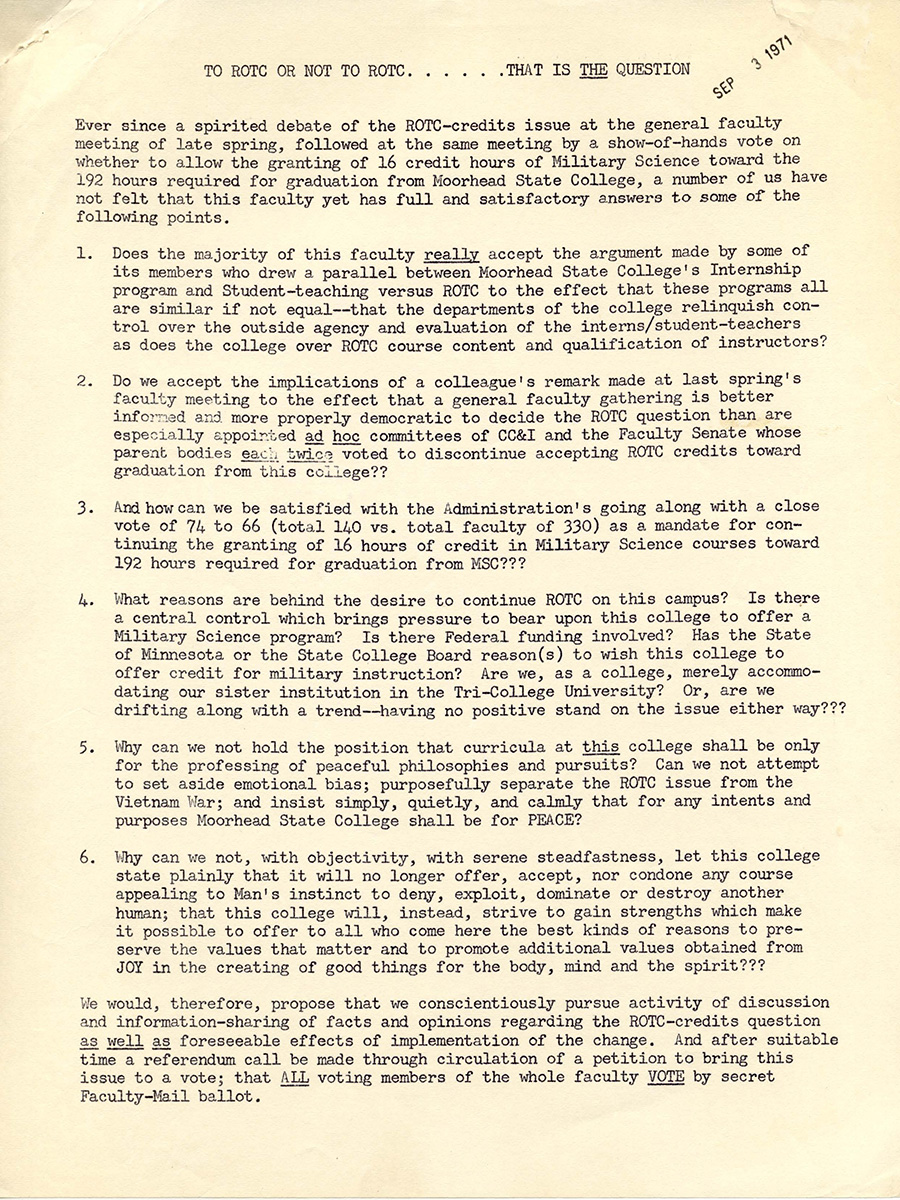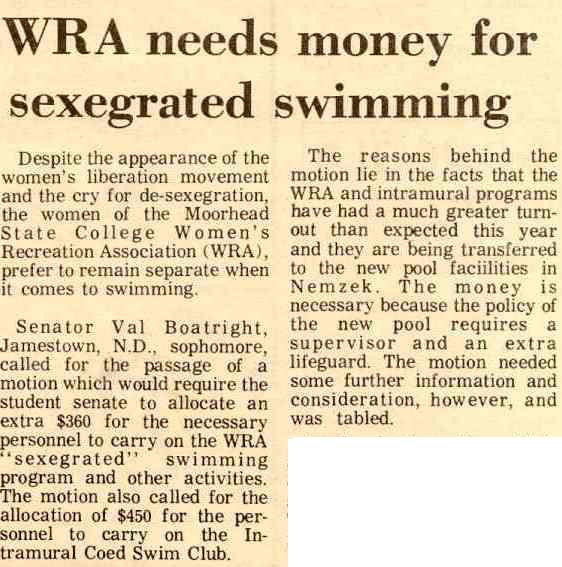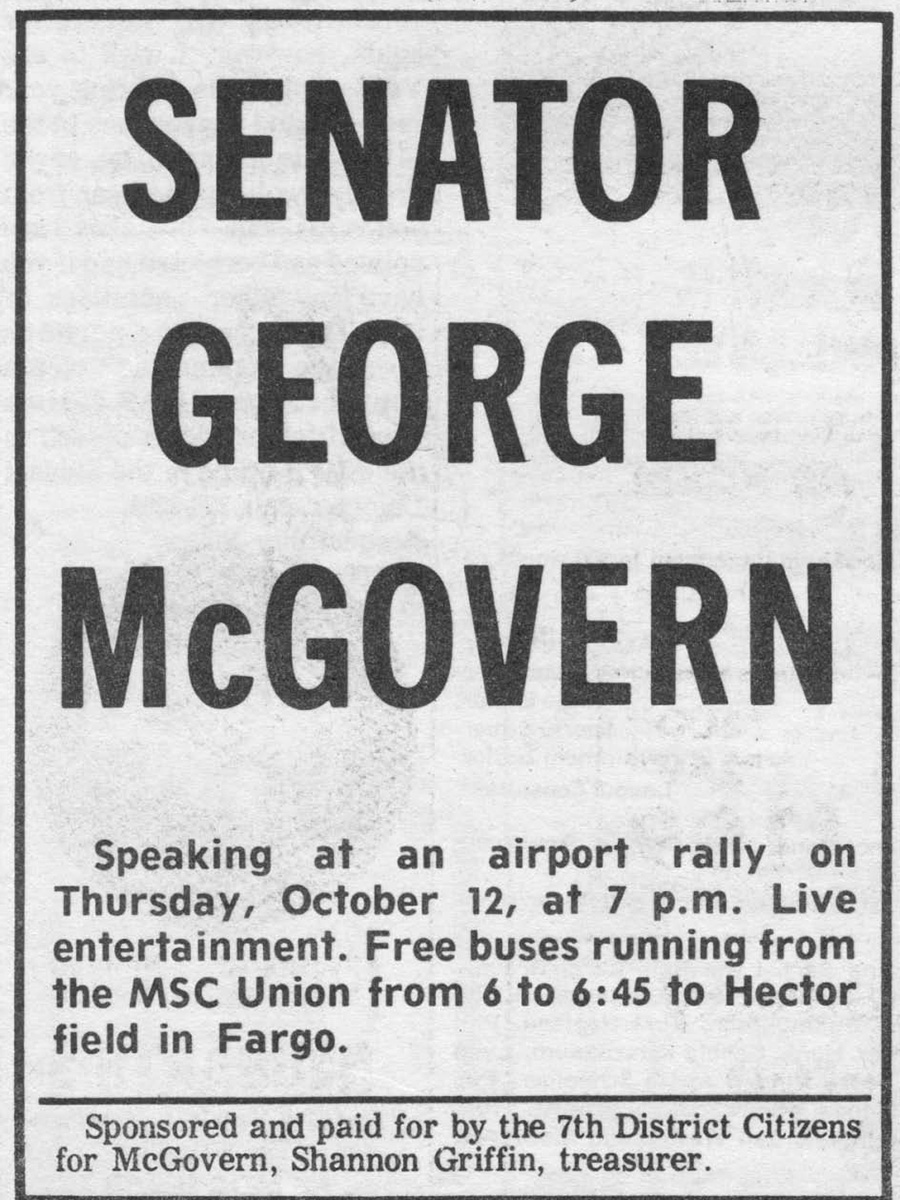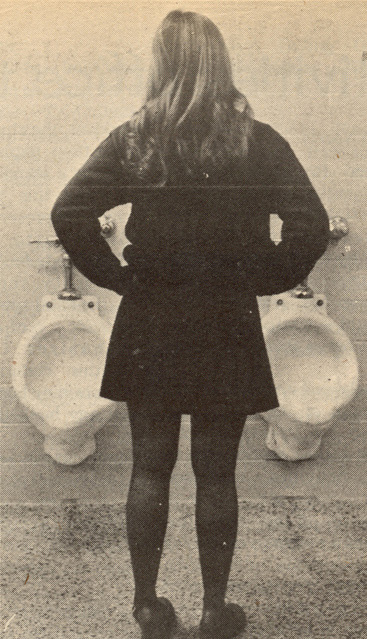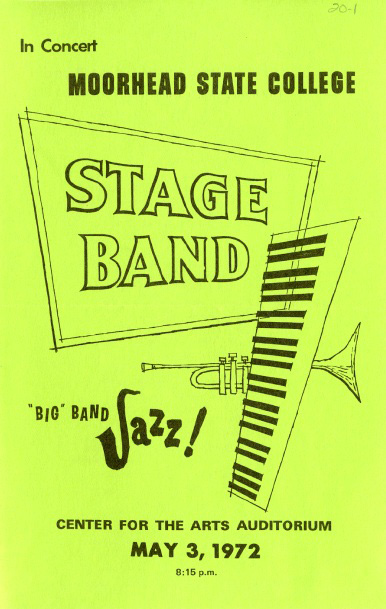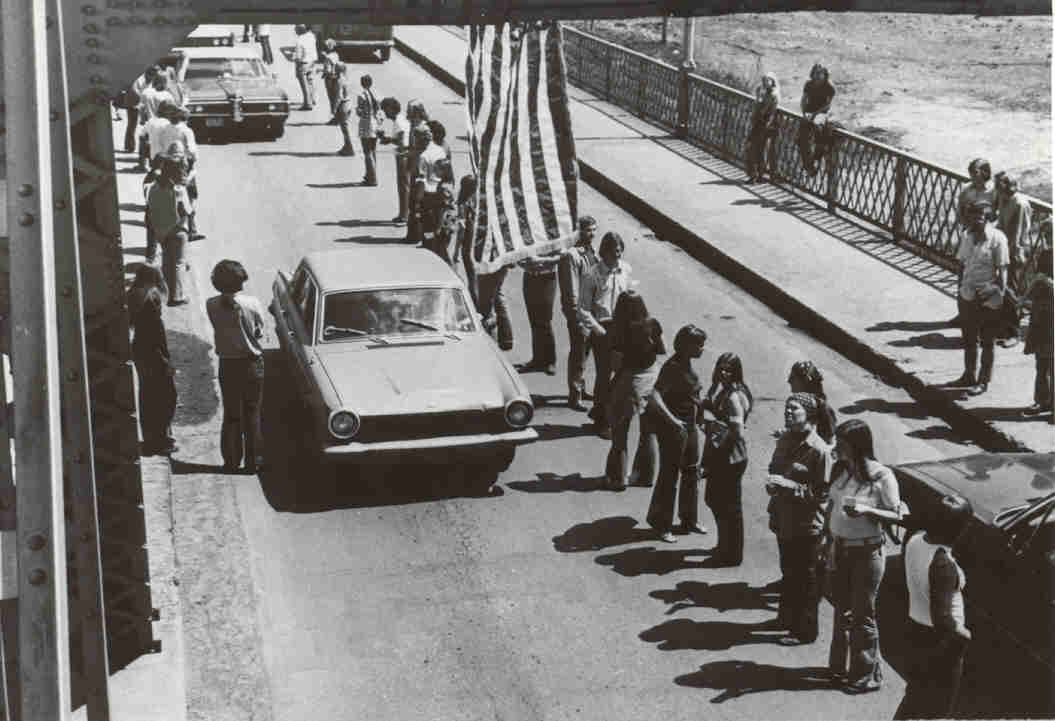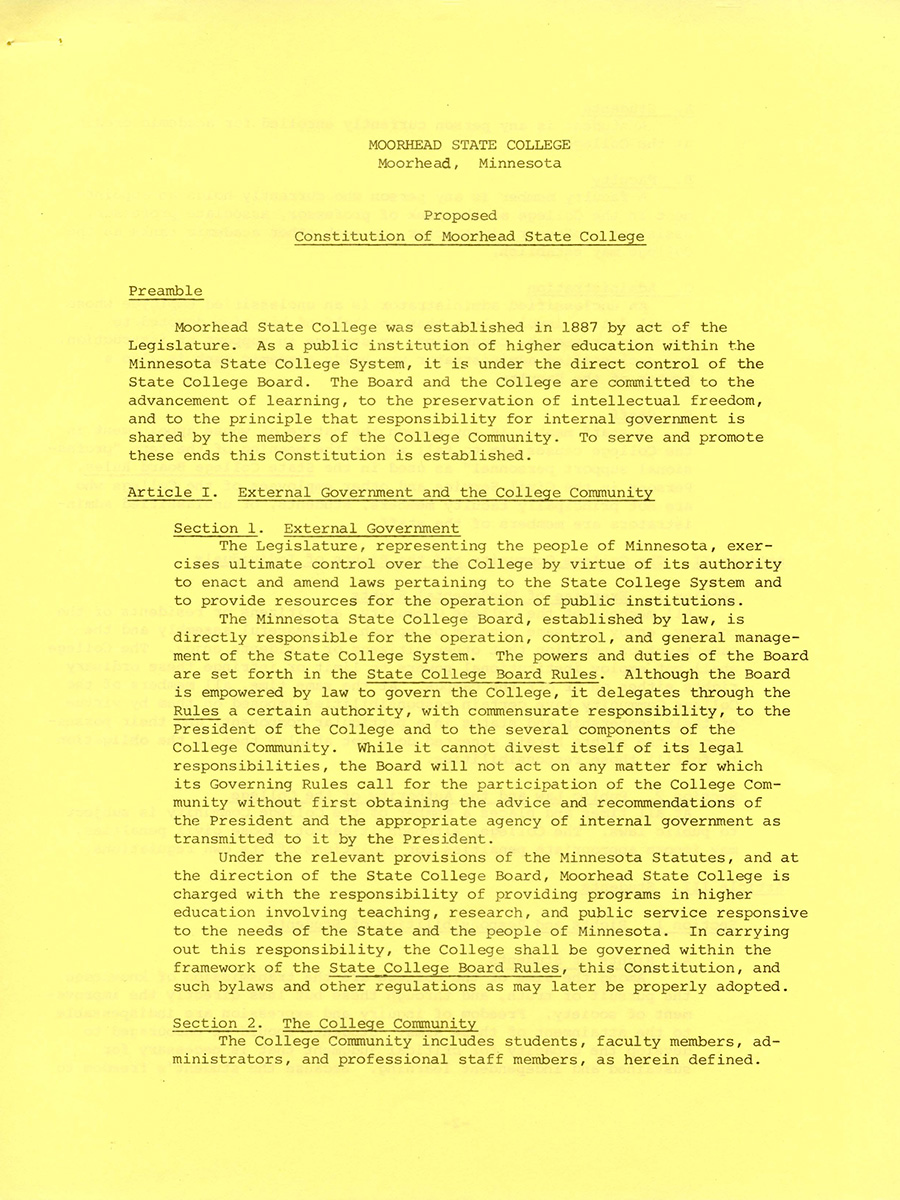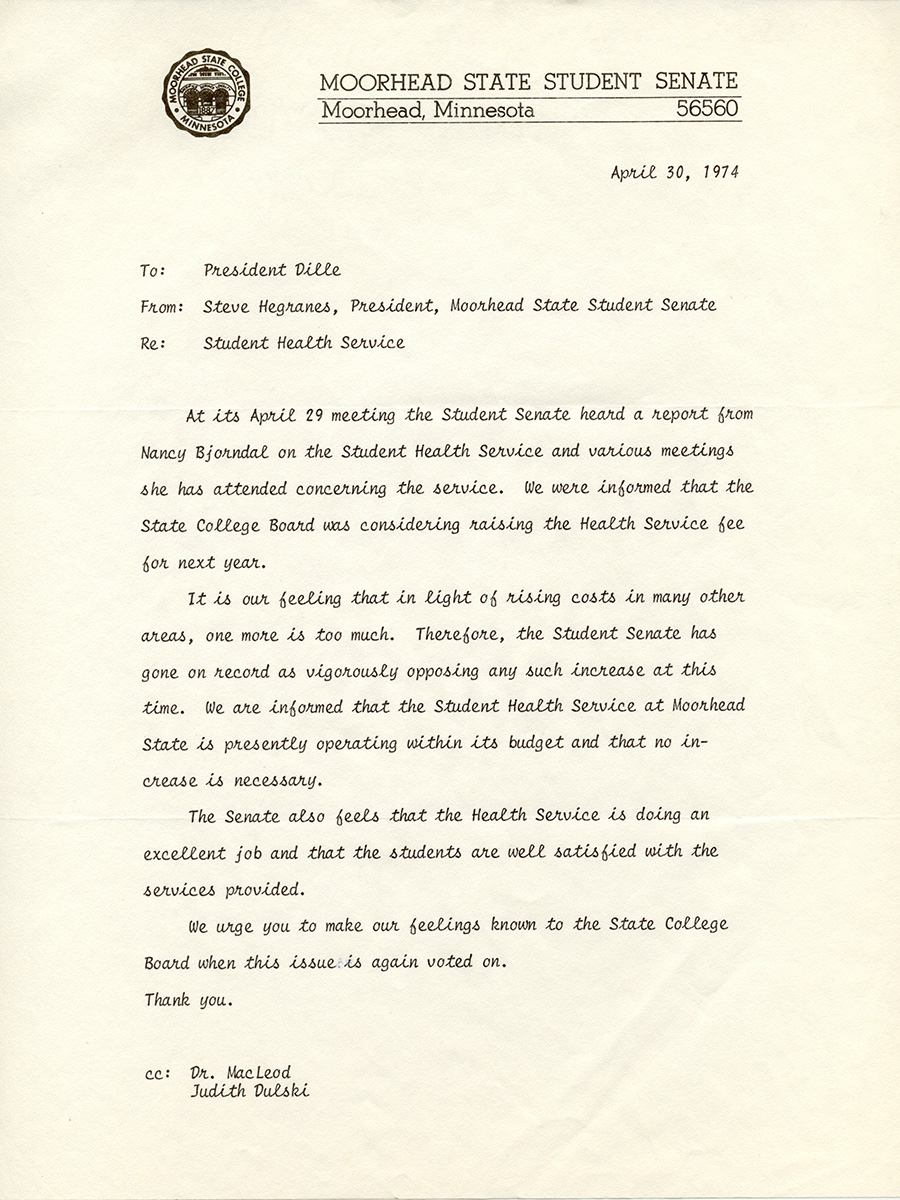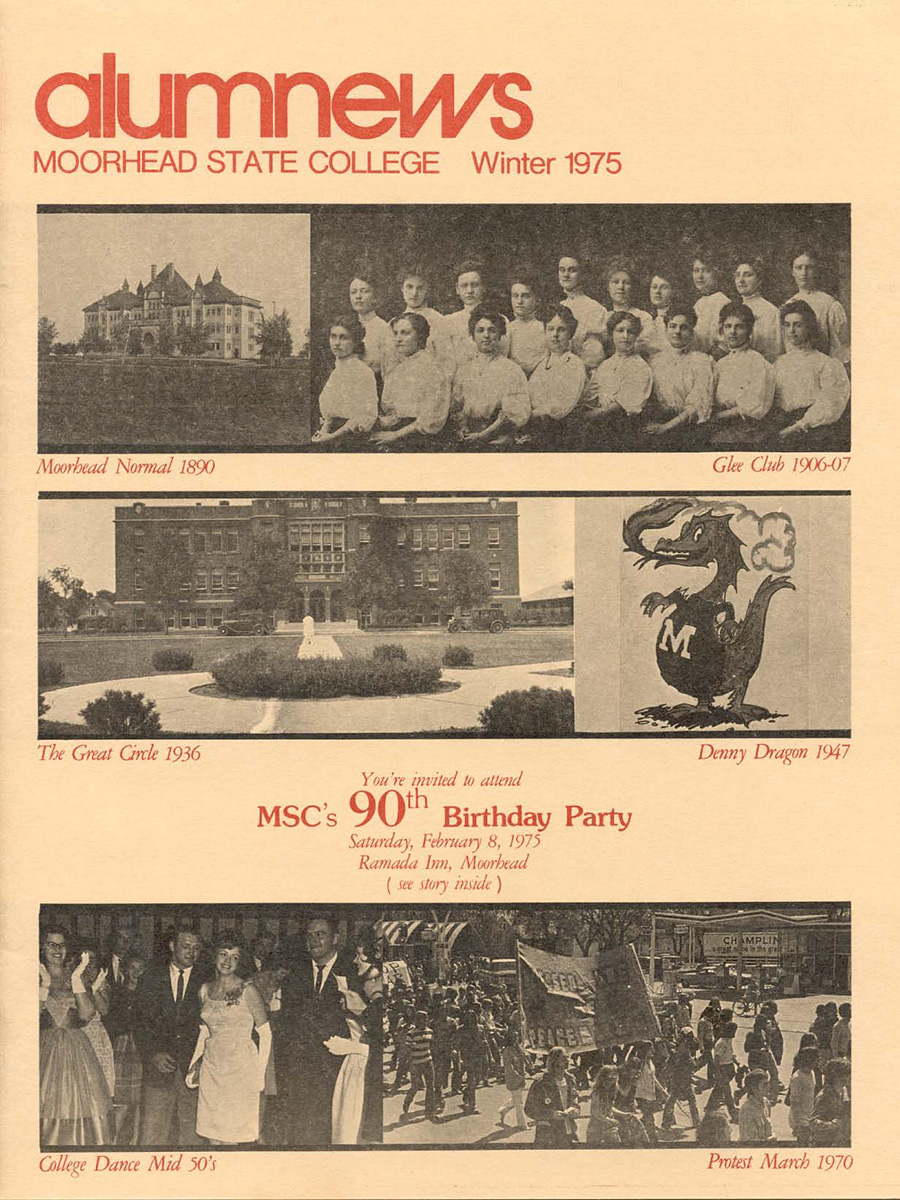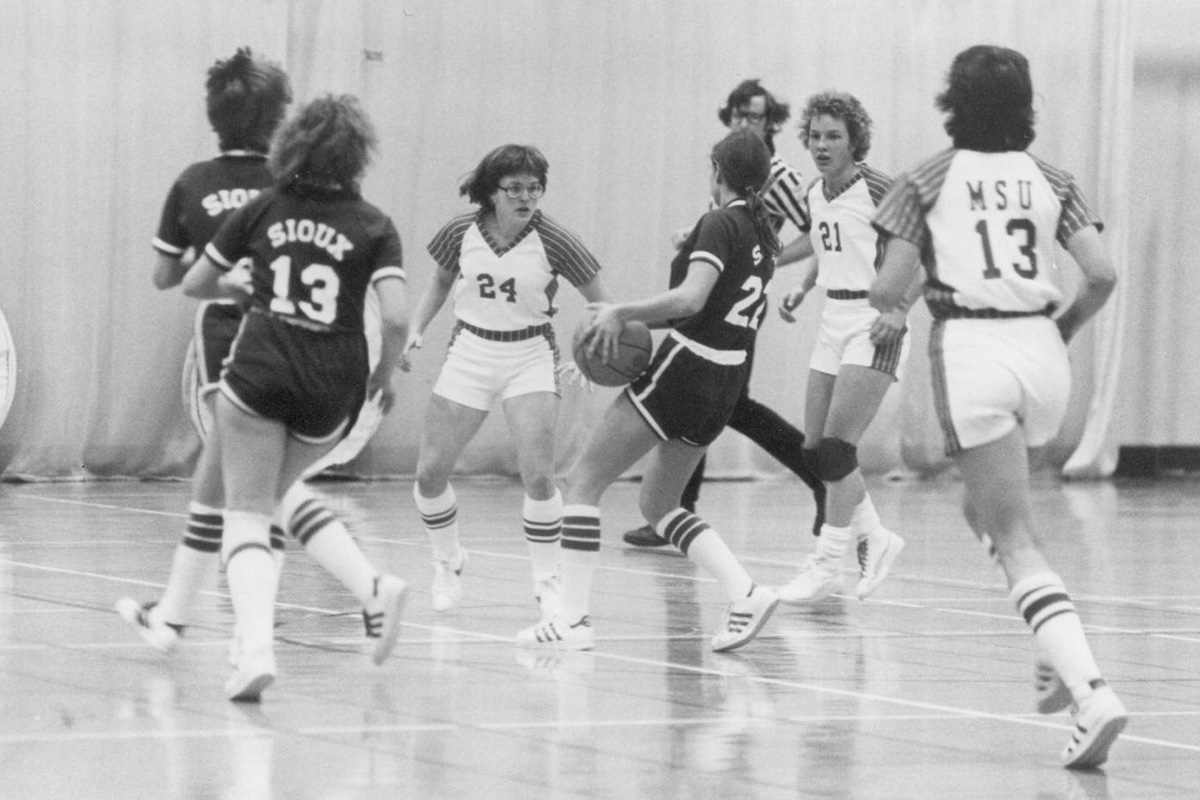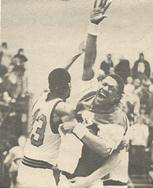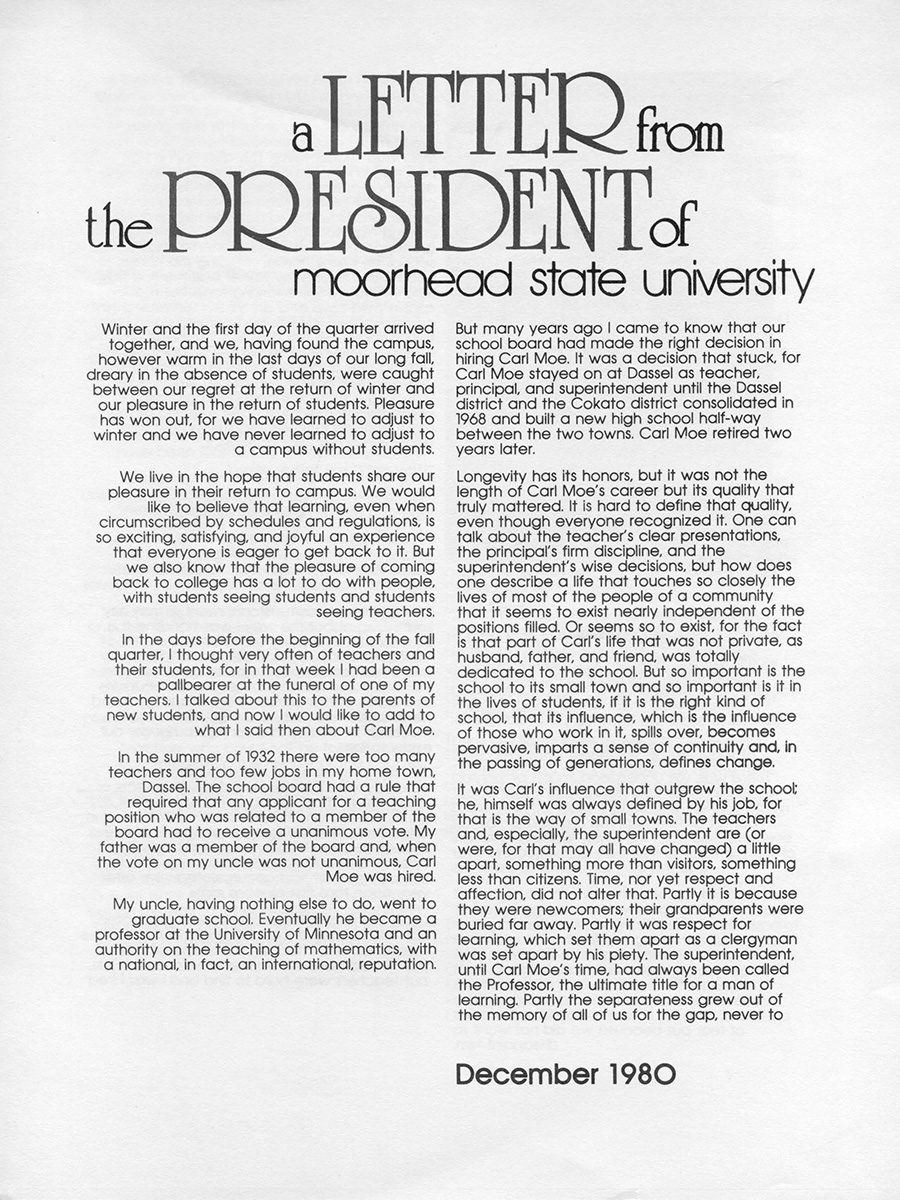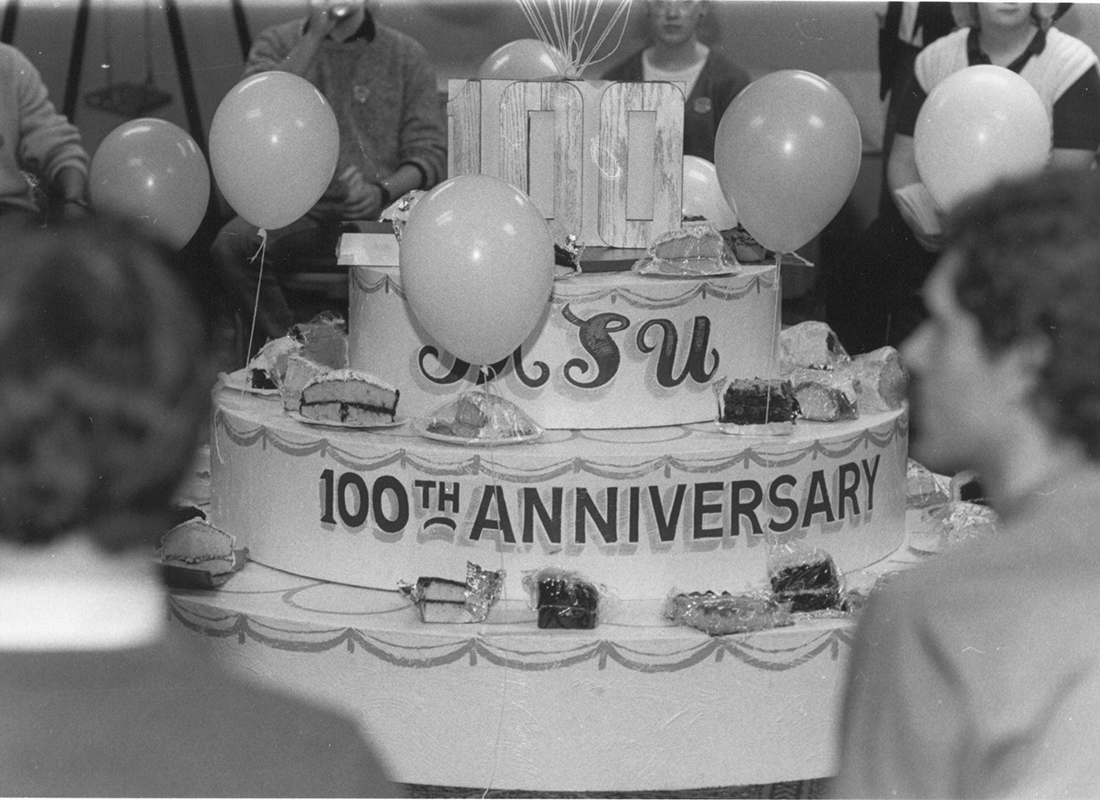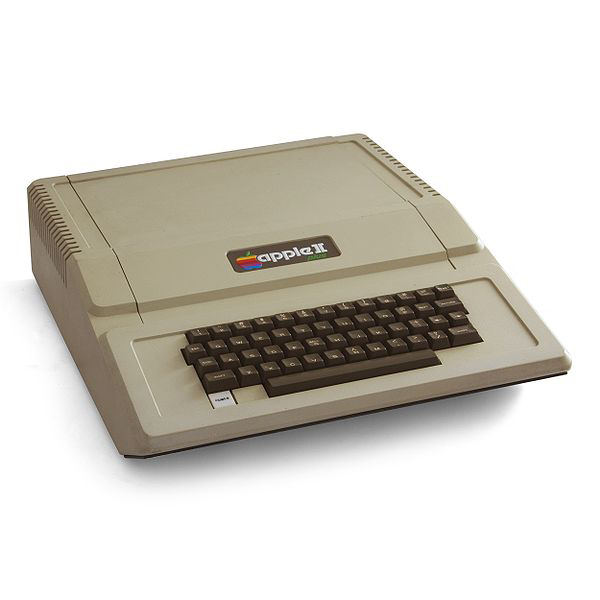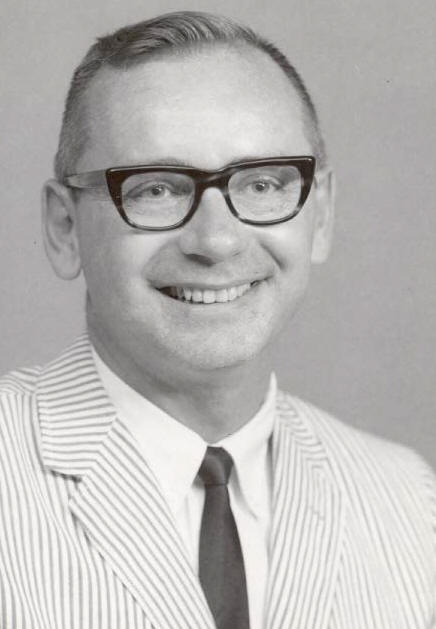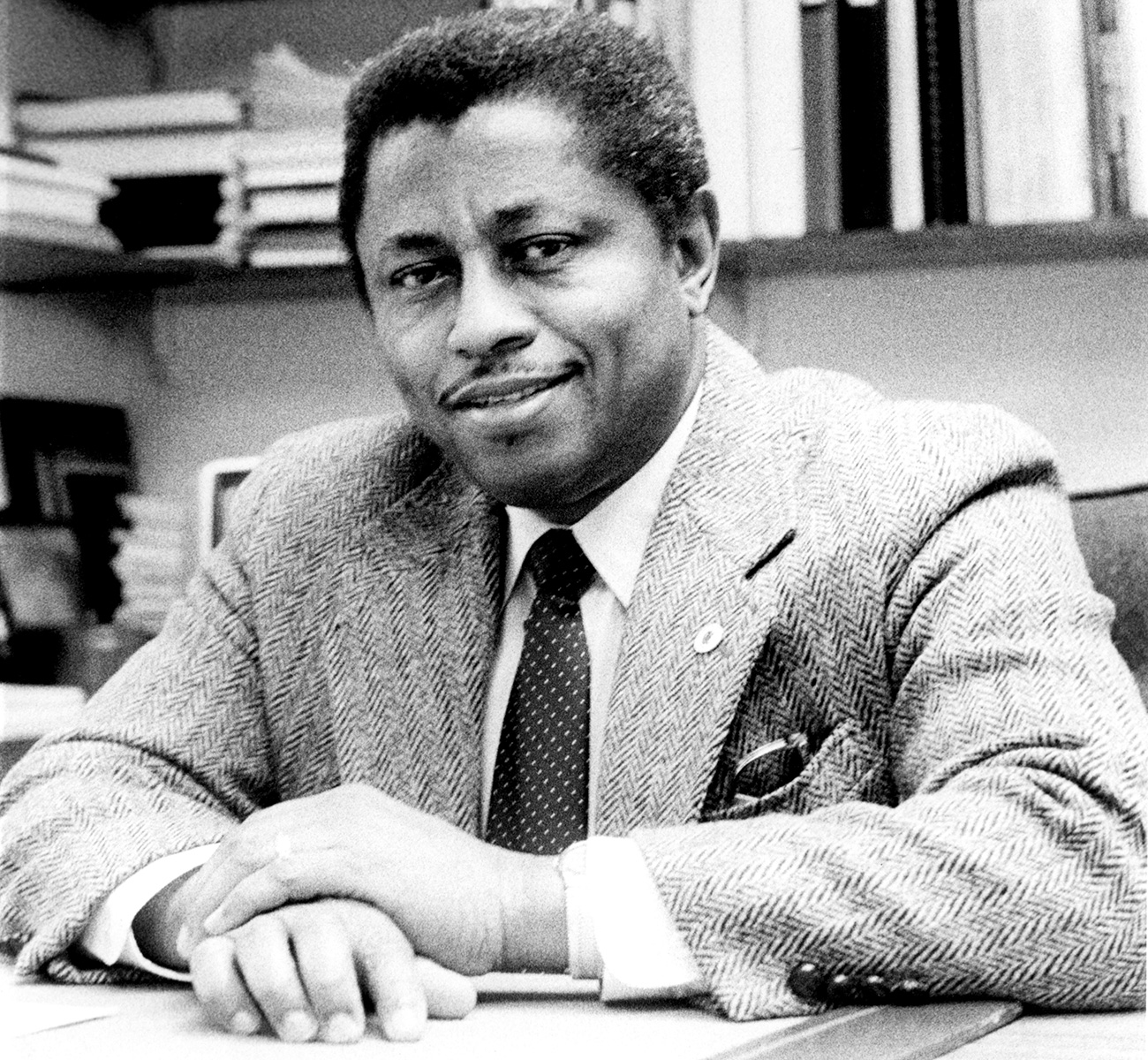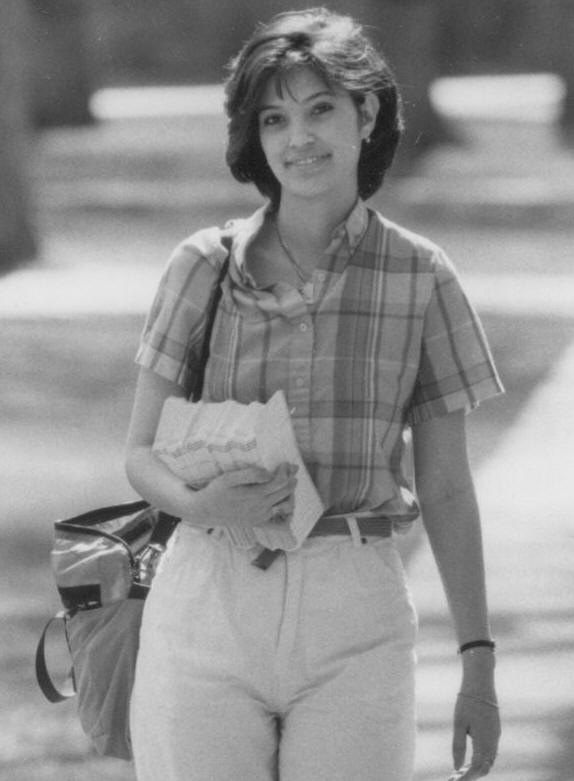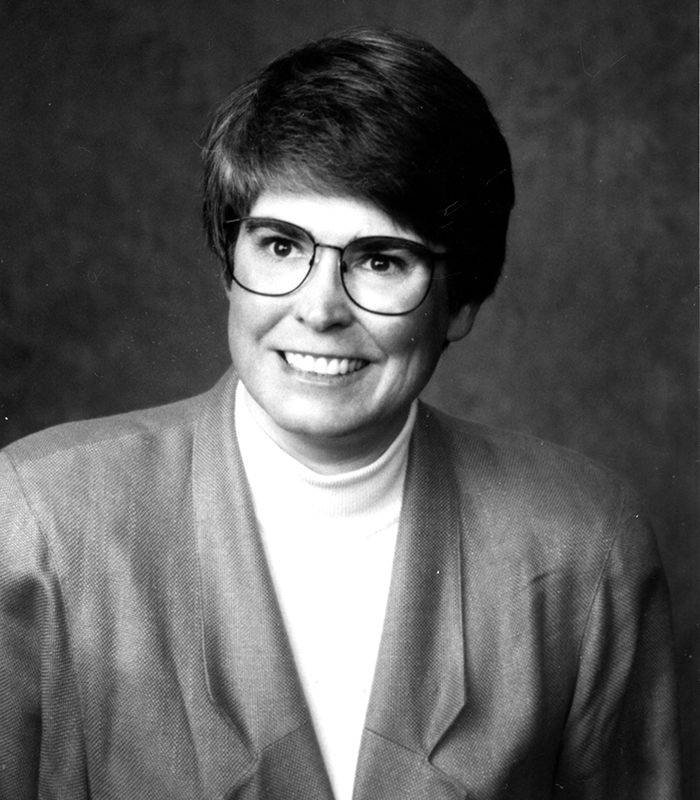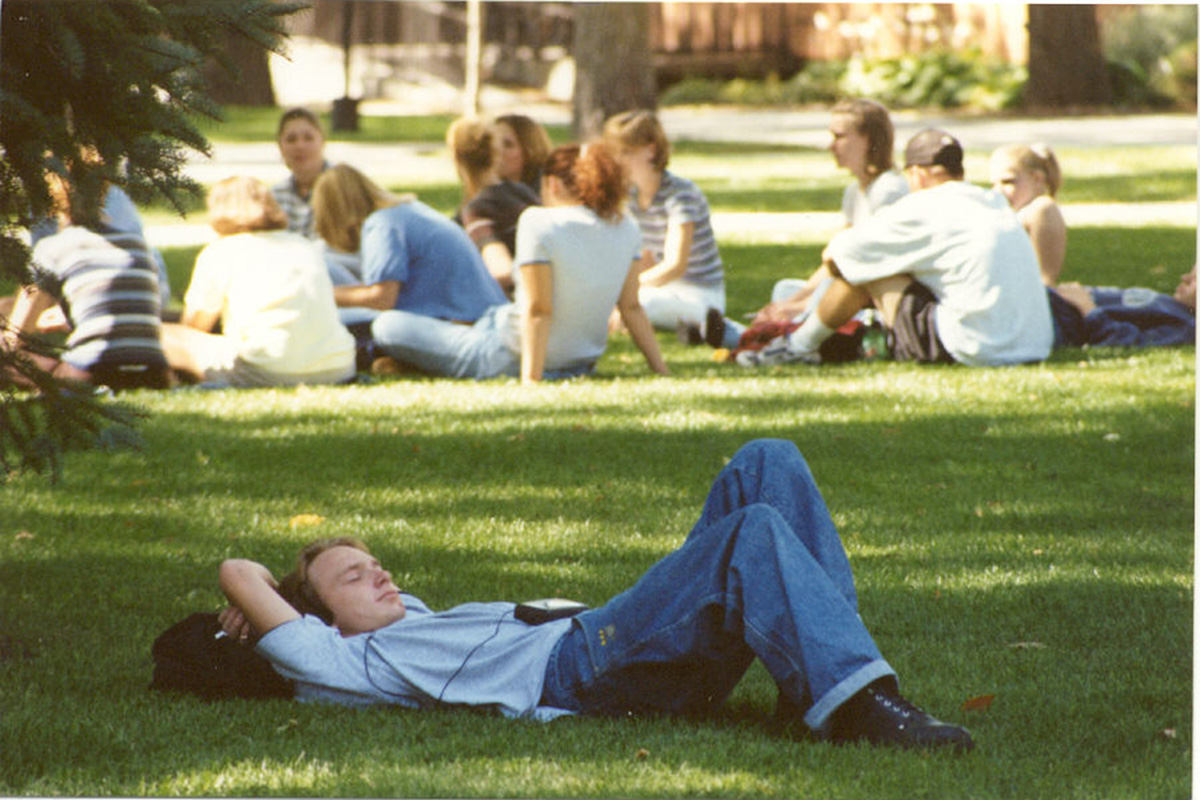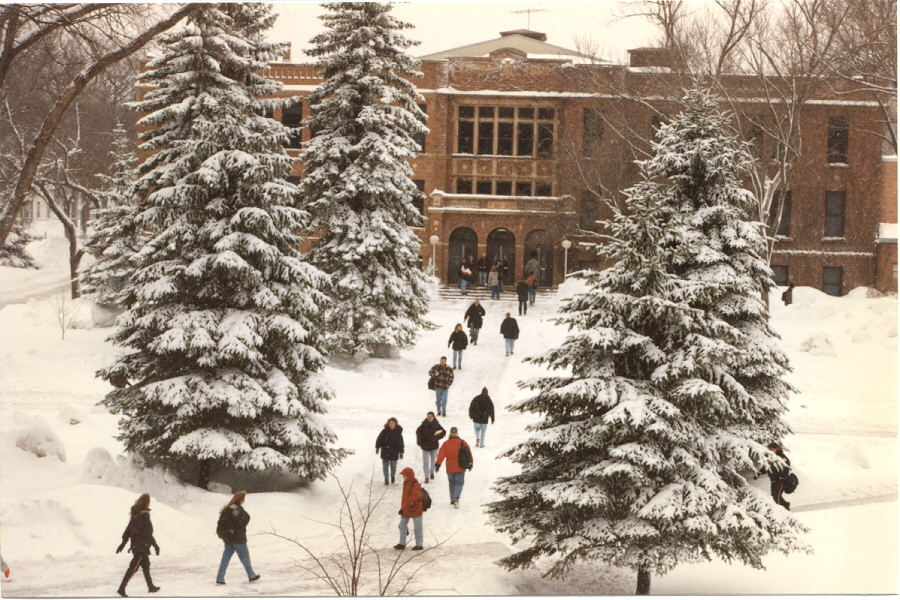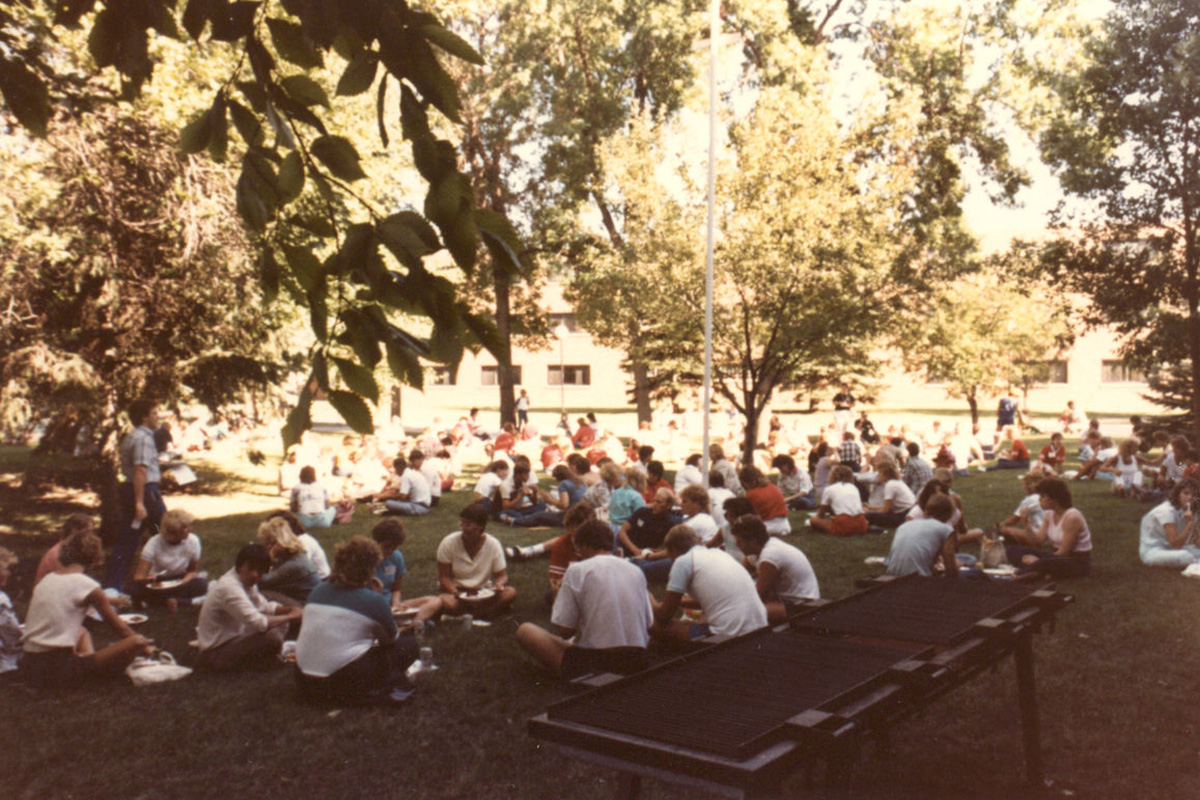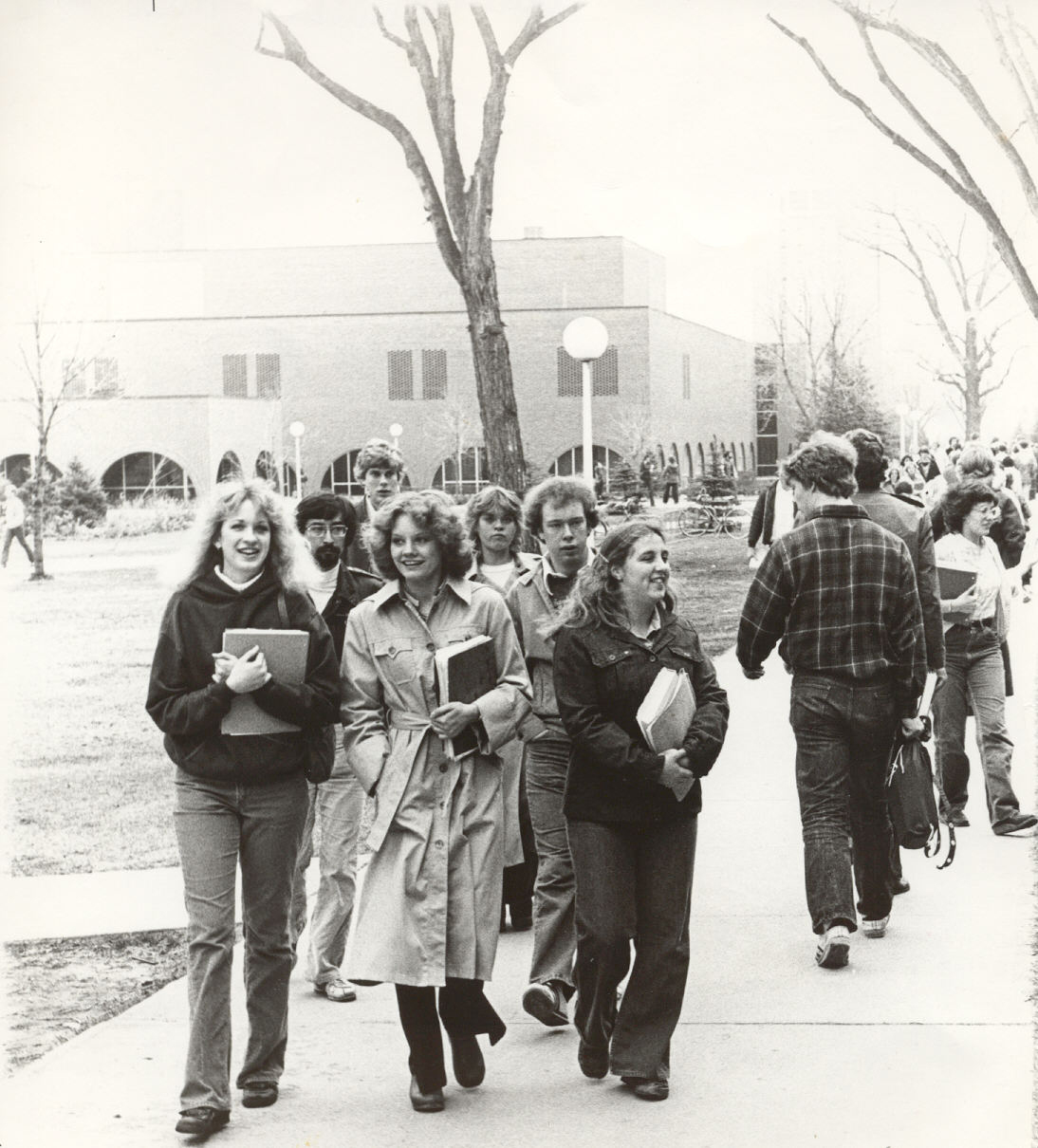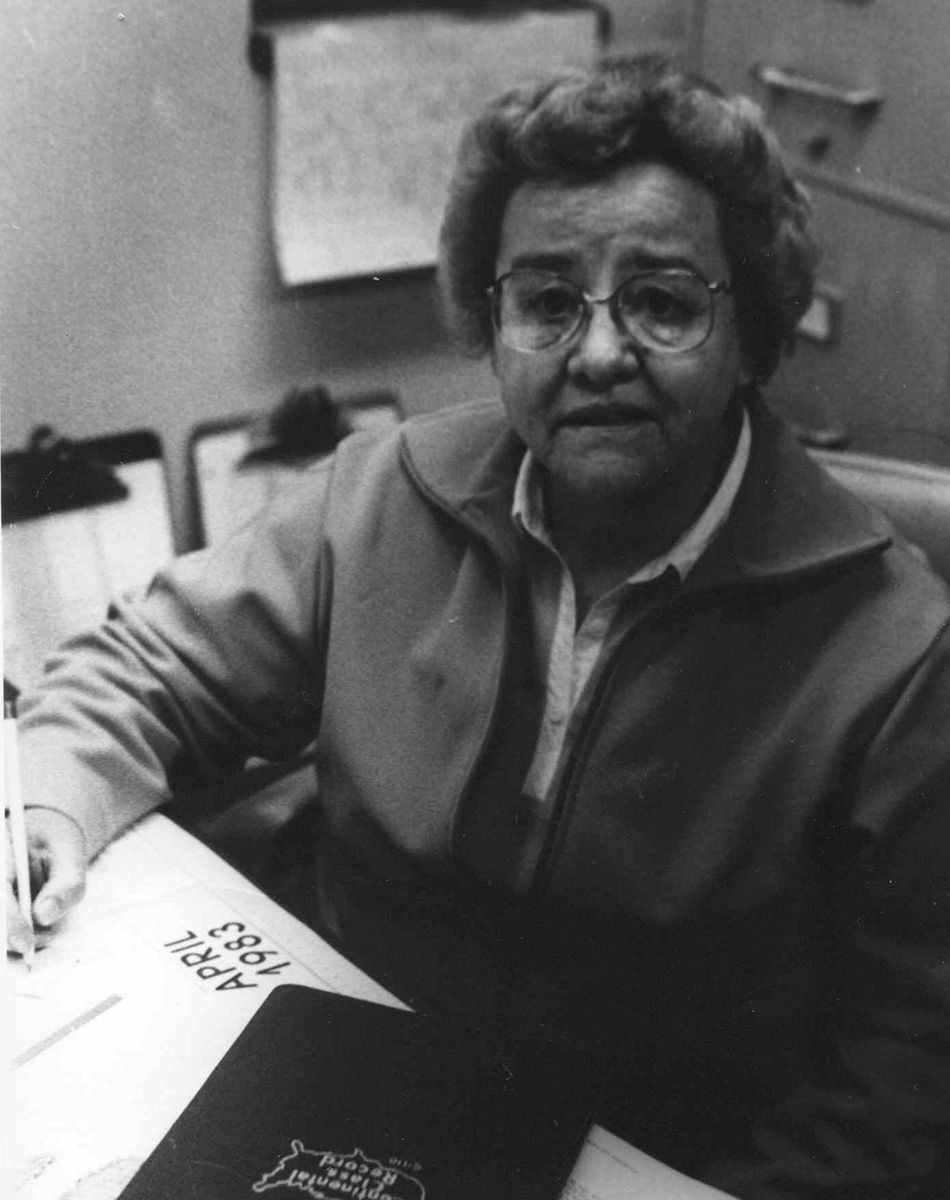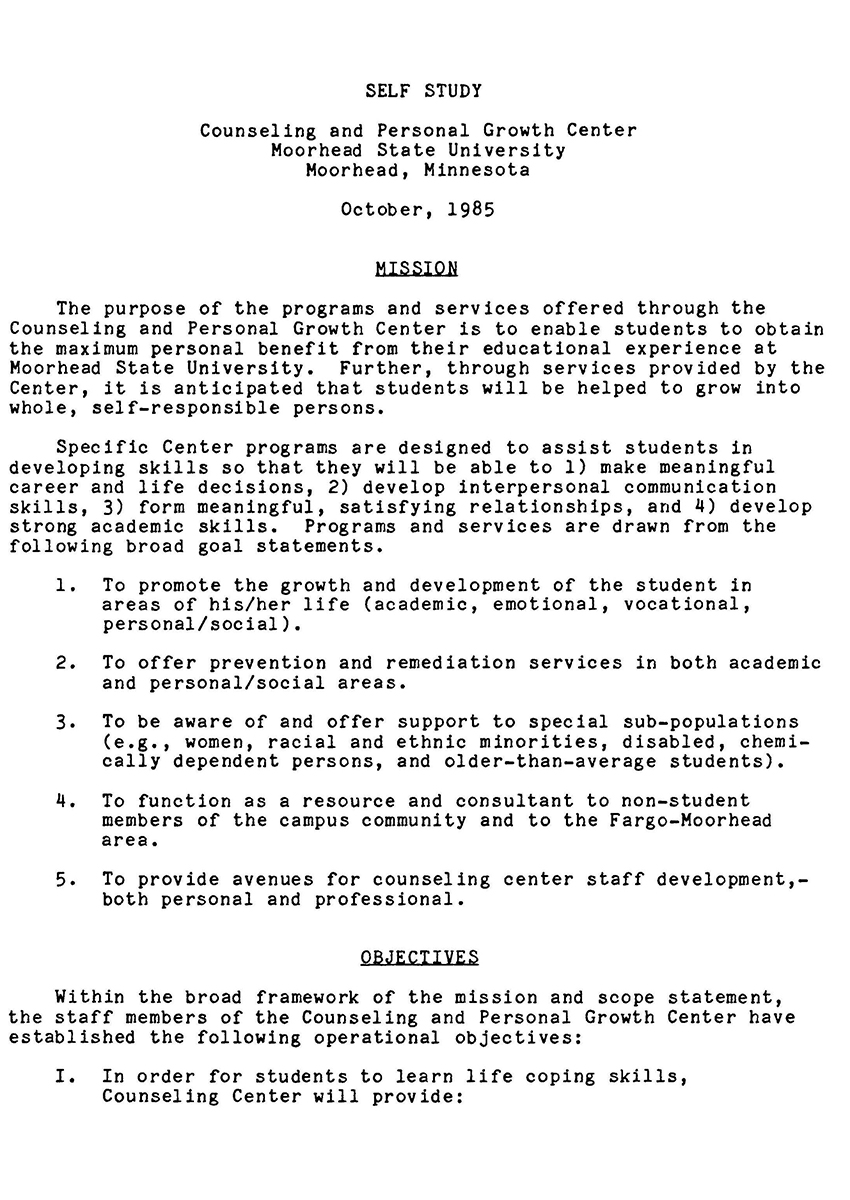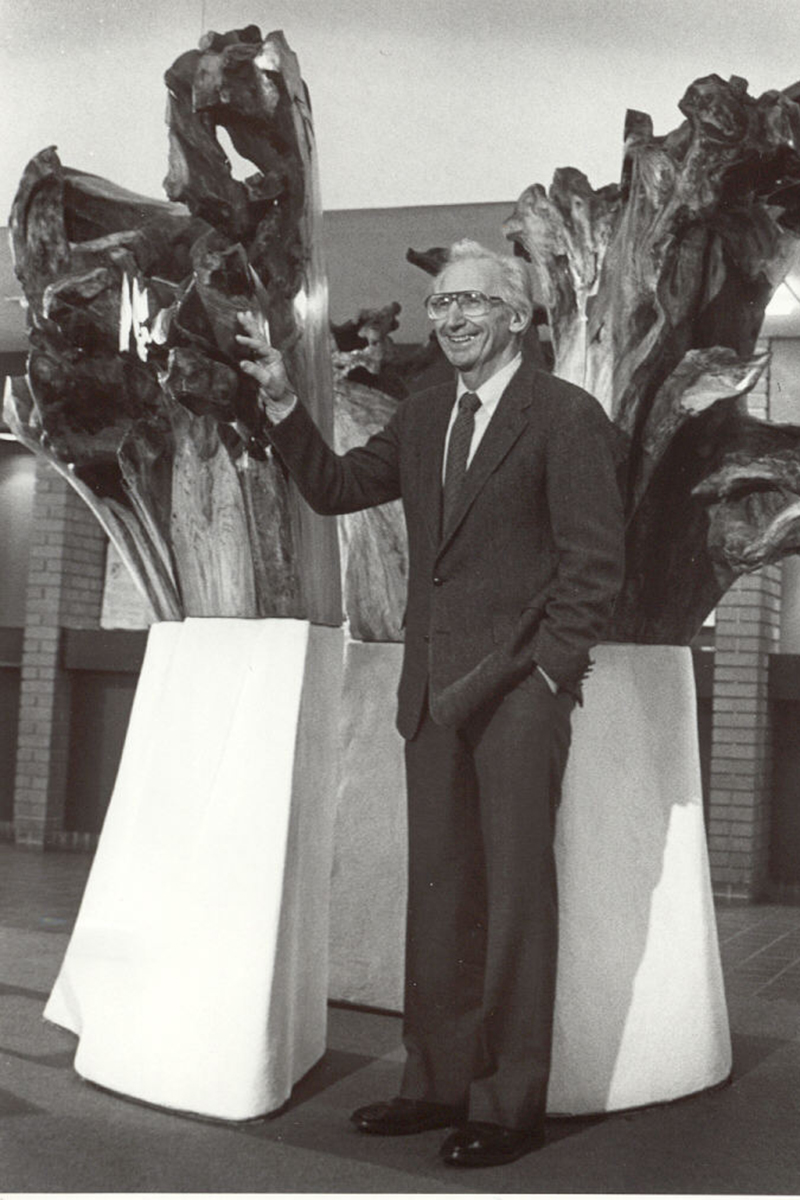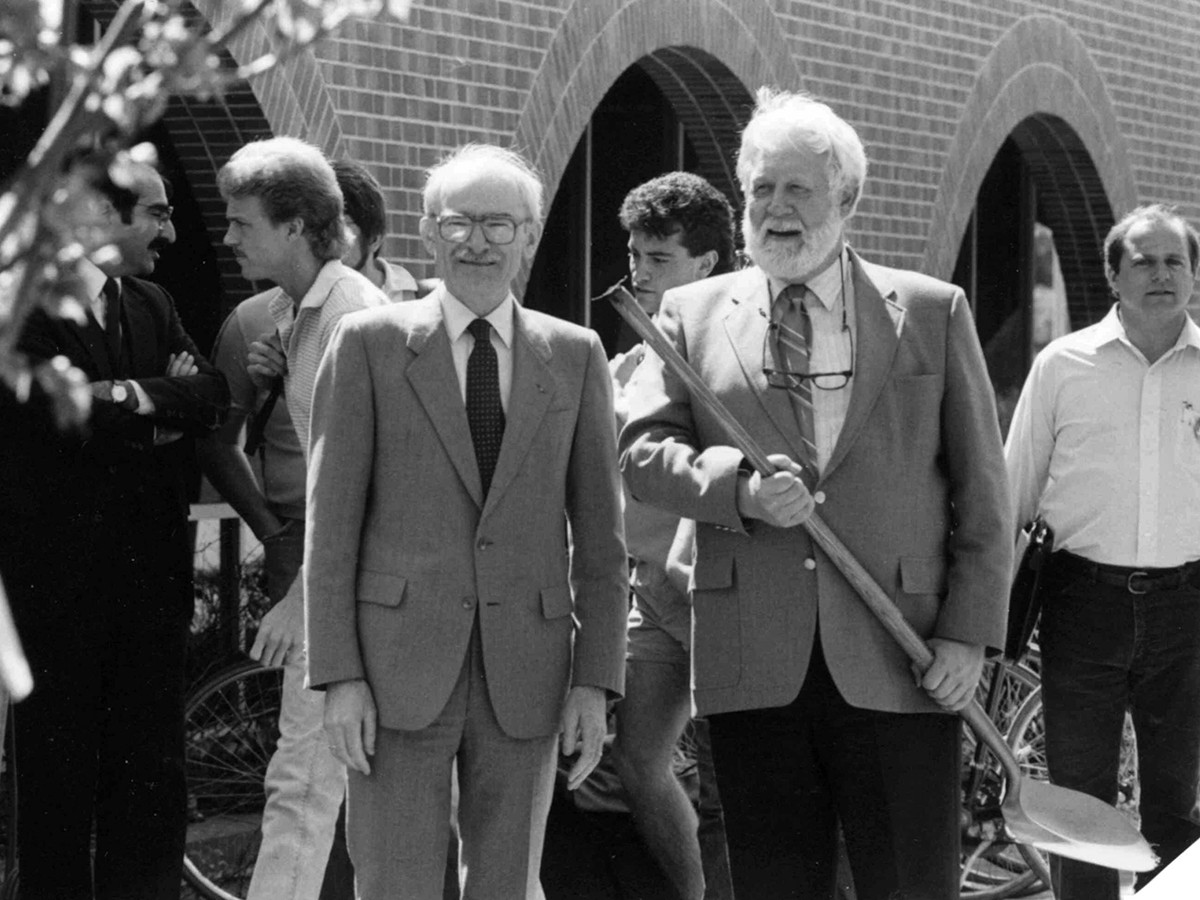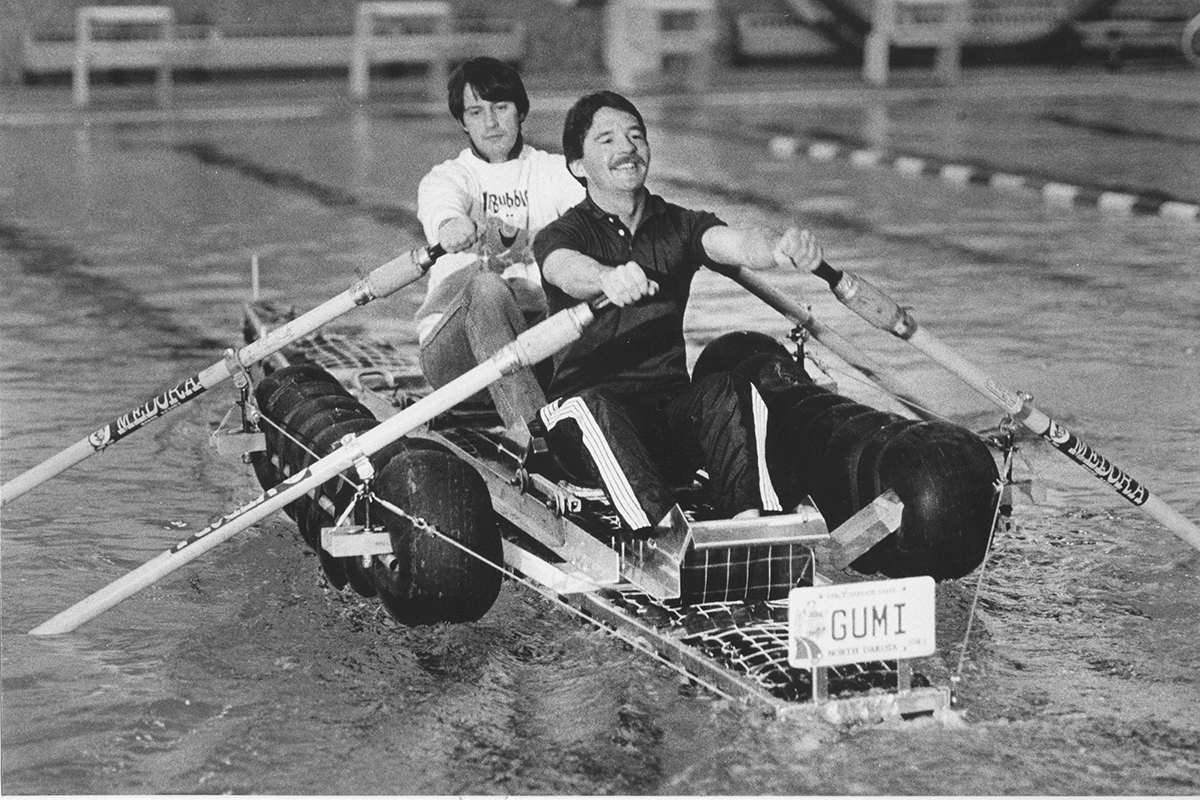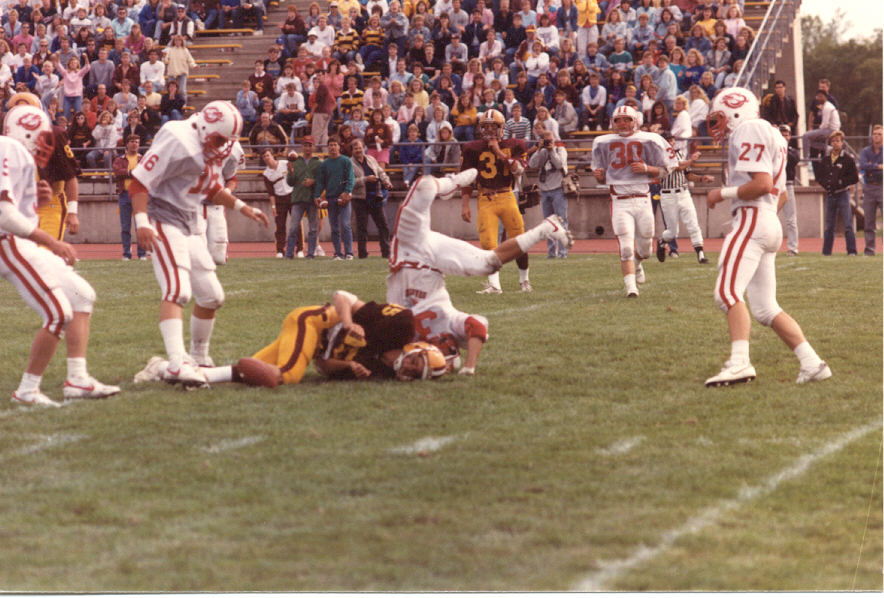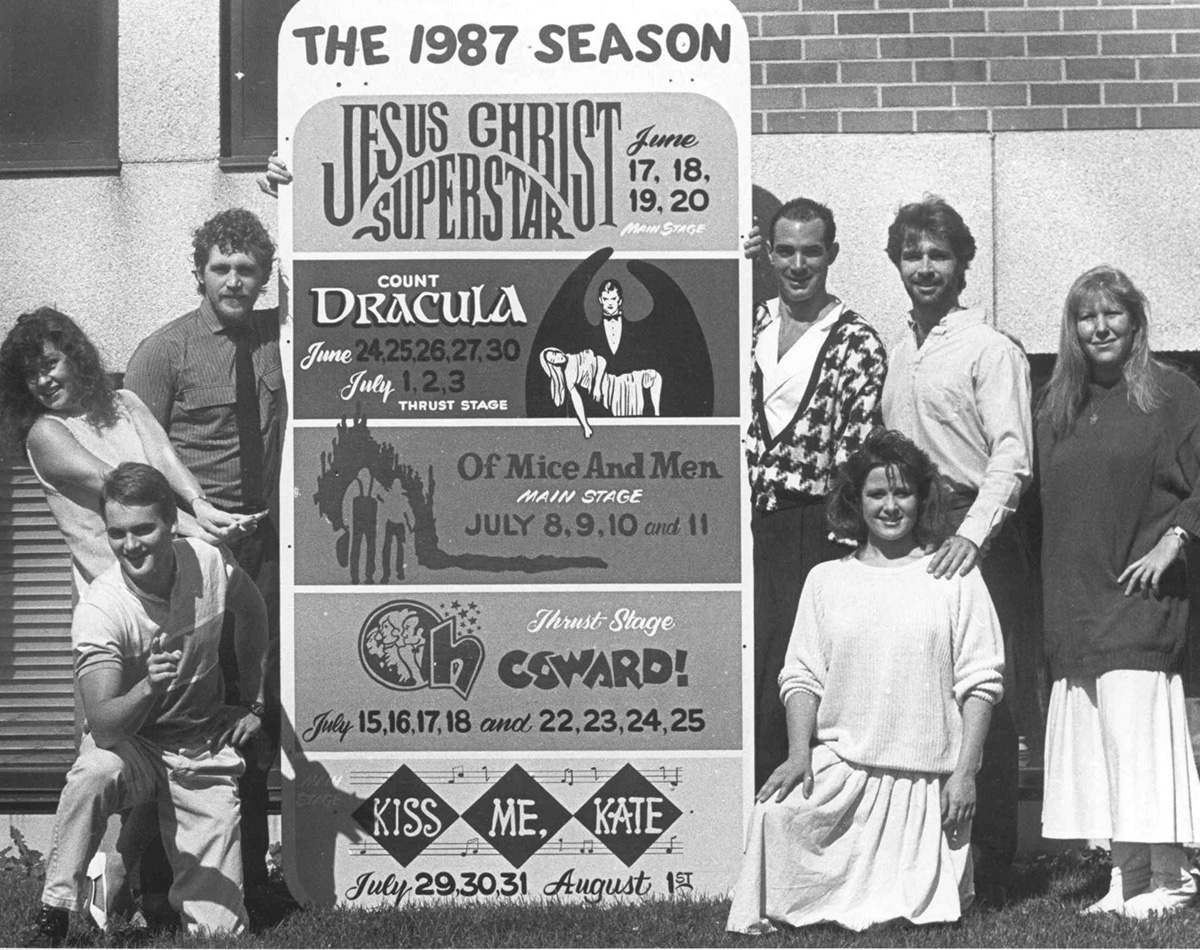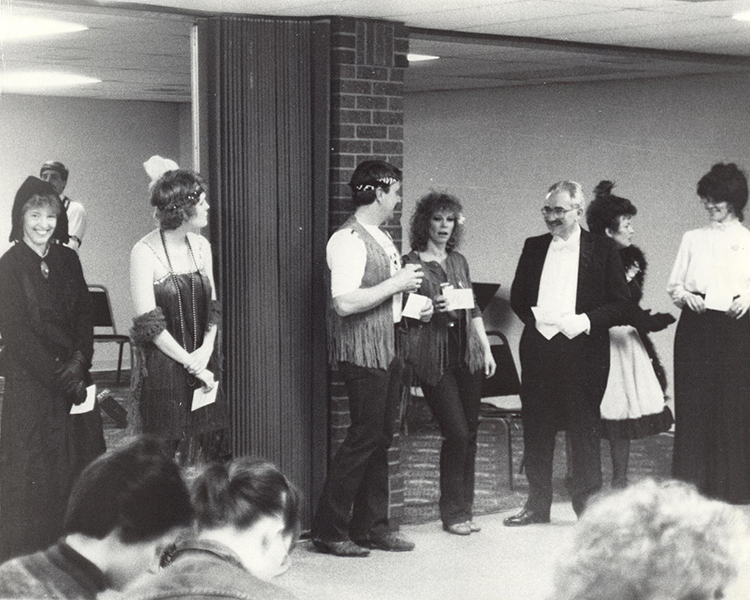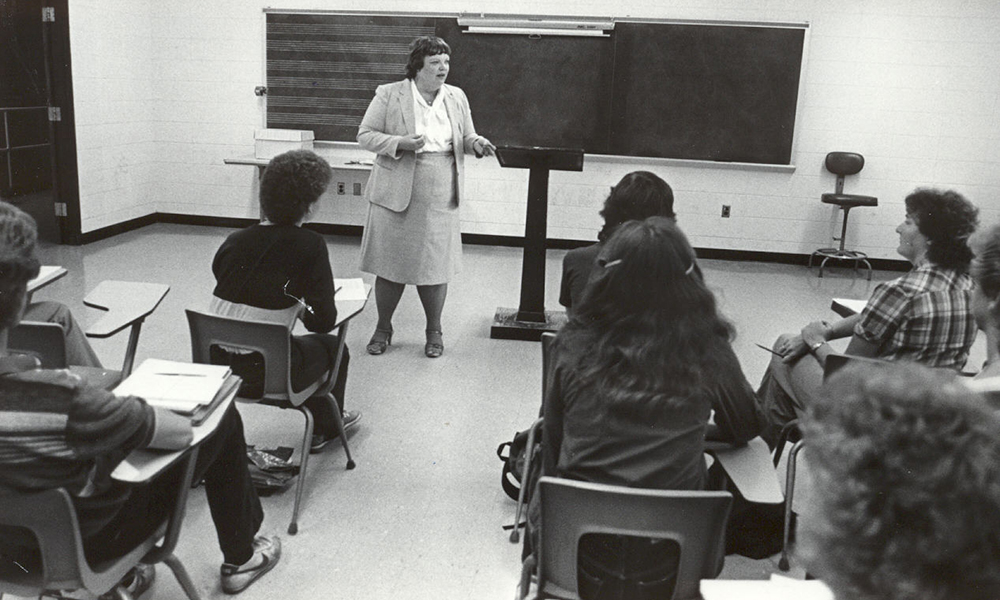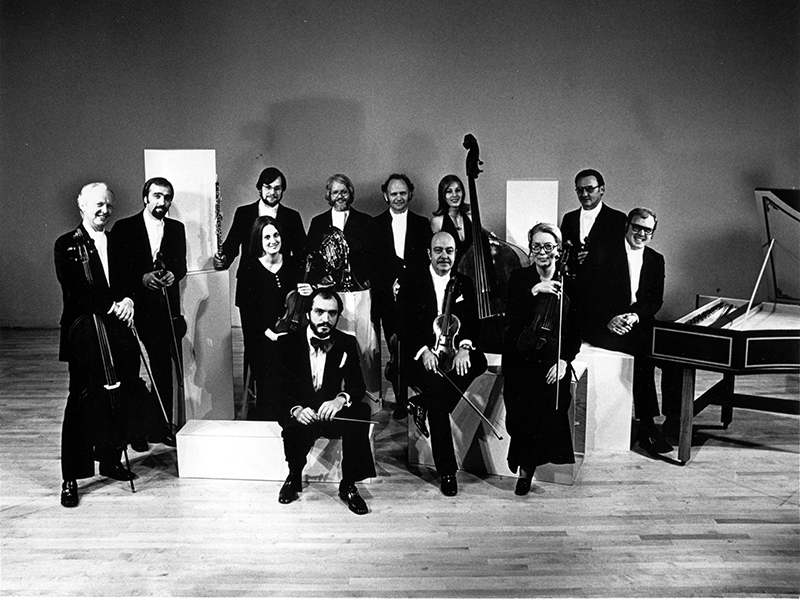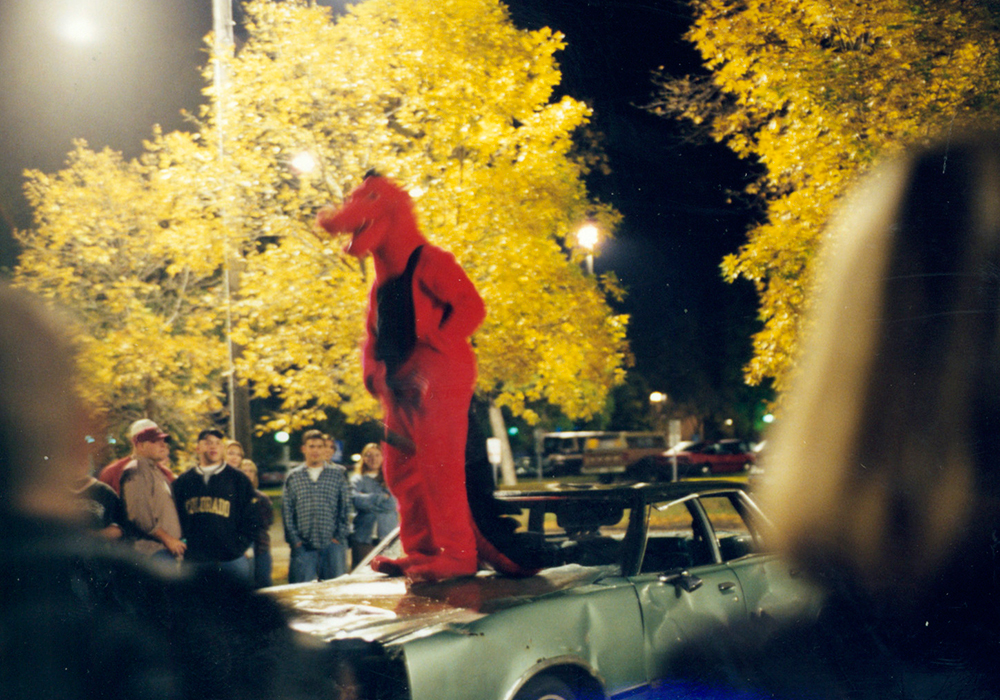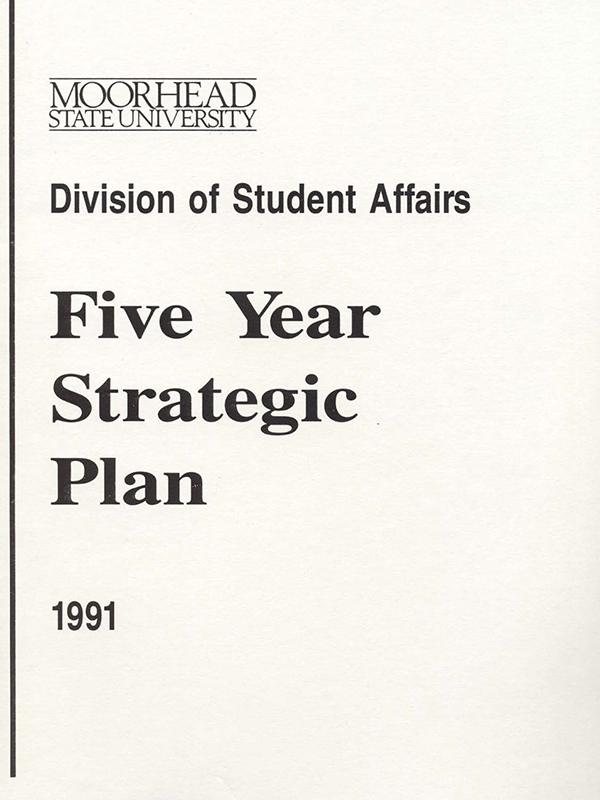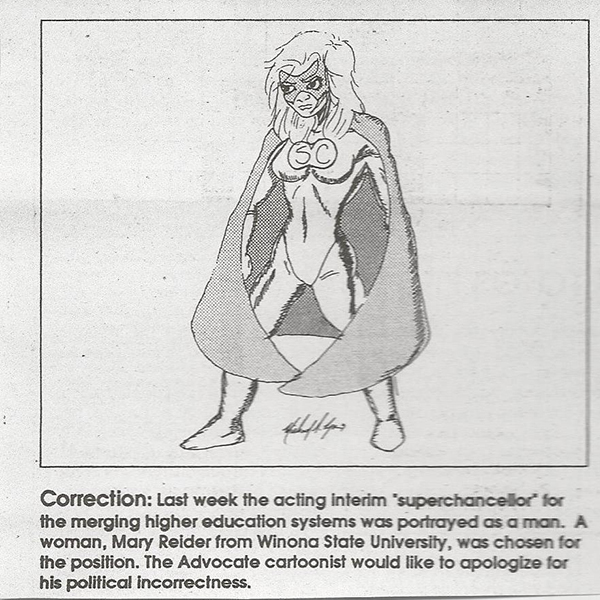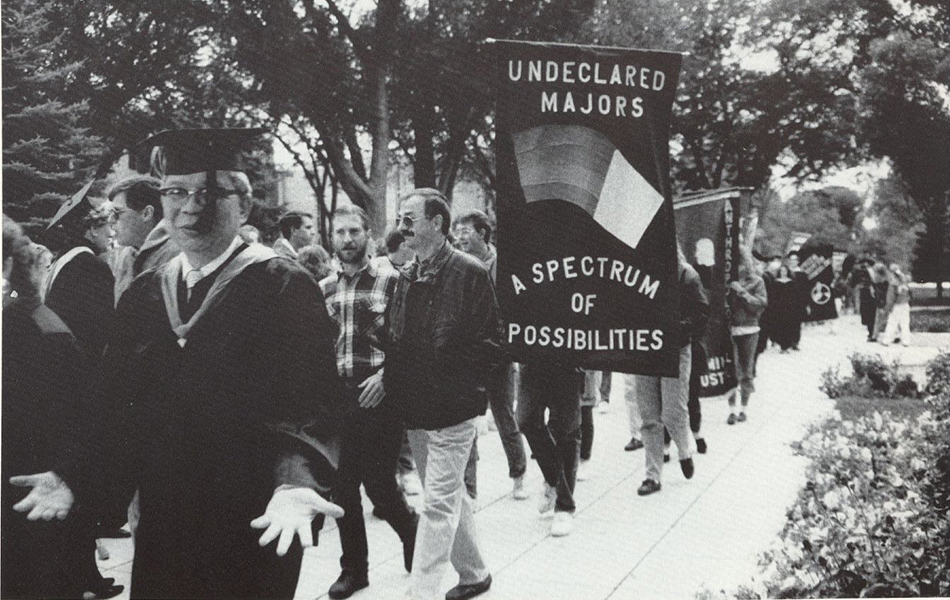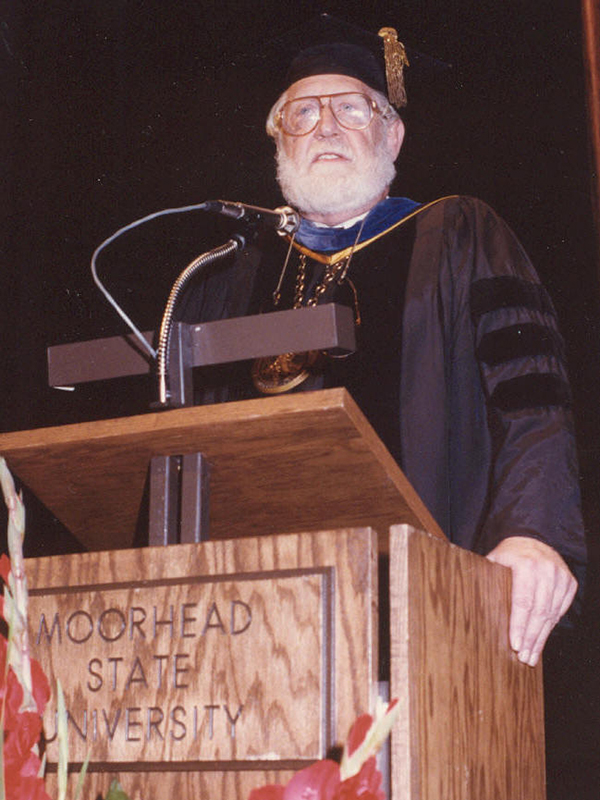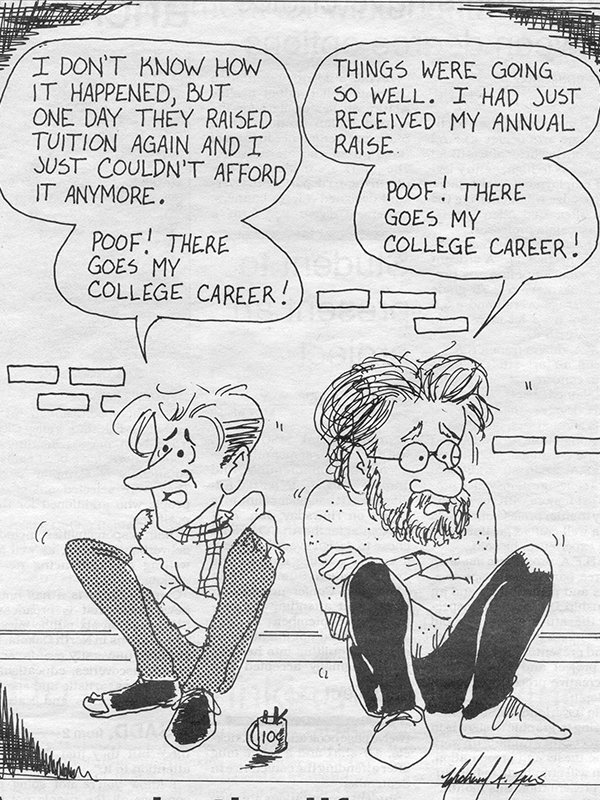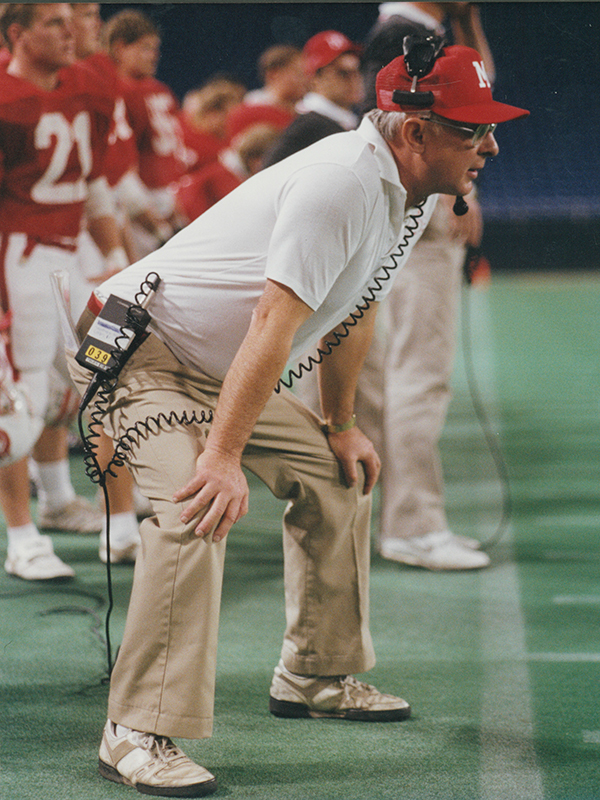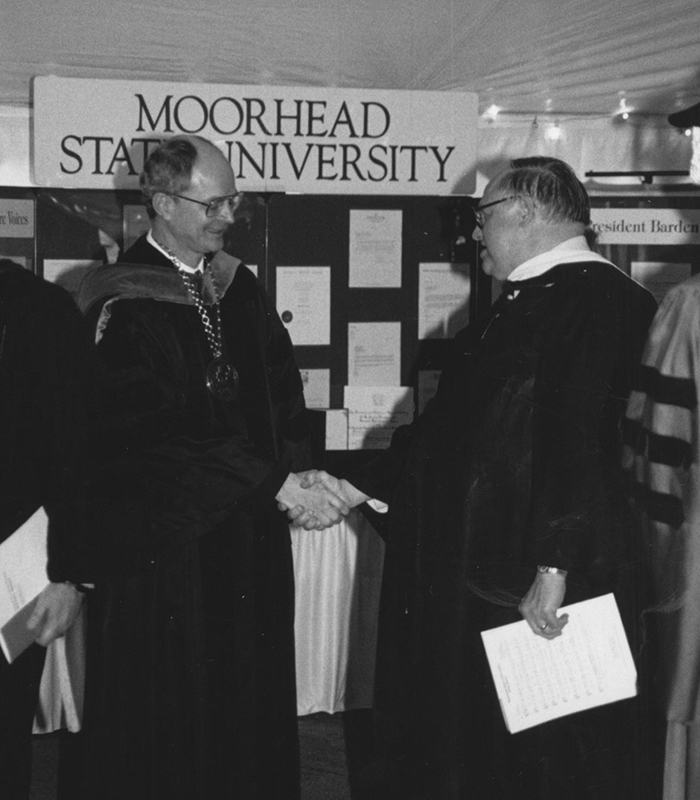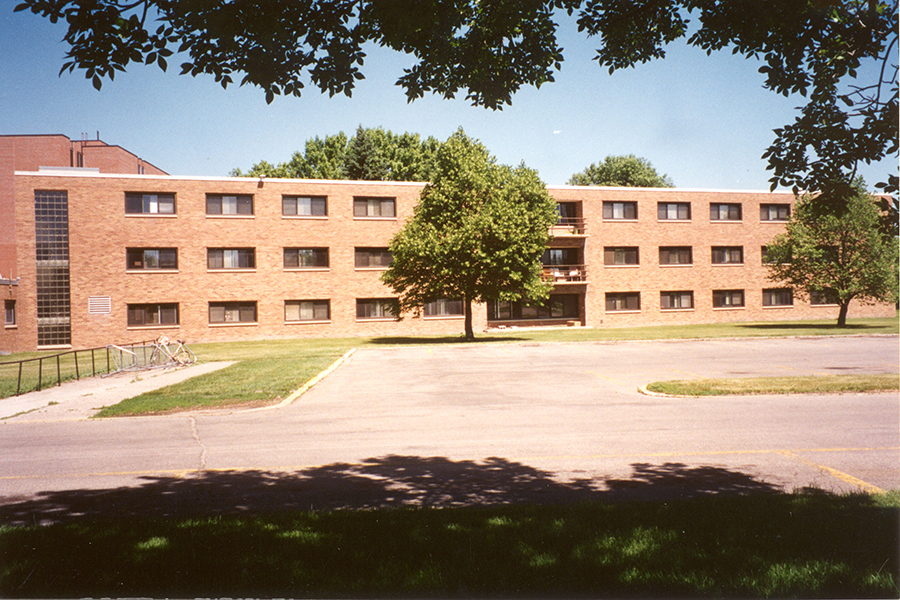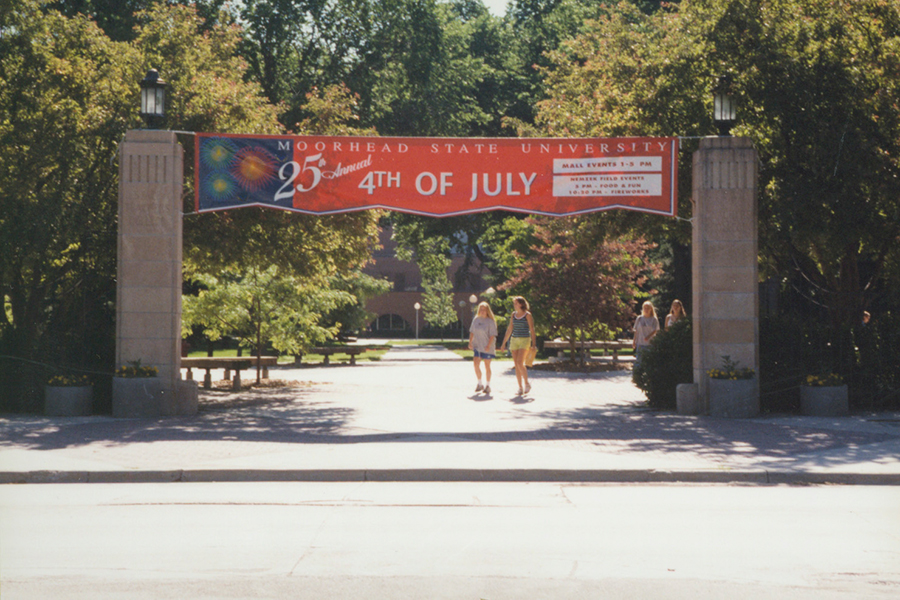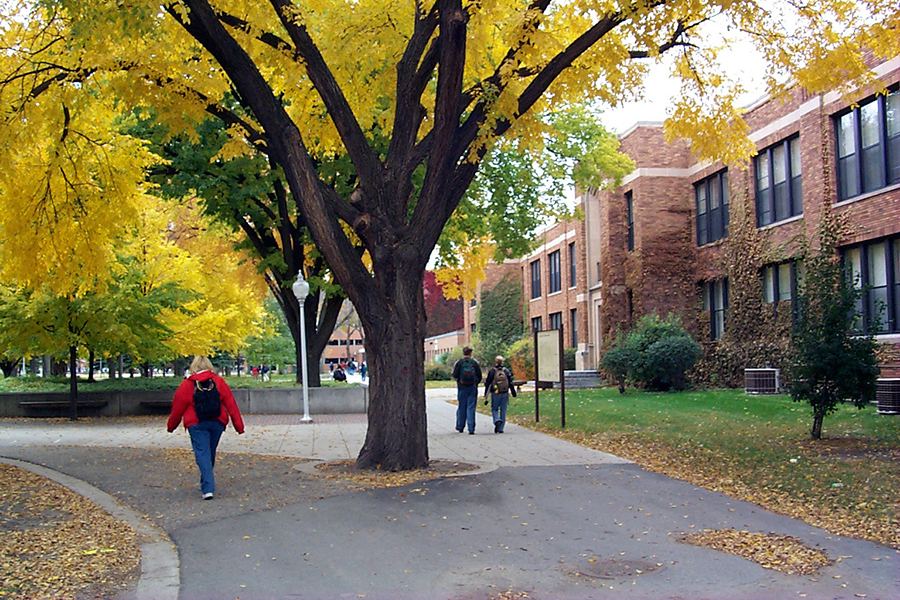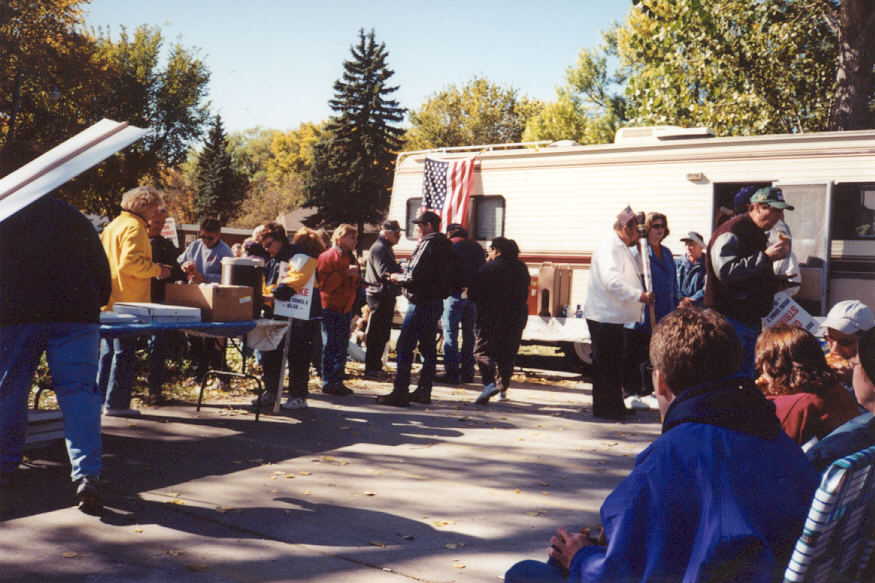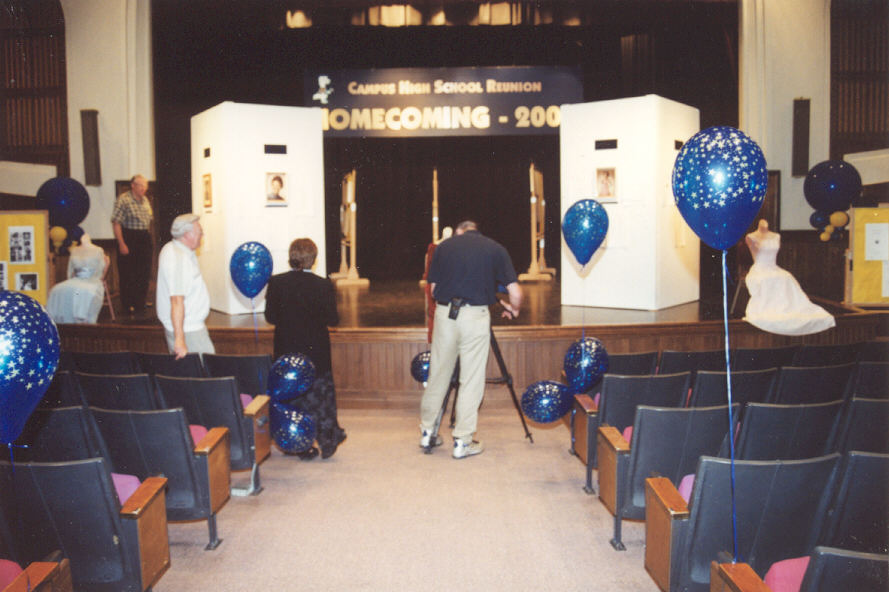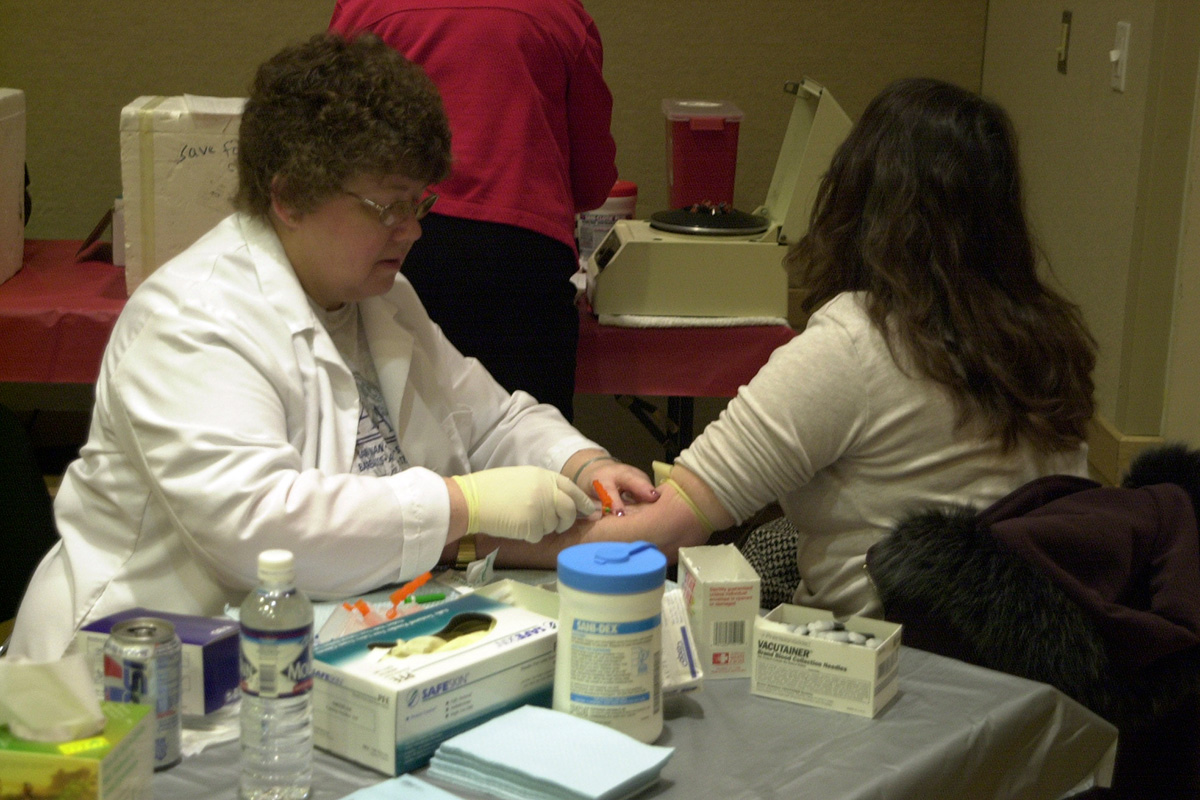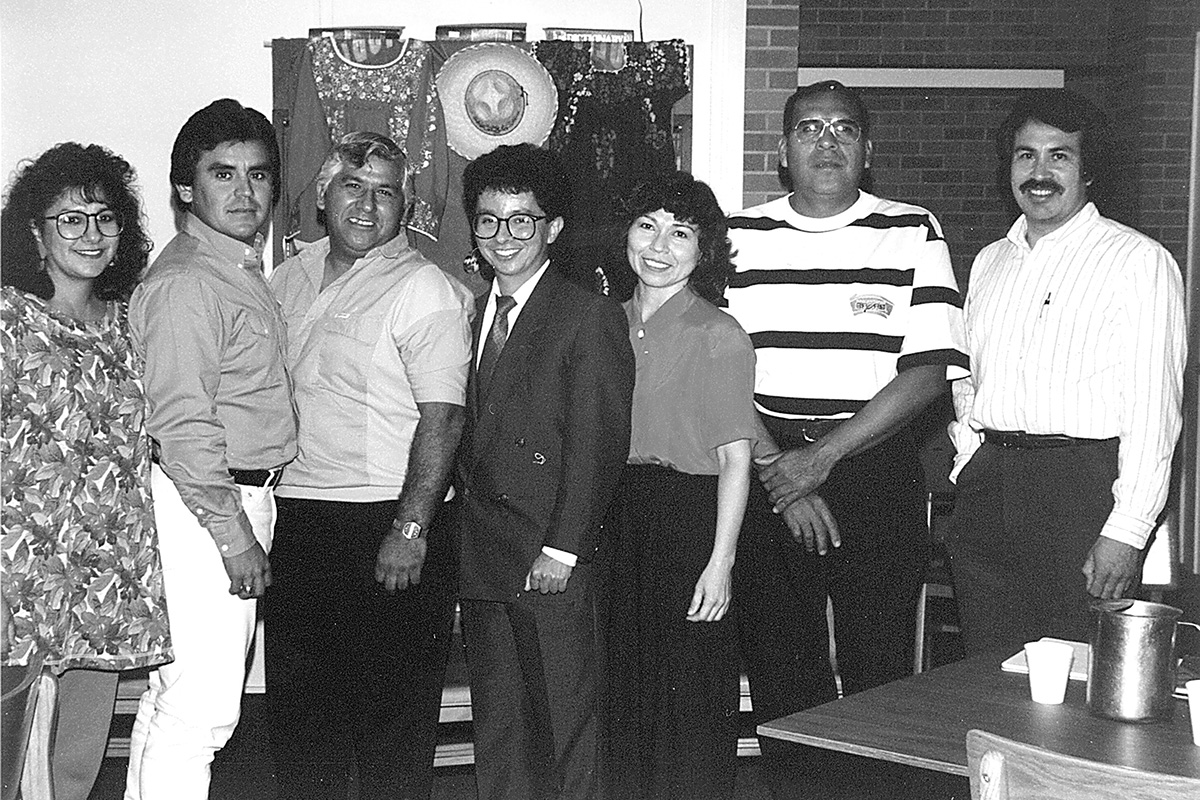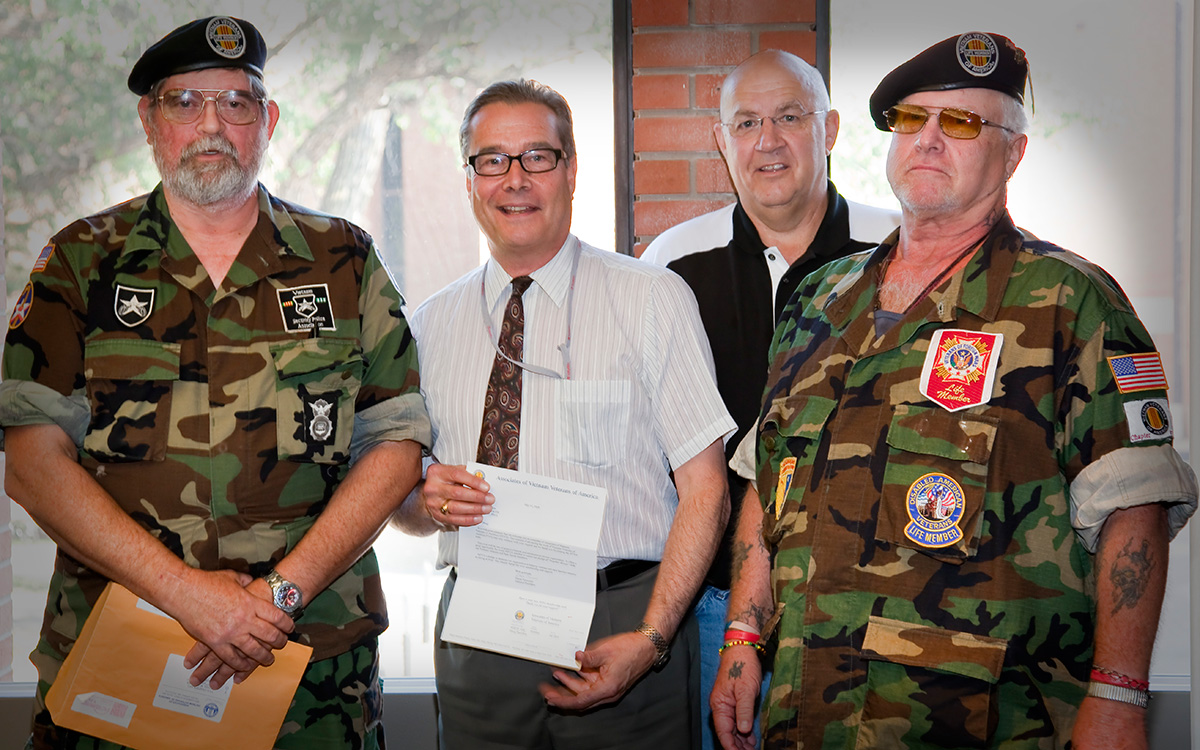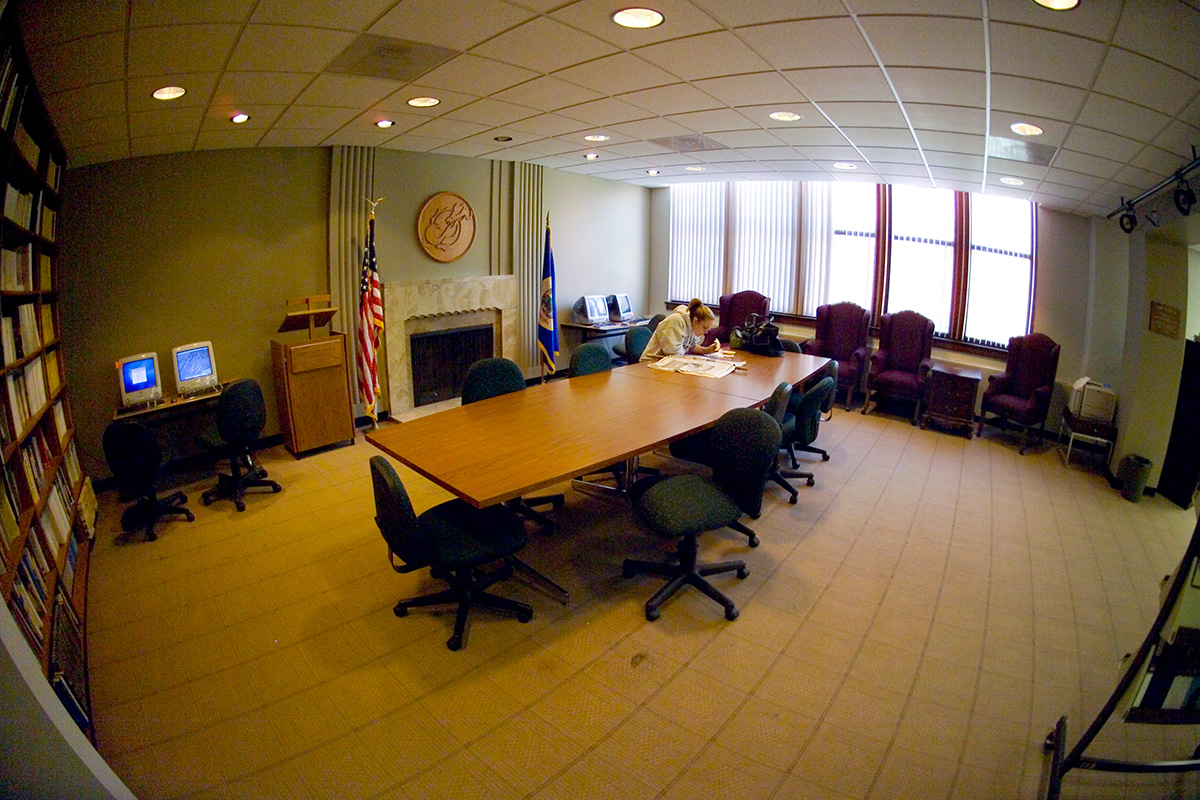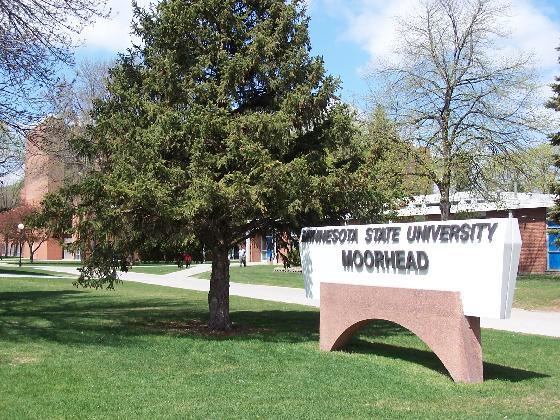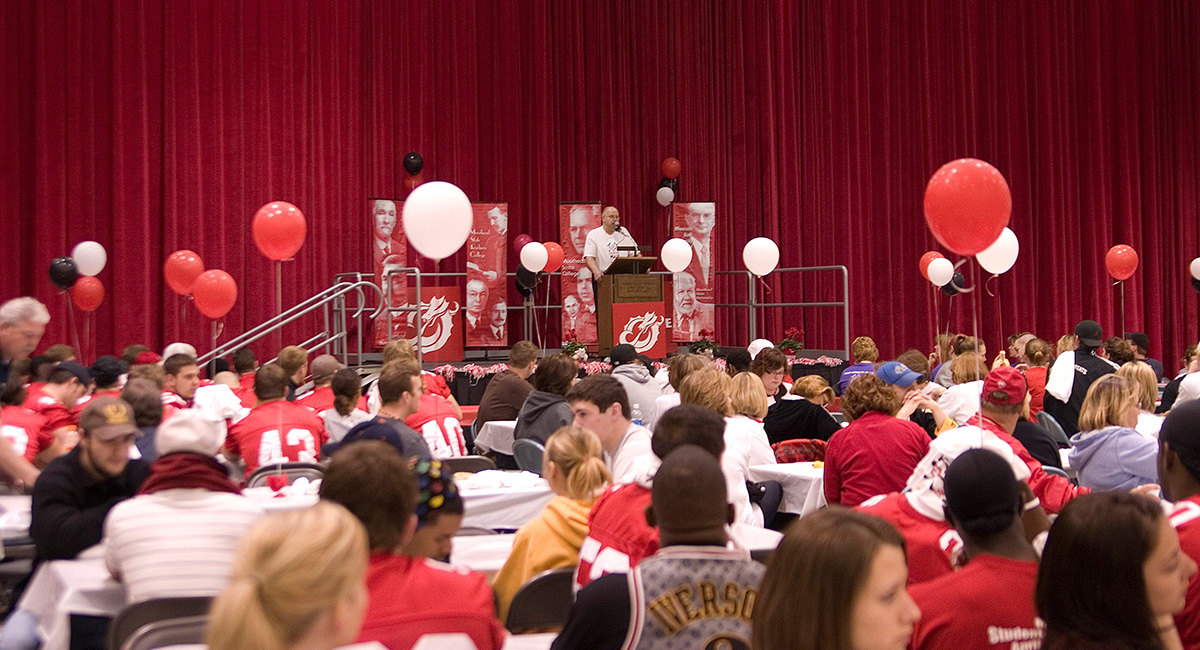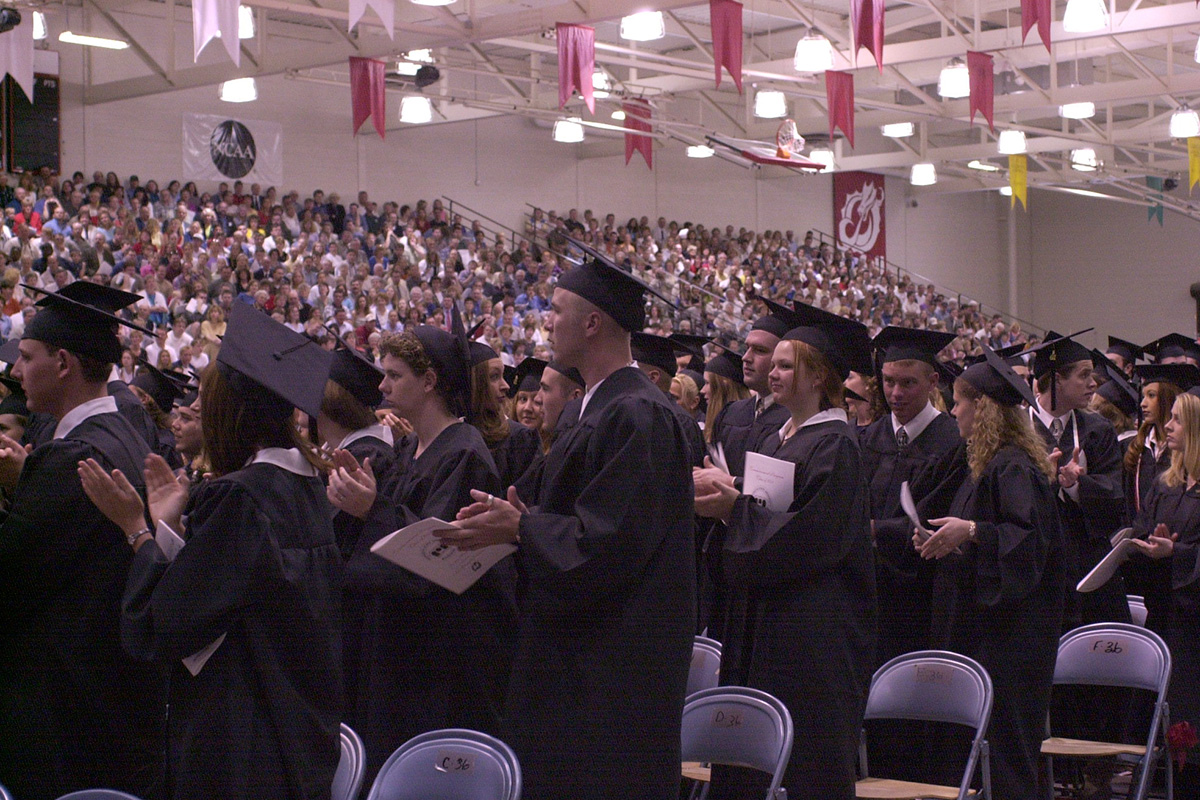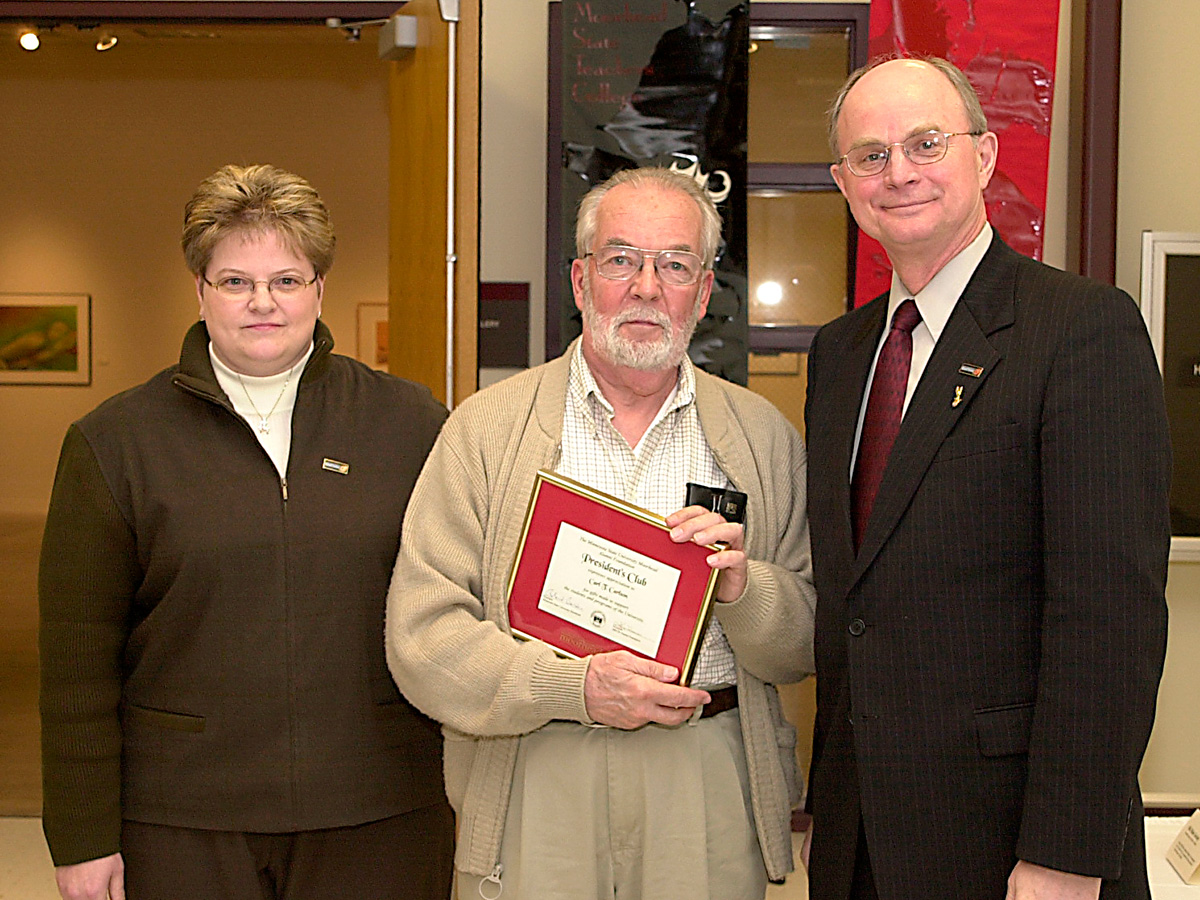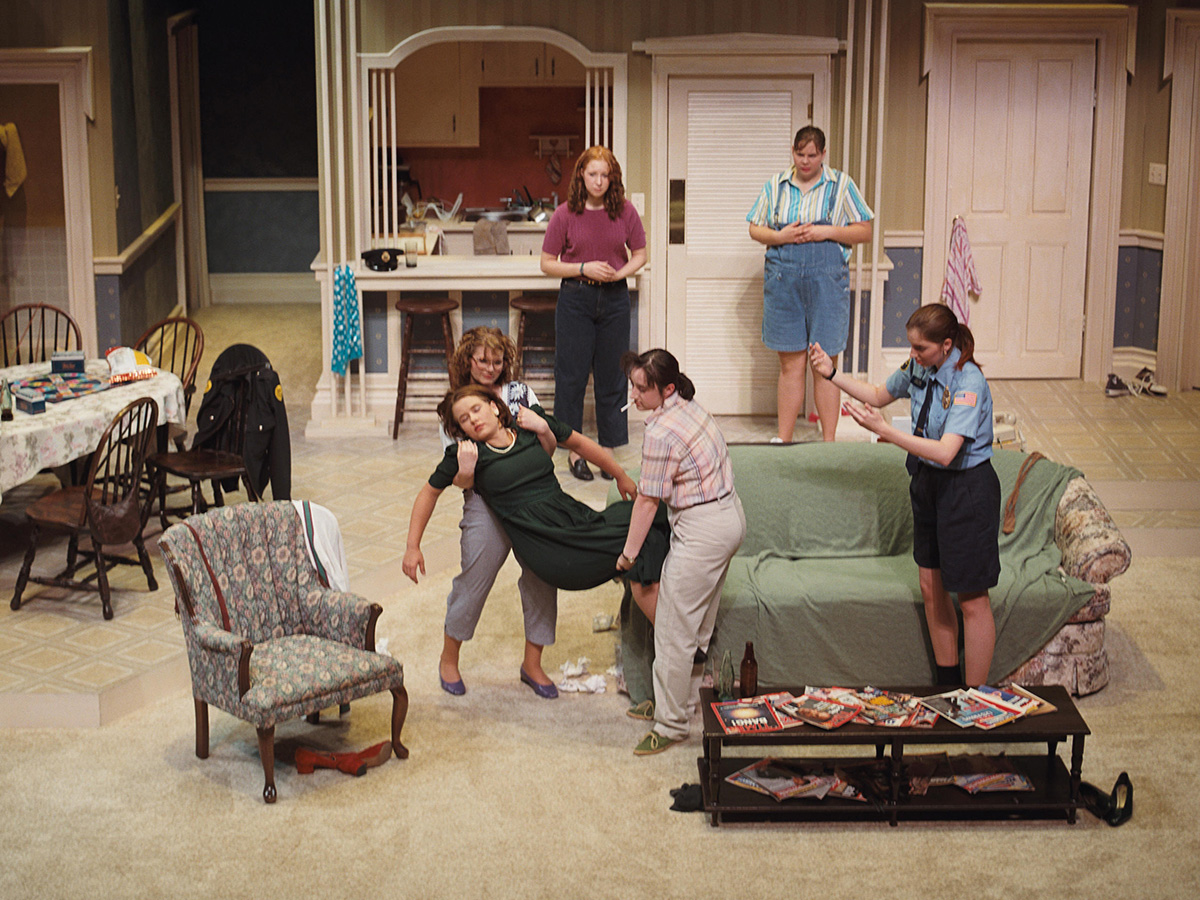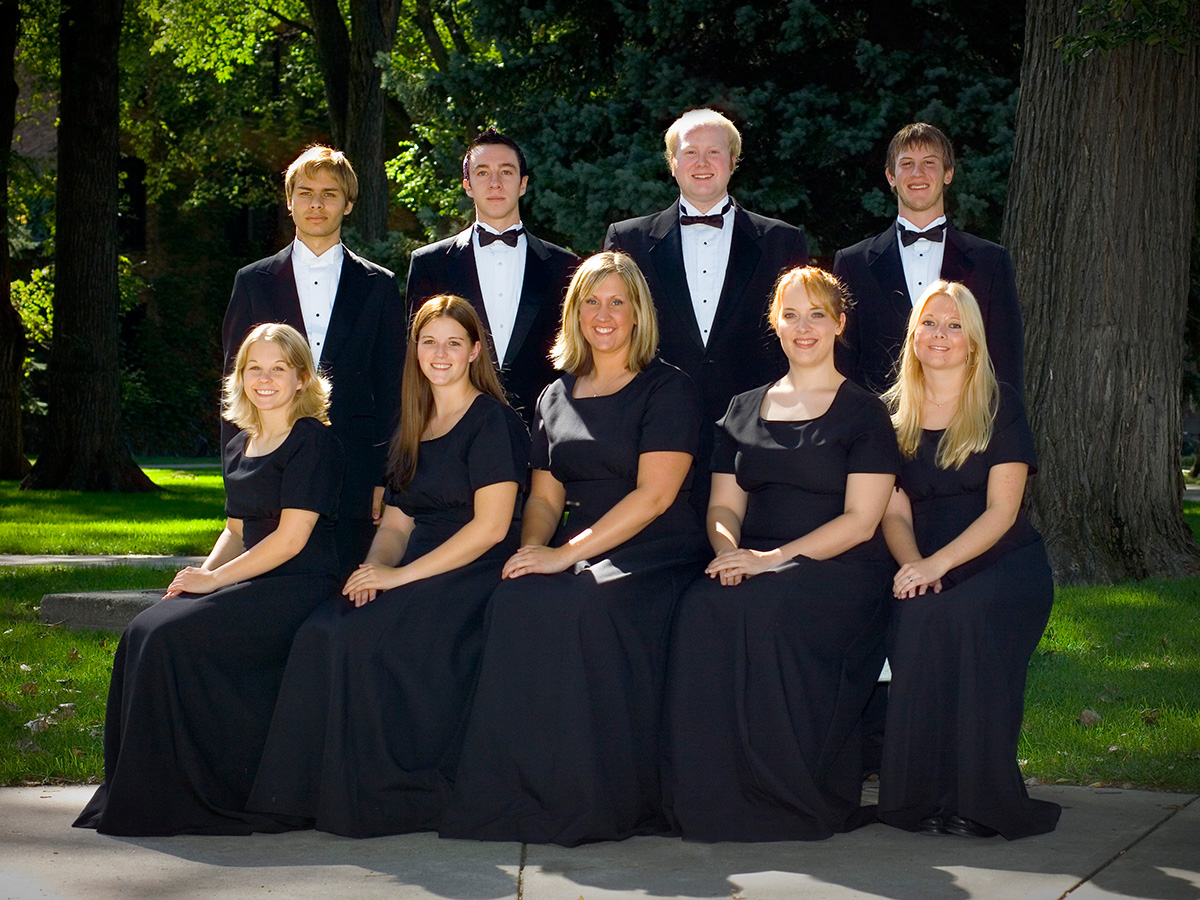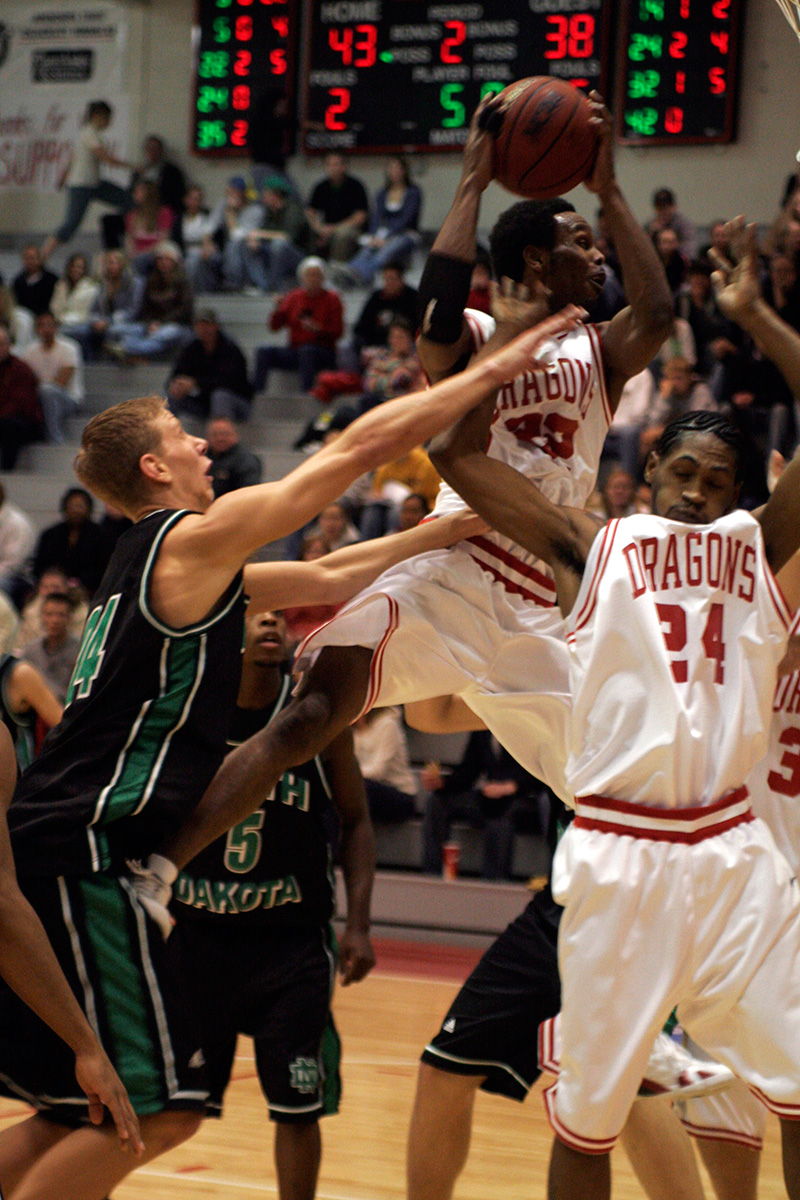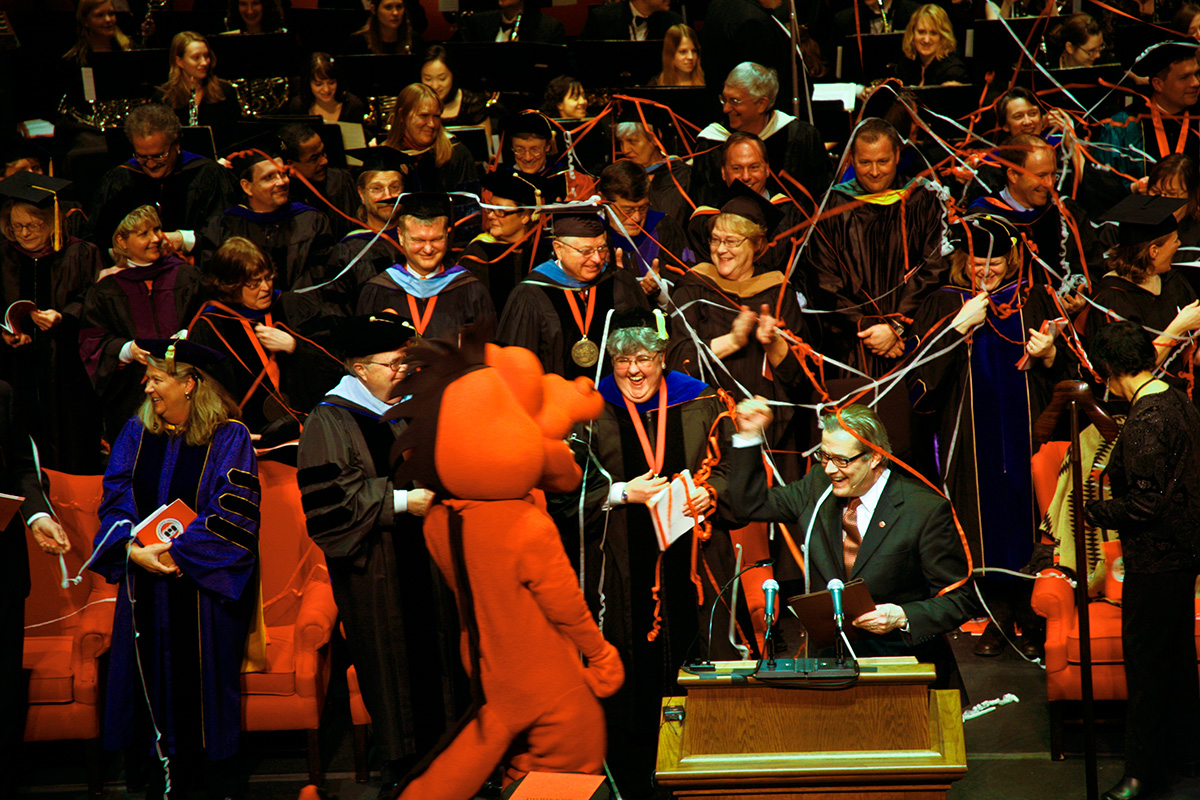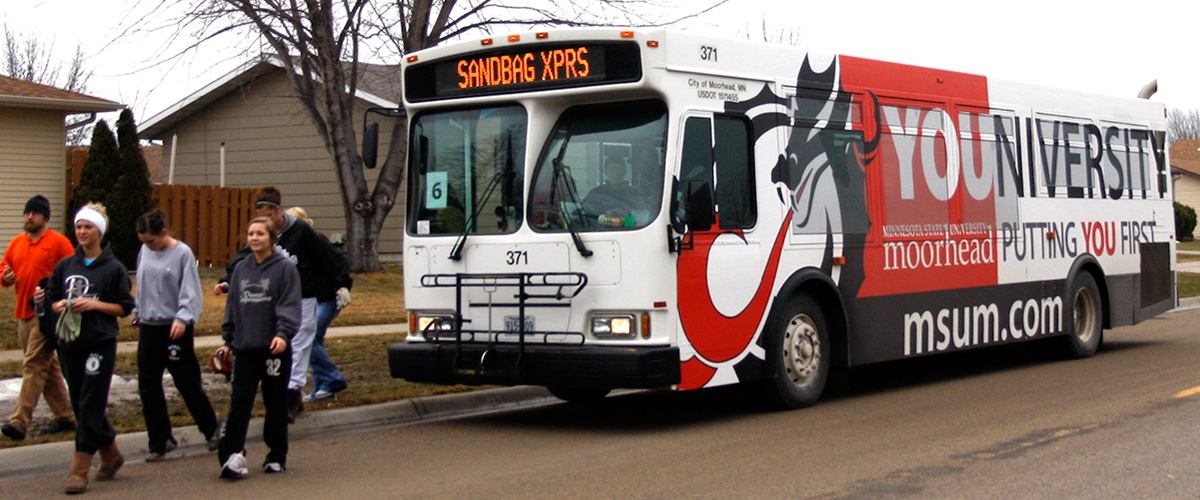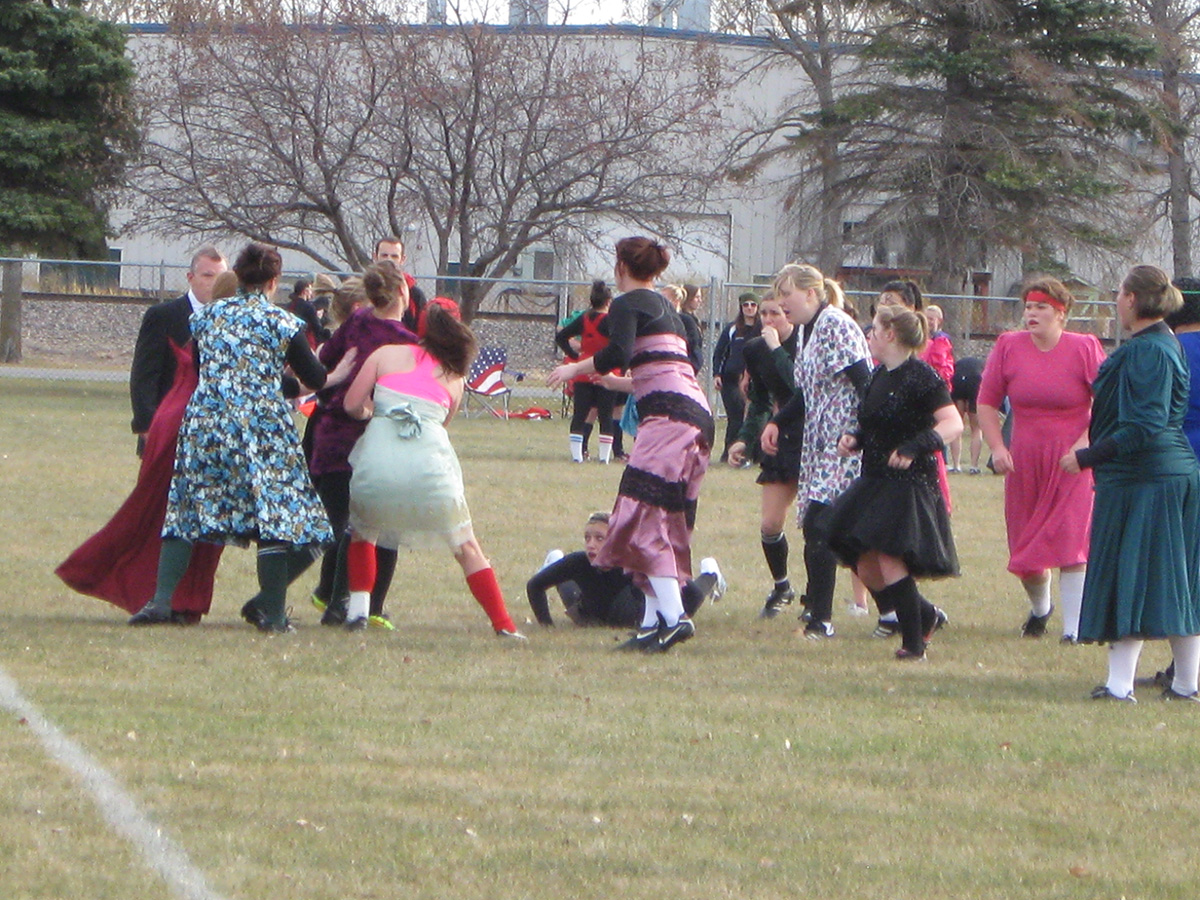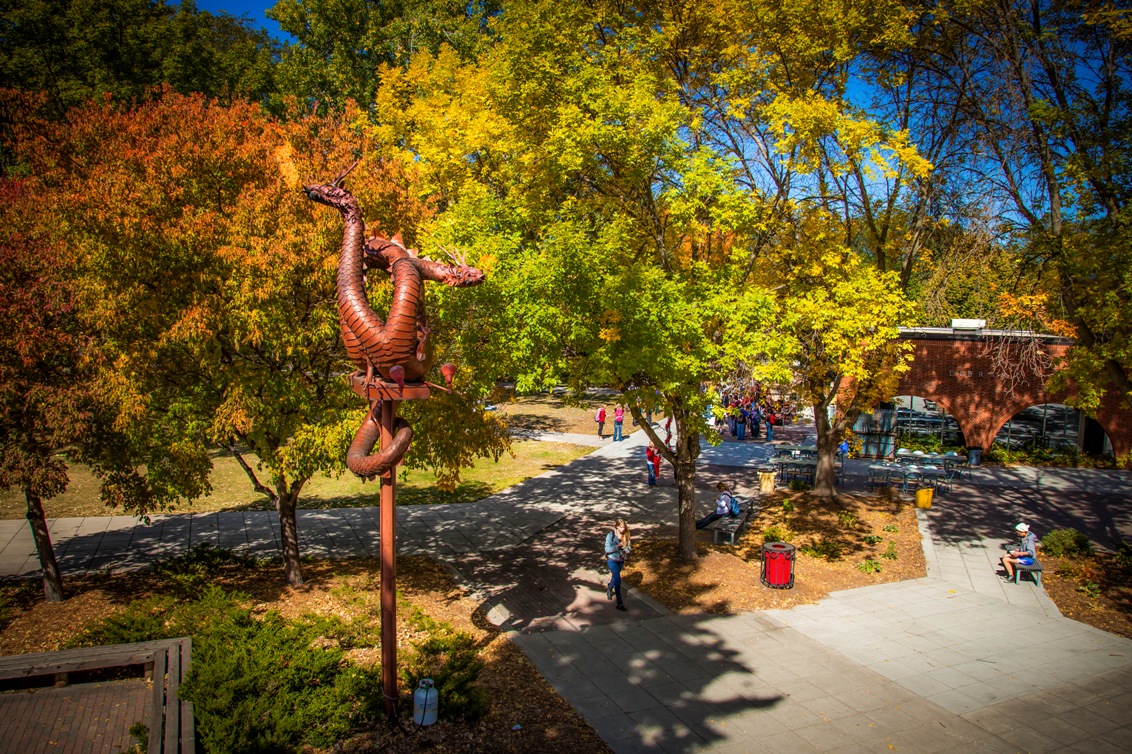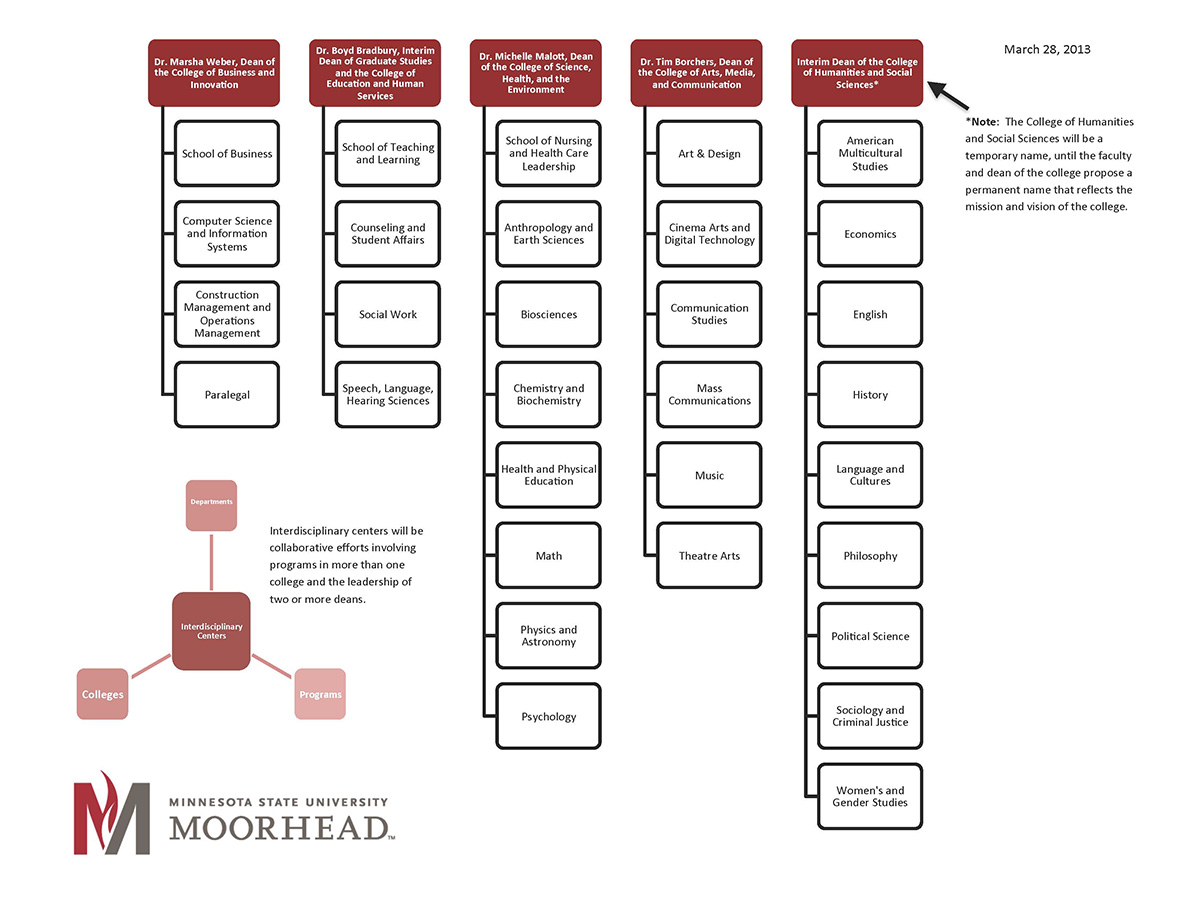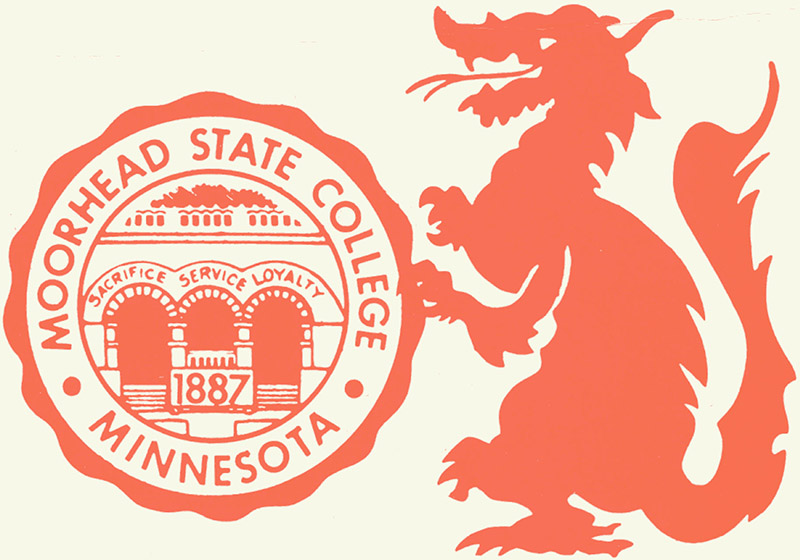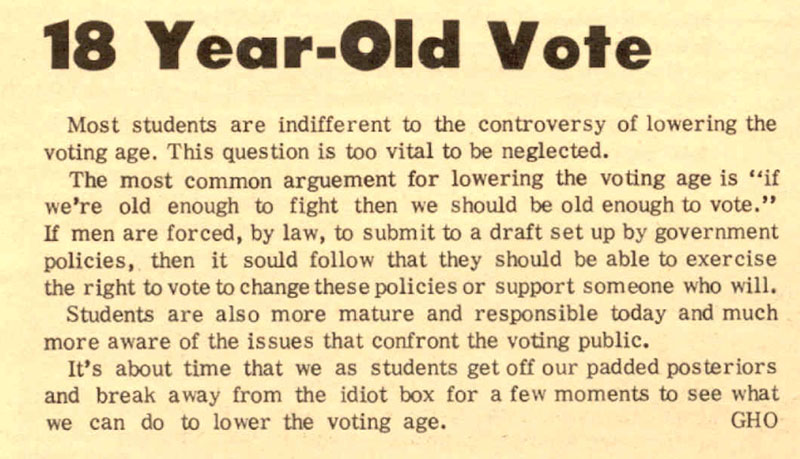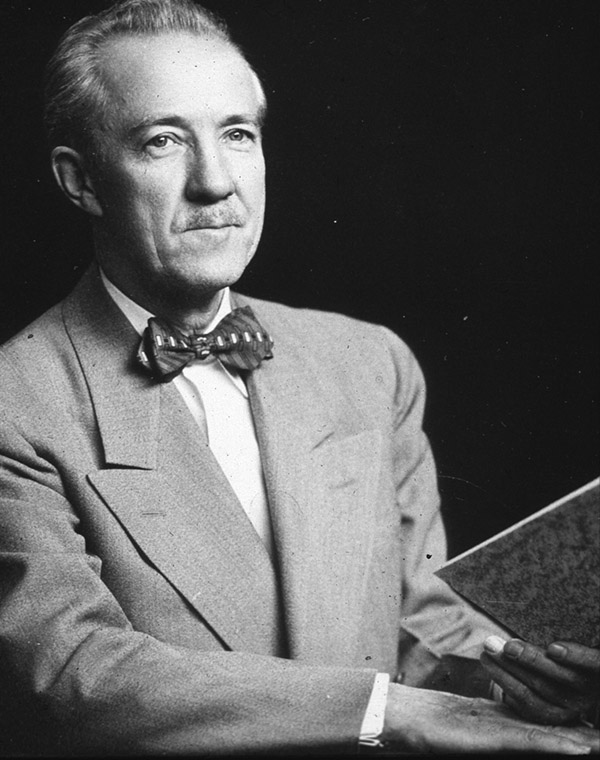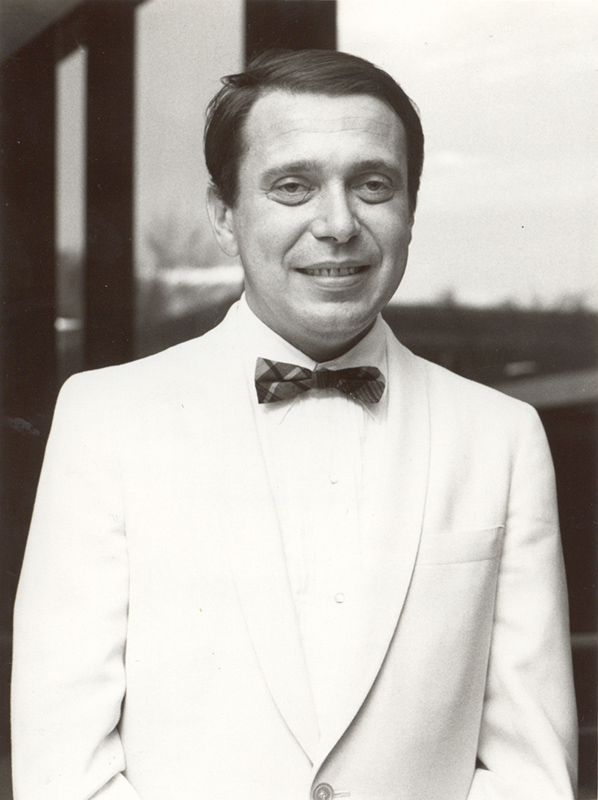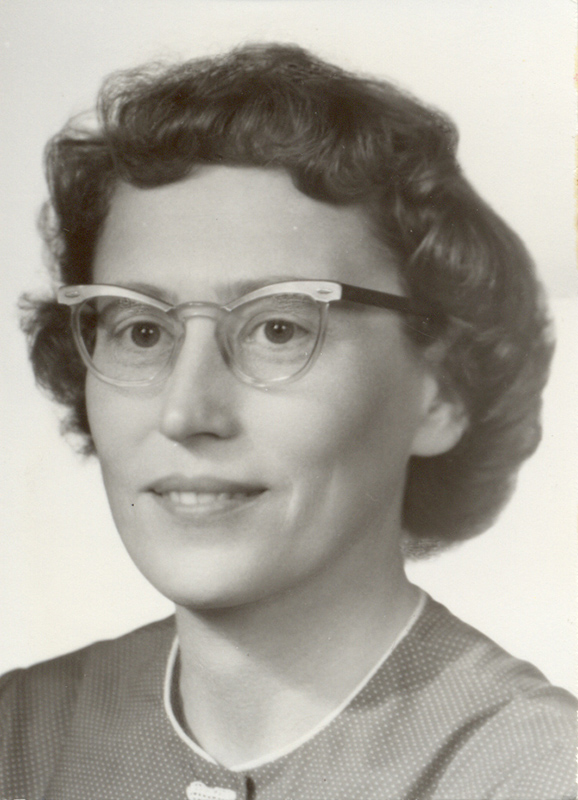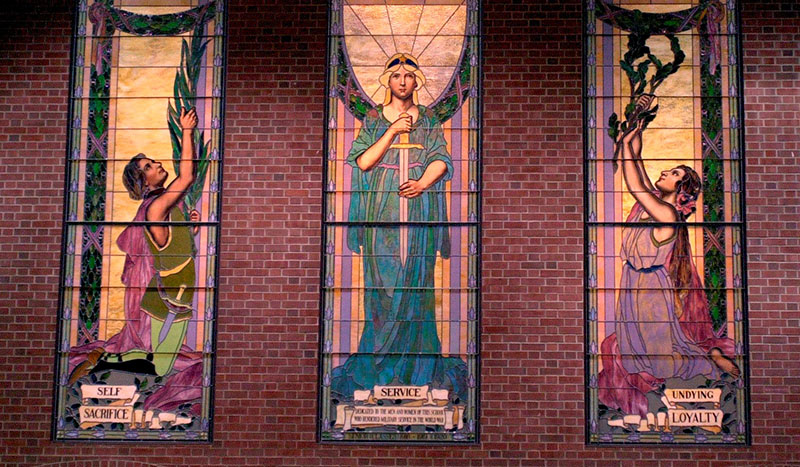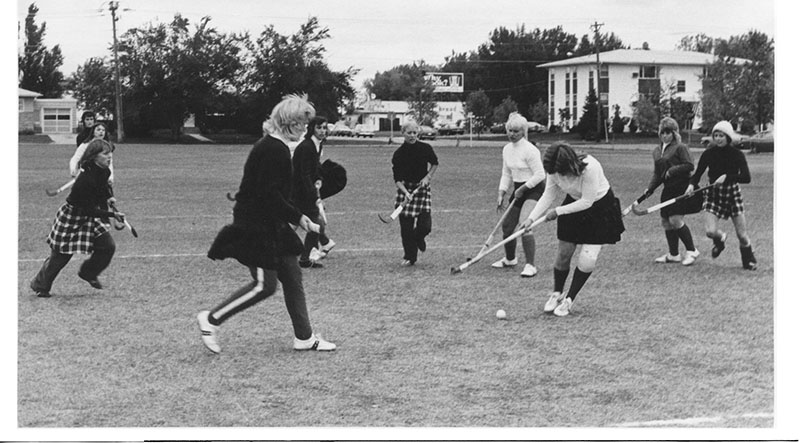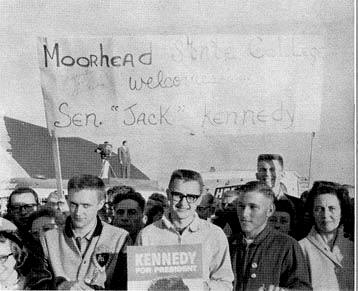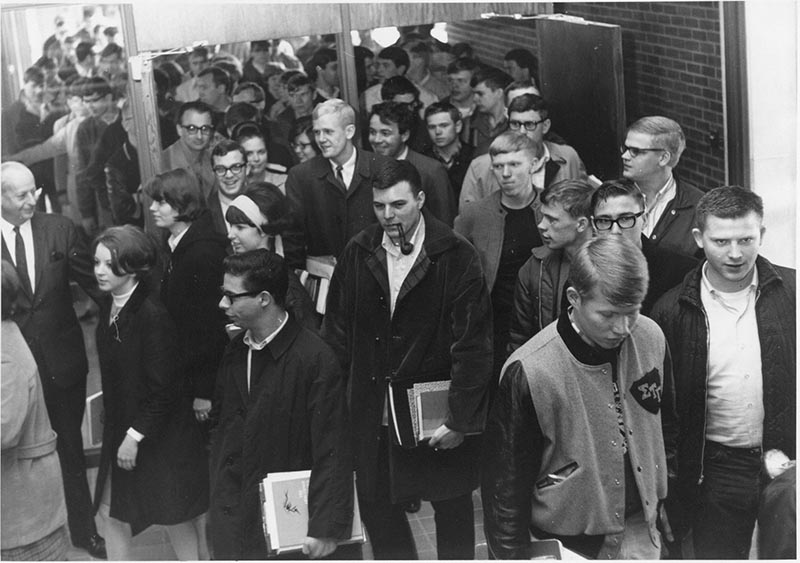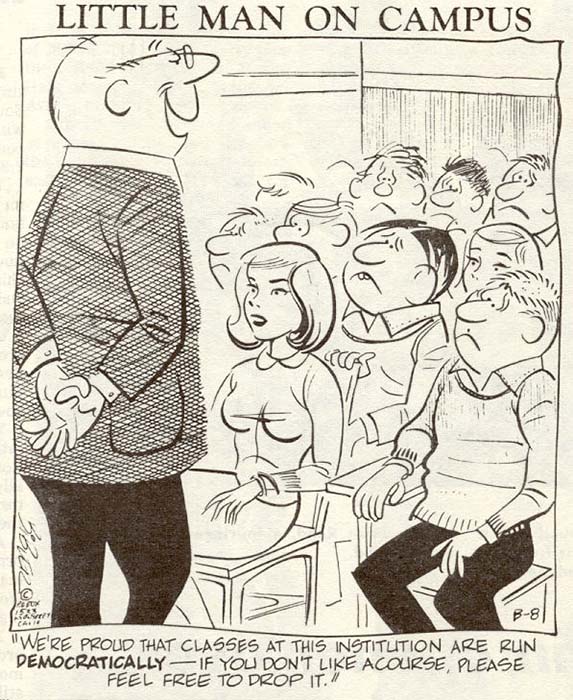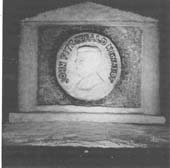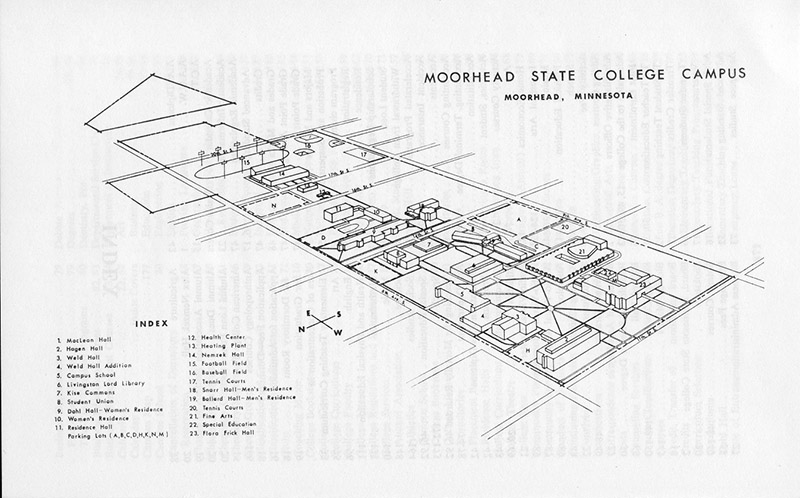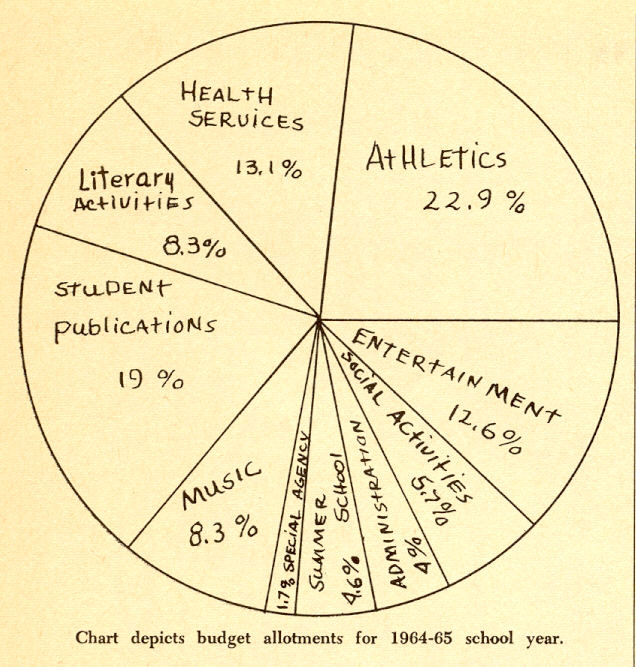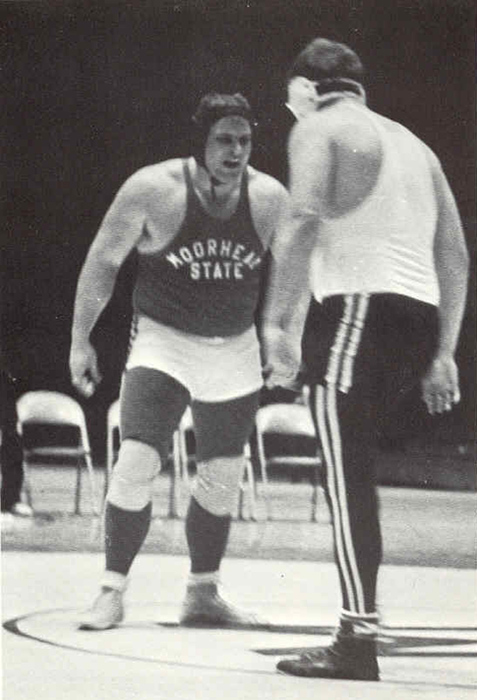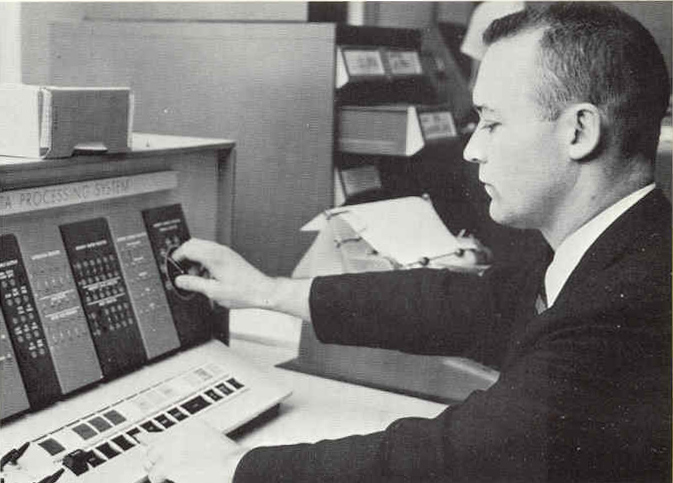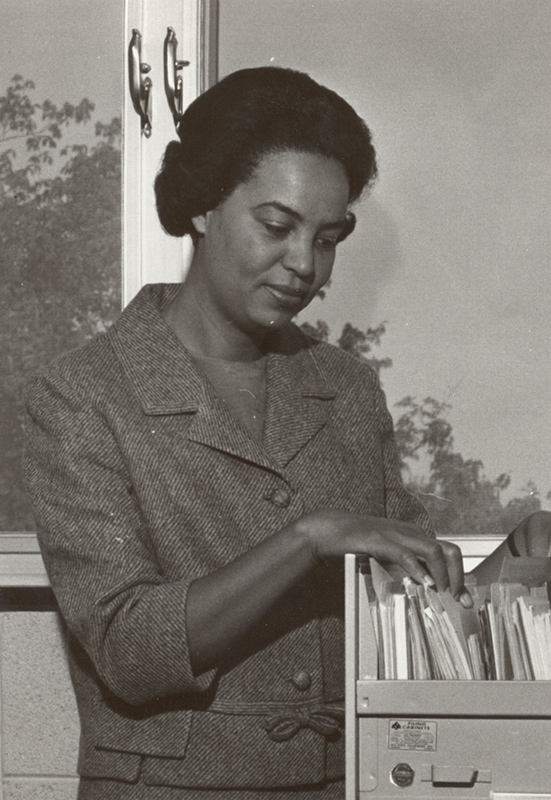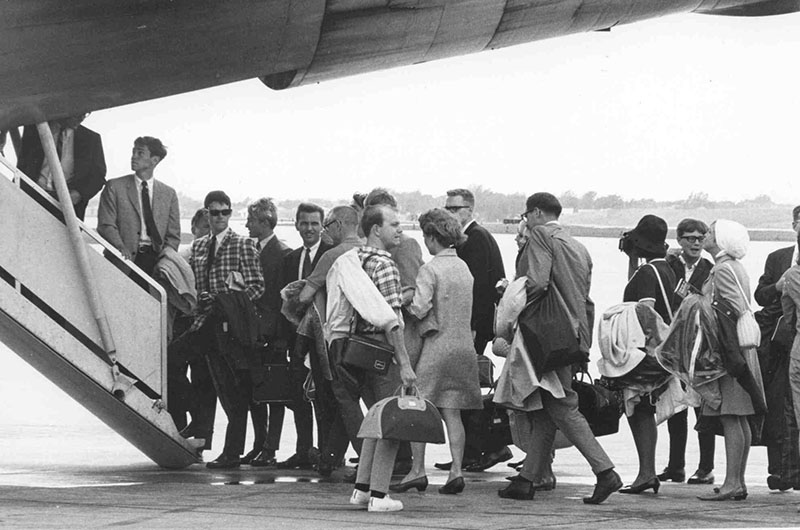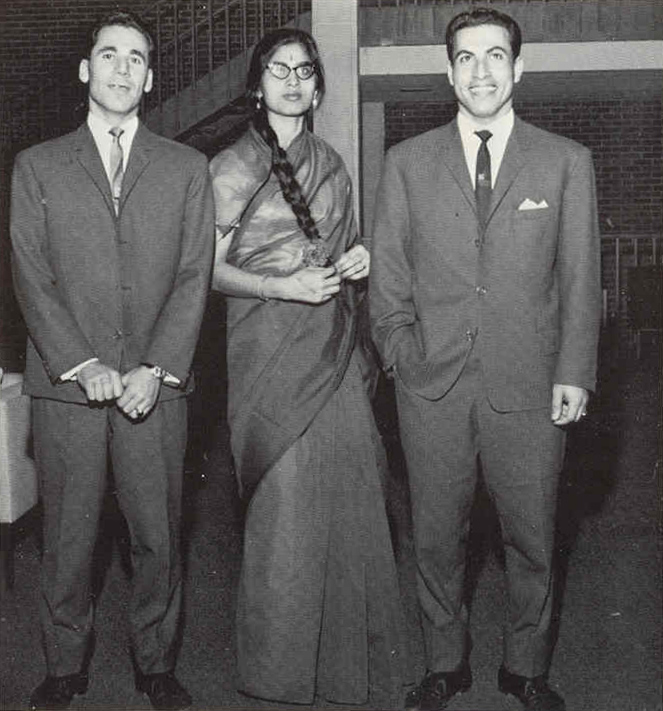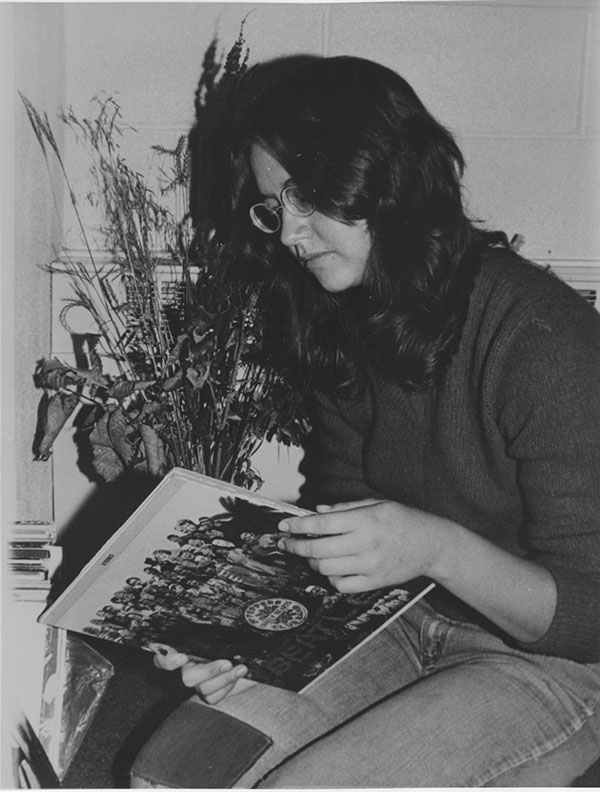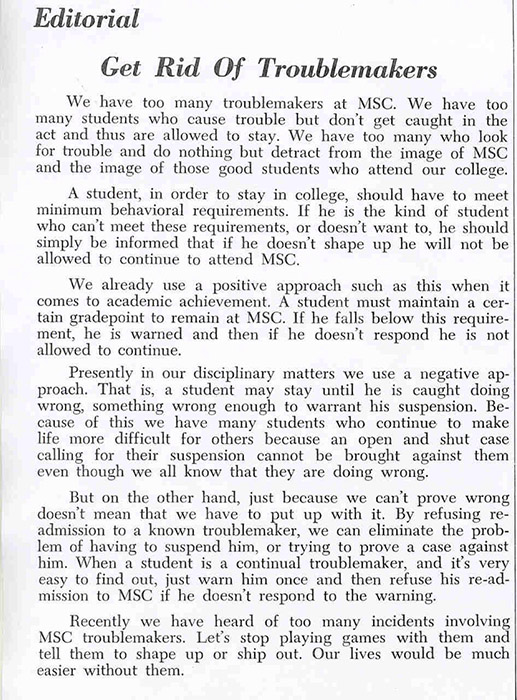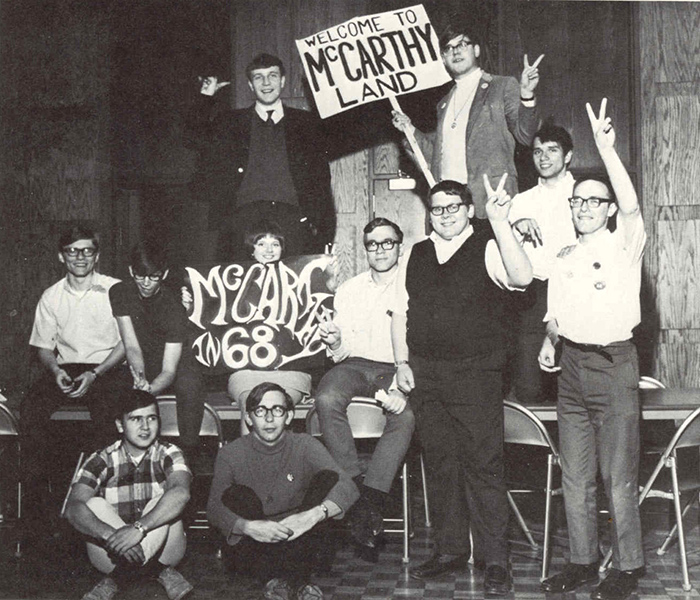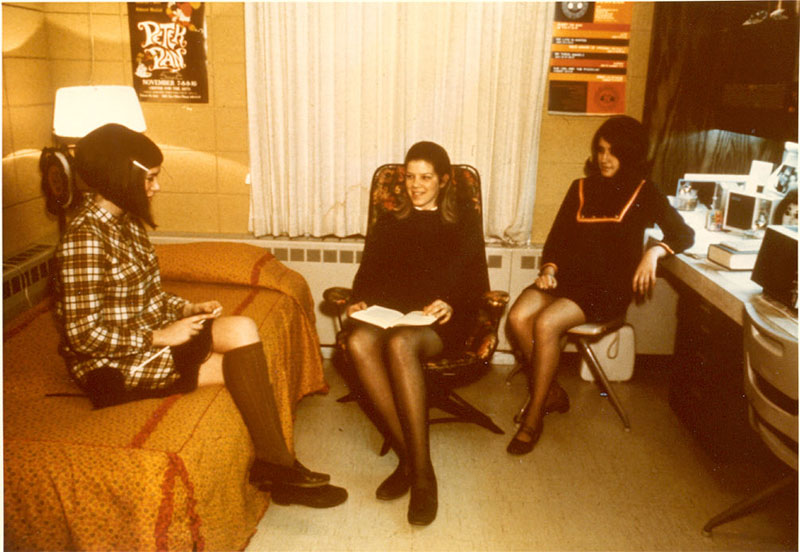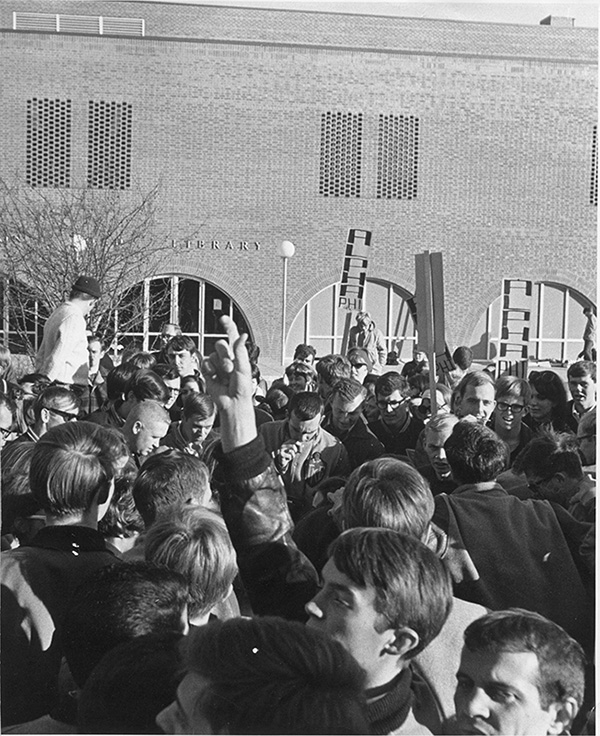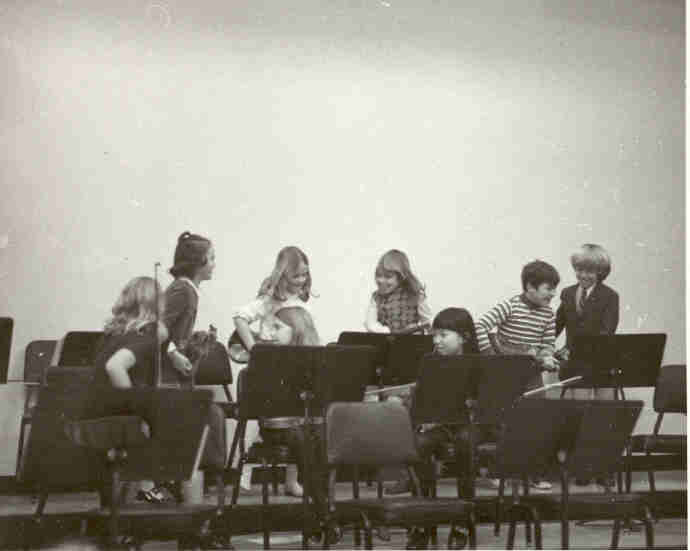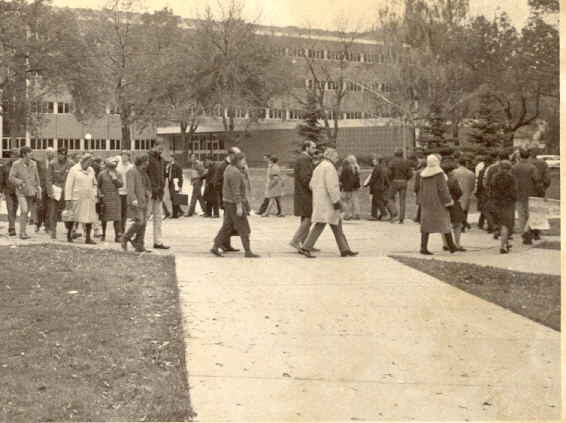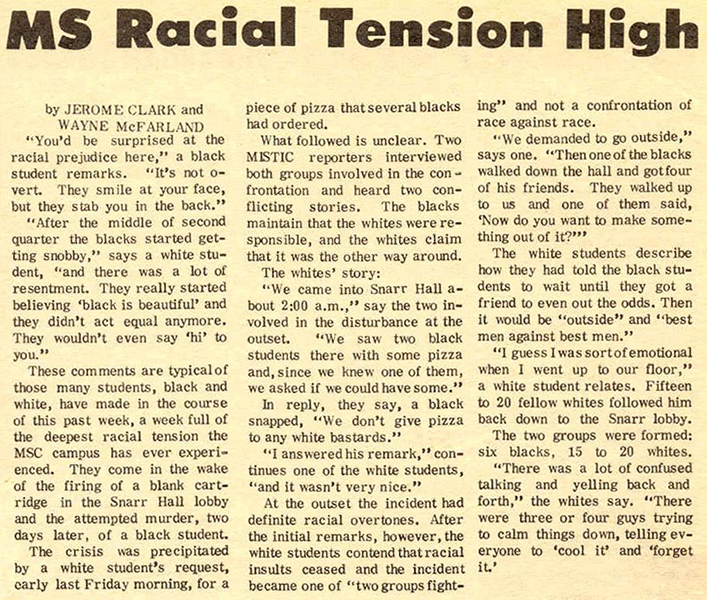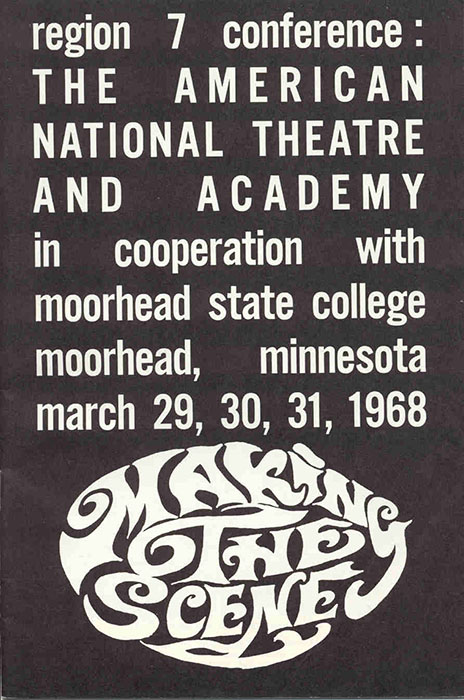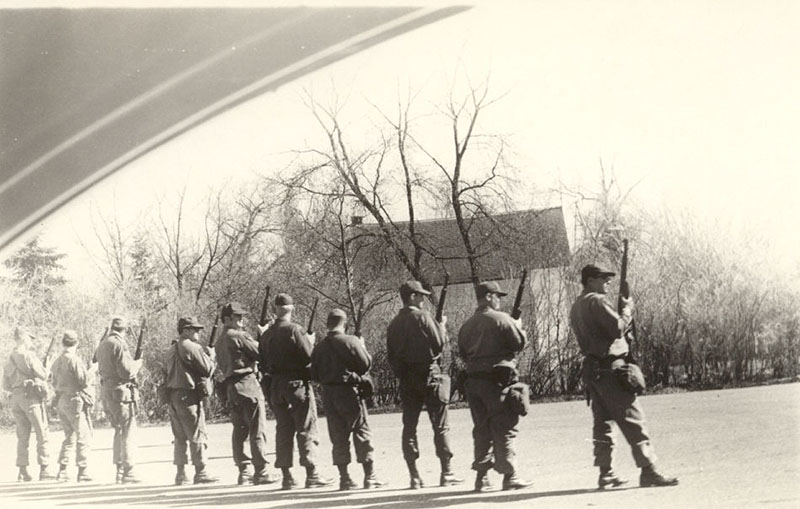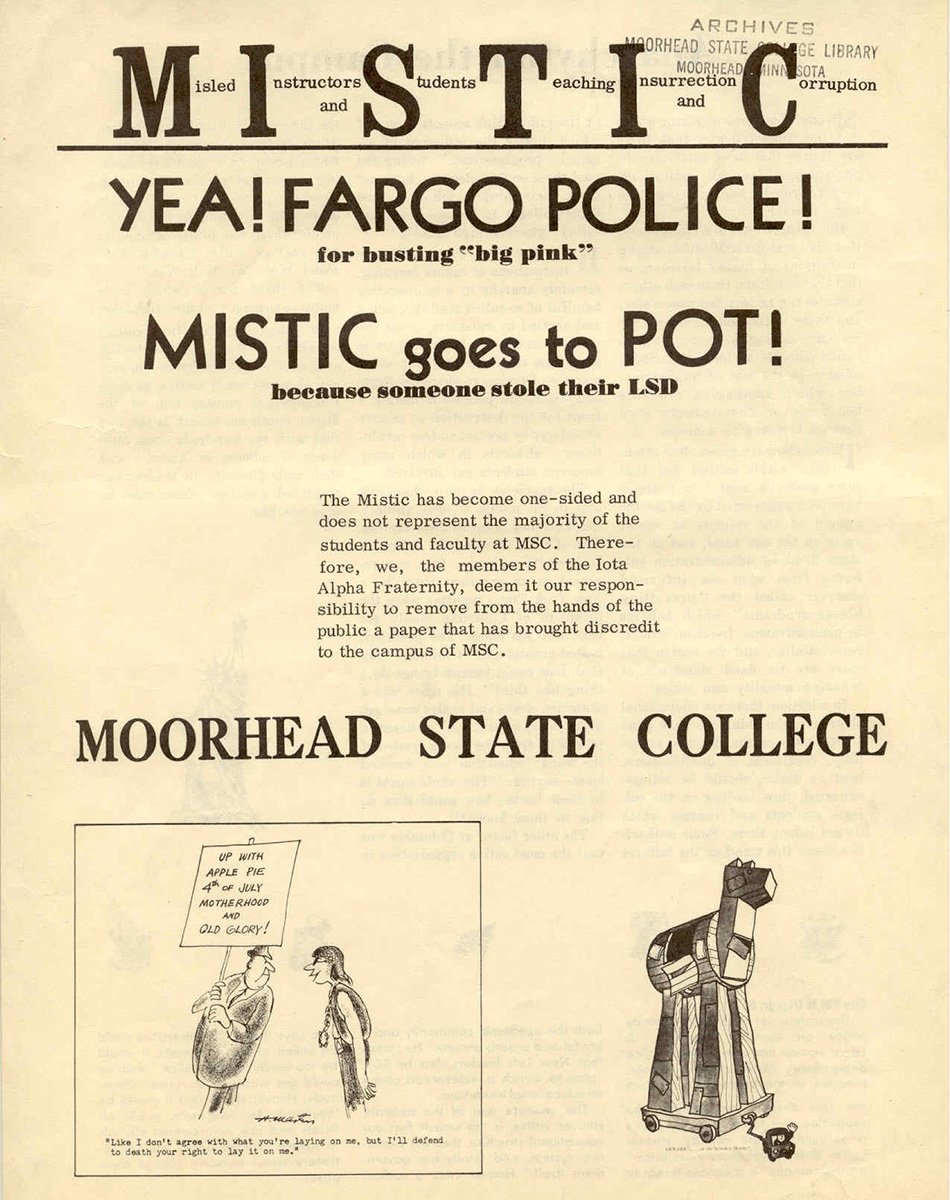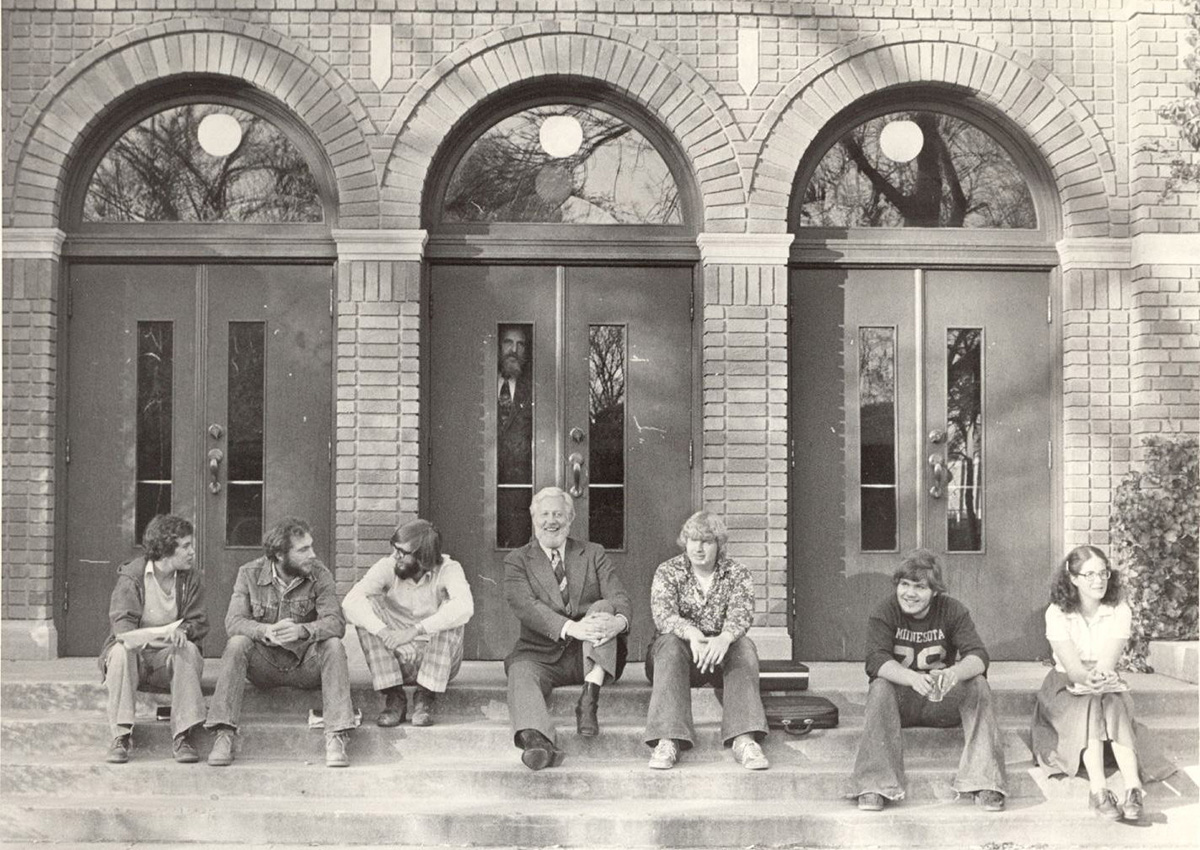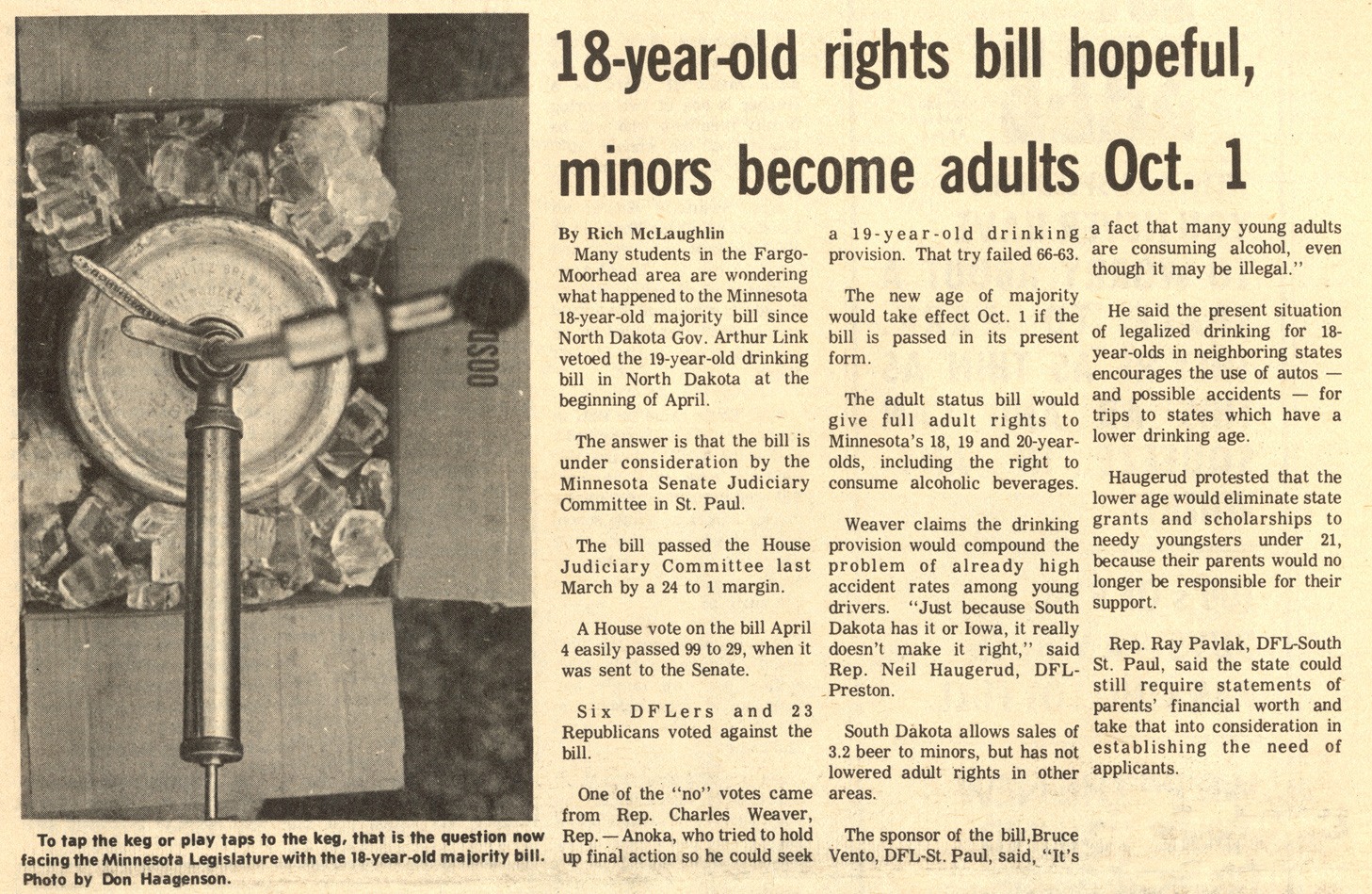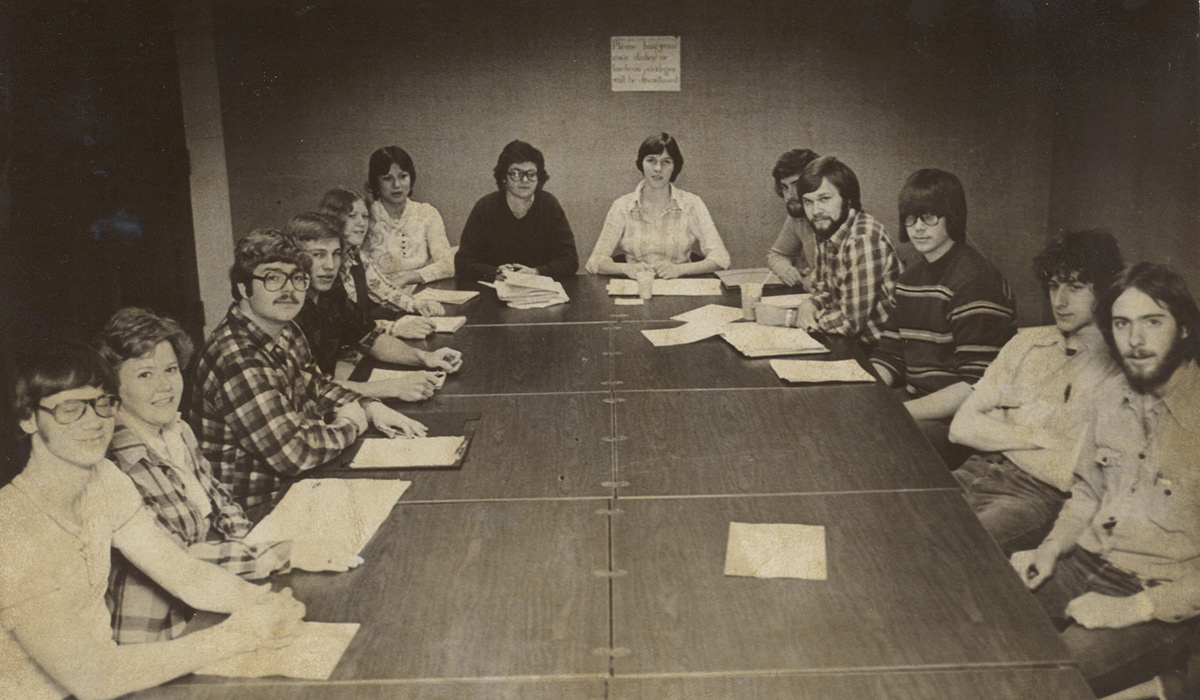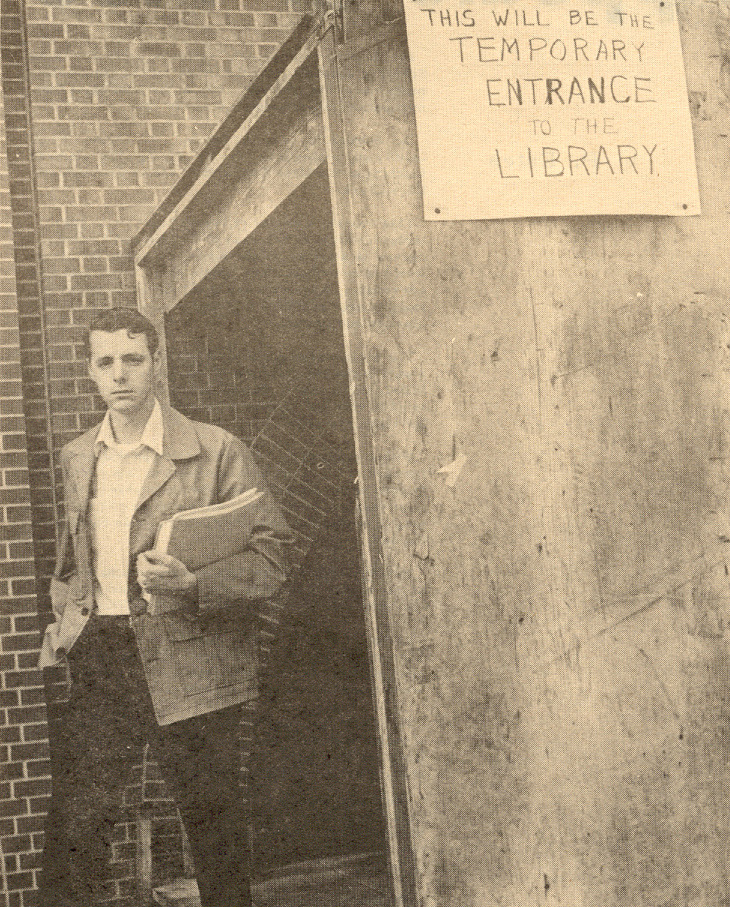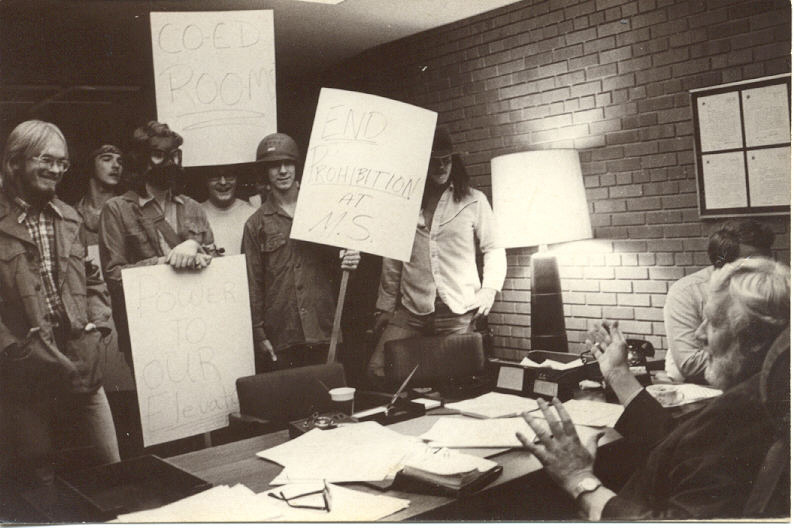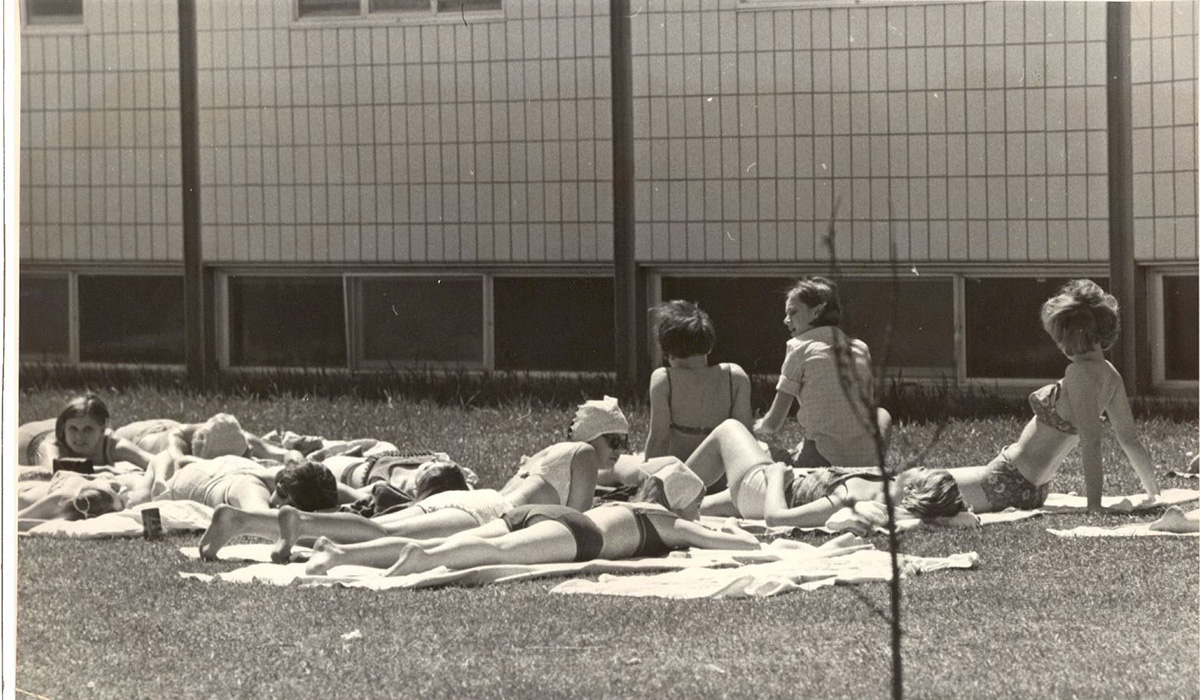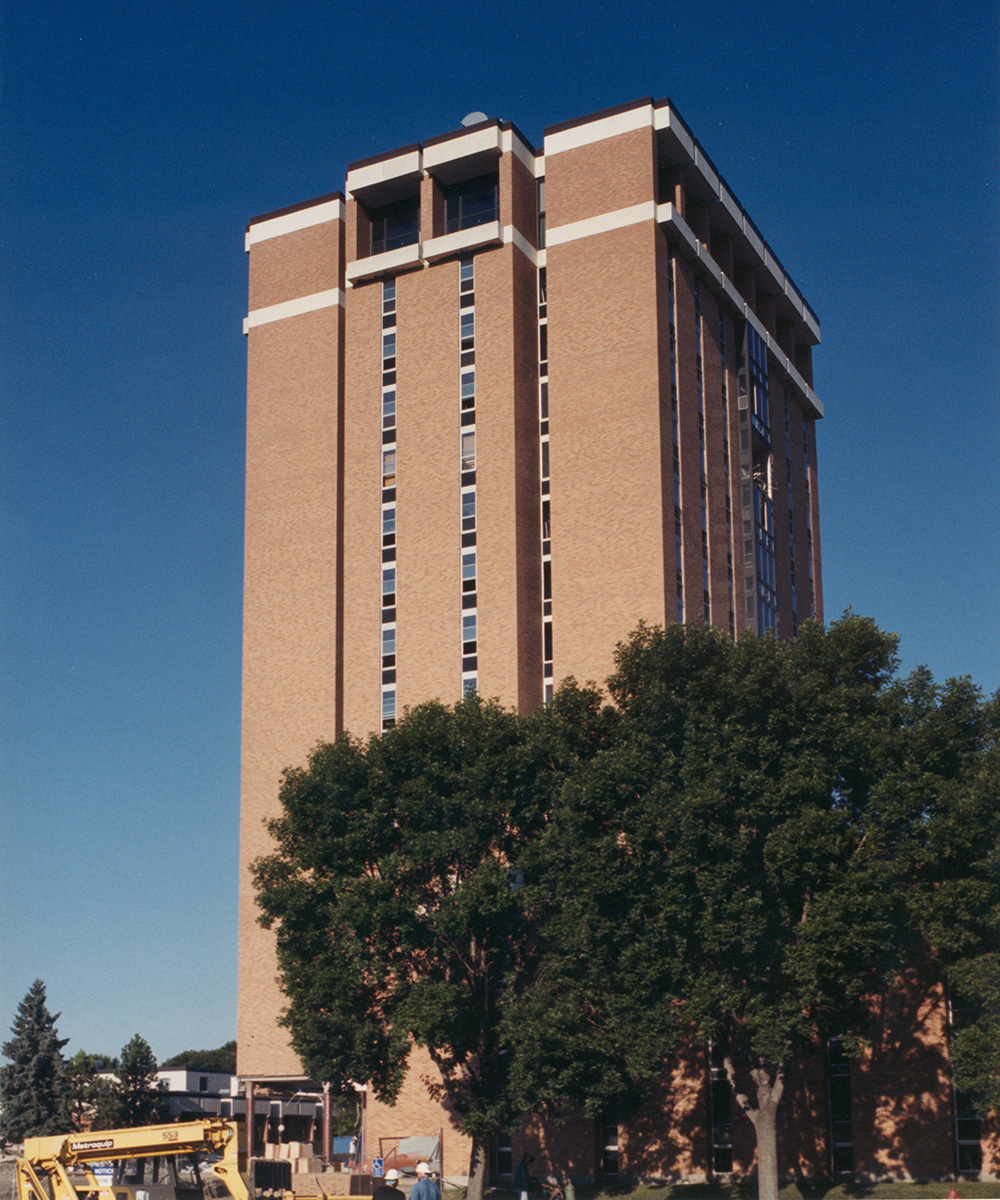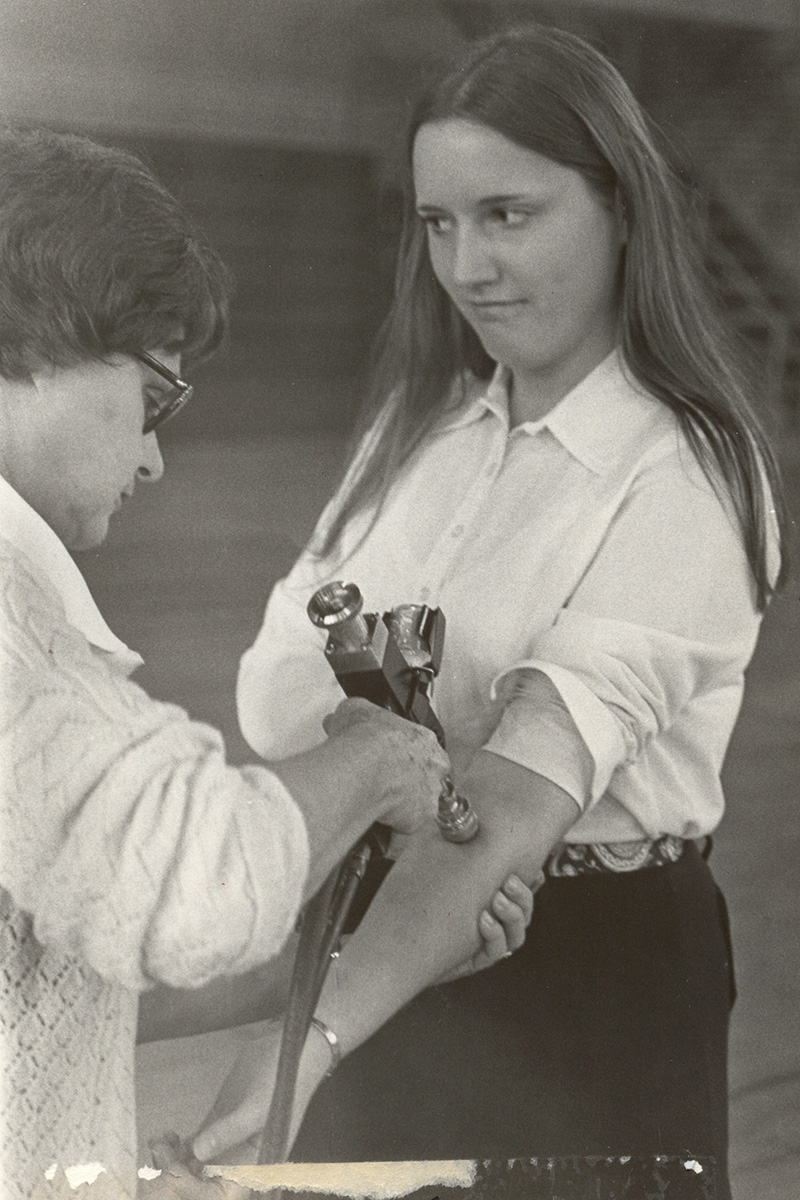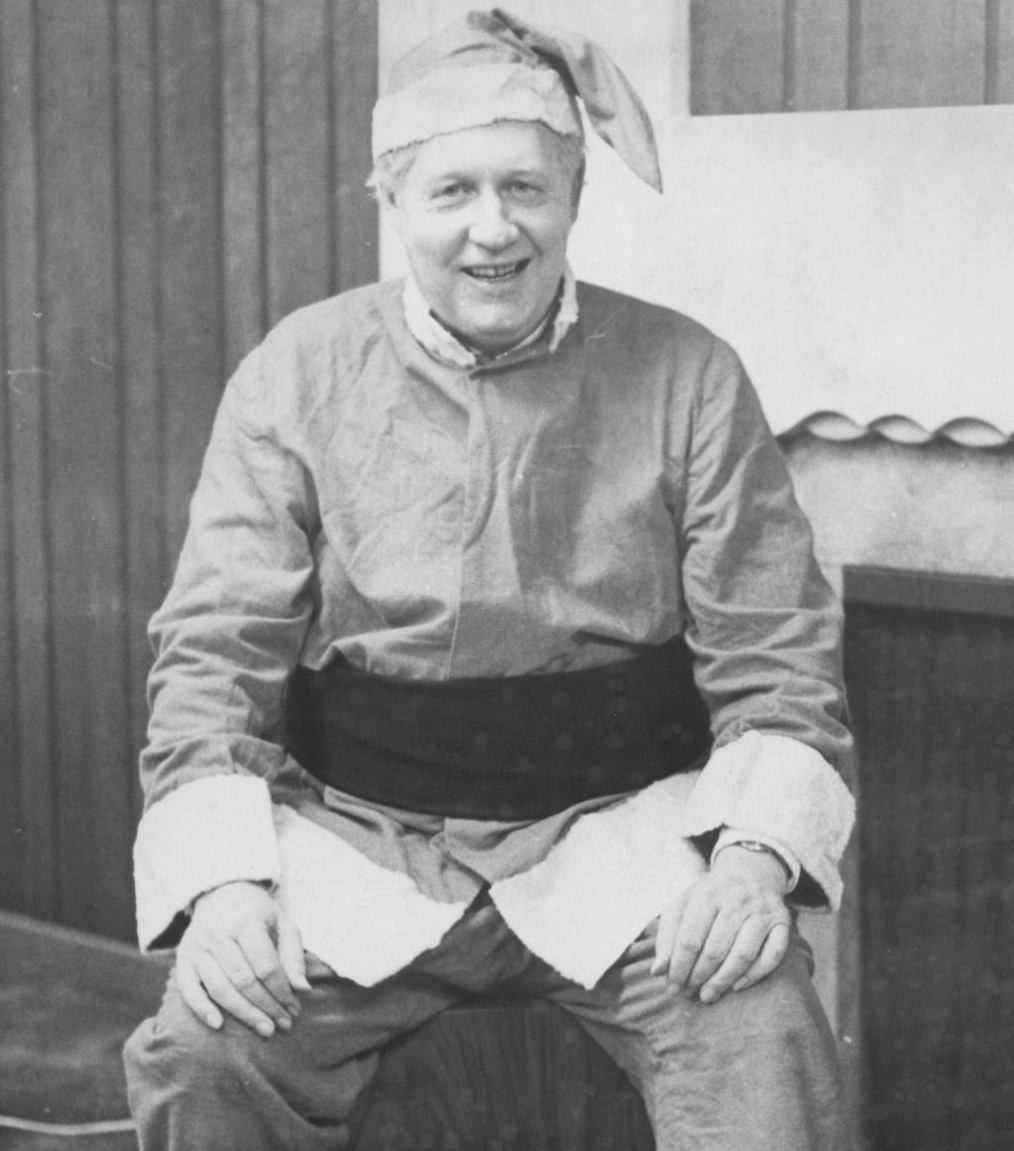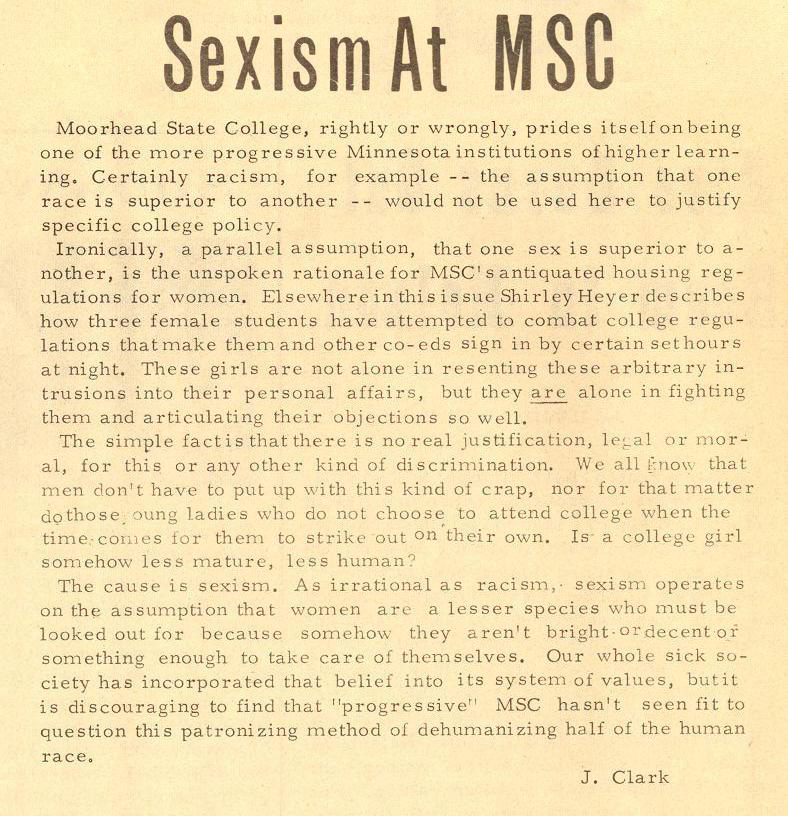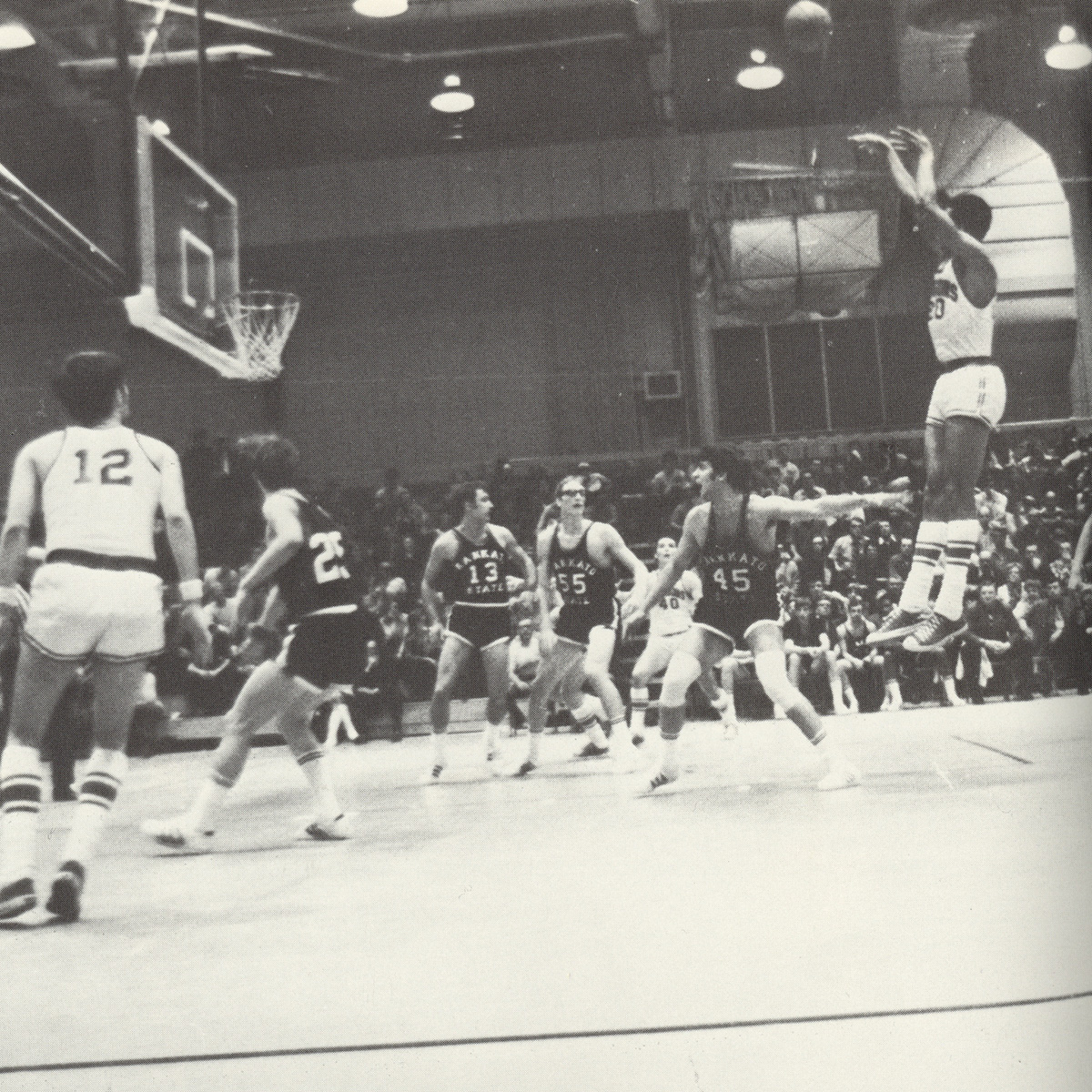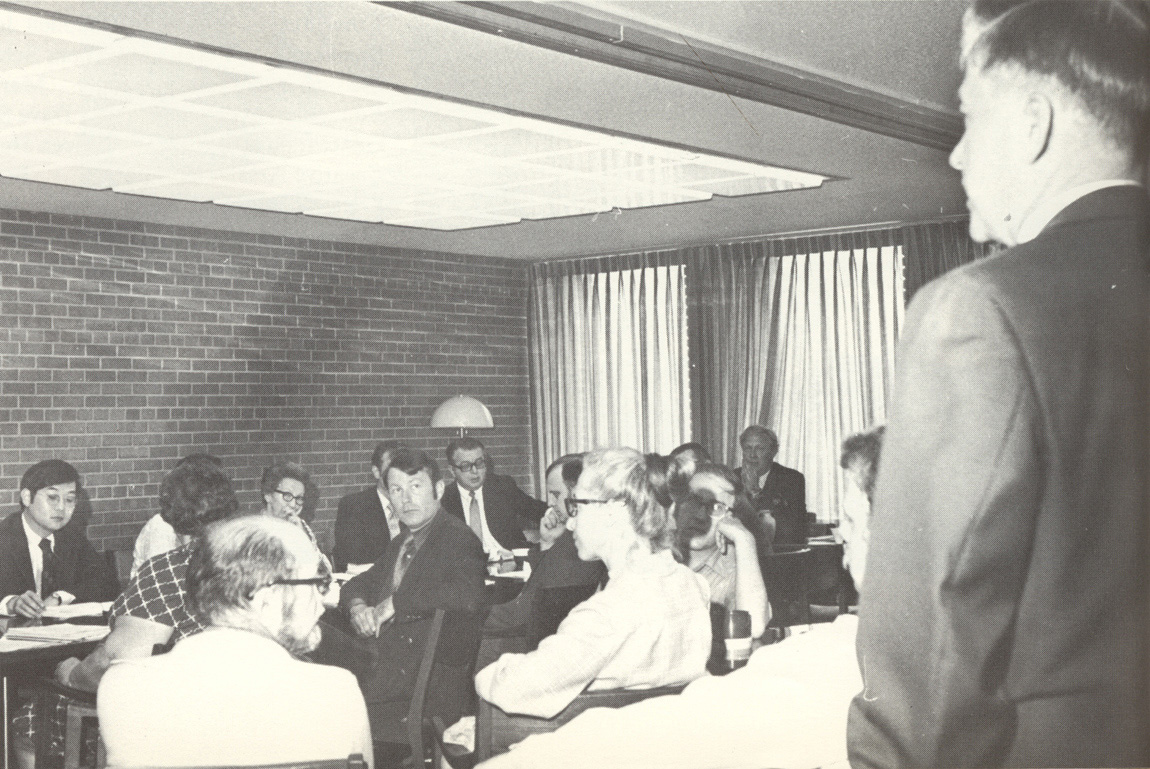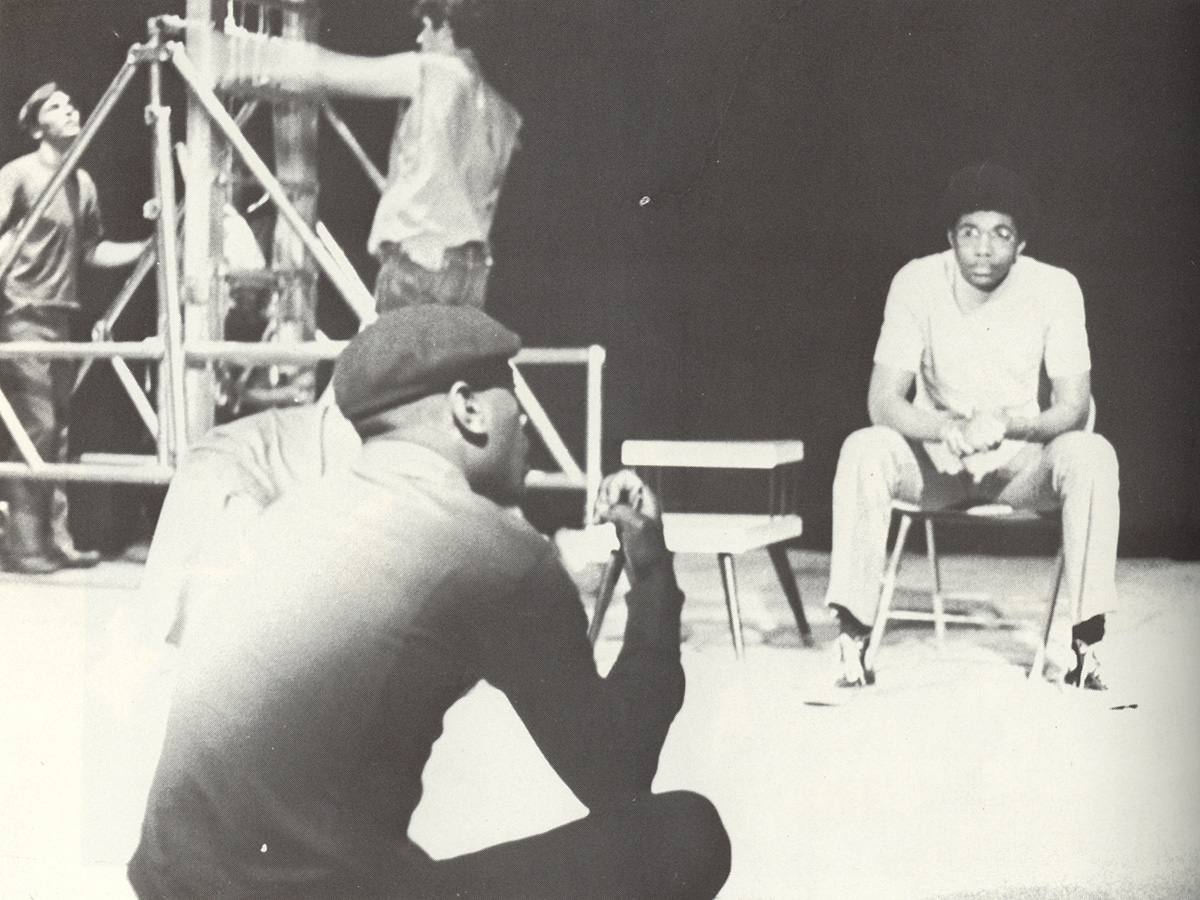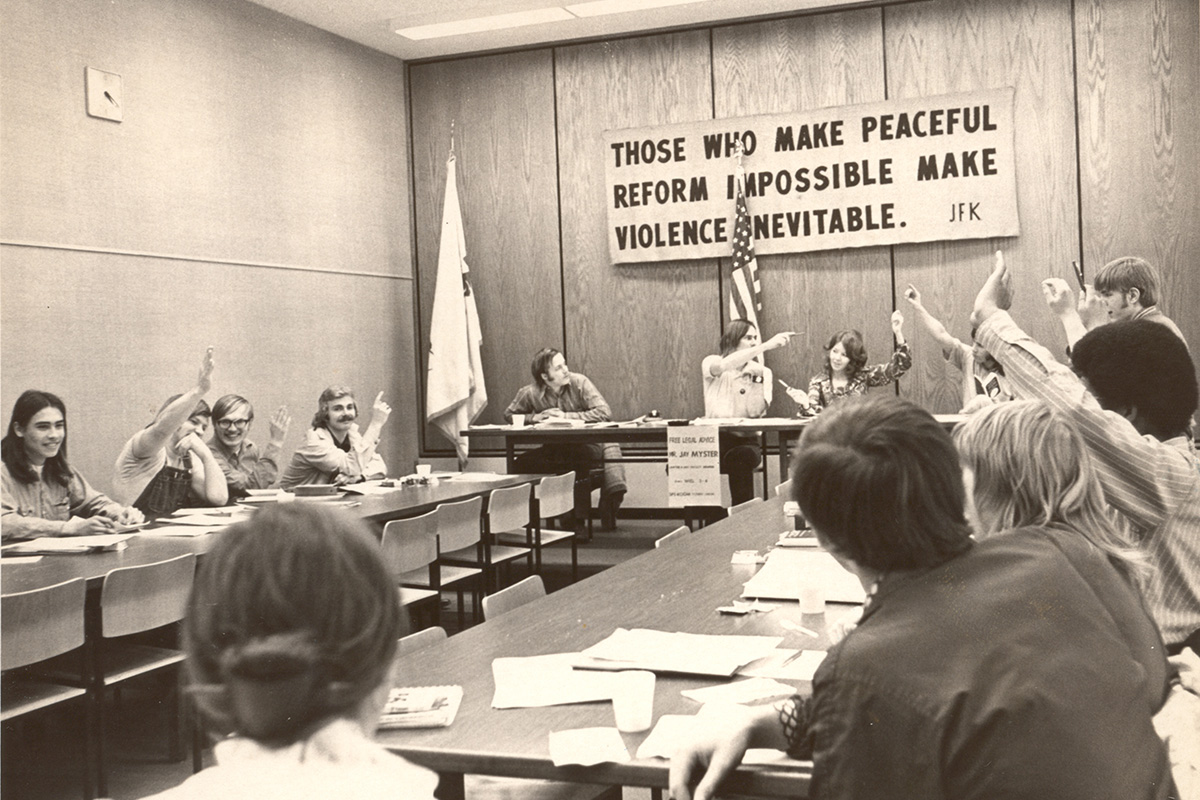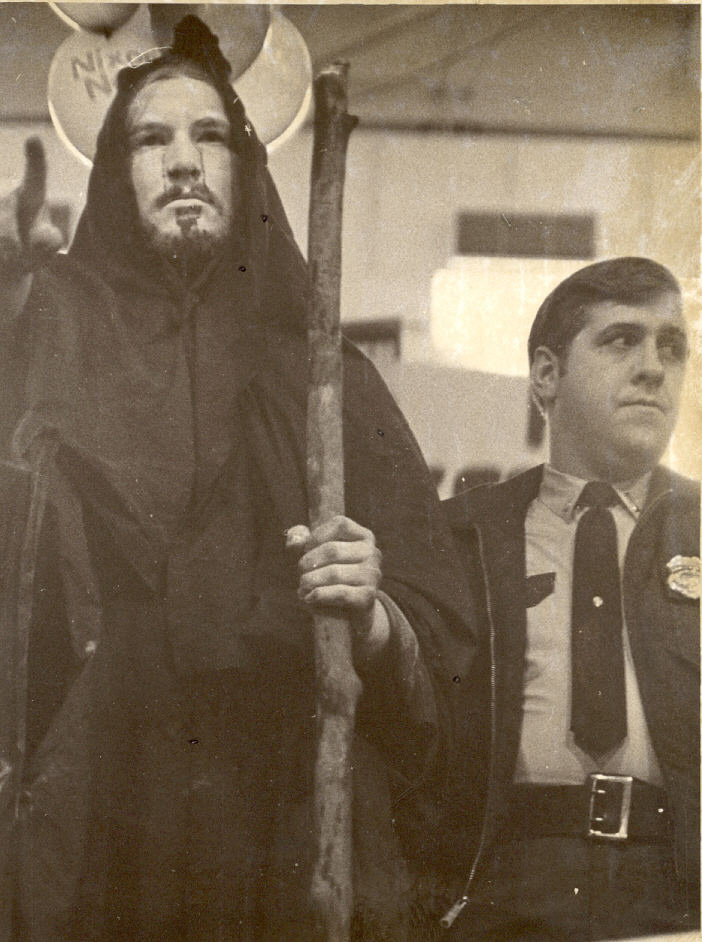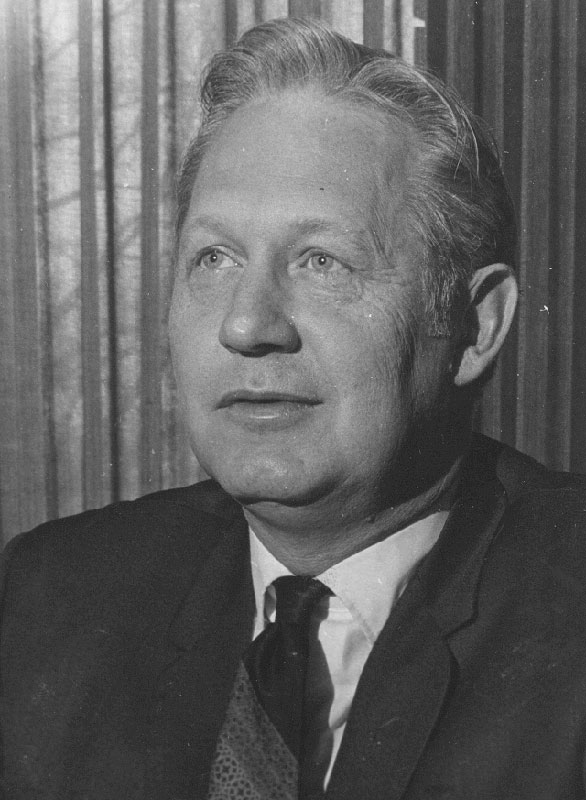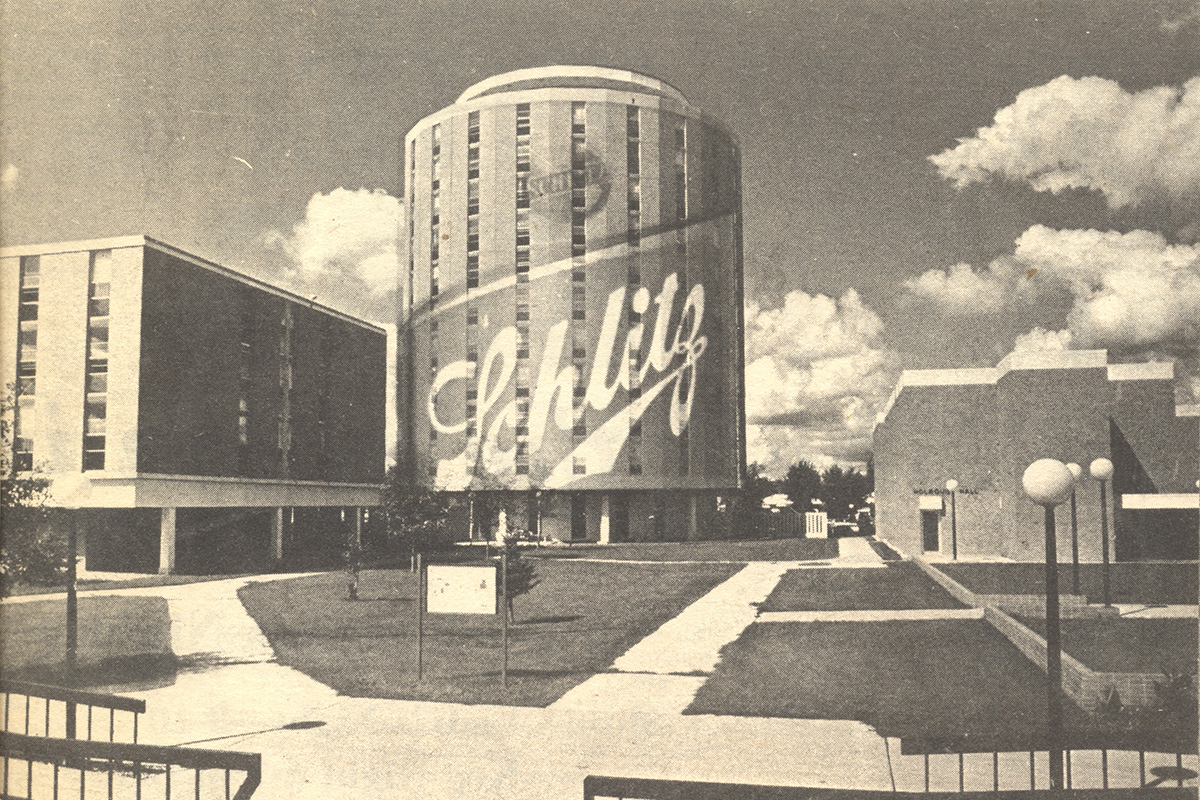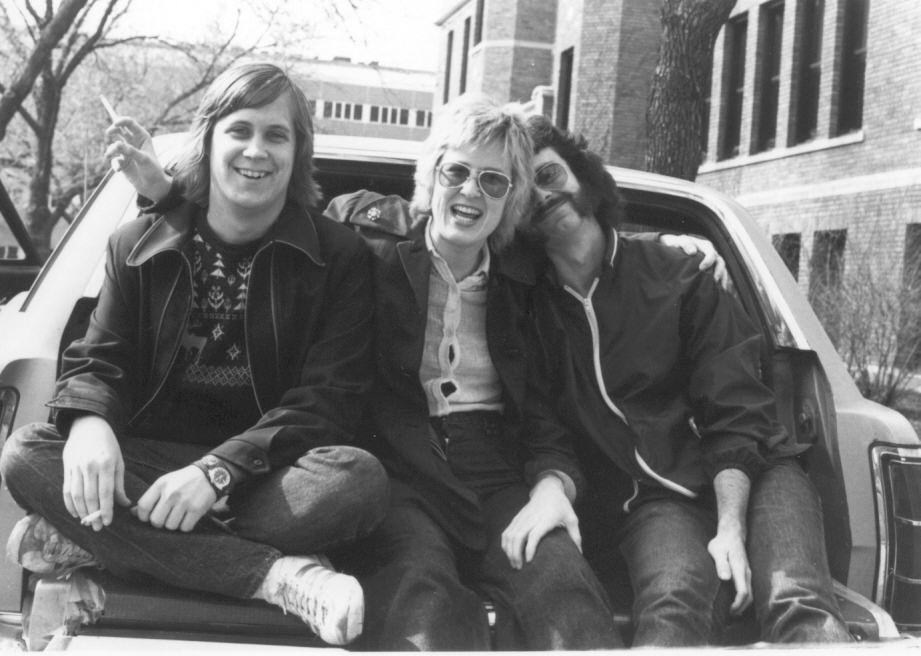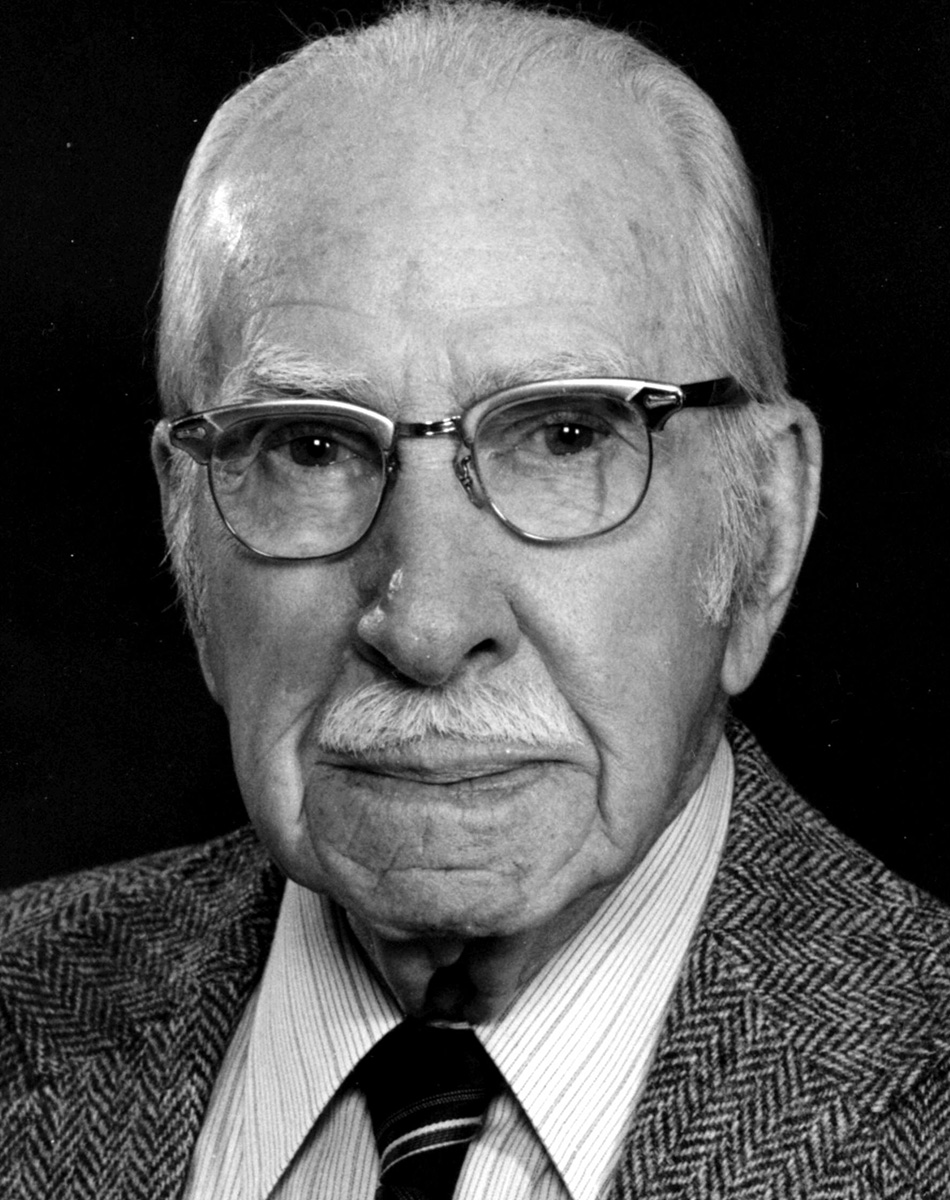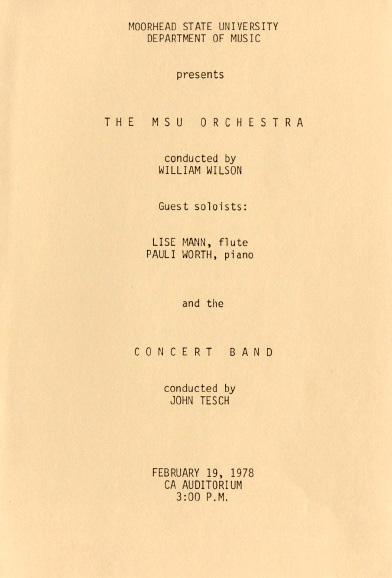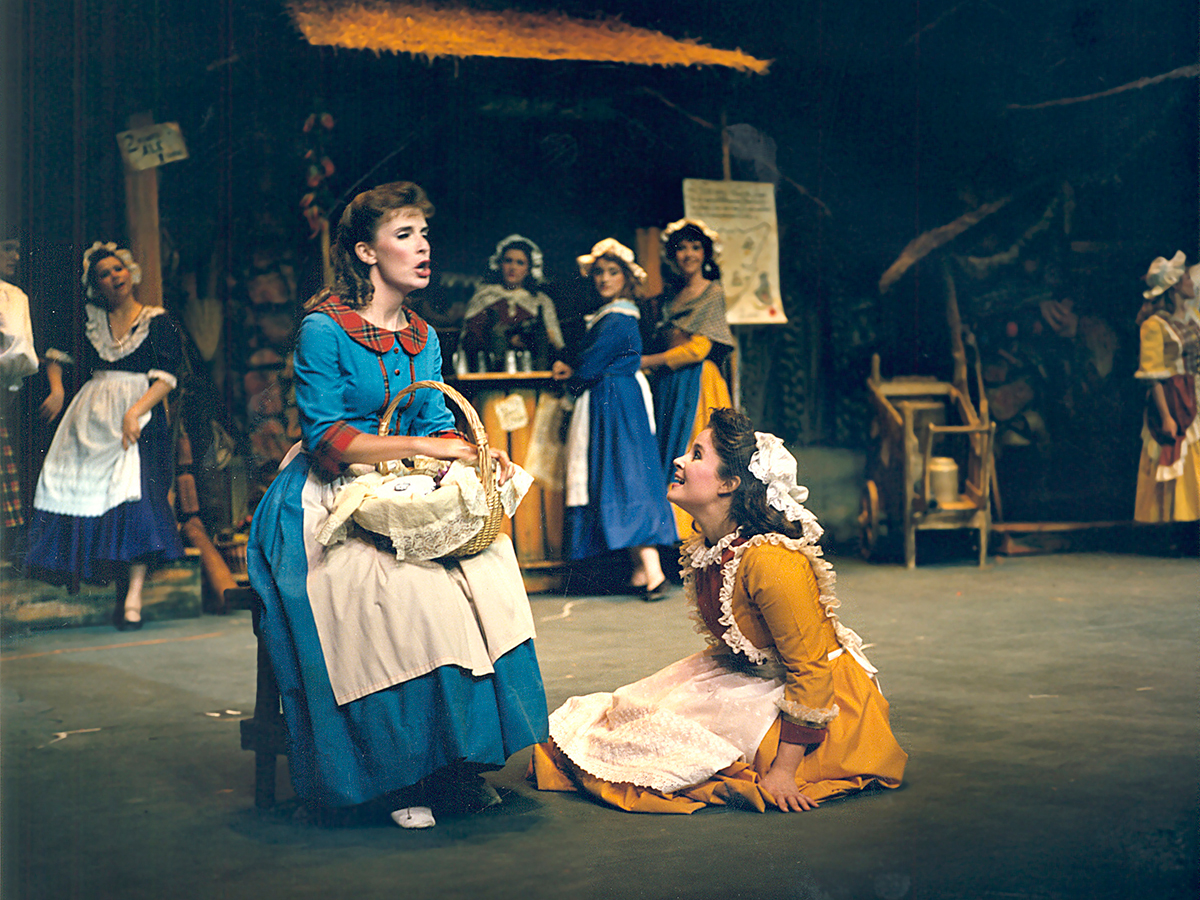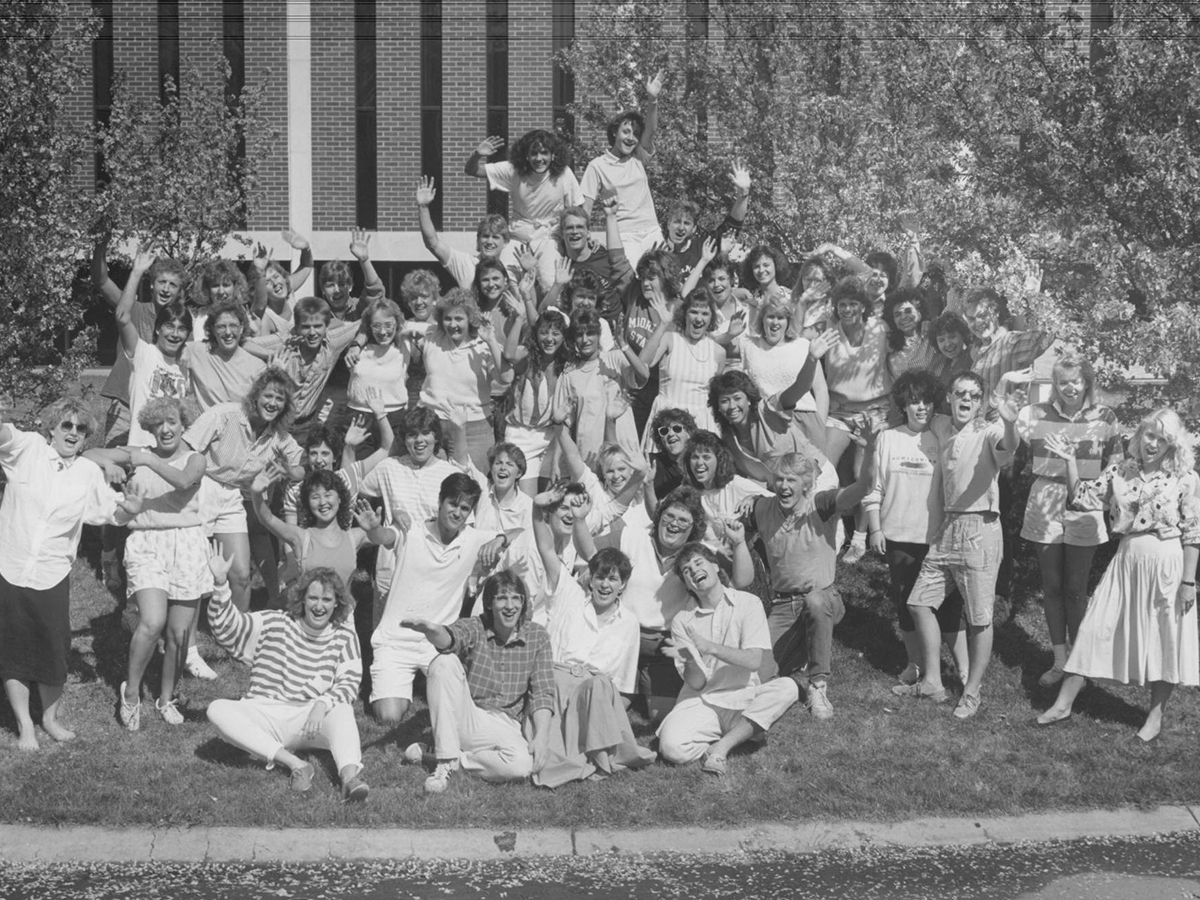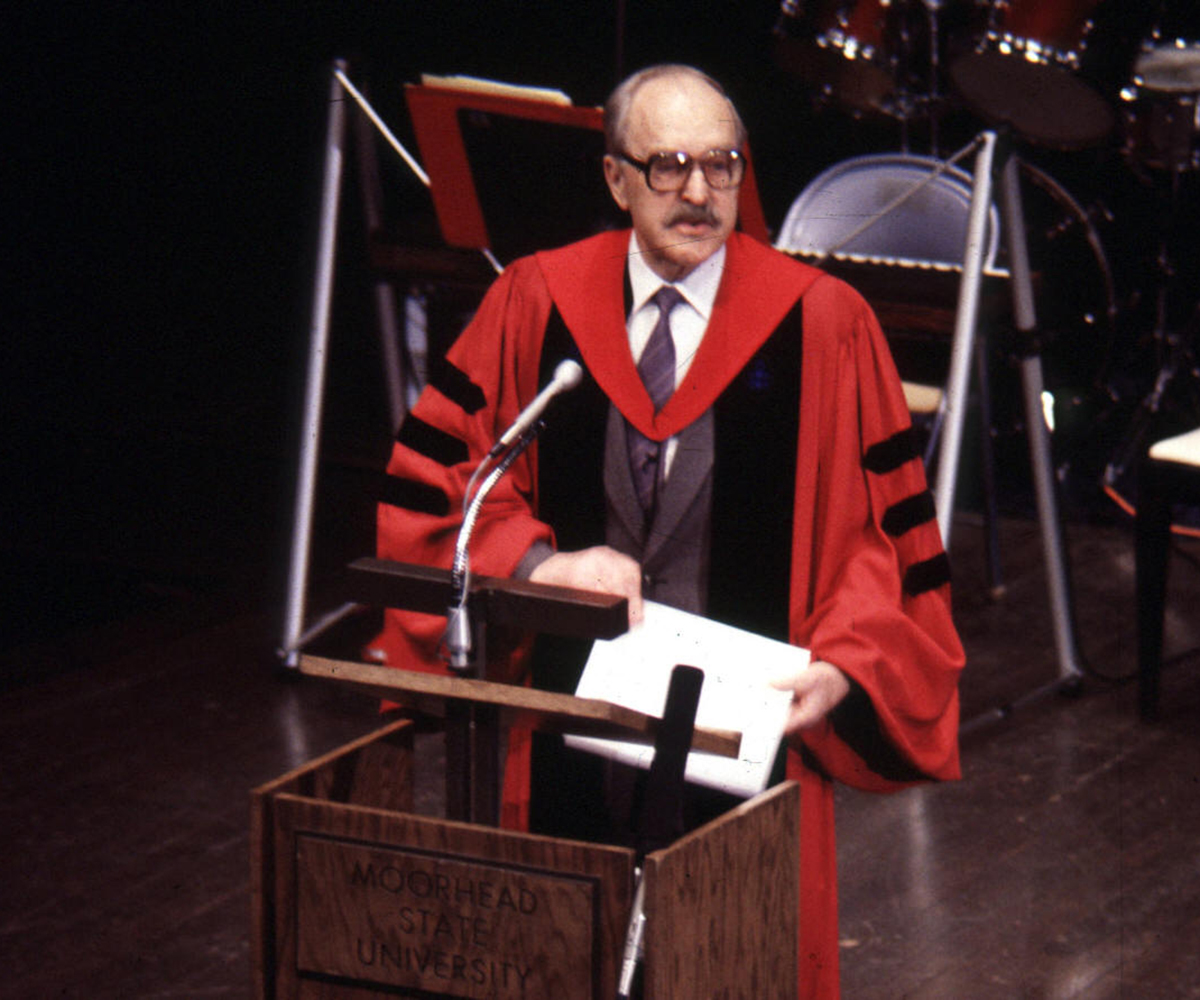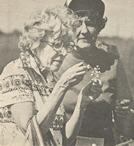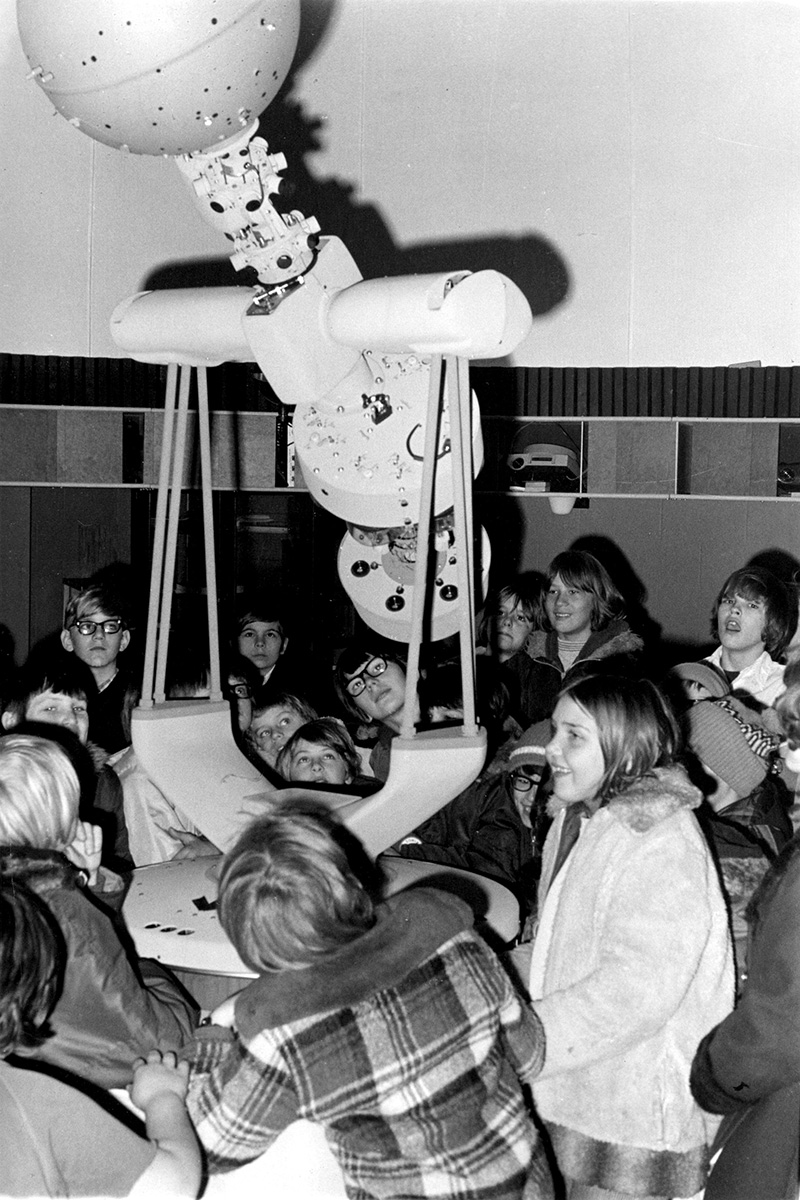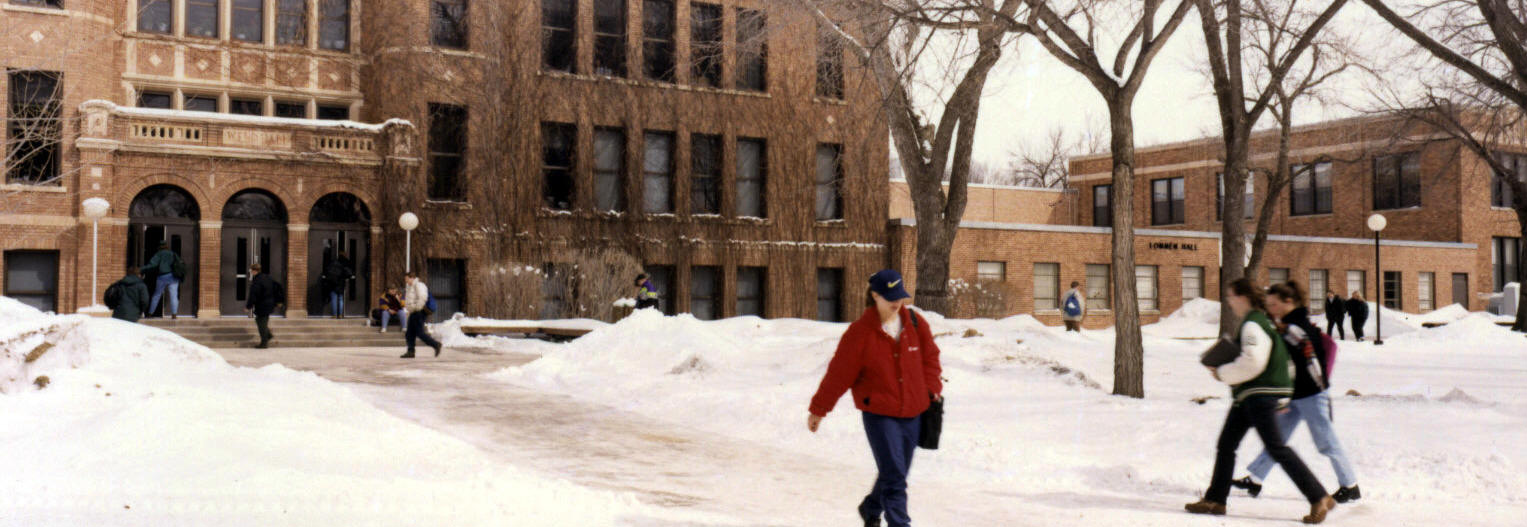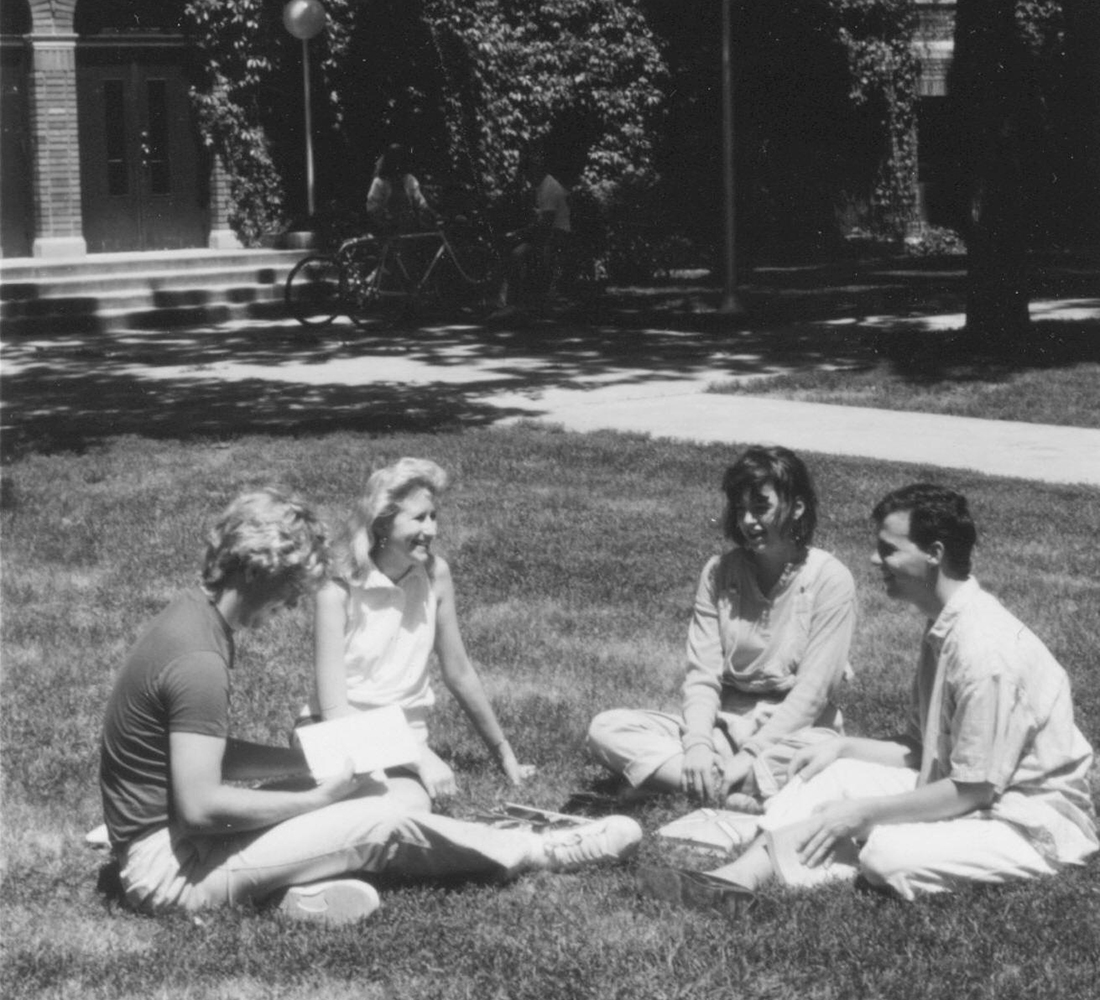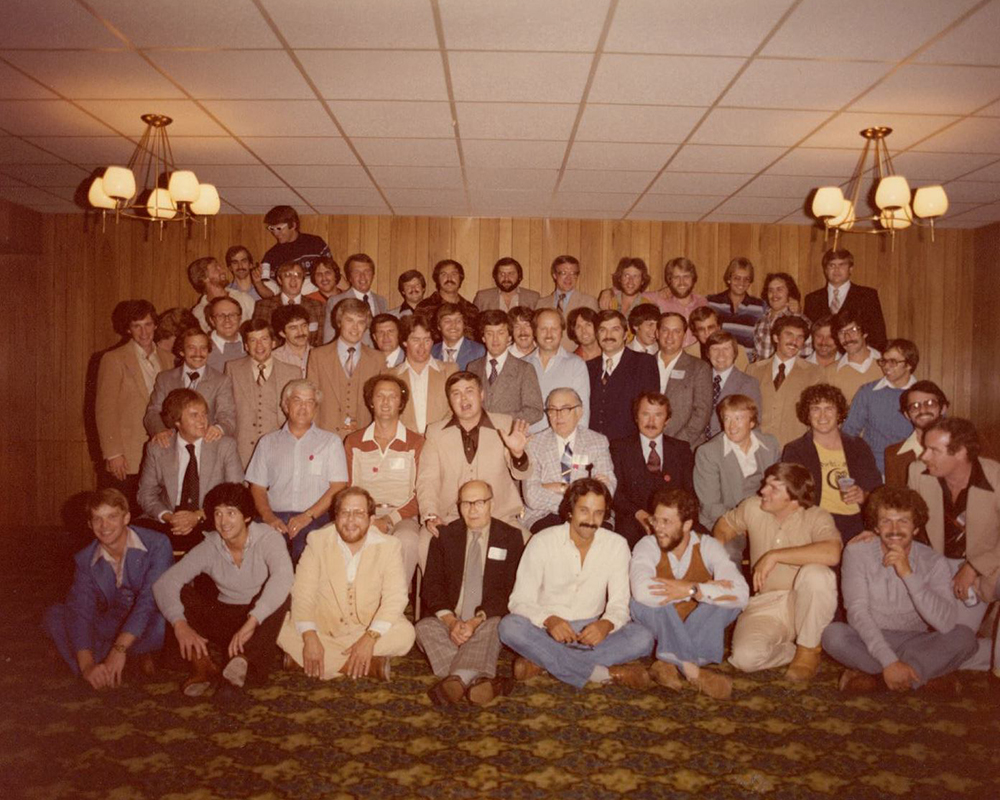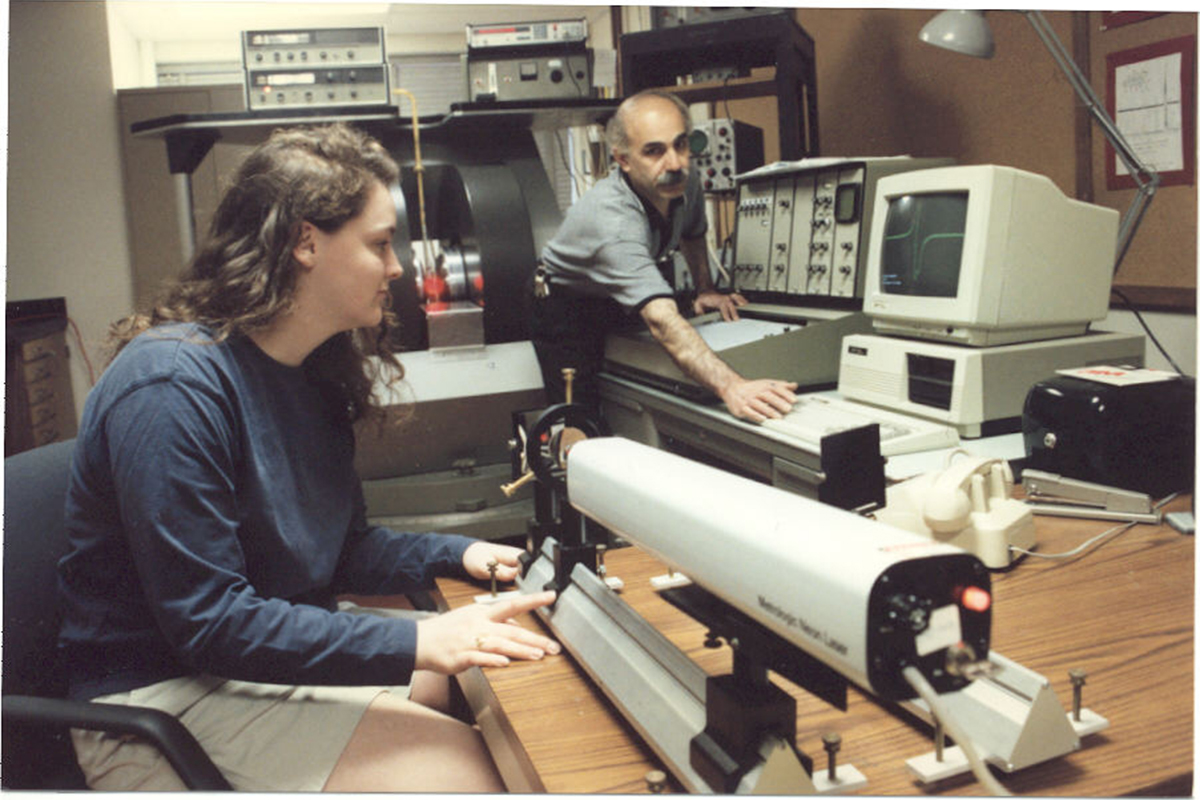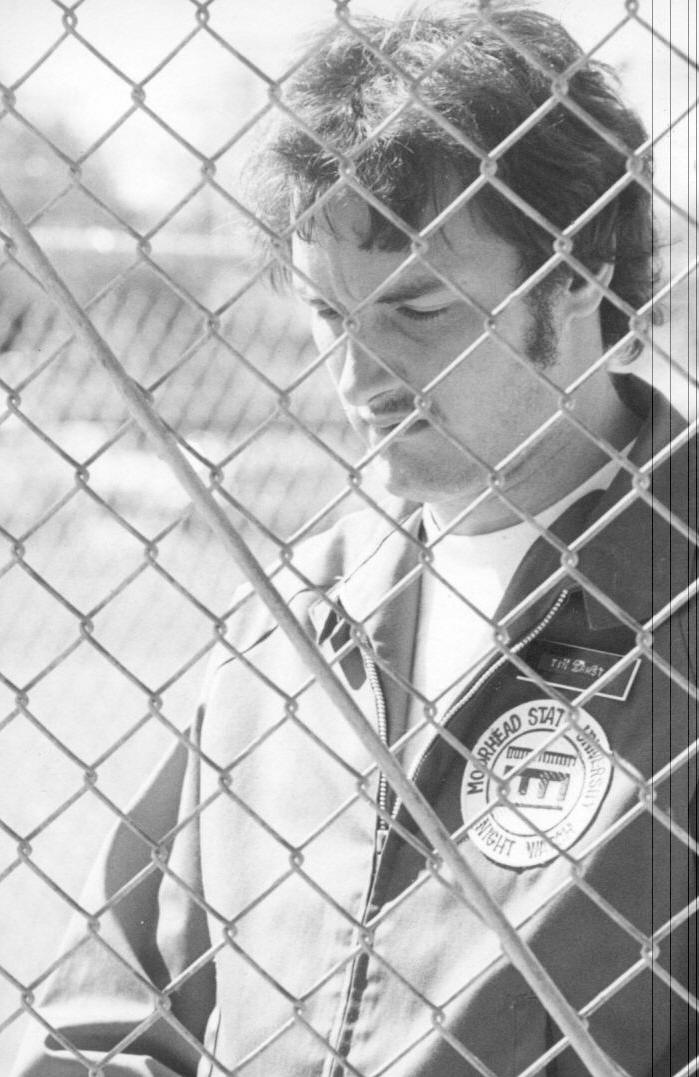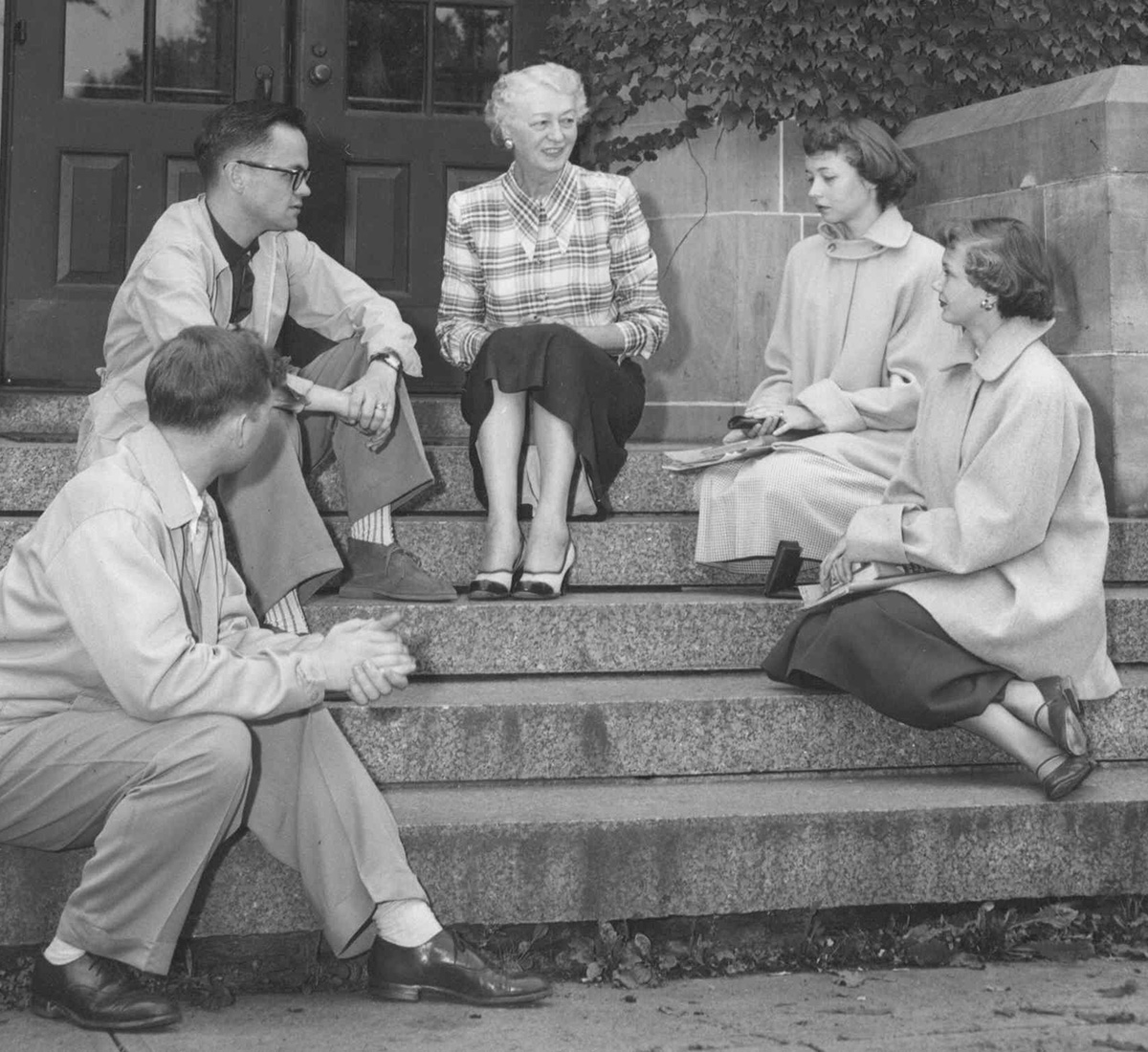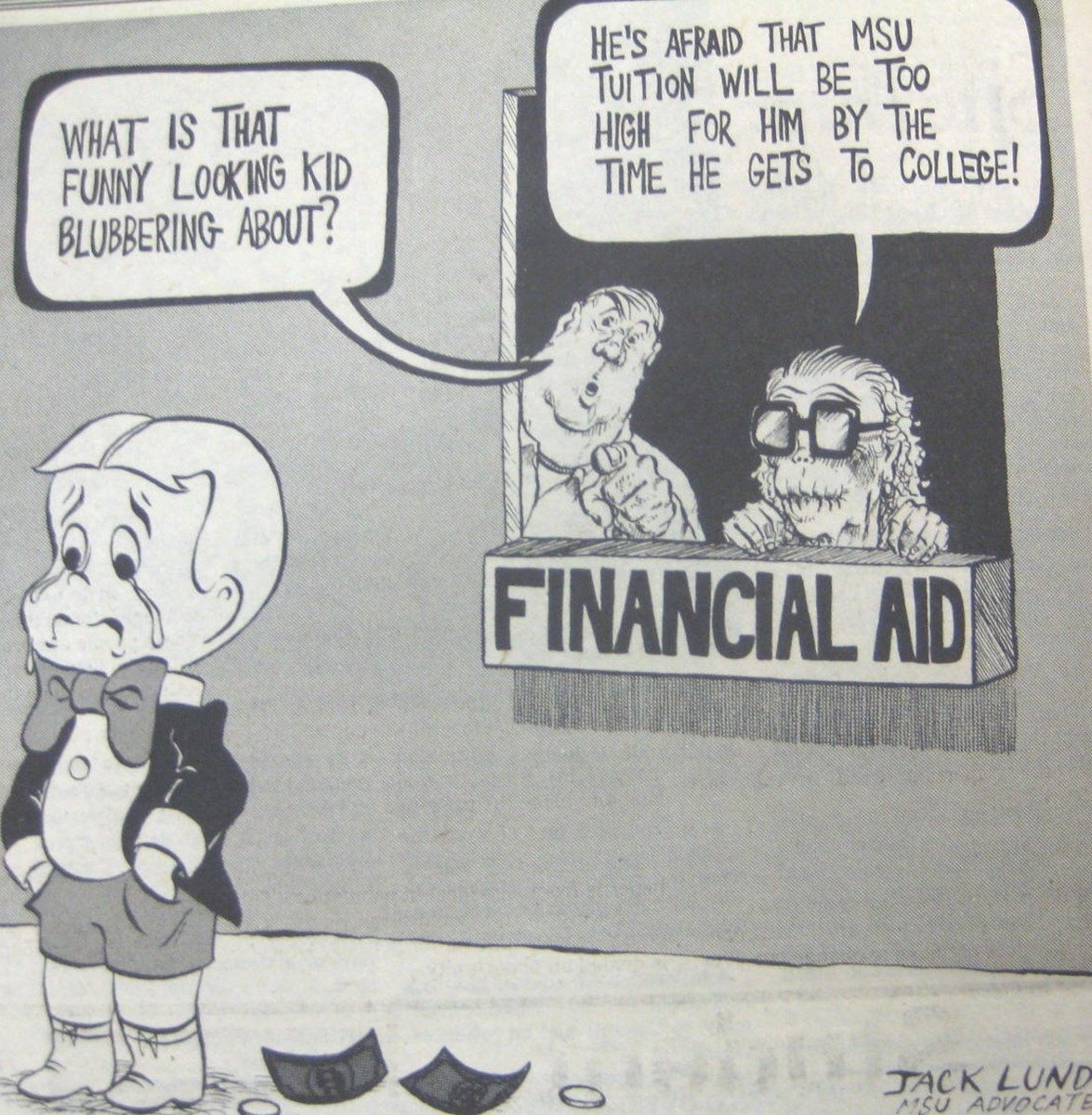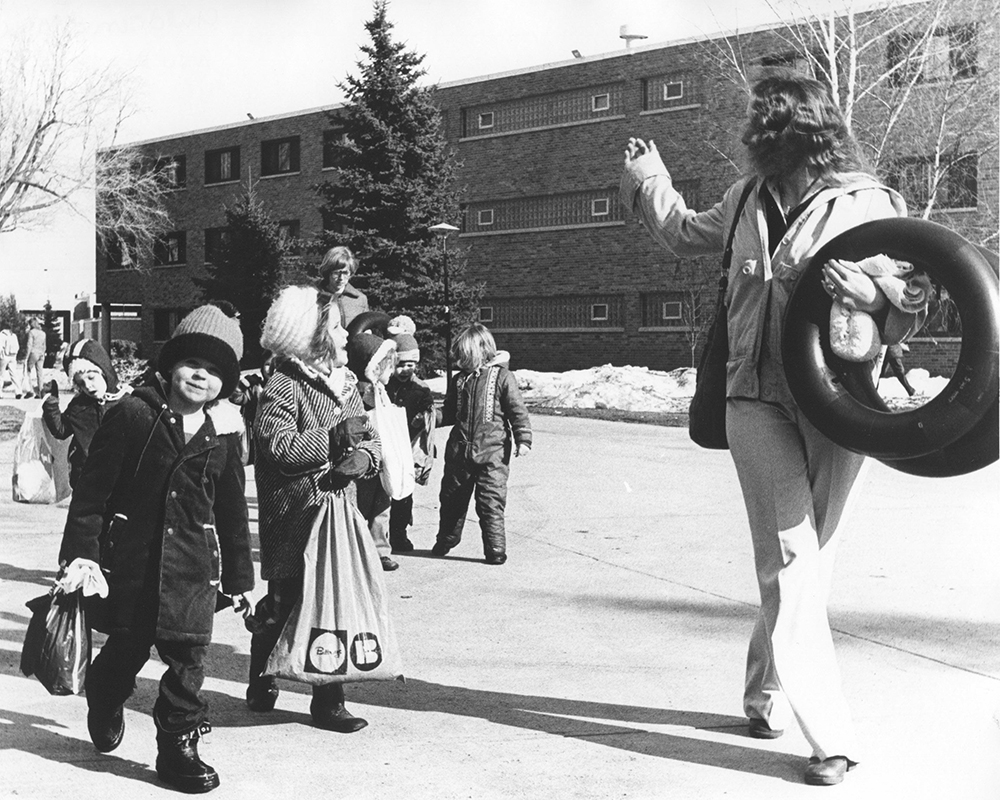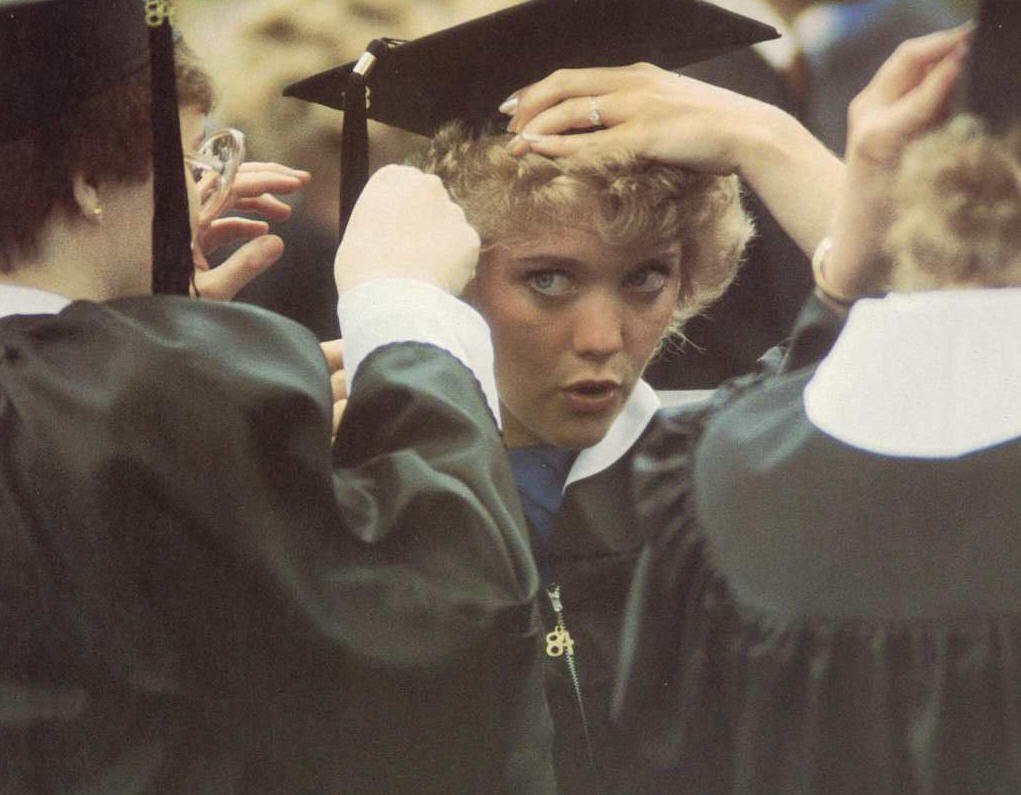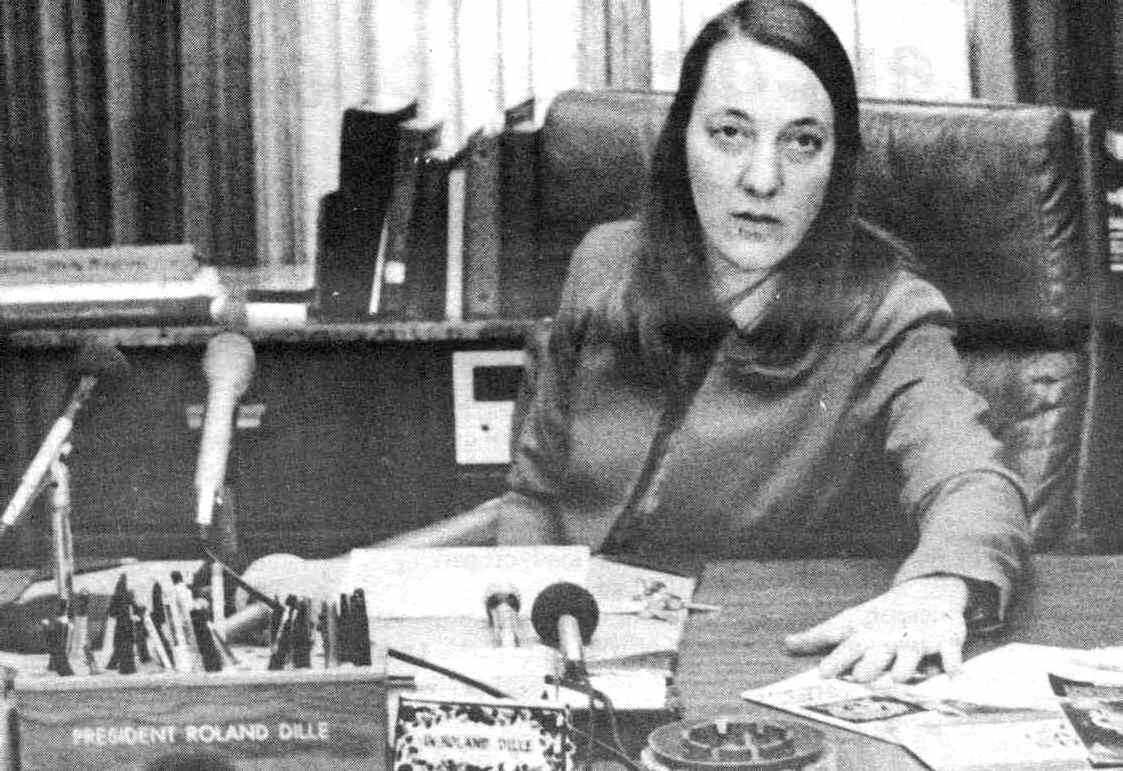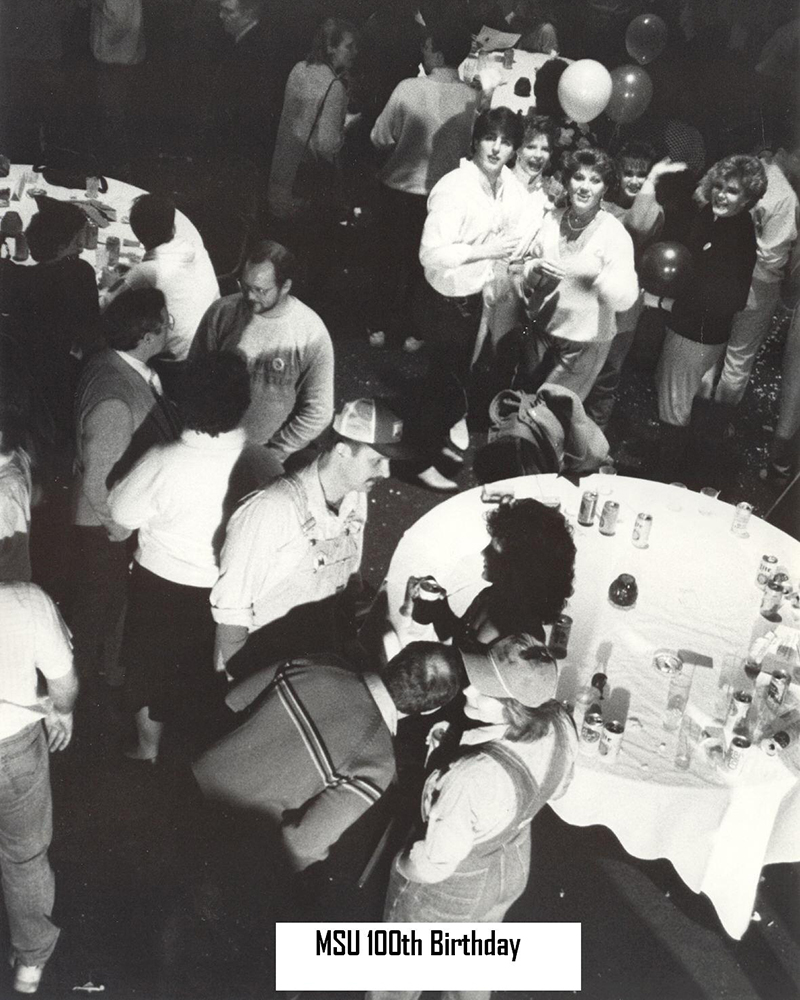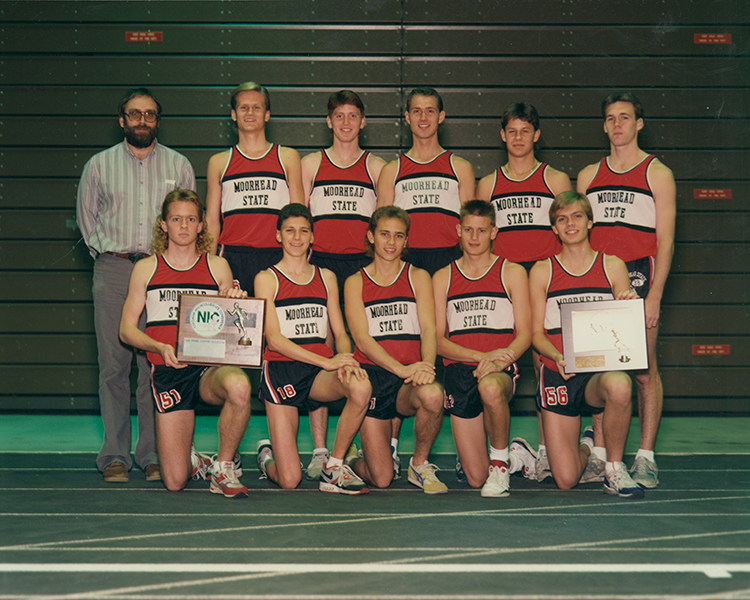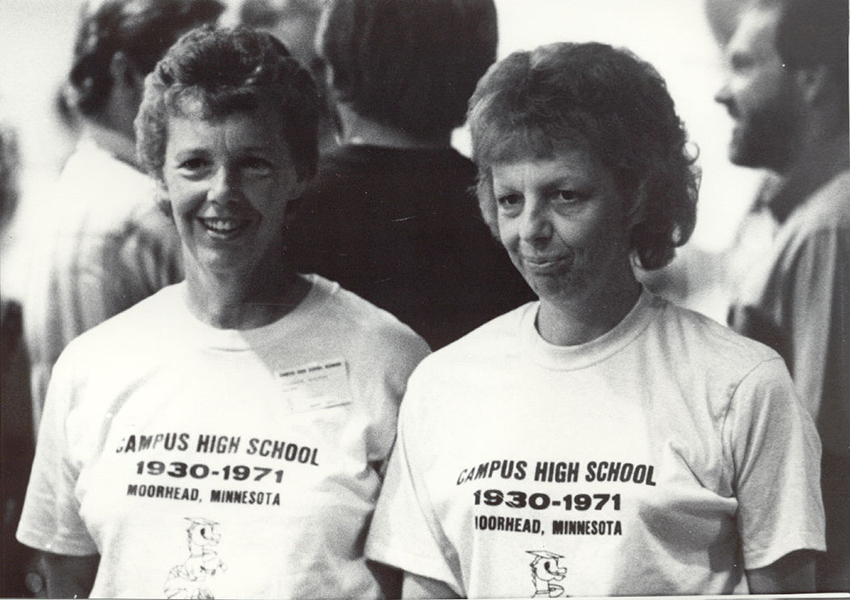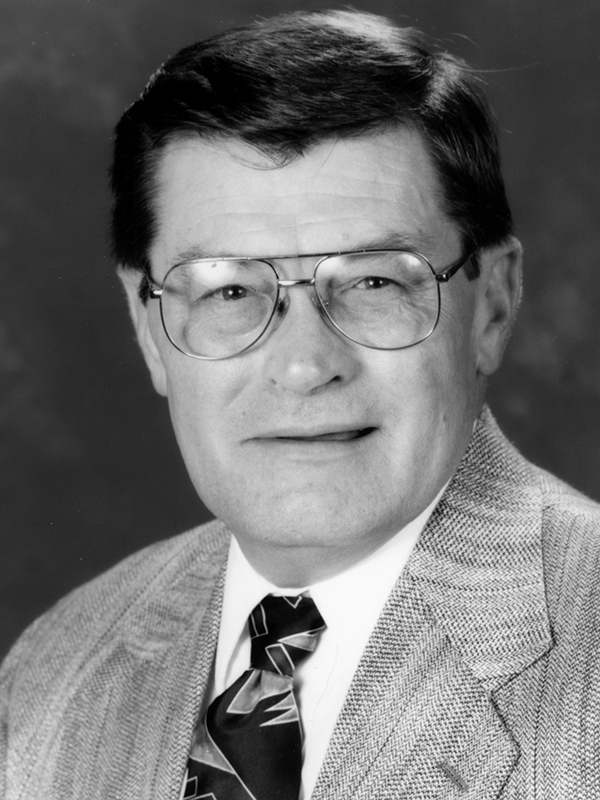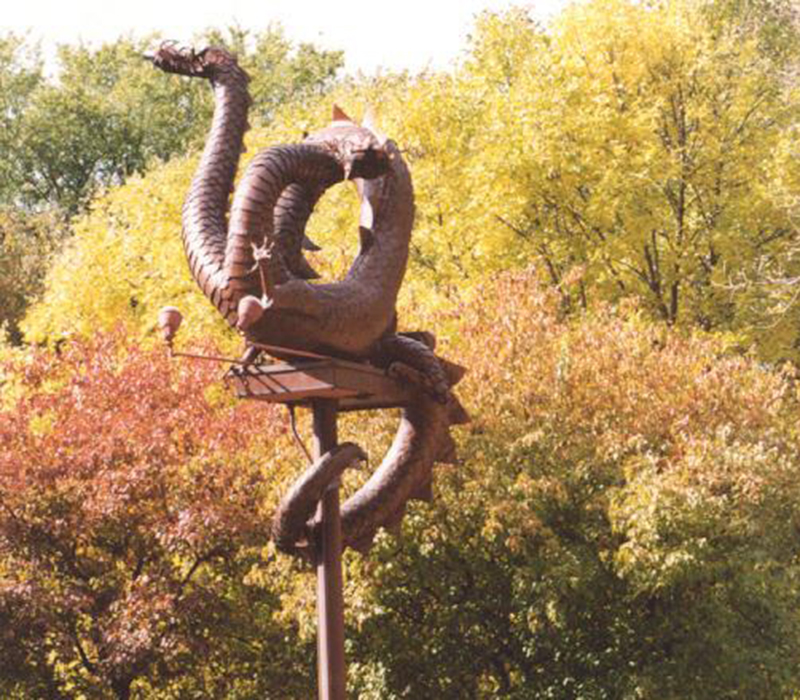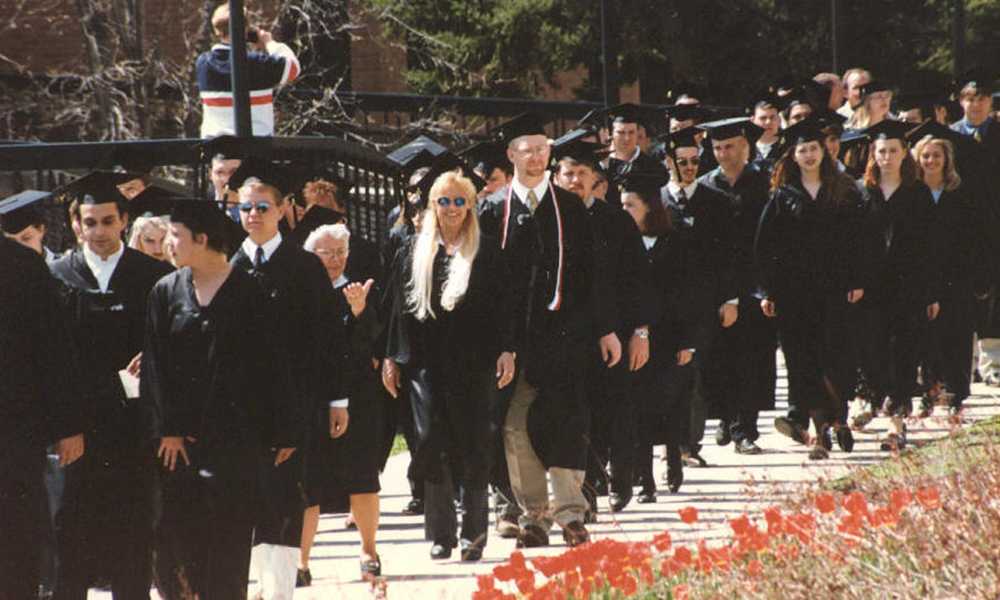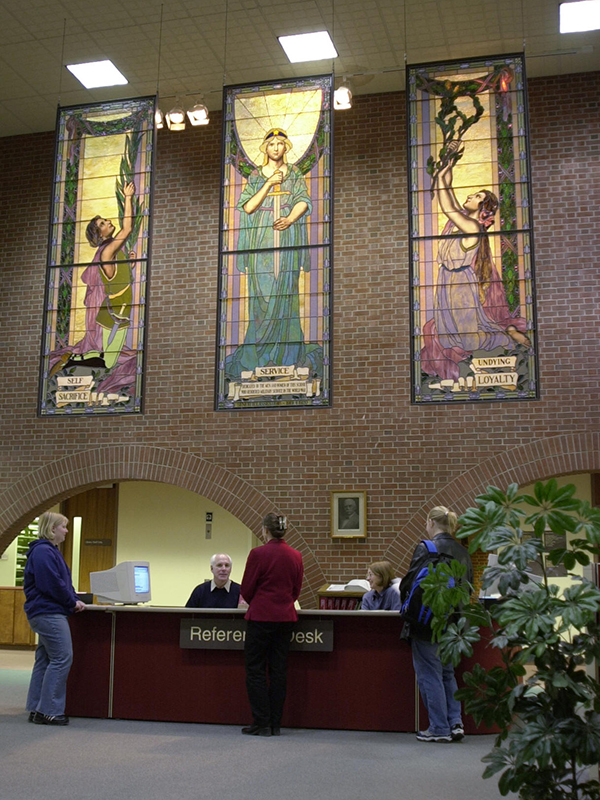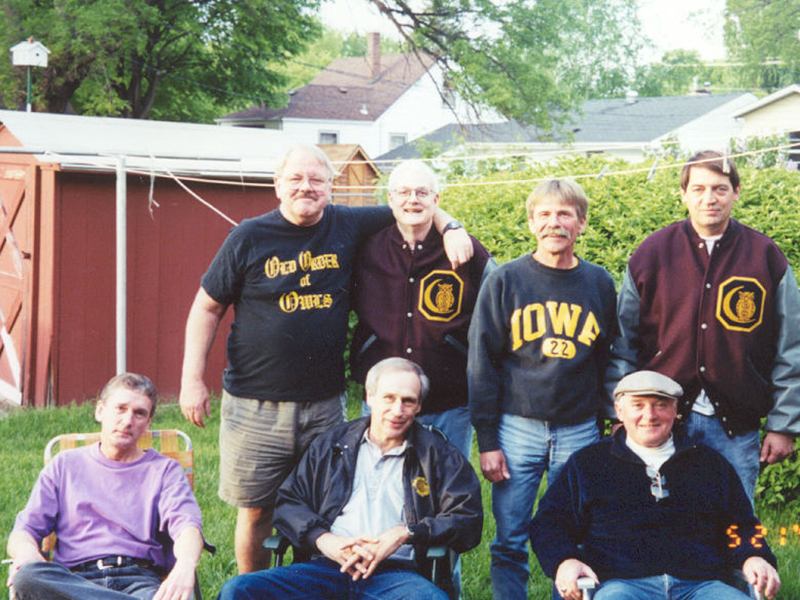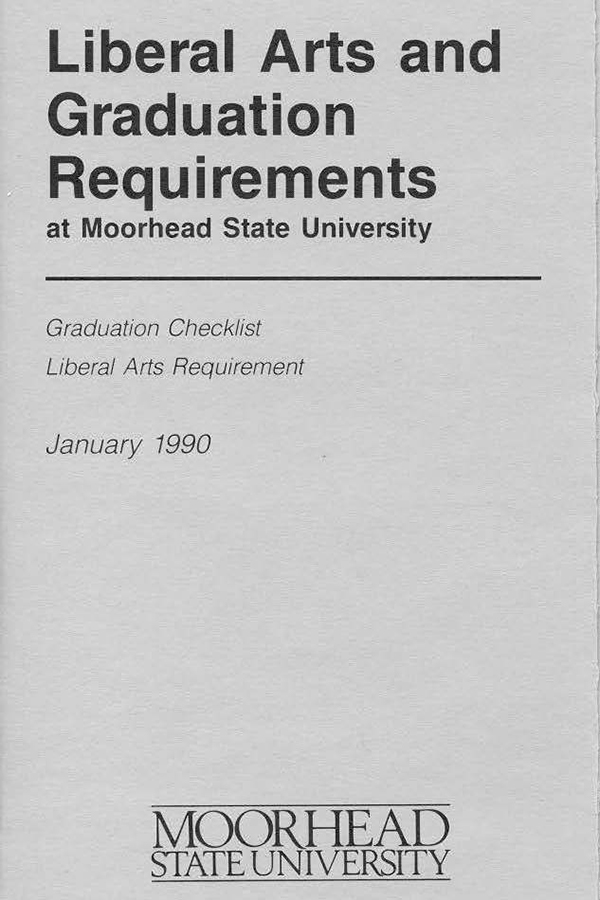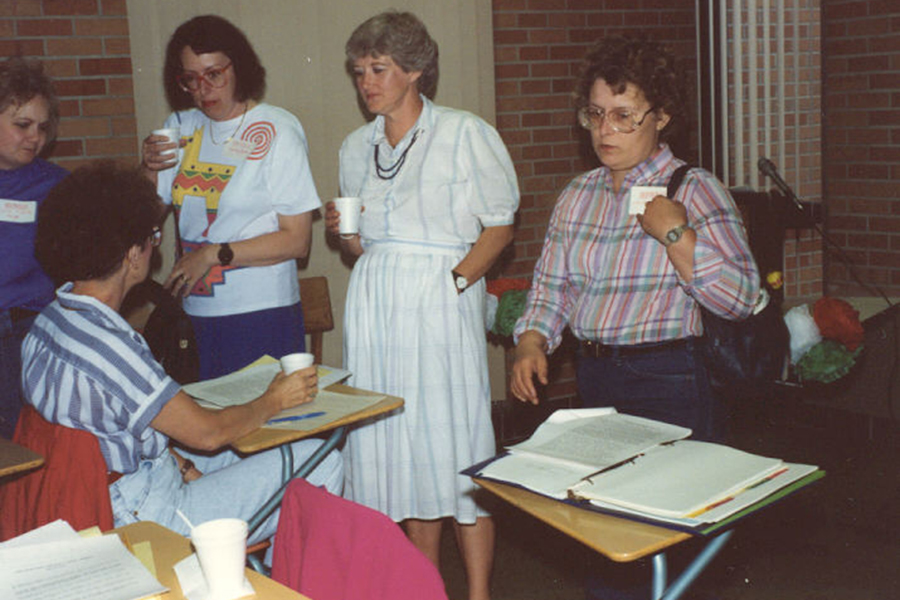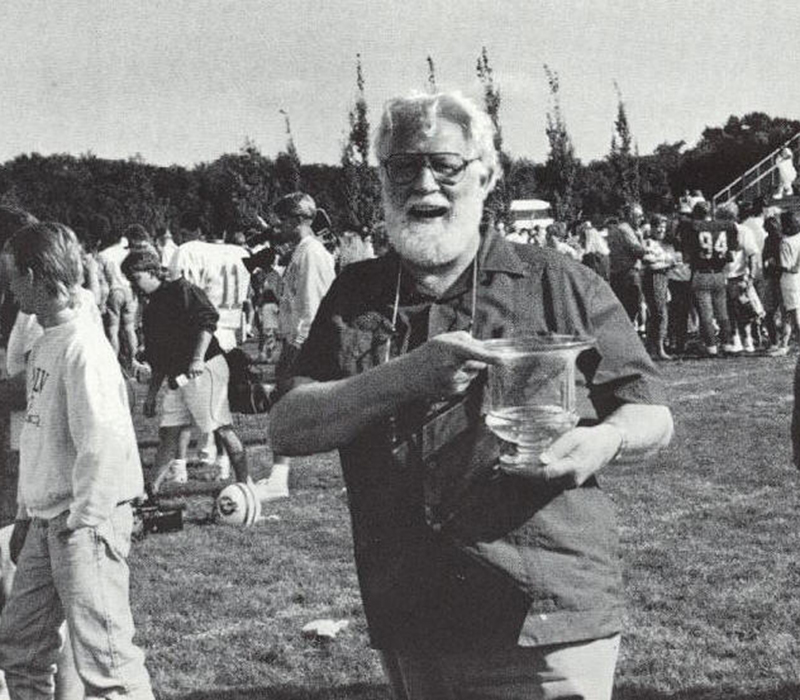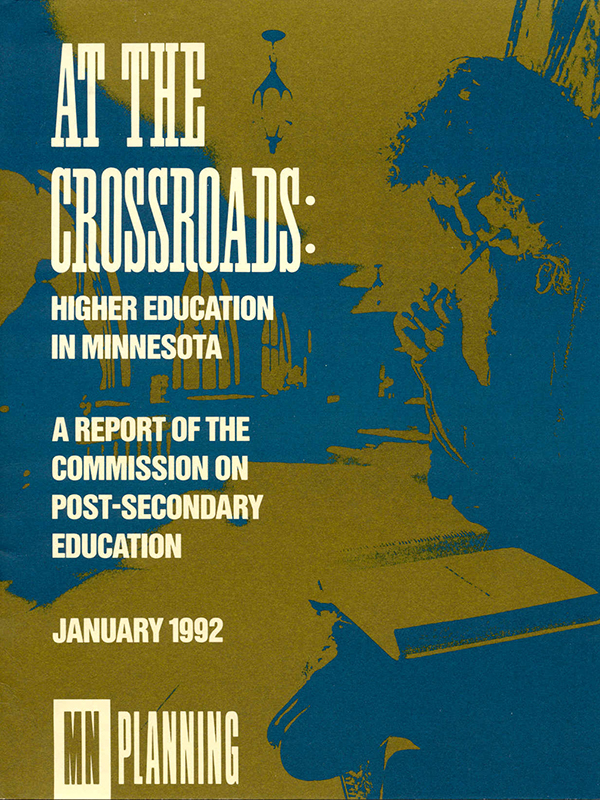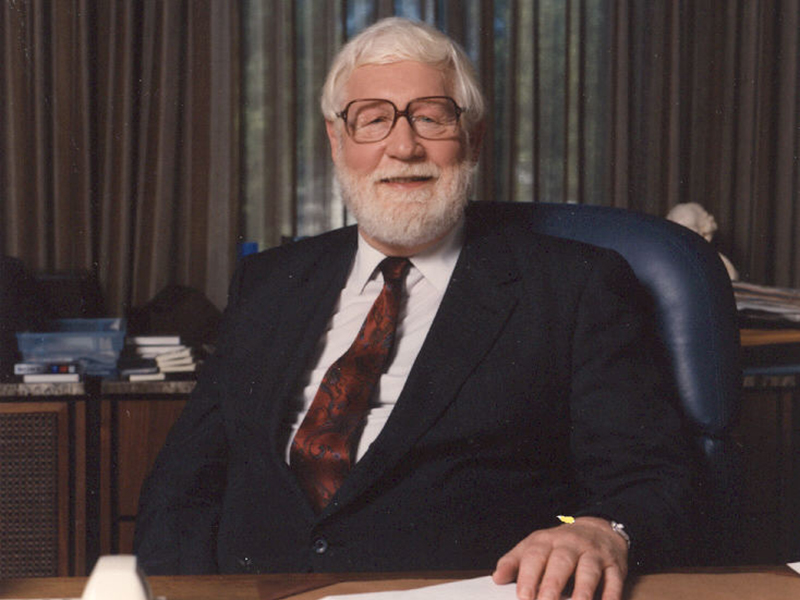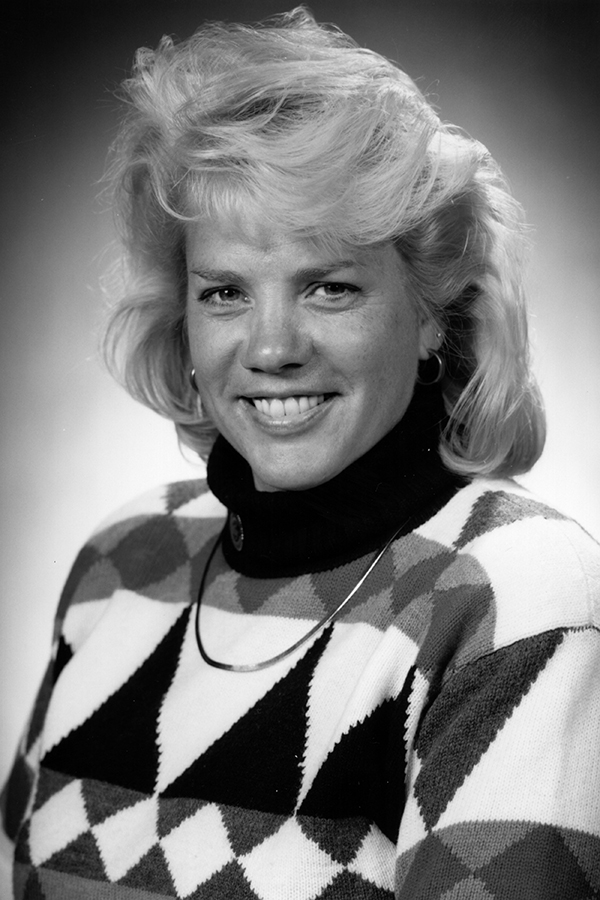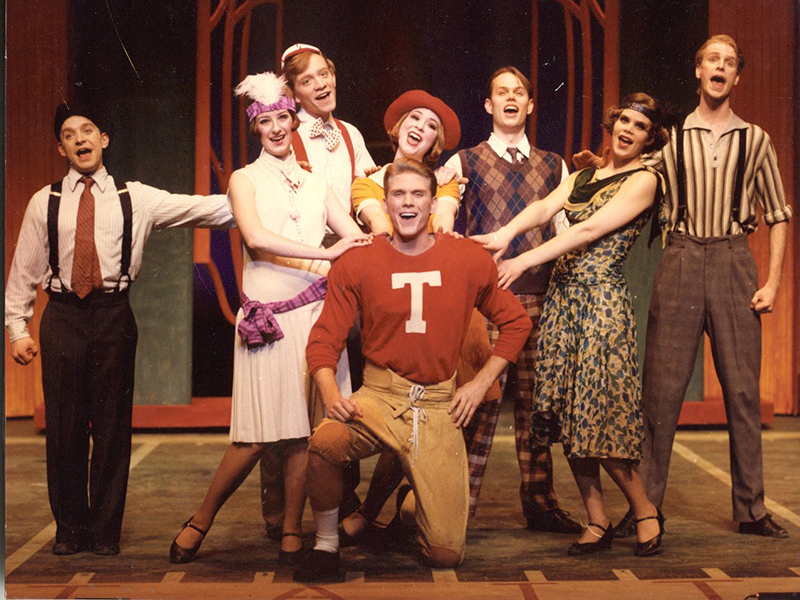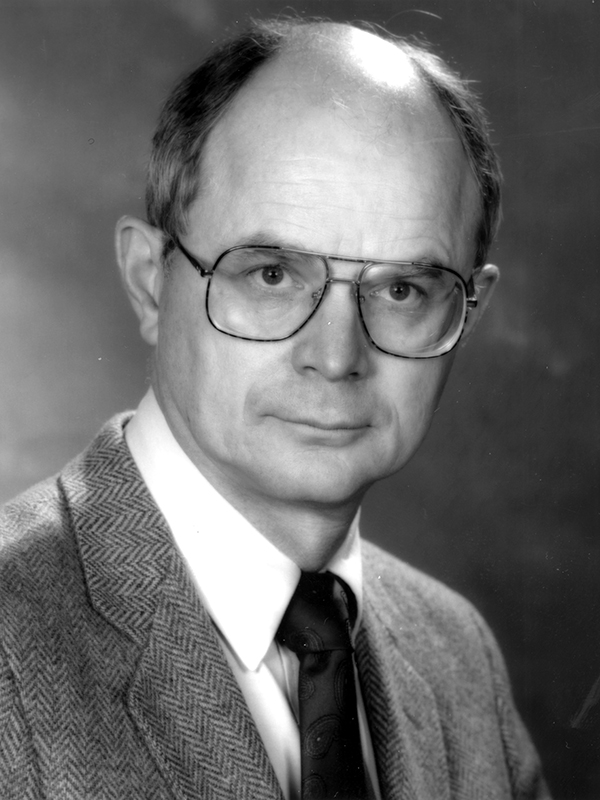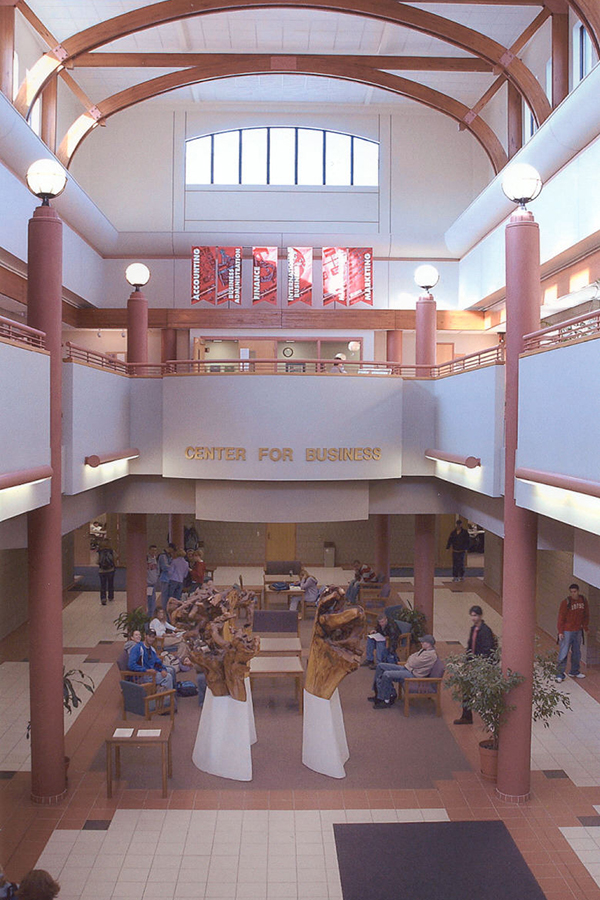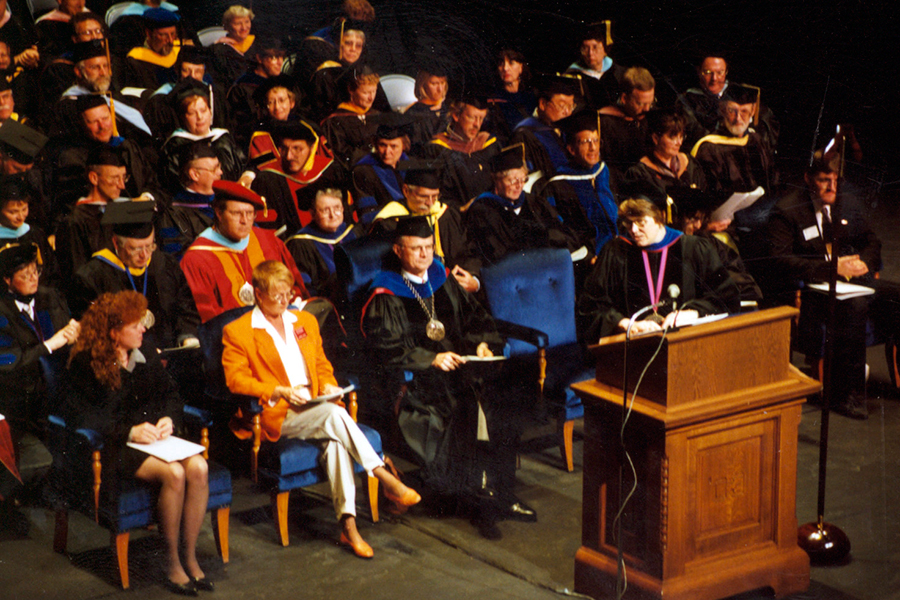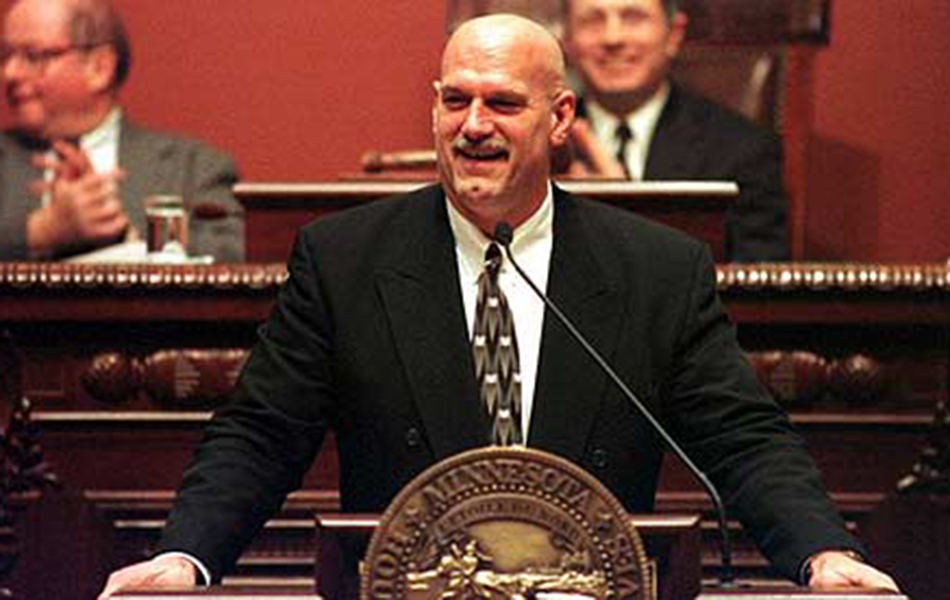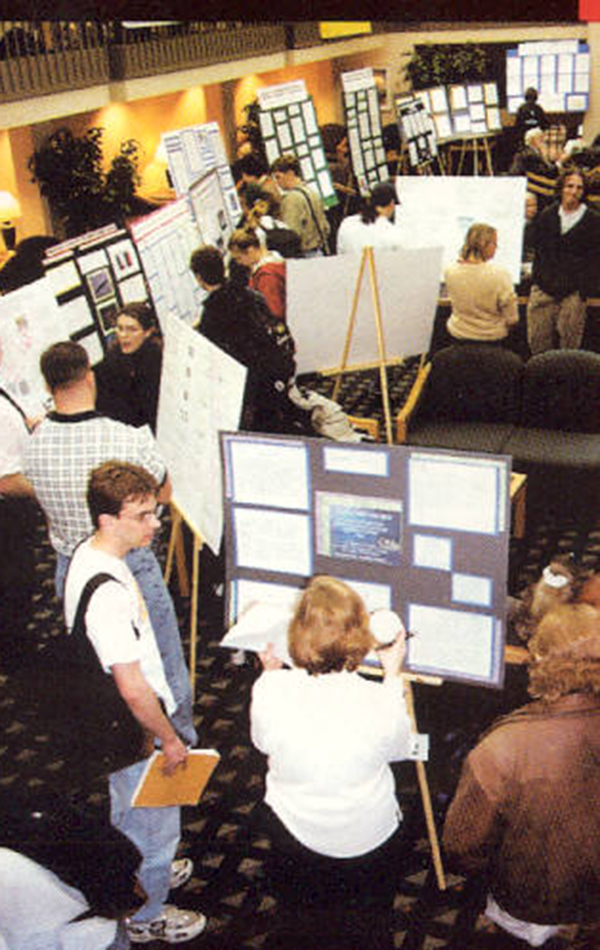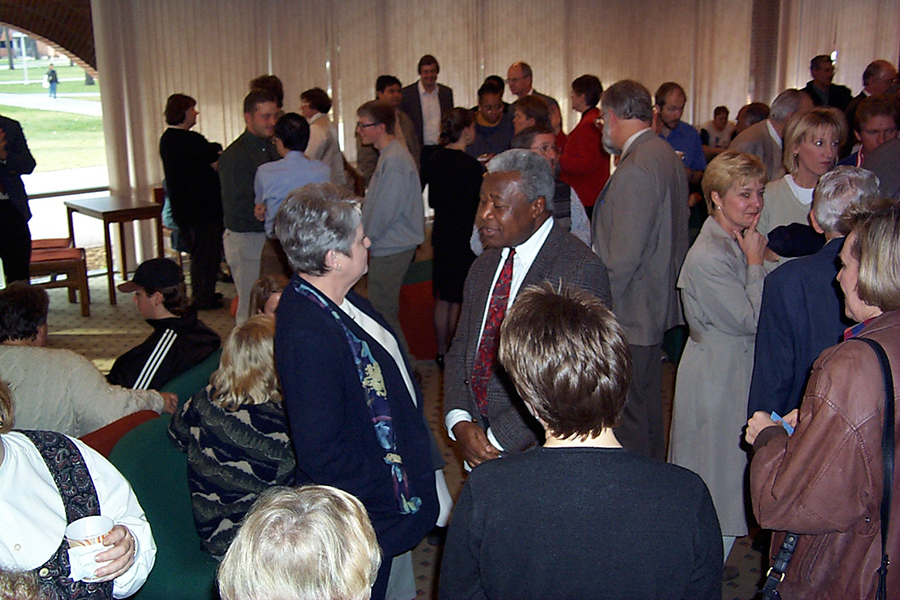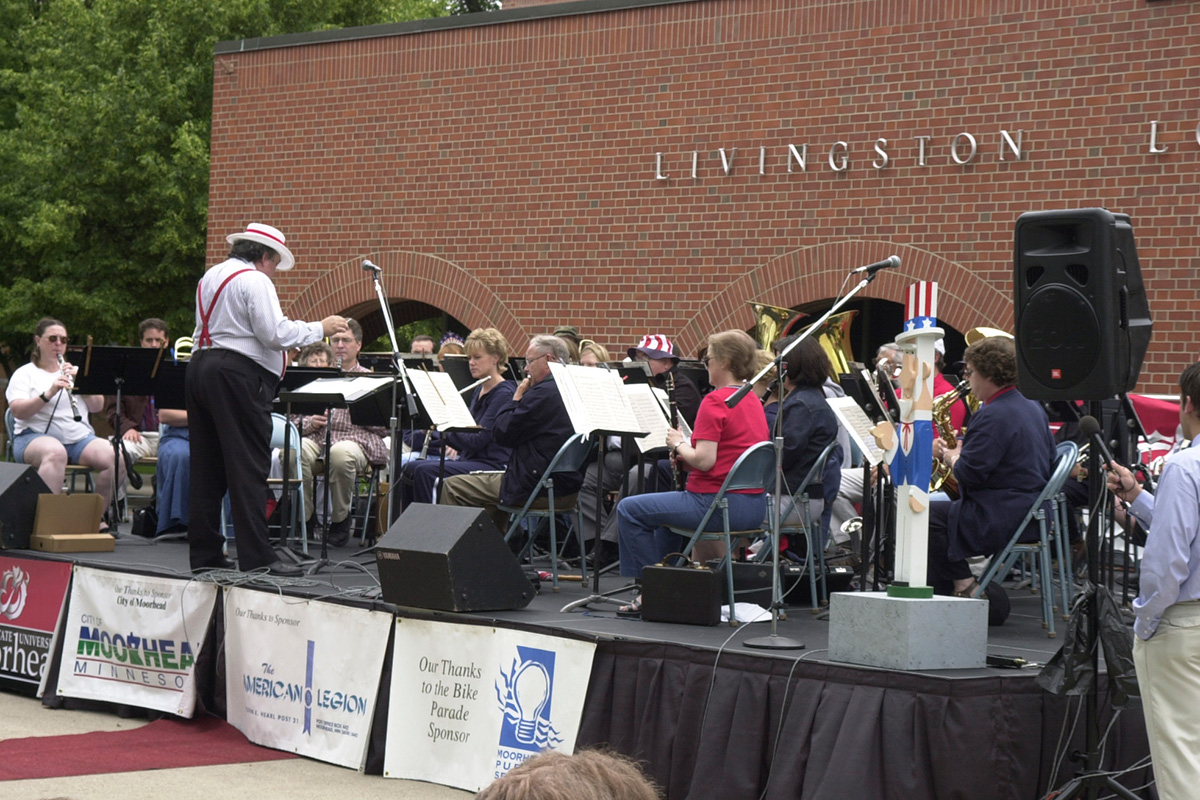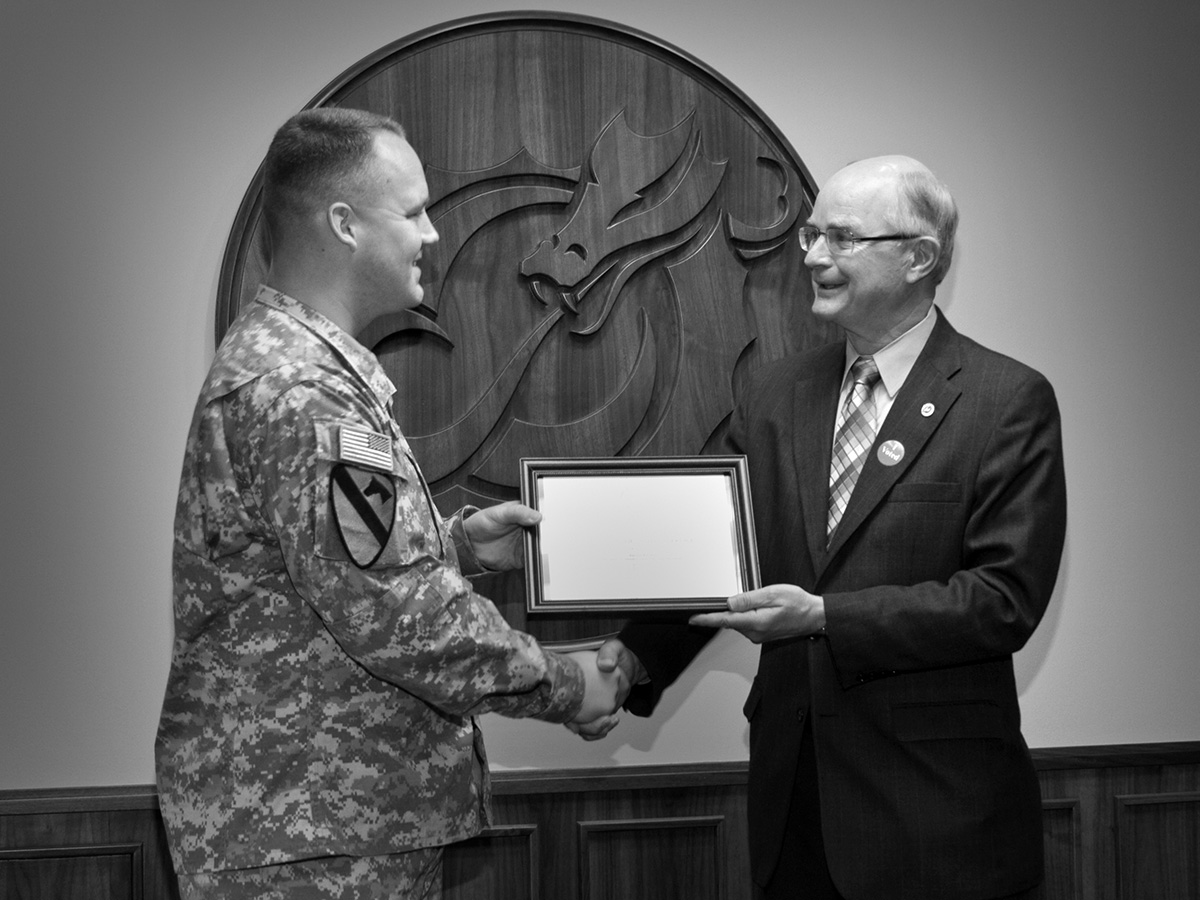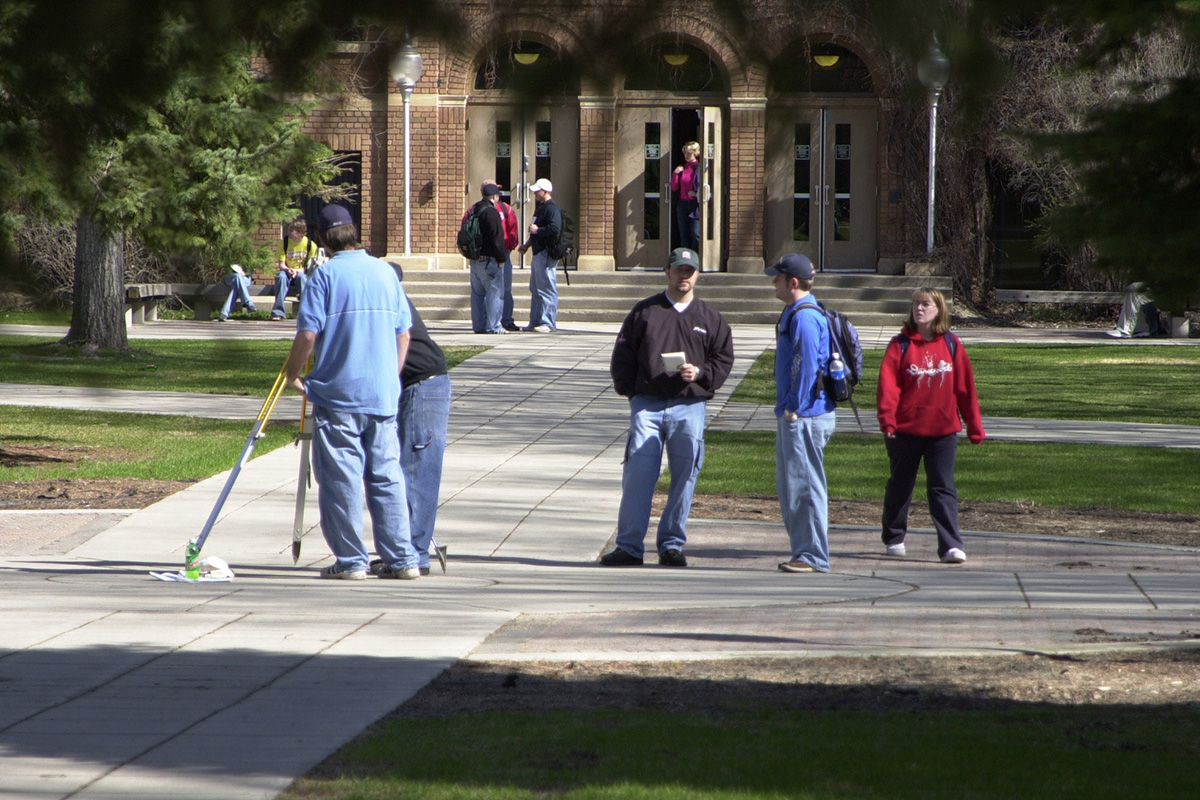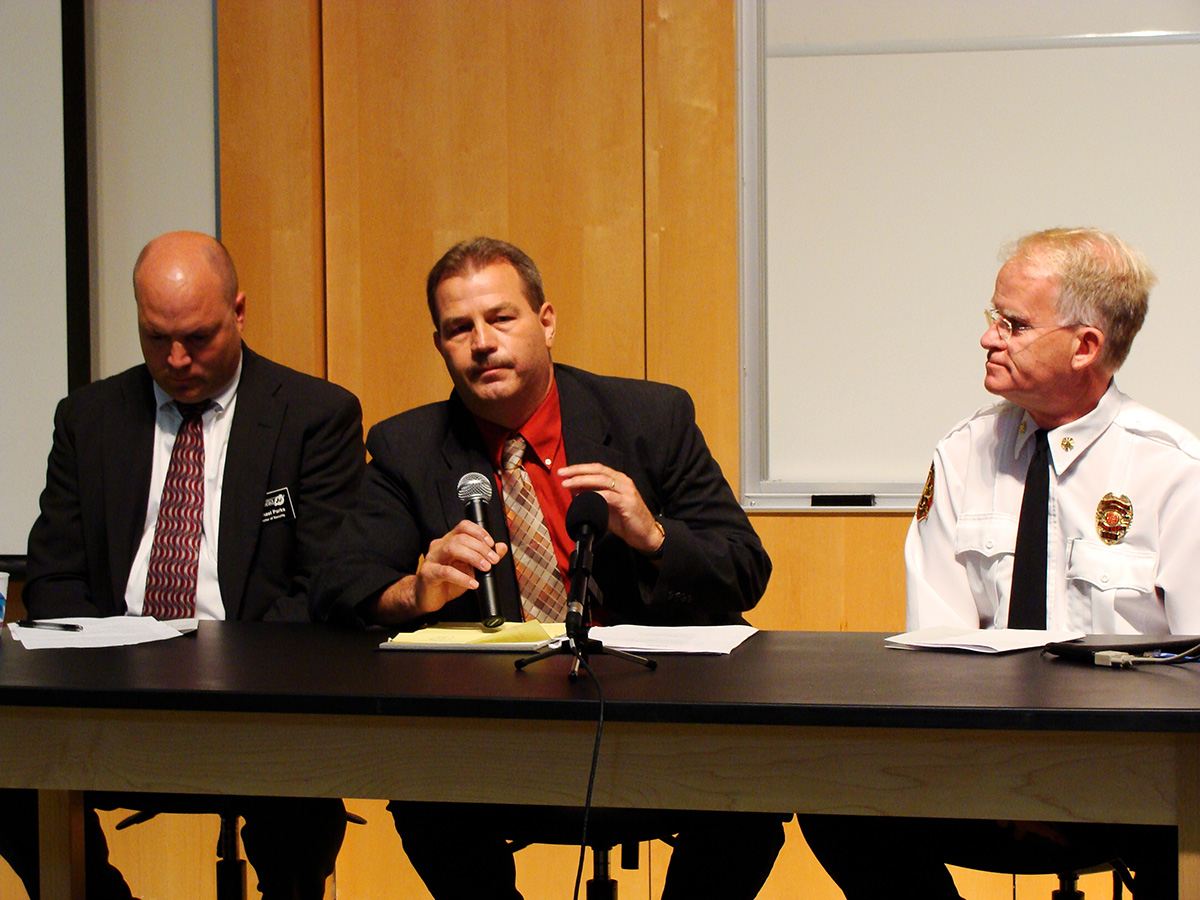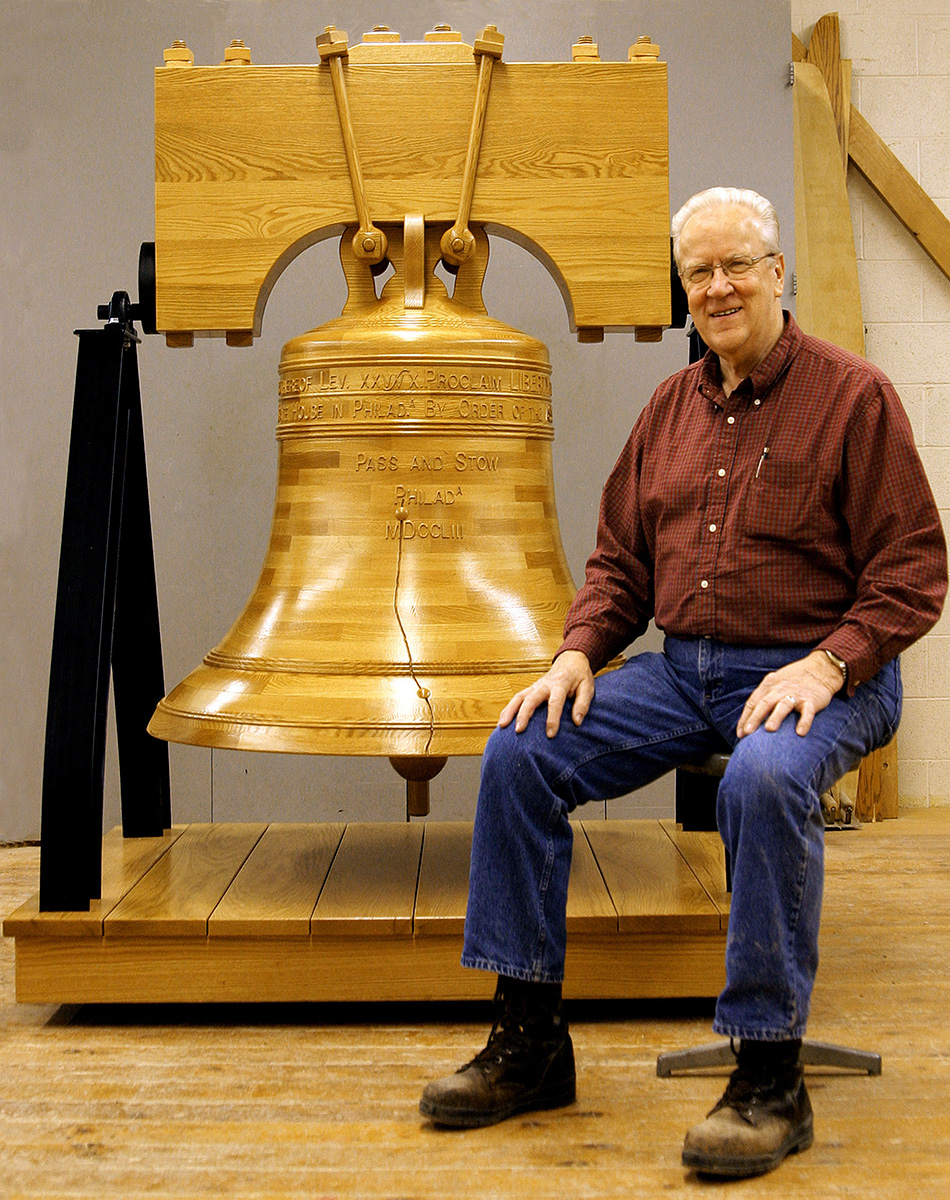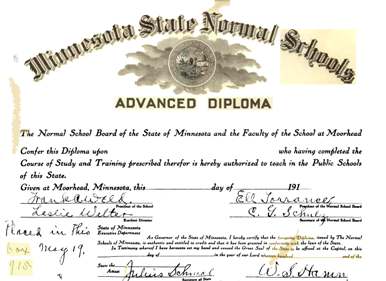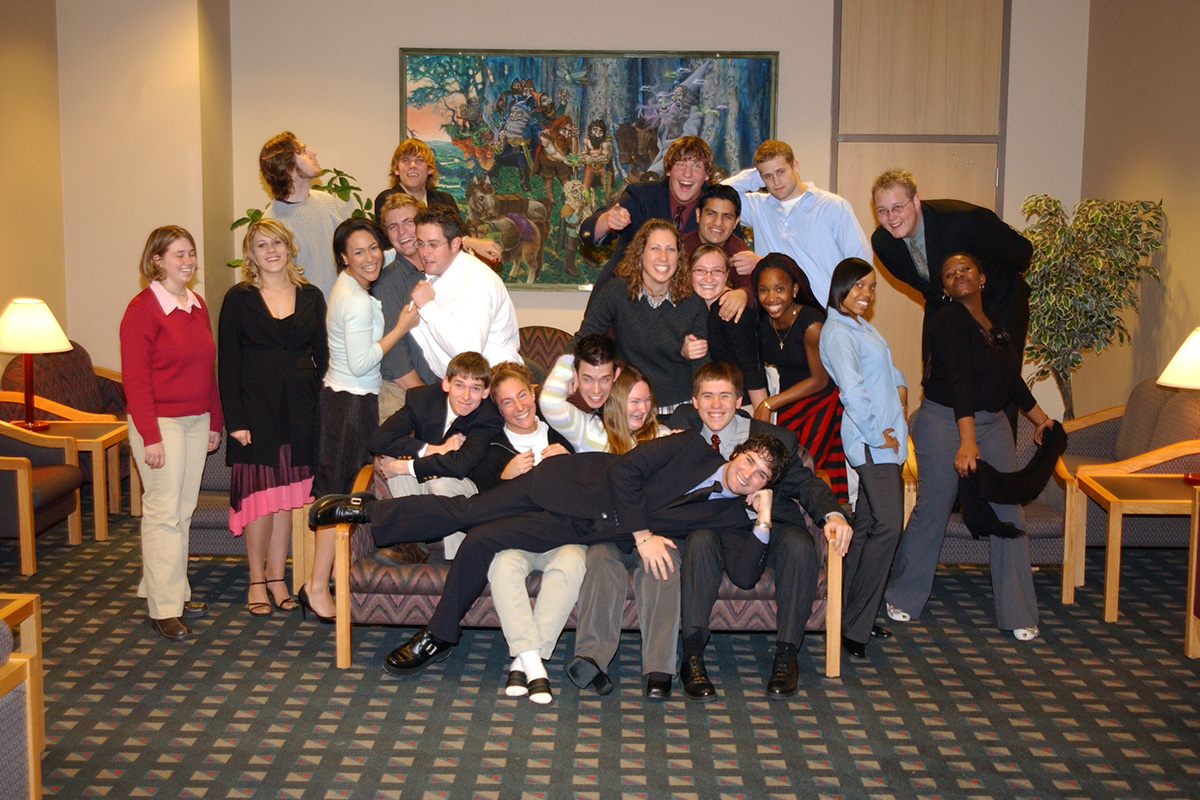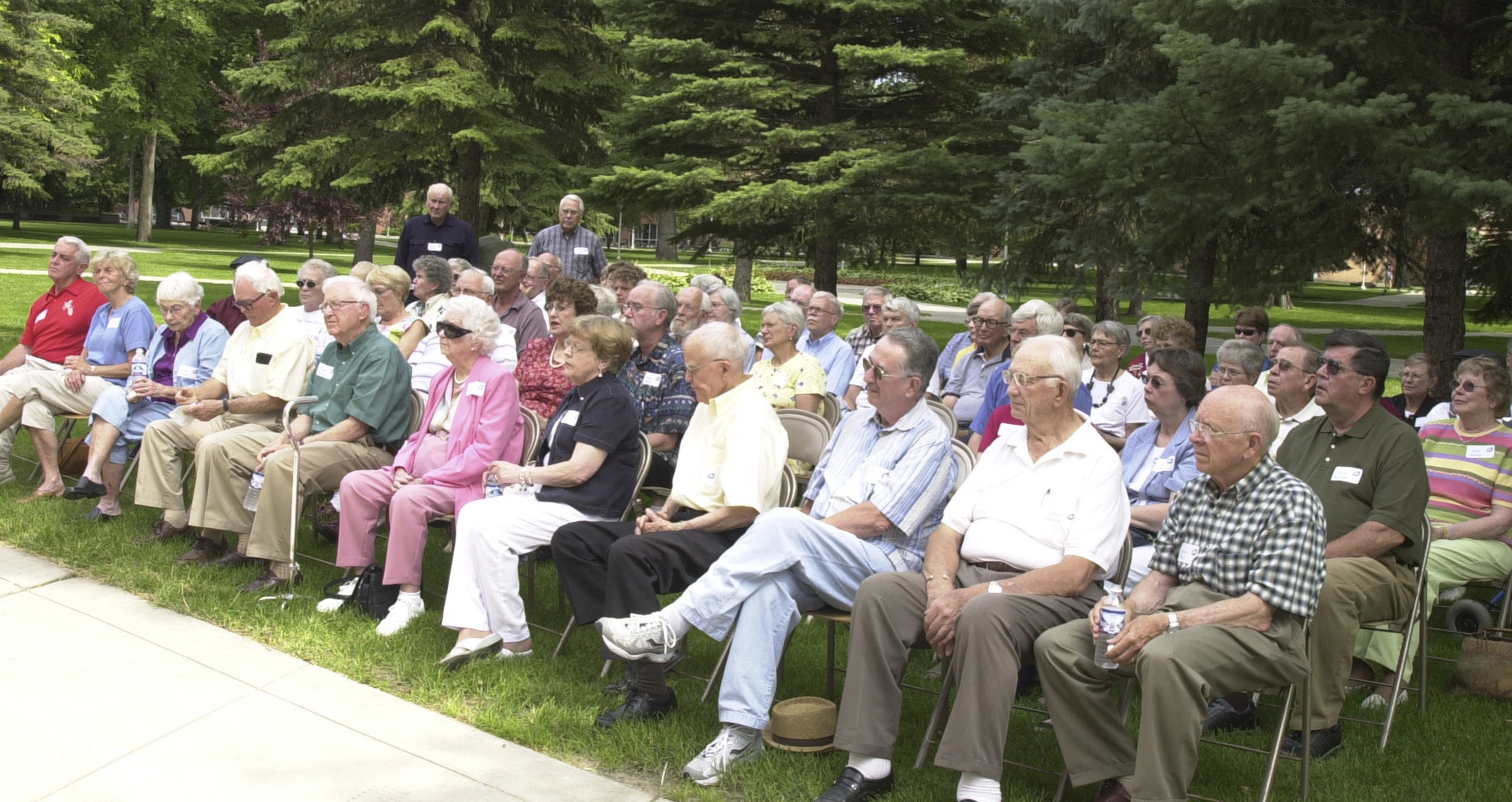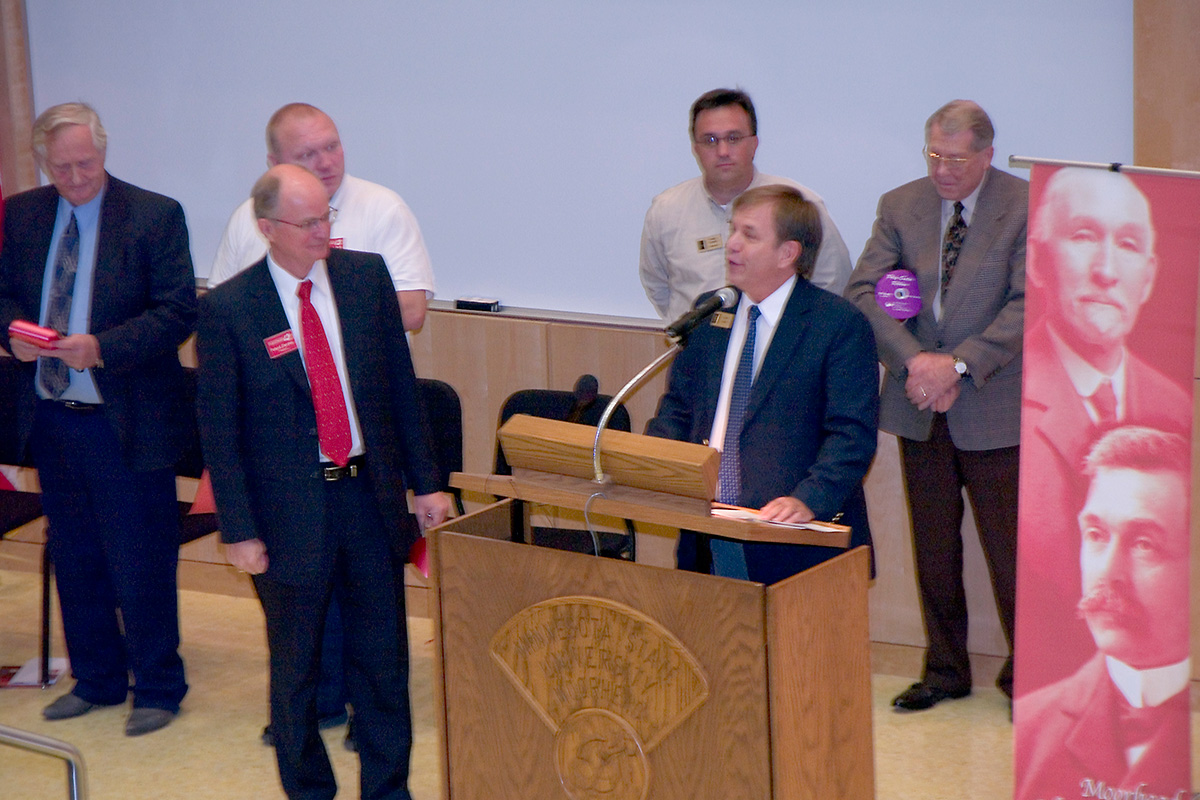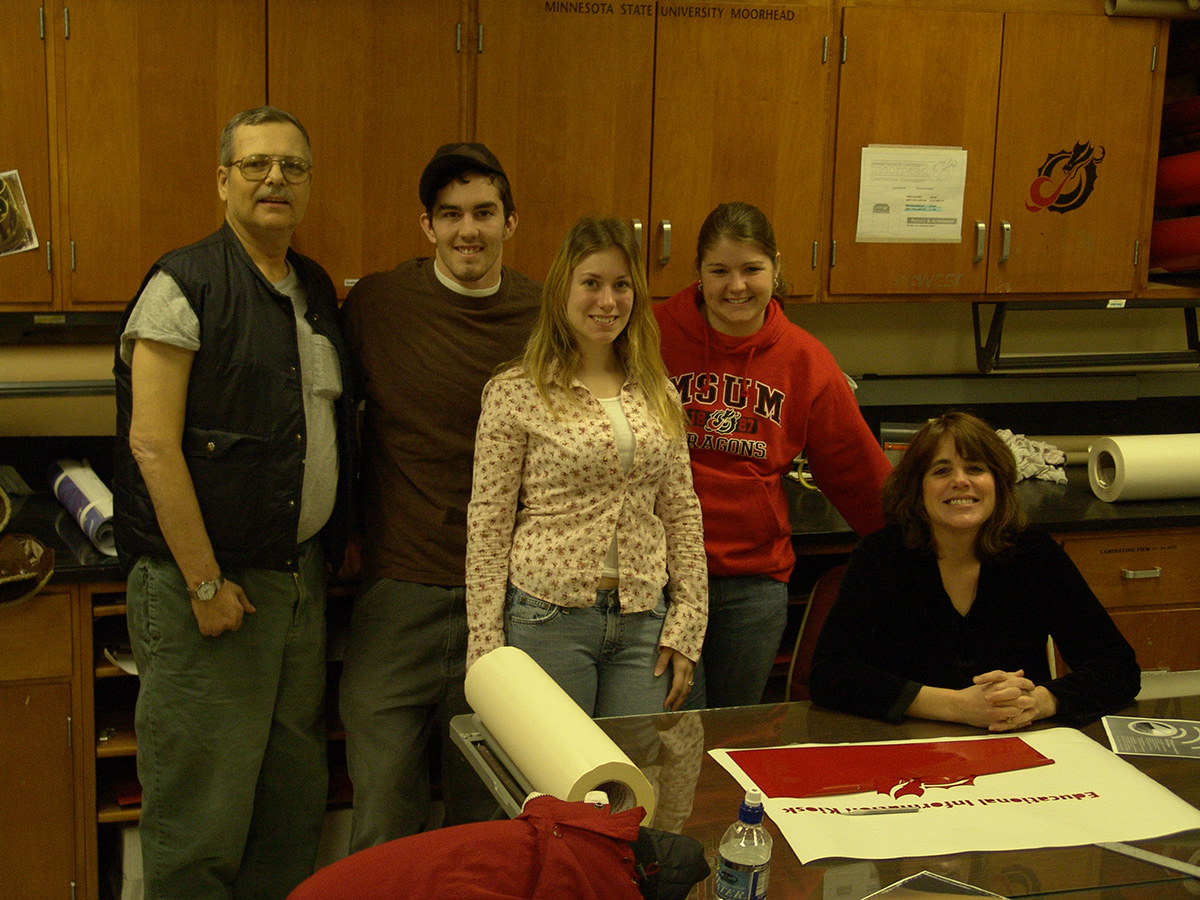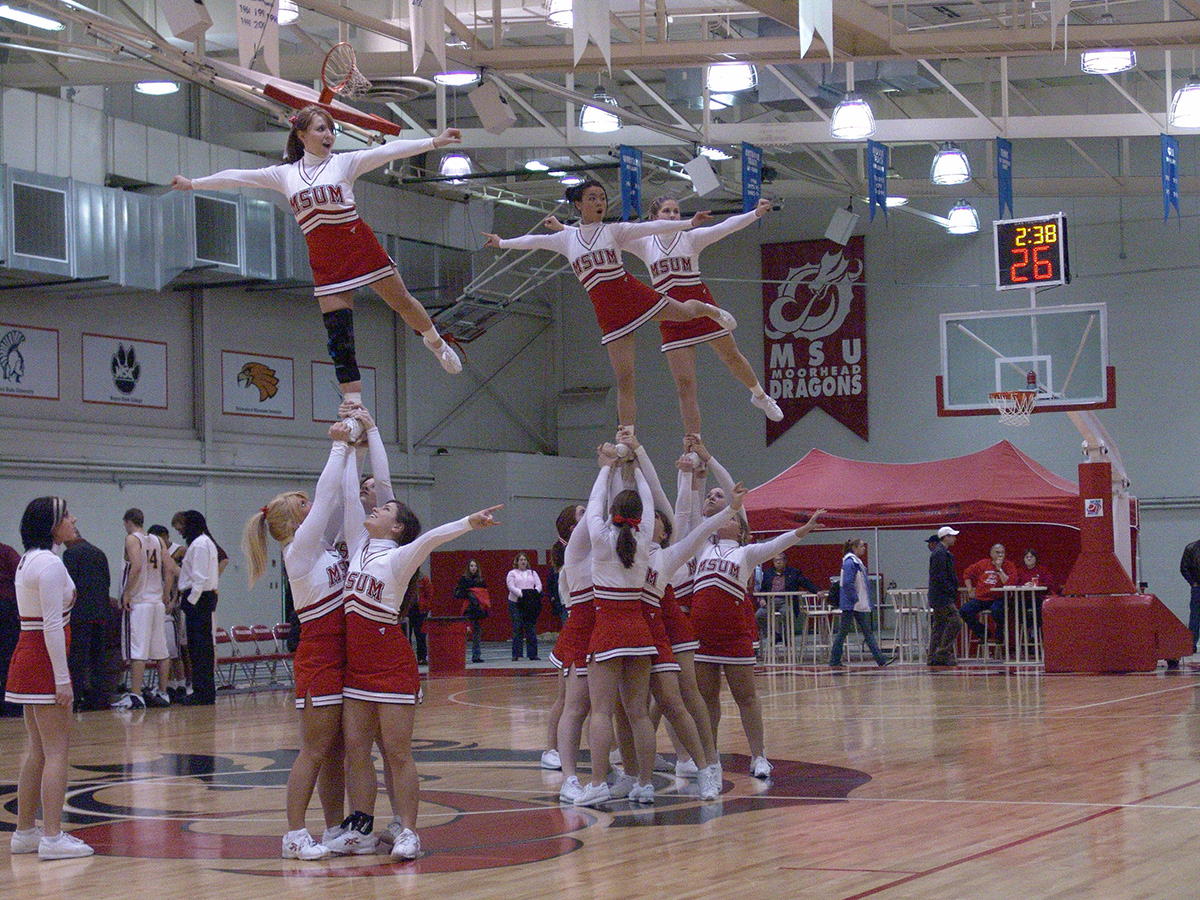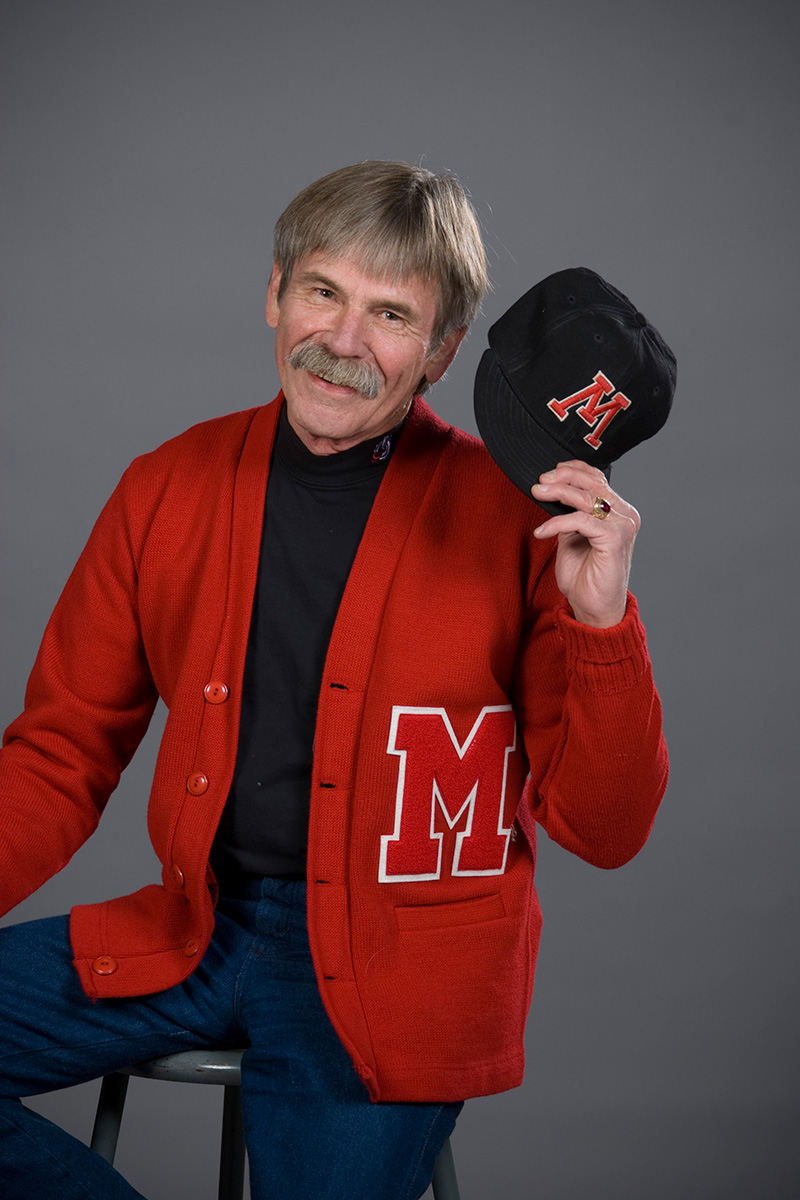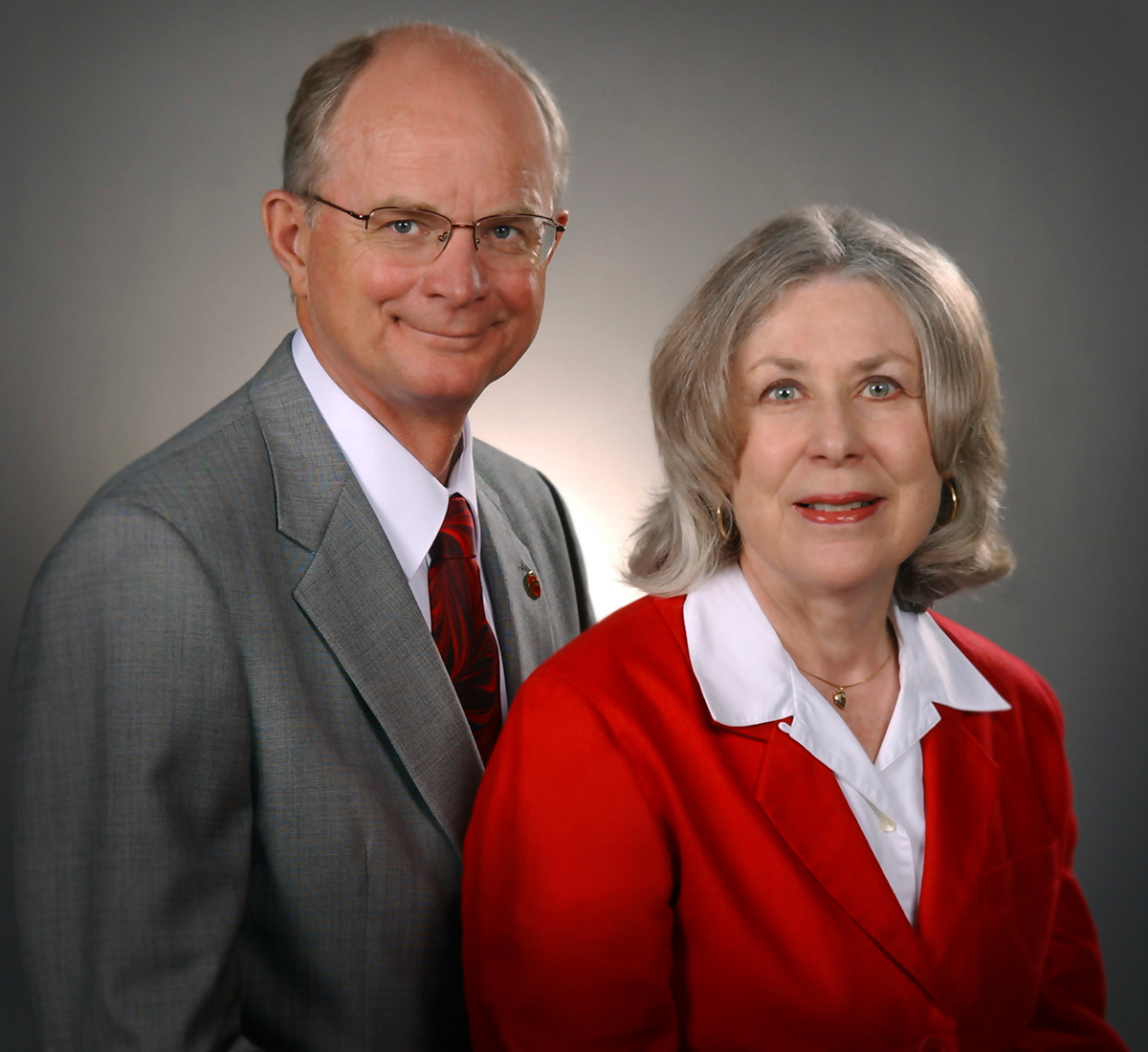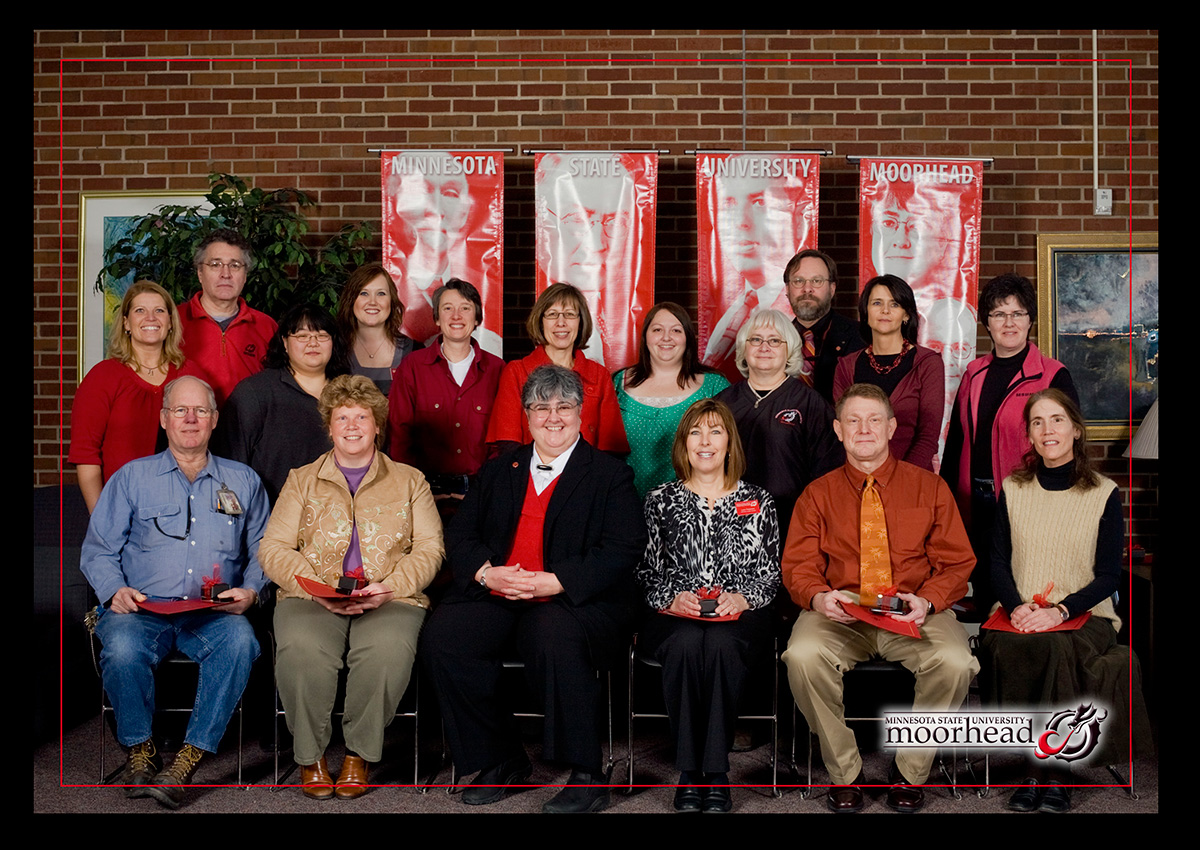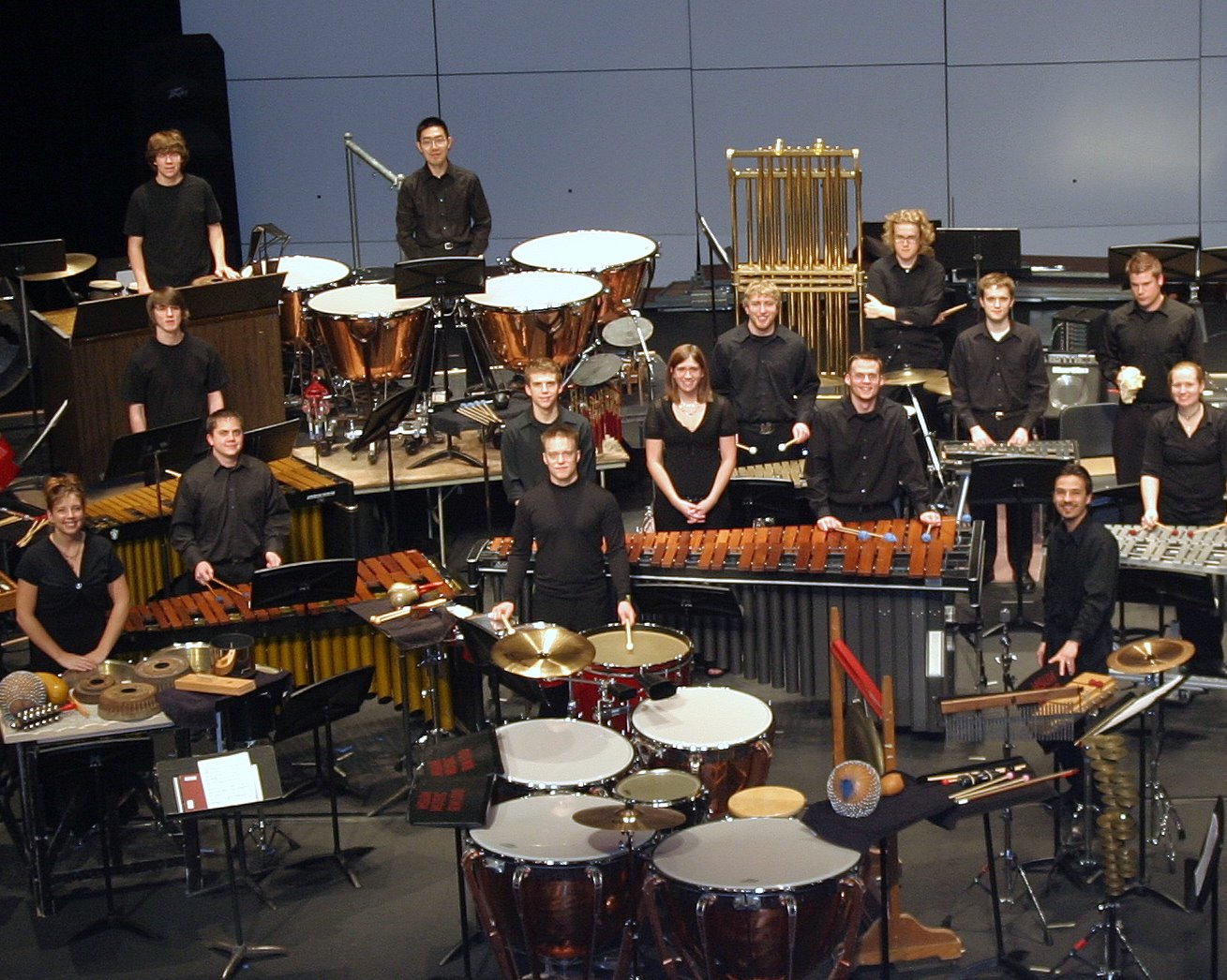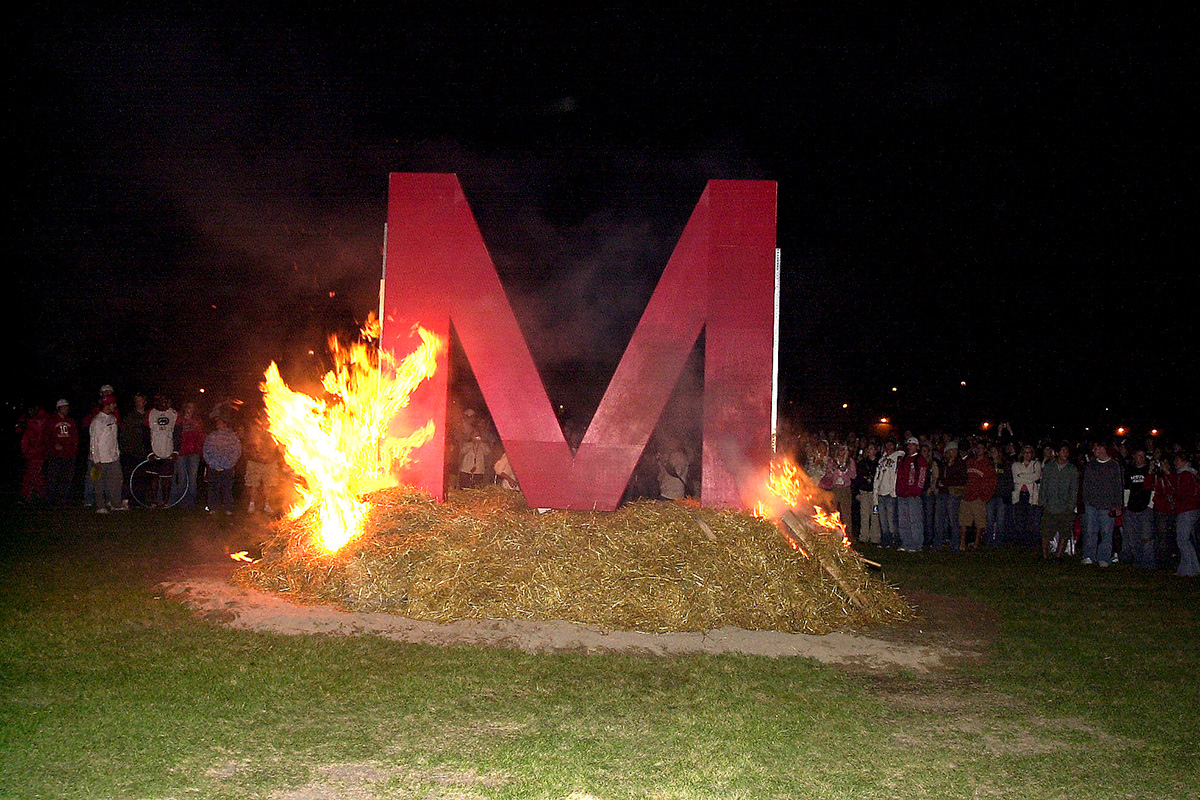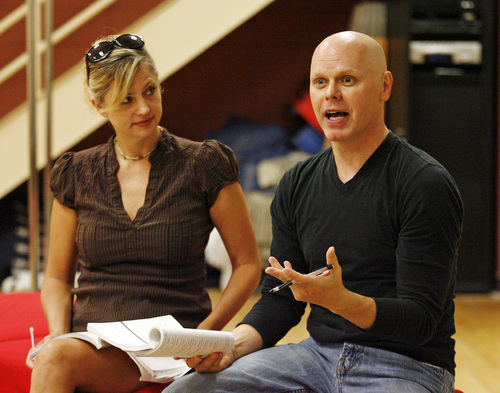125th Anniversary Timeline
Moorhead State Through the Decades
The Moorhead Normal School opened in the fall of 1888 and the first graduating class of eight students received their degrees in 1890. In 1921, the need for high school teachers led the state legislature to authorize to award bachelor’s degrees, renaming the school Moorhead State Teachers College. During the Depression, on February 9, 1930, Old Main Hall building burned. By 1932 a new administration building opened named in honor of President Ray MacLean. From the ashes arose the "birth of the greater Moorhead State Teachers College," and a new symbol for the campus, the fire-breathing Dragon. During March 1943 to June 1944, 1,650 aircrew men did aviation training at MSTC.
Moorhead State Teachers College is renamed Moorhead State College (MSC). The tuition for 1957 is $40.00 per quarter (fall, winter and spring) for residents, $120.00 per quarter for non-Minnesota students.
Controversy over use of student-collected funds for a student union leads to a short "protest" when an old church bell tower burns one night in the center of campus.
Controversy over Funds for a Student Union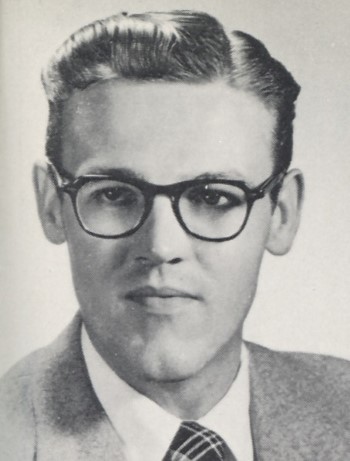
Harlan Shuck was all set to graduate from Moorhead State College in the spring of 1958. He was looking forward to getting out of school, partly because he was a few years older than most of the others seniors that year, and partly because he was looking forward to the job he had been offered. Joining the Army right out of high school, Shuck had spent a year in Korean conflict, which was nothing he liked to remember, but was part of the service that had helped him pay for college. Shuck did well in school, excelling in his classes and showing promise as a teacher after he graduated.
But during his last year Shuck ran afoul of the college's president, Arthur Knoblauch, when the latter man wanted to build a bell tower on campus. "In 1957, Knoblauch decided that he could take the money that students had been putting aside for a student union and use it for something else," Shuck recalled fifty years later. "Knoblauch wanted to build a bell tower" (see image below). Most MSC students did not support the idea, preferring that the money be used for a union. So Shuck, who admitted he did not like Knoblauch's tendency to act like an autocrat, decided to join a few friends and 'demonstrated' their displeasure. "One night a group went out to where an old church or school was torn down, and grabbed the little bell tower. We threw in into the truck and brought it back late at night and put it in the center of campus. It was like saying 'there's your bell tower Mr. President.' It sat there for a day or so, while Knoblauch looked for the culprits, and then someone, not me, burned it, again in the middle of the night. I don't know who did that."
Who did burn the tower? Fifty-five years later, that question remains unanswered. But some possibilities have been offered. Two students who worked at the Mistic in 1957 later presented their own theory as to how the bell tower burned that night: "The Way We Saw It," (1975), written by by Marvel Froemming (on left) and Janet Paulsen (on right)
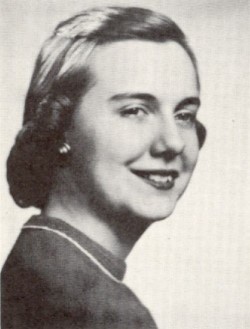
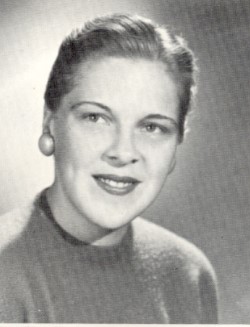
"There was student activism in the fifties. There were administrative decisions with which we did not agree. The primary difference between then and now is that now there are only a few student activists. Back then, contrary to popular mythology about the apathetic fifties, there were so many activist groups that no one ever knew which group was responsible for which part of the action. The infamous bell tower incident comes immediately to mind. Our imaginative administration decided that the campus needed a “symbol of unity.” Their idea was to mount a major fund raising drive, which included a quarterly student assessment, to pay for the construction of a modernistic design -- a campanile. This igloo-shaped structure was to be placed in the center of the mall where it would be surrounded by those other outstanding examples of futuristic architecture—Weld Hall, MacLean Hall, Lommen Hall, and the Wheeler-Comstock-Ballard Hall dormitory complex. Our tough-minded Student Commission rubber stamped the idea without a word to the rest of the student body. But then the administration made a fatal mistake. They gave the architect’s drawing to the editor of the Dragon with orders to feature the sketch in the next yearbook. And one group of activists “hung out” in the Dragon-MiSTiC office.
"Within hours, everyone knew! Late the next night a group of students brought the steeple bell tower from an old country school house to the campus and placed it in the center of the circle. During the next few days sororities placed artificial flowers around the bell tower, faculty members posed for pictures beside it, and appropriate music was played to pay homage to the structure. The entire concept of a bell tower was the laughing stock of the campus. The only people who weren’t laughing were administrators. But then another group of students decided to get a piece of the action. These students (was it the Owls?) set fire to the bell tower. It was an occasion to remember. As flames lit up the sky, “bell tower music” emanated from Wheeler Hall, cheering students hung from their dorm windows, and the screaming sirens of the Moorhead Fire Department pierced the still evening air. Serious thought of a bell tower rising over the campus diminished with the growth of ashes.
"Yet a different group of students knew that the administration would not give up so easily and decided that a confrontation was necessary. On May Day a massive body of students congregated in the center of the circle ringing bells, calling student to a convocation pitting a student panel against the President’s administrative assistant. The special edition of the MiSTiC publicizing this convocation had been censored by the administration the night before the rally, but the quick thinking print shop staff saved a few copies of the non-censored edition. By convocation time nearly every student had read both versions and copies of the paper were in the mail to members of the Legislature. The students prevailed. The bell tower was not built but the concept of self-imposed student assessment was accepted by the Legislature. Rather than a decorative symbol in the center of the campus, the students proposed development of a student union. This would be more than a symbol. It would be a structure that would provide a gathering spot for future generations of students. For many years students assessed themselves and worked diligently to plan the construction of a student union that they themselves would never use. From the ashes of the bell tower rose Comstock Memorial Union."
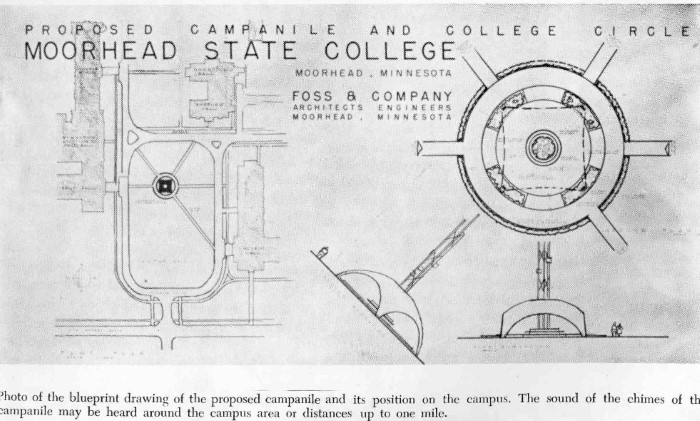
Knoblauch had suspicions, but no proof, that Shuck was involved in the 'bell tower incident.' Now, as the Spring 1958 commencement drew near, Shuck was in a mood to celebrate. One afternoon, while talking to some of the co-eds in the lounge of Ballard Hall, Shuck and his pal Dick Wicklund each drank a can of beer, leaving the empties on a window sill. It was, he later admitted, a silly act; “we were showing off for the girls.”
It was also an expensive act of bravado. For when President Knoblauch, learned of it, he notified Wicklund and Shuck that they were suspended and would not be awarded their diplomas for another year. The suspended degree cost Shuck a job offer to teach English and literature classes at Crookston High School. Having received excellent grades he soon found another place to teach and went on teaching for another four decades before retiring. Knoblauch meanwhile left MSC for another position in Illinois. But looking back in 2010 on the events of 1958, Shuck remembers Knoblauch as a “petty man" who suspended him in revenge for Shuck’s having openly criticized Knoblauch’s plan to build the bell carillon. In the end, Shuck recalled, “Knoblauch did not get his carillon, or his bells, while I got my degree, so justice was served."
So ended the 'shocking' student protest of the 1950s -- it foreshadowed a new era. Harlan Shuck taught at many schools before retiring in the 1990s. Marvel Froemming and Janet Paulsen went on to teach at Moorhead State, also retiring after long careers in education.
Arthur Knoblauch later voiced some regrets over the whole controversy. In 1968, on a return visit to the MSC campus, Knoblauch said to Yvonne Condell: “I made a lot of mistakes when I came to Moorhead (in 1955). It was my first experience as a college president and I did some things wrong.”
As for the fire, exactly how it came about remains a mystery...
Dahl Hall, the new dormitory for women students, opens. Federal student loans, provided by the newly passed National Defense Education Act (NDEA) makes it a certainty that college enrollments will grow for decade.
Arthur Knoblauch, sixth president of Moorhead State, leaves to become president of an Illinois college. John Neumaier becomes the seventh president of MSC.
John Neumaier - New President of MSC
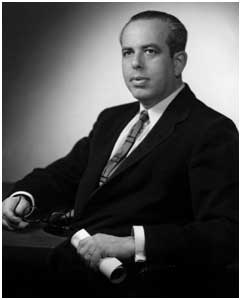
“I didn't believe in empire building. I may have all kinds of weaknesses, probably, which I would be best aware of from other people, but this [empire building] is one that I do not have. And I feel that it is this danger, when a person is associated with an institution that he or she might want to promote that institution at all cost in almost a personal sort of way. And I think that needs to be resisted for many reasons. But I did feel that it was, to put it very plainly and bluntly, undemocratic that people that were fortunate enough to be born in the cultural metropolis of Minneapolis and St. Paul [would receive greater support for education, while] the other people in the rural areas would be neglected, and that was precisely what was the case [in 1958]. I didn't necessarily mean that we should get a larger part of the pie [for financing state colleges and universities], though if necessary I was very willing to have the pie become larger. But, I did feel very strongly, still do so, that when people learn English, or biology or a foreign language, or a professional preparation, that they should learn what has to be learned and not at a second rate level. I'm afraid was not only the case, but that was accepted, and I hoped that with the kind of faculty that we were going to attract and retain, as well as with an understanding by the community of the issues involved, that we were going to change that. I think that with the help of a lot of people, that was to a significant degree changed.”
John Neumaier, reflecting in a 1987 interview, on his ideas for further developing Moorhead State College after becoming the seventh president of the college in 1958.
MSC awards degrees to 190 students at the 57th Spring Commencement ceremony; two are MS degrees in Education, the only graduate program offered. The newly printed MSC Bulletin profiles the college -- 73 college faculty, approximately 1500 students (full- and part-time), nine buildings (including the newly opened Livingston Lord Library).
Tuition is now based on credits taken; for 1960-61 is $3.50 per credit for residents of Minnesota, $5.50 per credit for out-of state residents. Housing costs $210 per quarter (for $10 extra a student can have a single room). Fees amount to $10 per quarter. "Sixteen credits is considered a typical load" of classes per quarter, 48 credits for a standard academic year. Enrollment grows to 1555 students, the largest increase to date.
John Neumaier announces that, with a 62 percent increase in full-time, on campus students, MSC is "one of the fastest growing colleges in the Upper Midwest." To deal with the number of new students, Floyd Brown, an experienced high-school counselor, joins the administration as Director of Counseling.
Asked in a campus poll if a student would pay "five dollars a quarter toward the construction of a student center," 638 say "yes," 151 say "no." Preliminary planning begins for building a student union.
Rev. James Henderson, pastor of the Moorhead Presbyterian Church, speaks at the campus Easter Convocation on the subject of the Resurrection as "A Day to Remember." He tells the students that if the Christian Resurrection does not exist, "then this world is a stupid joke."
Ada Comstock Notestein, the daughter of Moorhead pioneer Solomon Comstock, speaks at the dedication of the new Livingston Lord Library on campus. Notestein, the former president of Radcliffe College, urges women students to expand roles for women in American business and public service. Library Dedication program
MSC adopts the American College Test (ACT) as a prerequisite for admission to the College. Recommendations from high school principals are no longer necessary.
Dr. Robert Hanson, director of admissions at MSC, assures students that a standing policy "initiated during the Korean crisis of the 1950s," will grant any student "drafted into the military...full credit to all courses in which he is doing satisfactory work."
MSC faculty debate a resolution recently passed by the Western Division of the Minnesota Education Association. The MEA resolution calls for special lesson units in "patriotic anti-communism" to be taught in all Minnesota schools, grades four through twelve. The MSC faculty by a vote of 66 to 6 refuses to endorse the resolution, favoring instead classes "to further international understanding.
As the number of students enrolling in colleges continues to rise across the nation, the MSC administration issues a "Report on Facilities" which estimates that at least sixty more faculty, two more dormitories and "a humanities building" would be needed within the next seven years.
George Starcher, president of the University of North Dakota, addresses MSC students in an on-campus convocation. Emphasizing that education must now change to "free peoples' minds of stereotyped ideas," he predicts that in the future, students will insist on having more influence over the contents of their learning.
MSC awards 214 degrees at Spring Graduation exercises. Exit interview with students show that over two-thirds of the graduates have already found jobs in the booming national economy.1962 commencement program
Newly finished men's dormitory opens on campus. In the Spring it will be named Snarr Hall for MSTC president Otto Snarr (1940-55).
In 1962, the average cost of gasoline is 31 cents a gallon. Milk costs 49 cents a gallon, first-class stamps cost 4 cents, and the average cost of a new home is $18,200. Tuition at MSC holds steady, but will be raised in the fall of 1963 to $4.25 per credit.
On-campus enrollment reaches a new record -- 2129, representing 22 of the US states and 7 foreign countries. Dr. Neumaier emphasizes that MSC is becoming not just a regional Minnesota school but a widely recognized liberal arts college.
Earl Herring, assistant to the president, announces that construction of the long-anticipated student union should begin in 1964 and be completed the following year. "General plans now are that the Student Union would be built as a northern extension of the Kise Commons cafeteria."
As new junior colleges are being constructed in Minnesota, MSC President John Neumaier urges the state to develop a plan for a "Liberal Arts education" that could match the best offered anywhere else in the nation. Neumaier's Speech
MSC Academic Dean Wilbur Williams sends a memo to department chairpersons noting that soon "merit raises" in pay will be distributed to a select number of faculty. These raises "assist in the process of differentiating" between faculty on the basis of teaching performance and scholarly publication. The merit raises are welcomed by some faculty while others see them as a divisive force. Williams' Memo
President Neumaier speaks at a special joint MSC-Concordia College "memorial service in memory of John Fitzgerald Kennedy." Neumaier urges college students as graduates to honor the assassinated president by working for reforms, removing "hatred and prejudice" and promoting "social justice."
Many MSC student attend the 3rd Annual Institute on Human Rights, in which regional, national, and international scholars invited to campus discuss issues on human rights and "promotion of international understanding." Several of the students at the sessions tell Mistic reporter that they hope to join the Peace Corps after graduation. Unknown to all of them, the US military is increasing the number of "military advisors" in South Vietnam.
Leonard Inskip, columnist for Minneapolis Tribune, praises MSC administration for leadership in persuading the State Education Board to approve higher entrance requirements at all state colleges, MSC personnel have worked hard "to assemble the best teachers and the best students" and have substantially revamped its academic program to stress liberal arts.
Over 2800 students are enrolled this fall. Another new Federal program helps with the cost of college -- the College Work-Study Program.
Concerned about the growing trend to dress casually, the Student Commission adopts a rule requiring students to follow a strict dress code on Sundays, in the cafeteria. Men are required to wear "a shirt and tie, sweater or sport coat, dress slacks and oxford shoes." Women are expected to "wear dresses, nylons, and flats or heels." In addition, "girls will not be served evening meals during the week if they are not wearing "skirt, dress, or culottes." Students appear to accept the rule -- for now.
Student Patrick Day (future Dean of Instruction at St. Thomas University) pens a mocking letter to the Mistic, complaining about hours at the college library: "hows we sposed to git smart when librery don't stay open but to 9:30? Udder coleges stay open ladder -- why nut uss?"
Students Doug Johnson and Tom Bertek, presidents, respectively, of the Young Republicans (YGOP) and Young Democrats (YDFL), debate the merits of the two candidates for US president. "Barry Goldwater does not promise that if he is elected there will be something for everyone," argues Doug Johnson; "Barry Goldwater does promise to maintain the highest of character and morality." Lyndon Johnson will aid higher education, fight poverty and "keep the world in peace," replies Bertek; young people should heed Johnson's call to "ignite a fire in the breast of this land, a flaming spirit of adventure that soars beyond the ordinary and the contented and really demands greatness from our society."
Ruth Temple, writer for the Mistic, profiles older women who are taking classes at MSC -- "grandmothers, busy wives and mothers [who] return to college" to complete the "unfinished business" of getting a degree. Some of the women she interviews are there because they want a job ("nowadays it takes two to make a good living," says one), while others, having raised children, now want something more ("I think I'll be a better person for having come back," says another woman).
"Dragon Fire" columnist lauds the new movie, Hard Days Night. The Beatles on screen were "refreshing and funny because [the film] had no point to make. The film's "inane rollicking gambol" gave viewers a "healthy sense of silliness" in "an age of anxiety."
US Representative Clark MacGregor (R-Minnesota) visits MSC campus and speaks on foreign policy. MacGregor, a veteran of the OSS in World War II, hopes Johnson will take steps to win the support of "villagers in Southeast Asia," without whom he cannot succeed in stabilizing the region.
Larry Scott, MSC sports editor lauds "Spring, [when] a young man's fancy turns to baseball." Profiles and photographs of the 12 new and recently remodeled buildings are displayed on campus, including the recently built Dahl, Snarr, Hagen and Nemzek buildings. Another new women's dorm (Grantham Hall) will open in the fall, and groundbreaking has begun for the new Center for the Arts.
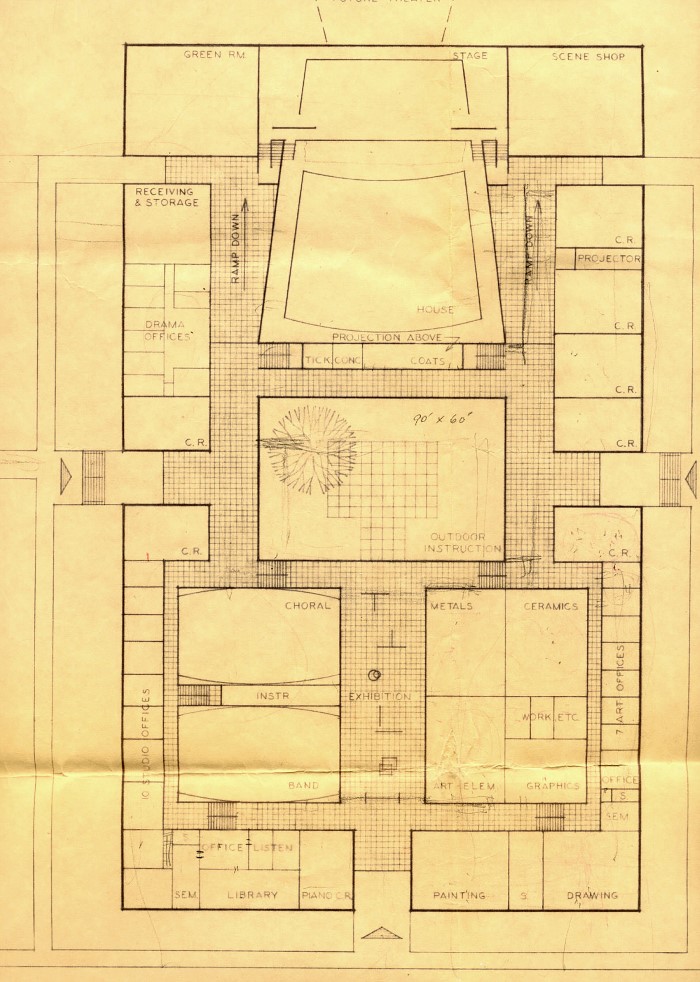
New guidelines at North Dakota State University will permit MSC students to take part in NDSU's 2-year Reserve Officer Training programs (ROTC). Both the Air Force and Army programs "have vacancies for their second period of training."
NDSU, MSC and Carleton College professors hold a teach-in on Southeast Asia on the NDSU campus. MSC Professor Feld (Political Science) will take part in the teach-in and invites students to attend and "become better informed about the Viet Nam War."
MSC announces that Walter Mondale, recently appointed by the Governor of Minnesota to complete the US Senate term of Hubert H. Humphrey (now the Vice-president of the US), will speak at the upcoming graduation. Senator Mondale's subject will be "American Education."
State Board of Education approves the addition of three new Masters degree programs for MSC -- MA in English, MA in Music, MS in Biology are added to the MS in Education. Academic Dean Maurice Townsend stresses in his announcement that enrollment for these new degrees will be limited and "entrance requirements will be high." 1966-1967 requirements for obtaining a graduate degree.
With a growing number of students entering college from rural areas, the Federal Educational Opportunity Grant Program (EOG) provides low-cost grants (not loans) to families who have limited finances. Student activity fees now contribute over $100,000 to campus activities, about a quarter of which is used in athletics, the remainder on the Performing Arts Series, Homecoming, campus radio, etc. Over 3300 students are now at MSC.
Denying the widely held belief that MSC students are "apathetic" in regard to national issues, a student writes that she has friends who are "currently establishing an SDS [Students for a Democratic Society] movement on campus" -- "my friends are not apathetic, I am not apathetic."
The US Congress passes the Higher Education Act, which devotes more Federal funding to to colleges and universities and offers low-cost loans to prospective college students.
Pianist Charles Rosen performs in Weld Hall, in one of the first offerings of MSC's new Performing Arts Series.
Dr. Yvonne Condell, MSC biology instructor, is named to "Who's Who in America."
The Young Democrats host a panel discussion at the Library on the topic "Pre-Marital Sex and Birth Control."
Dr. O. J. Hagen, former College Director and noted physician (for whom Hagen Hall was named) dies in Fargo at age 93. Hagen's late wife, Moselle Weld Hagen, was the daughter of Dr. Frank Weld, second president of Moorhead State.
After a lengthy open forum on campus, in which all facets of the military situation in Vietnam were discussed by faculty and students, MSC students vote three to one in favor of "the current US policy."
The MSC College Administration develops plans for facilities and programs based on the estimate that 7500 students will be enrolled annually in classes within ten years.
The staff of the Mistic reprints a column from the student newspaper of the University of Cincinnati; the column advocates the right of students to "have a voice in evaluating their professors" through an independent system of ratings and comments.
Male students are informed that "Selective Service Officials" of the Federal Selective Service system have decided to use "a testing system" to employ "a testing system as a guide for local draft boards in granting student deferments." State directors of the Selective Service expect to have 35,000 students take the achievement test in the coming weeks, so that "students with low grades will know that they might be drafted in the coming summer." Over 200,000 US military personnel are now stationed in Vietnam; the majority are draftees.
Two major debates are argued on campus -- should MSC require more PhDs from its faculty; should the Students for a Democratic Society (SDS) be granted a charter as a recognized student organization. Opinions are divided among faculty and students. But virtually everyone agrees -- MSC needs more parking!
Maurice Townsend, dean of MSC, accepts a position in California. Roland Dille, associate dean of the college, is named dean.
After much debate, SDS is granted a charter as a student organization. SDS hosts "Bitch-In" soon after to call for formal student evaluations of faculty, and the right of "two consenting adults to live together" even if it violates local law. President's Letter of Recognition
Cal Olson, reporter for the Fargo Forum, speaks on campus of his four week visit to Vietnam, reports that most Minnesota-North Dakota soldiers he talked to in Vietnam favor the US presence there.
As construction of the new student union continues, 377 students graduate.
Enrollment now exceeds 3800. Dr. Neumaier addresses 1200 students at the opening academic convocation, stressing that a major focus in the coming year should be on "respect for the dignity of individual human beings regardless of color, place of birth, economic position, cultural origin or spiritual commitment." In the next several months, MSC officials begin designing a plan for providing scholarships to recruit more minority students at MSC.
MSC music department announces that the college choir will undertake "for the first time" a performance tour in Europe. Recordings of the choir's on-campus performances will be sold to help pay tour expenses.
MSC faculty now numbers a record high of 63 professors, representing almost all of the fifty US states, and eleven foreign countries. Increasing numbers of faculty hold PhDs, one has been a Rhodes scholar and four others -- including Dr. Philip Seitz, chair of Art, -- have taught abroad as Fulbright scholars.
Clarence "Soc" Glasrud (class of 1934 and faculty in English) is named "Alumni King" by MSC Alumni Association. Glasrud is happy to accept the award "so long as there is no committee work involved."
MSC football team completes season with 6-3 record, new records for offensive yards and scoring, and its first Northern Intercollegiate Conference title since 1952.
34 MSC students are named to Who's Who Among Students in American Universities and Colleges.
Dr. Otto Snarr, former president of Moorhead State Teachers College (1940-55) dies in his native West Virginia, at age 80.
International students presently taking classes at MSC are profiled in the Mistic. Most are from Western European nations, with a small number from Asia and Africa. One student praises quality of classes but feels her native Canada has more freedom -- "drinking is not prohibited at dances at home."
Robert Short, author of the best-selling "Gospel According to Peanuts," speaks at Performing Arts program.
Because the US Congress has reduced funding for the National Defense Student Loan Program, financial aid officer David Anderson warns that money for summer school classes may be "tight."
A busy month, that includes Peace Corps recruitment on campus and the announcement that Roland Dille is assuming the duties of Dean of the College, concludes when the Center for the Arts is dedicated on the campus.
Concerned about the small number of minority students enrolled at MSC, President John Neumaier begins discussions with citizens' groups, the Urban League and the United Negro College Fund for the purpose of creating a special effort to recruit students of color. The plan will tentatively be called "Project E-Quality."
With work on the student union (attached to Kise Dining Hall) nearing completion, the building will be dedicated as the "Comstock Memorial Union," in honor of the Comstock family, whose members had donated the land for the college in 1887.
The April Fools issue of the "MSC Misfit" runs plan for the new "low-hole" dorm, an eighty-foot deep, "simple hole in the ground." The dorm's main features -- easy to cool in winter, and, in case of fire, "just open a hydrant and the building will fill with water." Total cost of construction, "less than $1000, if dogs help with the digging."
Two weeks after the Mistic suggests protestors should be expelled, MSC student Linda McDonnell urges students to attend speech by US Vice-president Hubert Humphrey to "demonstrate our opposition to US policies in Vietnam."
Over 425 seniors graduate at commencement exercises.
Enrollment now passes 4000. Clay County Sheriff's department states that their deputies will begin "increased monitoring" of "keg parties;" says one deputy, "I don't like to raid kids' parties because I was a kid too once. But if I get a call from some angry farmer saying there's a bunch of kids out in his field whooping it up, I have to protect his rights." Local law enforcement is also increasingly concerned about use of illegal drugs.
"The Browser Bookshop" opens in Moorhead, featuring paperback books and the community's first large collection of "psychedelic prints and posters."
Of those who respond to a nation-wide poll, forty-six percent express "doubt" that the US military can achieve a "major victory" in Vietnam. A Mistic editorial that same week believes the recent protest held at the Pentagon "threatens" the nation's "international stature."
SDS campus organization requests that Marine Corps recruiters be banned from campus, and professors sponsor a panel discussion on Vietnam. A far larger audience attends the "Psychedelic Fashion" show at the Student Union.
Eugene McCarthy, US Senator for Minnesota, says that he will challenge President Lyndon Johnson for the Democratic Party nomination; he plans to make withdrawal from Vietnam the central point of his campaign. Johnson has recently been told by US military commanders that, despite the presence of over 500,000 US troops in Vietnam, an "indefinite" stalemate is likely.
At MSC, President John Neumaier submits his resignation, to accept a job in New York. In Vietnam, the Tet Offensive increases opposition to the US presence in Vietnam.
After considerable debate, the Council on Student Affairs votes to reject a resolution to ban military and other Federal government recruiters from campus. The resolution was offered by Dr. Edward Estes (Political Science) in response to a proposal by the US Selective Service to draft anti-war "students because of their political views."
Political and social difference emerge during the Student Senate elections; one candidate denies having suggested that "John Neumaier and [Joe] Bernick are members of a subversive Jewish organization," or saying that Bernick "hates all Christians." Bernick is defeated in the subsequent election.
When Martin Luther King is assassinated in Memphis, black students on campus vow to "fight [King's] fight" for social and racial justice. President Neumaier, in one of his last speeches before departing for New York, calls for an end to "apartheid in America, which is practiced even by some of us at Moorhead State College." Neumaier leaves MSC for a college presidency in New York; enrollment under his tenure grew from 1100 to just over 5000 in 1968.
Roland Dille becomes the eighth president of Moorhead State. Presidential candidates McCarthy, Robert Kennedy and Richard Nixon campaign in Fargo-Moorhead. Commencement closes out a tumultuous academic year.
Robert Kennedy is assassinated in Los Angeles; MSC students witness upheavals in Chicago as Hubert Humphrey is nominated by the Democratic Party for the presidency.
Classes begin; Joe Bernick takes position as the editor of the Mistic. Roland Dille admonishes the newspaper for quoting obscenities used by student protestors and police at the Chicago Democratic Party convention.
Project E-Quality begins when 50 minority students enroll for classes.
Project E-Quality: 1968-74
In the 1950s, as the civil rights movement grew exponentially in the American South, it was considered a remote concern in places like Fargo-Moorhead, where a minority population barely existed. Still, the idea of true equality for all peoples was evolving in the country’s more progressive institutions, including colleges and universities. The idea geminated at Moorhead State College in early 1968, when, out of a total population of 4,200 students, only seven African Americans, sixteen Native Americans, five Mexican Americans, and forty foreign students were in the school’s classrooms.
The mainspring of the plan to enroll more minorities was driven by President John Neumaier, whose strong desire to combat prejudice and promote universal equality was born in his memories of being a Jewish refugee from Nazi Germany. With a group of advisors drawn from the administration, faculty and a few community leaders, Neumaier drew a recruitment plan that was called “Project E-Quality,” a program designed not only to enroll minority students but provide financial and emotional support to them during their time at MSC.
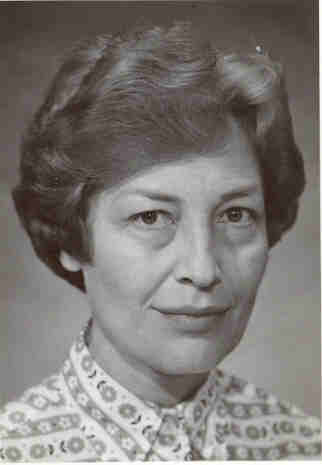
The initial reception to the program was not necessarily popular; several business leaders in Moorhead voiced concern that this would not help the school or the community. But Neumaier took the issue very seriously, insisting that “we can no longer afford to insulate ourselves and our students from what will very likely be a dominating challenge to moral and social leadership in America for the rest of our lives.” Moreover, he regarded the project as beneficial not only to the minority students recruited, but to traditional students (and faculty), who could learn about inequality.
Project E-Quality (nicknamed E-Q) enrolled several students with small scholarships in the Fall 1968 semester. Funding for the scholarships was raised by donations from faculty members and administrators (including Neumaier and Roland Dille), the Student Senate, the Alumni Association, local churches, the local American Legion, and various citizens in Moorhead and Fargo. By March 1969, a total of $17,600 had been raised for the program.
Project director Lois C. Selberg stated that the initial goals for the semester were to provide opportunity to those whose “poverty, class, environment, and color” had made a college education nearly impossible to attain; to provide an opportunity for white students who lacked understanding of minority groups to interact with minorities on a face-to-face basis; and to stimulate education on race relations within a community.
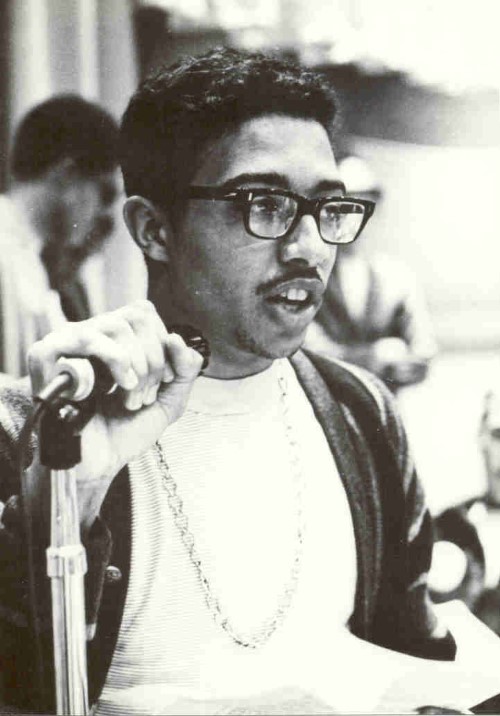
Fifty students were initially admitted to the program: 35 African Americans, eight Native Americans, and seven Mexican Americans. Some faculty volunteered time to provide tutoring to help students excel in classes. Seminars and discussion panels were created in an effort to educate people about minority groups. A Cultural Exchange Center was established as a social site.
But while Project E-Q was succeeding in the classroom, it sparked controversy in the larger community – with some complaining that the funding and extra tutoring constituted “discrimination against the local students who received no such attention.” As more minority students came to the campus, some white students expressed fear for their safety. One student complained that had he been “born colored living in a Minneapolis ghetto” he could have received his education for free. A group of community leaders complained to the Student Senate president about the group’s support of E-Q, and the Fargo Forum denounced the “importation of 150 Negro freshmen.”
Tensions grew into an ugly confrontation on April 17, 1969 in the lobby of Snarr Hall, when a disagreement over a pizza delivery resulted in six black students and about twenty white students nearly came to blows. One of the black students produced a pistol and fired a blank cartridge toward the floor to clear the room. The confrontation was over, but the following day, three of the black students were arrested and charged with aggravated assault; they were initially sentenced to jail terms but, because the pistol had contained no live ammunition, the sentences were suspended.
A second incident occurred soon after when a black student was shot at four times while driving in the community after a date with a white female. He was not injured, but the incidents raised the issue of safety for the minority students. At a subsequent meeting with administrators they discussed multiple incidents in which they felt threatened by other students. Fortunately, tensions cooled after the second incident.
In the end, the possible violence was surpassed by the success of the program. Twenty-two of the original fifty E-Q students graduated in 1972 (MSC’s overall student graduation rate after four years was 50% at the time), and an additional fifteen left after their first two years for jobs or other schools. Roland Dille, by then the president of MSC, could rightfully say that these brave students had endured adversity to obtain the college education that would have eluded them without the program. In 1974, Project E-Quality was absorbed into the Office of Student Activities; by then it was no longer needed -- it had laid the groundwork for greater diversity, not only at Moorhead State, but in the F-M community. It was the combined effort of the students as well as the effectiveness of the various Project E-Quality programs that led to its success. “Given a chance to confront human beings on human terms,” remarked one student after attending a Project E-Quality seminar, “color ends, people begin.”
Student poll shows slim majority for Nixon as next president. The Student Senate asks the Registrar's office to stop sending grades and other information to local draft boards.
As Nixon wins in a close election, a candidate for Student Senate stirs debate by claiming that students who do not seek to "place limits" on college authority are "subservient."
By a unanimous vote, the Student Senate recommends abolishing curfews on women students (only those juniors and seniors age 21 or older were exempt from late-night curfews). The Senate deadlocks on a resolution to name the newest dorm "Malcolm X Hall."
Mistic mockingly congratulates Concordia College for permitting dances on campus after a two-year campaign by Concordia students; paper also chides president and Faculty Senate for interfering with "press freedom." Complaining that the newspaper "does not represent the majority of students," Iota Alpha fraternity burns copies of the Mistic in protest.
Students learn that state government may mandate an increase in tuition and dormitory expenses for 1969-70.
Students from all local colleges turn out to stack sandbags as Red River floods following a cold, wet winter.
School year ends amidst controversies: an incident between white students and black students threatens Project E-Quality (see September 1968 to read more about Project E-Q); Mistic publication is suspended over censorship; and "Zip to Zap" makes national news.
Zip to Zap
by Corinne Edgerton
The music festival at Woodstock would captivate the nation in August of 1969. But before Woodstock, there was “Zip to Zap,” the only time that the state of North Dakota used National Guard troops to “quell a riot.” During a time of war, and racial, political, and social upheaval, college students across the United States, students rebelled and demonstrated against authority, and traditional norms of society. North Dakota's residents, remote from the big cities of the east and west coasts, saw themselves as living in a safe haven, free from such foolishness as protests. That perception changed, when the “Grand Festival of Light and Love” began as a hastily planned music and beer festival in May, 1969 in Zap, North Dakota.
The Zap festival idea originated when Chick Stroup, 1969 NDSU Student Body President, complained that few NDSU students could afford a “spring break” in Florida. The NDSU student newspaper, the Spectrum, edited by Kevin Carvell responded with an half-joking article that suggested a “Zip to Zap.” It commented on Zap’s central location in the valley of Knife River and its eager welcome of students from all over the Midwest. Carvell claimed Zap could become the “Lauderdale of the North.” The Spectrum printed classified ads for the festival that stated: “We’ll find it in Zap” (February 13, 1969), “Drink the Bars dry in Zap, May 10” (March 20, 1969), and “Glorious Festival of Life and Love (translation: Big Orgy) will be Celebrated May 10 in Zap!” (April 3, 1969). Not only did the campus newspaper promote the Zip to Zap festival, but so did the businessmen town of Zap, who hastened to turn the concept into profits. Located in rural Mercer County, Zap had a small population of about 350. According to city Mayor Norman Fuchs, “We thought, well, we’ll put ourselves on the map here.” Therefore, the town bars began to stock up on beer and the local grills hyped “zapburgers.”
Students, responding to the ads, began pouring in Zap on Friday night, May 9. Eager to began their festivities, they were disappointed to find no live music and only a handful of amenities. Zap had two bars and one local café and could not sustain the desires of some 2,000 students. Fights ensued when one bar owner decided to double the price of beer. Poor organization and no prior attention to crowd control led to a rowdy beer bash, several brawls, and a call for help to “suppress a riot.” As the sun fell and temperatures dropped below freezing, students built a bonfire on Main Street with lumber from an abandoned building. The town now had to deal with drunken students wandering the streets, urinating in public, and collapsing in odd corners to sleep it off. The mayor soon called Governor Bill Guy who in turn sent 500 National Guard troops to clear the town. The troop’s commander wisely ordered his men to use minimum force. Forewarned of the troop movement, many students left town quickly and by the time the guard arrived no more than 200 students could be found out on the streets. The next day was spent in getting the exhausted, hung over youth on the road.
"Zip to Zap" quickly became a story for national TV, but after Kent State and Woodstock, it was a blip on the news radar, and made no political statement of any kind. Its aim had been to give students an affordable, good time and the local Zap merchants a boost in profits. Zip to Zap went down in North Dakota history as the only time the National Guard was used to settle a “riot” – but to those who were there it is mostly remembered as a silly lark.
Quotes above, from Richard Shafer, “Spinning the Zip to Zap: Student Journalist Responsibility and Vulnerability in the Late 1960s.” in the The North Dakota Journal of Speech & Theatre, vol. 13 (2000).
Enrollment now tops 5200. The new fall quarter begins with planting of the reconciliation "Tree of Life," a committee is established to review ROTC presence on campus, and publication of the "Independent Mystic" (off campus). The Tri-College University agreement permits students of MSC, Concordia, and NDSU to enroll at classes in the three institutions without paying extra tuition costs.
Community members meet in Moorhead to sign the "Articles of Incorporation" for the Moorhead State College Foundation, the purpose of which to raise funds from private donors "for the benefit of Moorhead State College." In coming years the Foundation will help fund scholarships, arts events, and the building of the Regional Science Center.
The faculty having agreed to be evaluated (for the first time) by the students, one-page evaluations of faculty teaching are to be carried out at end of winter quarter. The Mystic (established off-campus as a student newspaper to replace the suspended Mistic) praises this long-sought accomplishment.
The nation is stunned on May 4 by the incident at Kent State University (Ohio) when national guard troops fired on protesting students, killing four and crippling others. MSC is one of the few campuses to hold a memorial service to commemorate not only the Kent State victims, but also two African-Americans killed at Jackson State College (Mississippi) where state police fired on a protest there on May 14. A moratorium is then called at MSC, suspending normal classes and effectively ending the spring term -- some students attend Vietnam-related teach-ins, others leave for an early summer break.
In 1970, three new buildings were completed and opened on campus: Murray Commons (planned as a second dining hall for a growing student body; a new, fifteen-story dormitory (to be Neumaier Hall); and King Biology Hall. In administrative changes, Don Engberg is named Registrar and will supervise the transformation of student record keeping from a paper to a computerized system.
Classes begin and Abbie Hoffman (of the "Chicago Seven") speaks at MSC on invitation from students. Hoffman entertains (and offends) his audience, making jokes about "farmer bumpkin protestors." The Mystic notes that many "walked out on Hoffman," and that his issuing a call for "Up against the wheat-fields" might gain few converts to a "new revolution ...much of the audience seemed bored."
Incoming fresh-women are encouraged by upper classmen to note the "policy allowing the parents of freshmen daughters to determine the hours that the student should keep" by obtaining "written parental consent to determine her own hours" when coming and going in dorms.
A delegation of MSC students meet with Moorhead police to discuss recent "drug raids" and other incidents in which citizens' rights may have been violated. A more minor scandal is exposed when a student reveals the existence of a comprehensive "midterms and finals file" used by MSC students to cheat on exams.
President Dille sends an "olive branch" letter to the Independent Mystic -- "every week has its tensions, but every day presents us with opportunities for victories of communication and rational discussion" in the changing educational mission of the college. Read Dille's letter.
Discussions and studies are undertaken through 1970 on the subject of alcohol use on campus. Three options are considered -- seek to gain permission to allow on-campus students, 21 and older, to use alcohol in their rooms; gain permission to open a campus; retain the current rules barring alcohol use on campus, with more lenient penalties for violations.
Activist student Tim Madigan, claiming to represent the "Conspiracy to Take Advantage of Technicalities," charges that MSC students who are members of the ROTC program violate the student conduct code by having firearms on campus. Pressure to ban all ROTC activities at MSC (and other colleges) has grown since the Kent State incident in 1970.
Large numbers of students worry about the announced raise in tuition cost for the next academic year -- rising 25% from $6.25 per credit to $8 per credit.
John Sherman, professor of English, gives lectures on "Women in the Workplace," noting that women are "treated as commodities" in jobs where "conditions are lousy, women are not protected from harassment and they still are badly paid." This is true for colleges and universities as well as mainstream businesses, he notes.
About 125 students rally on campus to protest the presence of US troops in Laos. Noting the small numbers in the protest, and the increasing withdrawal of US troops in Vietnam, a "conservative student" predicts that "radical chic" politics is "losing its appeal." The decline in the military draft is mirrored in a nationwide drop in college enrollments.
The MSC Intra-Resident Hall Council, in an ongoing effort to change dormitory regulations and end curfews for women, begin to sell "birth control handbooks" to students and campus organizations at cost -- 8-and-a-half cents per copy.
Outgoing Student Senate President Tom Clark admits that he is glad to see his term end. "As MSC's first non-Greek [fraternity-backed] president, I'm glad it's over," because trying to effect change is very hard when most of the "student body are basically an unconcerned bunch of people."
After trying several expedients to continue publishing, including a short-lived attempt to merge with editing staff at North Dakota State University, the editors of the Independent Mystic announce the last issue of the newspaper, due to financial difficulties.
The last class graduates at the MSC Campus High School. The elementary campus school will not accept more students and plans to close in June 1972, with some teachers assigned to new duties.
"Moorhead State College has an on-campus, student-subsidized newspaper for the first time since the spring of 1969" -- the first story in the Moorhead State Advocate. The new editorial staff pledge to act as a voice "for many voices," and to "strive to see both sides of an issue."
MSC sophomore Rochelle Callendar is named "Miss Black Minnesota" in St. Paul pageant. The prizes for winning include a $500 scholarship.
The new Olympic-size swimming pool opens at Nemzek Field House.
Student group urges making the Memorial Union a "smoke-free" building.
Following a series of surveys carried out with students on the question of permitting co-educational dormitories, discussions begin on how such dorms would be organized and administered. Consistent survey results showed that about one third of women on campus opposed co-ed dorms, about 90% of men favored such dorms.
Livonia ("Ma") Jackson, who had worked at Moorhead State for some 40 years, as cook and unofficial housemother for members of the Owls fraternity, passes away at age 74.
Construction of the planetarium in Bridges Hall is nearing completion.
Students begin a month-long campaign to convince the members of the Democratic Farmer-Labor Party (7th District) to pass a resolution supporting an amnesty for those who have resisted the military draft, but the campaign fails when the draft resolution is tabled at the DLF district caucus.
One of the last major anti-war rallies when 500 students protest US blockade of North Vietnam by marching through Moorhead to the Red River bridges, chanting "no more war" and handing out anti-war leaflets on the bridges. Some drivers (and other students) mock the marchers, but other drivers "wave the peace sign."
The Minnesota Legislature amends the Public Employee Labor Relations Act (PELRA), granting all state employees the right to join a union. As a result, the Inter-Faculty Organization (IFO), a multi-college lobbying group in existence since the 1960s, is organized as a union representing all state university faculty. Negotiations for bi-annual contracts.
Classes begin at the MSC New Center (in Murray Commons), an "experimental, post-secondary educational option offering students individualized, cross-disciplinary options" for earning an Associate Arts degree.
As students age 18 to 20 register to vote in local and national elections, actress Shirley MacLaine campaigns in Fargo-Moorhead on behalf of Democratic presidential candidate George McGovern.
The college, in collaboration with the history department, establishes the Northwest Minnesota Historical Center, which is charged with the dual mission of training history students and preserving information concerning the history and culture of the Red River Valley.
Although a poll suggests that more MSC voted for McGovern, Nixon is re-elected in a landslide (winning majorities in 49 of the 50 states). As he prepares for a second term, Nixon faces questions about the Watergate break-in.
Classes begin and several students take courses in the new American Studies major.
With state revenue strained by rising energy costs and inflation, all state colleges, including MSC, are faced with the "certainty" that tuition will be increased and some faculty and staff will be laid off.
Dorm RAs admit that they are "reluctant" to report violations of "alcohol and pot use" if "the rights of others are not being infringed upon."
As final exams loom, many Moorhead State students seek a break by attending George Carlin's appearance at NDSU.
After more than 800 students receive degrees in Spring Commencement, nearly three dozen faculty at MSC are informed that they will not be employed in the next fiscal year, due to revenue shortfall.
MSC hosts its first "Old Fashion 4th of July" celebration, which is attended by over 1000 area residents. The celebration improves campus-community relations and becomes a tradition.
Fall classes begin and Minnesota State College System Chancellor Theodore Mitau reminds students that "there are no perfect solutions in dealing with the many, very tough issues" that higher education is now wrestling with -- alcohol use, co-ed habitation, collective bargaining with faculty and staff, affirmative action, women's rights, and rising costs. Mitau predicts that "frustrations will continue" as these issues are debated.
MSC unveils the new "College Constitution" under which the school is administrated. Another new Federal law, the Family Educational Rights and Privacy Act (FERPA) will now change the ways in which a student's grades and college record are made available to parents and employers.
In retaliation for US support of Israel during the Yom Kippur War, Middle East nations embargo oil exports until March 1974. The price of gasoline and fuel oil quadruples -- from $12 per barrel to $75. The ensuing inflation greatly increases the cost of college educations.
Enrollment at MSC has declined for the first time in many years -- about 4%, the registrar notes, from Fall count of students.
Student Senate passes resolution favoring impeachment of Richard Nixon for the Watergate cover-up.
Despite tight budgets, new equipment in the MSC TV Center (Weld Hall) is used to train students in modern telecommunications.
MSC Placement Director Werner Brand notes that the high price of gasoline has decreased the number of job recruiters on campus, especially among schools seeking new teachers.
"Streaking" craze reaches MSC campus.
MSC grants tenure to 14 professors, decline it to 4 others because of "budget difficulties."
Because of higher interest rates, new graduates face greater challenges in repaying student loans. Annual expenses now range from $2000 to $2400 if a student "lives on campus."
"I have never been a quitter. To leave office before my term is completed is abhorrent to every instinct in my body. But as President, I must put the interest of America first. . . .Therefore, I shall resign the Presidency effective at noon tomorrow." -- Richard Nixon, 8/8/74.
The administration assures students that the school has sufficient fuel oil for even a "harsh winter." In addition, lawsuits filed across the state challenge the regulation that freshmen are required to live on campus.
Overall enrollment in the state college system declines for the second straight year, to 4700, with rising costs being the main reason why fewer students are choosing college.
24 women in the MSC faculty file suit, claiming that the college is violating the Equal Pay Act by paying women lower salaries for the same work load as that given to male faculty.
Garrison Keillor's "Prairie Home Companion," a new show (debuting in 1973) with rising popularity, airs an episode that was taped in Moorhead two weeks earlier; popular movies among the students this month -- The Longest Yard, starring Burt Reynolds, Death Wish, starring Charles Bronson, and Benji, starring a dog.
State College Board considers ordering colleges to drop majors that have "low enrollment" for cost of operation, raising fears that this would lead to further layoffs. In better news, regulation requiring freshmen to live on campus is repealed.
After consuming a record 819,000 gallons for heating oil in 1974, MSC Vice President of Administrative Affairs issues an energy conservation plan for 1975.
Advocate publishes series of articles on Moorhead State history, to mark 90th anniversary of founding of the college in 1885. College holds official celebration at local Ramada Inn (where many students can legally buy alcohol).
MSU New Center is featured at national Change in Liberal Education (CILE) conference.
MSU administration announces that tuition reciprocity with North Dakota, and another tuition increase, are "virtually assured" outcomes of the current Minnesota legislative session.
As a result of actions taken by the Minnesota legislature, all state colleges become universities. Moorhead State University officially marks the occasion on August 1. Read the commemoration speech.
Classes begin with overcrowded dorms, where some sleep in lounge areas while room repairs are completed. Thanks to a tuition reciprocity agreement with North Dakota, NDSU students can more easily attend MSU classes.
Campus wrestles with how the Minnesota Clean Indoor Air Act should be enforced in classrooms, dorms, etc.
Advocate profiles Diane Hitterdal, first female officer in the Moorhead Police Department; editor asks, why are there no female security personnel at University? See essay on women at MSU during the 1970s below.
Women in the 1970s: Steps Toward Liberation
“In almost every professional field, in business and in the arts and sciences, women are still treated as second-class citizens. It would be a great service to tell girls who plan to work in society to expect this subtle, uncomfortable discrimination--tell them not to be quiet, and hope it will go away, but fight it. A girl should not expect special privileges because of her sex, but neither should she adjust to prejudice and discrimination” When Betty Friedan wrote these words in the early 1960s, the women taking classes at Moorhead State College made up just over half of the student body. And it was taken as given that at least a third of them would quit school before graduating, because they would marry one of their classmates and soon become stay-at-home mothers. When Friedan published her seminal book, The Feminist Mystique, in 1963, most of the women who did graduate at Moorhead State had majored in either elementary education, or in English, music or another humanities-related field. Very few majored in one of the hard sciences or mathematics; almost none planned to seek post-graduate work in medicine (as doctors), law, engineering or business.
The women who came to the campus in 1963, were formally considered as “children,” because the tradition of in loco parentis was enshrined in decades of detailed regulations that “protected and sheltered” the “girls” in rigidly segregated dormitories -- a curfew set at 10:00 PM mandated that the women were locked in; male students were under no restrictions in such matters. Not until 1967 did the college administration concede to allow female students 21 or older unrestricted hours. It was not until several years later that college swimming classes were integrated to permit both men and women into the pool at the same time.
Did this pattern of subordination grate on the women? Certainly; scores of Moorhead State alumnae have attested how much they resented such restrictions – and how frequently they found ways to evade them. The formal rules changed only slowly, but the pressure from women to change them was persistent. In 1968, after a number of the female students threatened to transfer to another college, the college agreed that a women who was turning 20 could have unrestricted hours as long as her parents gave approval to the Dean of Women. This proved an unsatisfactory concession, and a year later the universal policy became that all non-freshmen, or freshmen older than 19, had unrestricted hours, and freshmen were exempt from restrictions with parental permission.
In 1970 when the MSC campus, concerned about its recruitment (in light of the forthcoming changes in the military draft that would eliminate student deferments) introduced a far-more provocative change -- co-ed dorms. A new “under the same roof ” policy was announced, which meant that, in selected dorms, men and women could live either on the same floor in alternating rooms or in separate wings of the same dormitory.
1970 was also the year that a campus Women’s Liberation student organization was formed. The group held weekly meetings in the Student Senate Conference Room, raised funds with which to distribute information on birth control, and organized a protest against the Queen of Hearts contest, which had been held each year for Valentine’s Day. To mark International Women’s Day that year, women on campus held workshops concerning the inequity of wages for American women and called for efforts “to gain civil rights for ourselves.”
The reaction of the college toward this new activism was mixed. Many male students either ignored the issues raised in these efforts or made fun of them. The administration supported the women’s right to speak out, but also shied away from being involved in what was becoming the single most controversial issue – abortion. The right of women to choose to have children was by the 70s a priority issue in the women’s rights movement. In February 1971, the Student Senate sent a telegram to Minnesota Governor Wendell Anderson and the state legislature. The telegram voiced support for a pending legislative bill, the Minnesota Abortion Neutrality Act, which would make termination of a pregnancy a confidential decision made between a woman and her doctor. State law in 1971 made abortion legal only when it was, in a physician’s opinion, “necessary” to save the woman’s life. After considerable debate the Abortion Neutrality bill was voted down.
But across the state, women still supported the right to choose. At MSC, abortion rights, as well as birth control, venereal disease, and breast cancer, were discussed at workshops held at the college Health Center. The Health Center provided free pap tests by early 1972. Tests for uterine cancer, syphilis and gonorrhea tests, and prescriptions for birth control pills came later. In 1973, when the Supreme Court decision in Roe v. Wade made abortion a legal right, the Health Center began offering abortion counseling.
A major landmark for women students was the development of the women's studies classes at the college, in 1971. After a women's studies class was offered by the Humanities Department, in response to student demand, two members of the faculty, Mildred Treumann and Sylvia Kruger, developed the program as a minor. The Women's Studies minor at Moorhead State was the first such program in the Upper Midwest.
Political equality proved harder to attain than sexual equality or educationally equality. Prior to the 70s, women had held virtually no major offices in student government. In September 1971, the Student Senate did appoint two women, Darby Arntson and Renee Wald, to the vacant posts for the arts departments and the representative at-large. Then in February 1973, after a strenuous campaign, Deborah Zitzow was elected as the first women president of the Student Senate.
Women also gained ground in print journalism, with more positions as writers for the Moorhead Independent News and then the Advocate. But it took longer for broadcast positions – the argument that women had “poor broadcasting voices” had held sway for many years, until May of 1973. KMSC manager, David Friend, accepted five women as announcers for spring programming. Cathi Legueri opened one of her first Saturday morning shows by saying, “I’m just like one of the boys at the station!”
By the mid-70s, more women were majoring in mathematics and the hard sciences. When Diane Polman graduated in 1976 as the first woman from MSU with a major in manual arts therapy, she offered a remark that spoke for all those who had dared to enter a male dominated program, saying that by taking industrial education classes, she had “scared” male students because they “didn’t want to be out-done.” 78 women's volleyball.
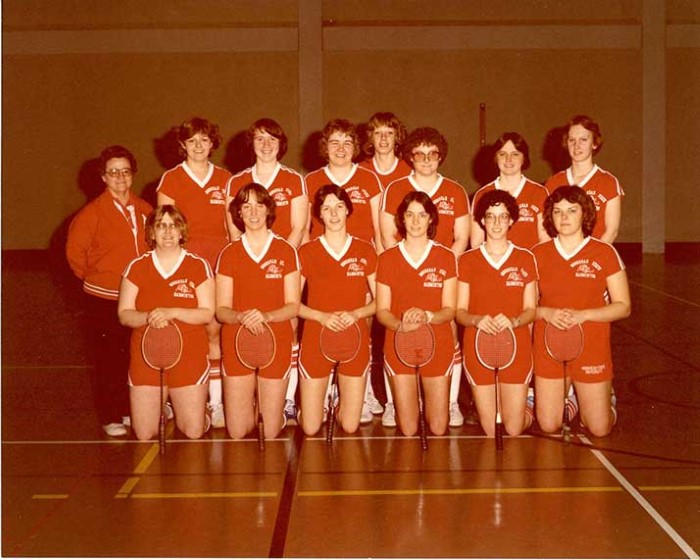
The battles for equity in women’s athletics were just beginning in the 1970s. In 1972, the Minn-Kota Women’s Conference became officially recognized by the Association for Intercollegiate Athletics for Women. Moorhead State College, Bemidji State, Concordia, North Dakota State University, University of North Dakota, Valley City State, Mayville State, and the University of Minnesota-Morris composed the new conference schools. The sports available to women at that time were field hockey, volleyball, basketball, gymnastics, badminton, tennis, golf, and track and field. It would take years before women’s sports received anything like equal attention in the newspapers of these colleges.
In March 1974, MSC hosted the important North Central Intramural and Recreation Association Convention. Dr. Ellen Gerber, the keynote speaker, called for “sports for all,” that schools must provide not only sports but facilities, leadership, budget, and money for women. Dr. Gerber noted that thanks to the Federal Educational Amendment Act in 1972, women’s athletics finally had the law on its side. But it was not until 1975 that the Minnesota Legislature put some real money on the table, bowing to the regulations of the Federal law (popularly known as Title IX). When the legislators voted special funding for the Women’s athletic departments of the Minnesota colleges and universities, Moorhead State received some $45,000 from these funds. The amount served to lay the groundwork for serious recognition of women’s athletics.
MSU President Dille meets with Fargo-Moorhead Metropolitan Council to discuss future needs for off-campus housing for the growing number of off-campus students, older-than-average and married students.
The "bicentennial year" begins with sub-zero temperatures, heavy snows, and an ongoing study of how MSU can provide more parking.
The MSU Health Center is renamed Hendrix Health, in honor of Noble Hendrix, who as Dean of Students, modernized the health services in the 1960s.
Serious planning begins to implement the Title IX changes in athletics. First planning document for Title IX at MSU
Advocate publishes feature articles on Title IX issues.
MSU baseball team ends season with a disappointing 2-12 conference record. Rising costs of sports equipment, travel and expenses are being raised about the future of some team sports at MSU.
Although the budget remains tight, MSU begins fall classes with rising enrollment, dorms fully occupied, a victory over Concordia College in their annual football game -- and the annual complaint that the school sells "more parking permits than there are spaces for parking" (permits are $9 per quarter of classes).
The majority of MSU students say they plan to vote for Jimmy Carter in the upcoming election. Some say they hope his "moral values" will help the nation recover from Vietnam and Watergate.
MSU alumni of the 1960s talk to Advocate reporter Tim Connolly about going to Moorhead State in the early sixties. "It was nice," says one, "small enough to know everyone and be a part of everything that went on." But "students are always about the same," says another, noting that nostalgia colors every memory.
Staff at the Office of University Relations ask students to contribute photographs toward the publication of a 1977 yearbook, the first attempt at a yearbook since 1971. The slim volume will sell for $4.95.
While some students debate President Jimmy Carter's recent pardon of Vietnam-era draft evaders, the MSU Career and Placement Office announces plans to refocus efforts. With a "tough job market," the Office will move from helping seniors learn about jobs to "proper planning during one's entire college experience." Workshops to "improve job-seeking skills" are being scheduled throughout the winter quarter.
Advocate editorial expresses concern that grades at MSU are being inflated; "students getting workless A's" harm the school's reputation.
A bill supported by all the state universities is stalled in the legislature. The bill would grant special "emeritus status" to long-serving faculty, permitting them to teach one-third class loads and act as mentors to new faculty. The bill is never enacted.
MSU Vice-president Robert Hanson resigns to accept position as president of Winona State University.
As graduation looms, Student Affairs office releases results of a "dropout survey" conducted in the fall quarter -- primary reasons for students dropping out of school are financial problems; feeling isolated; seeking a different program or major; and "boredom" with classes.
Fall enrolment now exceeds 6000. Minors in Fine Arts and Humanities Studies join Women's Studies as programs in the MSU Humanities program.
The Advocate focuses on "Student Power" on campus, citing changes in programs and facilities to meet student needs. Looking back over the pervious ten years, Roland Dille notes "the day that the students stop being interested in what goes on here is the day we are dead as an institution."
As chair of the MSU Computer Sciences department, Professor Martin Holoien predicts that computer programming will become the "fastest growing profession" in the coming decade -- "the job placement rate for computer science majors is 100 percent."
Advocate interview with 'Paul,' an MSU student who is gay; Paul hopes that the college will encourage a "gay conscientiousness group" so that "homosexuality on campus will become more open."
Most members of the Student Senate abstain from voting on a resolution that "no student will be discriminated against because of sexual orientation" -- resolution fails for lack of votes.
Dennis Mathiason, professor of chemistry, offers a night class on the techniques of developing solar energy.
MSU Housing Office begins remodeling dorms to provide better handicap access.
MSU seniors graduate, with much publicity for Ed Schultz (quarterback) and Jeff Tesch (tight end) who will receive free agent tryouts in the NFL after their standout college football careers.
Tuition reciprocity now exist with both North and South Dakota, raising enrollment above 6600. As classes begin, Moorhead Police investigate charges that two MSU students assaulted a Concordia College freshman while "stealing his beanie."
MSU Associate Dean of Students Eileen Hume takes part in a community open forum on abortion, in which she states she opposes abortion but feels "no woman should be required to have a child."
Opposing candidates for Congress, Glen Westrom (DFL) and Arlan Stangeland (GOP) debate in Clay County, disagreeing over the proper level of funding for the US Department of Education. Stangeland wins the election.
In a publicity event, members of the Minnesota Vikings (NFL) play an on-campus exhibition basketball match against members of the MSU track team; the Vikings win 97-47.
MSU track star Ron Graham is honored after winning the NAIA Indoor Championship for the 2 mile run, the first MSU athlete to win a a national title. The Dragon Track team goes on to win its 9th NIC indoor title in 10 years.
Hundreds of MSU students help sandbag homes along the Red River in the worst spring flooding in ten years.
As seniors prepare to graduate, the likelihood of another tuition increase is announced; it seems "inevitable," a state education press release states, that tuition raises will become "annual or bi-annual events."
Classes begin with over 7200 full- and part-time students registered, a record enrollment. But on-campus housing is filled beyond its 2340 bed capacity.
The 10th anniversary of the Tri-College agreement is marked with record cross-college class arrangements; 2500 NDSU and Concordia students attend at least one MSU class and 1900 MSU student take a class at NDSU or/and Concordia. The future looks promising.
When campus maintenance officials announce that Neumaier Hall has "sunk slightly to one side" by about one inch, a student suggests in the Advocate: "everyone should go up to the fifteenth floor and run to the opposite side to push it back"
With enrollment rising, MSU requests a $1.25 million increase for more housing in the next biennial budget.
Minnesota Governor Albert Quie, on a visit to Moorhead, warns students that revoking the study visas of Iranian students in the US would be unwise. "It's time to use cool heads" to protect the lives of Americans held hostage in Iran.
Moorhead State looks at inaugurating a comprehensive "Sexual Harassment Policy and Procedures" statement. The policy seems "a logical idea," given that the dorms are now co-educational and "male faculty feel some women students act seductive for better grades."
- Alumnews
- Anti-Mistic Flyer
- Building Dedication
- Jazz Band playing Groove Merchants
- Health Service Fee Letter
- Journal of Social and Behavioral Sciences
- Letter to the Editor, Status Quo
- Man of La Mancha Program
- MSC Constitution
- MSC Sports
- Orchestra Program
- ROTC Issue
- Sexism at MSC
- Social Work Program Press Release
- Stage Band Program
- Stories of 1970s Alumni
- The Frontiers of Language
Post-Christmas classes resume at MSU, with the nation in turmoil over the ongoing hostage crisis in Iran. At MSU, students are just as concerned about rising prices (gasoline is $1.20, and milk 85 cents, a gallon). Rising food and fuel prices only exacerbate student frustrations, partly in light of the Minnesota legislature's decision to raise the legal drinking age again to 21.
Vice President Walter Mondale visits MSU, which he calls the "classiest state university in the nation." He reassures students that President Jimmy Carter has "no intention" of confronting the Russian invasion of Afghanistan with military force.
Minnesota's Higher Education Coordinating Board anticipates a decline in enrollment in state universities by 1990. Due to changing birth rates, rising costs and growth of community colleges, enrollment could fall as much as 25 percent. MSU administration plans to meet the possibility by greater out-of-state recruitment.
U.S. Senator Rudy Boschwitz visits MSU and used a makeshift still to make alcohol; "not to drink," he notes, but to burn as fuel. He urges state university chemistry classes to research the potential of corn-based "gasohol" additives for automobiles.
Unhappy with the State University Board's attempts to trim budgets, the Inter-Faculty Organization (IFO) of university teachers call for replacement of the Board's chancellor, Gary Hays. "Hays and the SUB think they are the managers of a corporation," the IFO charges. "A university is not created to make a profit but to give students a good education."
MSU alumnus Mike Francis (class of 75), a nationally ranked long-distance runner, tells Advocate staff that while he hopes to qualify for the coming summer Olympics, he understands the possibility that America might boycott the coming Games. "If a boycott by the U.S. will help get the Soviets out of Afghanistan, I'll go along with that policy." The U.S. does boycott the 1980 Games
As the administration warns that further tuition increases are "likely," the Advocate publishes a story of students' increasing use of "discount and second-hand stores" for furnishing dorm rooms and apartments.
"Dollars for Scholars" fund-raising campaign begins with a phonathon staffed by faculty, students and staff.
As increasing numbers of students object to the use of mice and other animals in lab courses, MSU psychology instructor Richard Wielkiewicz admits he uses shock tests on rats to study human depression but notes "I always test the shocks on myself before administering them to the rats."
MSU hosts traveling exhibit of photographs on the Great Depression of the 1930s in Minnesota. The exhibit "raises questions about the extent of government interference in the lives of its citizens, and how people viewed economic relief in the 1930s and how they view it today."
MSU music department opens its "new electronic studio" in the Center for the Arts. The studio's keyboard synthesizers and modulators make the the facility the "best of its kind in the Tri-State area," notes music professor Mark Fasman.
Two MSU faculty, poet Tom McGrath and artist Timothy Solien, receive Bush Foundation grants for independent creative work in the arts. Nancy Parlin, Dean of Arts and Humanities, receives a similar Bush Grant for summer study at Harvard University's Management Institute.
Spring classes wrap up, but MSU staff are pleased to note that enrollments are high for summer classes in German, Aerobics, Chinese culture and Scandinavian Studies.
Fall semester begins with satisfactory enrollment, but students are disappointed with 3-3 tie in the annual MSU-Concordia football rivalry.
Feminist Gloria Steinem visits MSU for a speaking engagement and notes that women need to seek more leadership roles on campus.
English department offers a course on the novels of Tolkien, while the department ponders the declining writing skills of students.
A survey of alcohol use in dorms suggests that many students are drinking more, "binge drinking" is becoming popular.
The campus feels the excitement as Mark Reed, former quarterback for the Dragons, is drafted by the NFL New York Giants. Although Reed's NFL career will be brief, the draft reflects the success of the MSU program.
Students feel the pain as the State University Board approves a 27% tuition increase. It will cost $17.65 a credit in Fall 1982 (as opposed to $7.25 in 1972).
Given the inflation of college costs, MSU administration now "anticipates cuts in the number of faculty."
MSU student Mark Hilde will serve as First Mate on the Hjemkomst, a Viking ship replica that will sail from North America to Norway in the spring. The Hjemkomst was designed and built by the late Robert Asp, an area teacher.
As graduation looms, the Advocate raises a question -- do academic credentials, or good looks and charm, do more to help people get jobs? The issue is not easily answered in an era dominated by mass media.
Twelve long-serving faculty of Moorhead State take their retirement, including Tom McGrath, Marlowe Wegner, Margaret Reed, Jack Youngquist, Alice Bartels, and Ed Estes.
With the post of chancellor vacant, the Minnesota State University System unanimously chooses Roland Dille to become acting chancellor. Dille declines interest in keeping the position as a national search begins.
MSU holds an Alumni Reunion Spectacular to promote membership in the University's Foundation, raise contributions for scholarships, and publicize its upcoming 100th anniversary in 1987.
Classes begin with enrollment down 3% from the previous academic year. Inflations has pushed tuition up nearly 30% over two years, and job placement is lower among the spring graduates. In a two-part series, the Advocate asks if rising costs and uncertain futures will make college a less attractive investment.
Jesse McKellar, retired professor of physical education and coach of women's sports, becomes first woman inducted into the Dragon Hall of Fame.
For the first time, business passed education as the largest major on the MSU campus.
A student is placed on probation after calling one of her instructors a "f****** bastard." In light of the Advocates' freedom to freely quote the story, this ignites a debate over the right to free speech and the verbal abuse sections of the Student Conduct Code.
The Everywoman's Guide to Colleges and Universities ranks Moorhead State with Ohio State and Berkeley as "one of the nation's top co-educational institutions for women."
Students prepare a petition urging the State Legislature to take measures to slow the rise in tuition (which has increased by 44% over four years).
MSU campus is all but empty March 26, as future U.S. Senator Al Franken, with stage partner Tom Davis, perform their "Saturday Night Live" comedy act in Fargo.
Students from state universities demonstrate at Capitol Building in St. Paul, against "crippling" tuition costs for higher education.
The MSU baseball team completes its final season, going out in style with a 28-16 record, an NIC championship and the NAIA District 13 championship. Most of the players subsequently transferred to other schools, two playing for the University of Minnesota. The university's gymnastics program is also closed down to balance the budget.
Enrollment drops slightly for the second straight year. Maridel LeSueur, journalist, novelist and poet, who was blacklisted in the 1950s for her pro-labor writings, speaks at the MSU Visiting Scholars program.
Holmquist Hall is briefly infested with fleas; "we'd go to bed at night and wonder how many bites we'd get," reports a resident. It takes two weeks to clear the hall of the problem.
A possible strike is averted when the state reaches an agreement with the IFO faculty union for a new contract.
Basketball team center Mike Bednarek is named to the NIC All-Conference team for his scoring and rebounding prowess.
MSU celebrates its 97th year with an all-class reunion/party at Moorhead's Ramada Inn.
Enrollment increases to 7200, as Minnesota's new state SELF program (Student Educational Loan Fund) provides additional loans for college. Acting on an initiative from Professor Peter Geib, MSU creates the first International Business studies program in the state.
MSU women's basketball sophmore Karen Card is named to the NAIA All American team.
MSU celebrates a two percent increase in enrollment, partly due to vigorous recruitment and scholarship money raised with the assistance of the MSU Foundation.
Former presidential candidate George McGovern visits MSU and speaks on the need for nuclear arms limitations. "Without co-existence, there will be no existence," he tells a large audience of students.
Argument begins on campus over the announcement that the university administration has decided to ban the sale of Penthouse on campus. Many students complain that the ban violates their freedom to choose what they want to read, while others argue that the magazine is an affront to women. The administration stands by the ban, saying that the magazine can be purchased elsewhere in the community.
As Christmas looms, the university celebrates an unexpected present -- enrollment for winter quarter is up two percent over the fall quarter enrollment.
Students were saddened to learn that the Moon-Lite Drive-in Theater, south of Moorhead, will soon close.
Campus security investigates two dormitory fires caused by burning paper towels in trash bins. Housing Director Mike Pehler fears that these "might be cases of arson" but finds few facts to determine the truth.
In response to persistent publicity that tightly sealed homes will have "dangerous pockets of radon gas," MSU chemist Dennis Mathiason completes study of the subject for the Minnesota Department of Energy, which finds "insignificant" amounts of radon in all types of homes and buildings in the region.
MSU administration studies changes in logo and image, in preparation for the upcoming 100th anniversary of the college.
As 700 students prepare to graduate, many comment that "finishing college in four years is not as easy as it used to be," due to higher costs, off-campus jobs, and delays in completing the number of required courses.
Good news greets returning students and faculty as enrollment rises to over 7500 for Fall quarter.
Students at the Student Union Programming Board (SUPB) debate whether or not music with "explicit lyrics" can be played at campus functions in the Wooden Nickel, auditorium, etc.
National Alcohol Awareness Week is marked by having "six campus celebrities" (faculty) "intoxicate themselves to the point of illegality" at the CMU to demonstrate the effects of drinking.
Students enrolled in an introductory astronomy complain to the Student Senate that the course is "poorly taught" and the instructor "unfair in expectations" for a passing grade. They ask for Senate support in "getting a tuition refund." Read "Students as Customers" on this growing trend.
With students paying more for college and working more off campus, the managers of the Student Union begin planning for changes in services.
Student Making Changes
“College is the best time of your life. When else are your parents going to spend several thousand dollars a year just for you to go to a strange town and get drunk every night?” -- Writer/humorist David Wood.
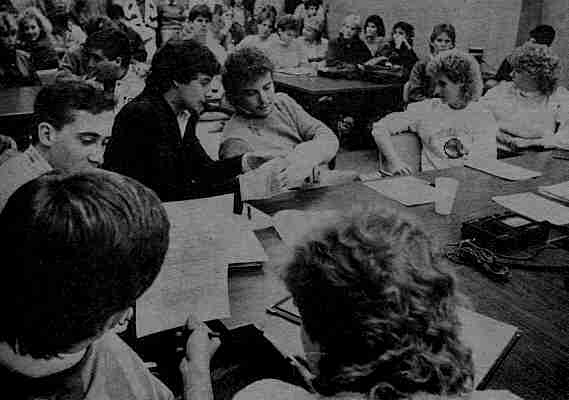
No one can really pinpoint the first time that American educators complained that "students want to make demands on the school." Certainly words like this were voiced at Moorhead State well before the 1980s. Back in 1957, when students protested (covertly) over President Knoblauch's plan to use the 'student union' fund to build a bell carillon on the Moorhead State quad, they were acting in the manner of consumers -- they had raised the money to build a student union, so who was he to decide how to spend it? The 1960s were filled with student complaints about dormitory rules, meal choices, dress codes, and class choices; new programs in women's studies, humanities, and other subjects, were developed, in no small part due to students wanting them -- and making it clear that they would go to school elsewhere if their desires were ignored.
Before the 1980s, most students did not begin thinking about even going to college -- let alone which college -- before their last year of high school. But a study conducted in the early 1980s showed that by 1984 "41 percent of students decided to attend college as early as sixth grade and that, by ninth grade, 61 percent were certain about their decision to go to college." In 1987, a study released by Michigan State University found that 80 percent of students who subsequently enrolled in college "had decided to attend college by the end of their junior year in high school. Further, these students usually selected the school they attended from "a list" that they had complied over a period two or more years, and, for most, the geographic location of the college was no longer the deciding factor for the college they chose.
Thus, something new was happening in higher education -- students were becoming paying "customers" who did not hesitate to demand greater control over their learning. This was forcefully demonstrated at MSU, throughout the 1980s, in a grim, long-fought battle over the question of whether students should "have the right to evaluate their instructors." Requests by the Student Senate for faculty evaluations had begun in earnest in the 1950s. In 1956, President Knoblauch had formed a committee to consider how "student appraisal of faculty" could be developed. While the committee studied several publications on the subject and considered various methods for a system, no final plan emerged -- partly because the president preferred to maintain the prerogative for supervising faculty and the faculty were by 1958 at loggerheads with the president over how the college should be managed.
The subject of student evaluations of faculty simmered along through the 1960s, no only at MSC but around the nation. In the absence of formal systems through which students could comment about faculty classroom performance, students at some schools developed their own, informal systems. Cheaply printed "Class Guides" (sometimes called "Rap Sheets") circulated among students at such schools as Harvard, Dartmouth, Yale, and the larger state universities, which contained comments about faculty and frequently contained movie-like ratings (1 to 5 stars). The faculty at these schools invariably responded that ratings guides were pointless because education "is not a popularity contest." Some departments, however, created forms that faculty could voluntarily use with students in their classes; the results were thus uneven.
In the early 1970s, administrations at each of the Minnesota state colleges were working to develop a uniform system for student evaluations; the evaluations issue was added to the negotiations that began when state university faculty won the right to form a labor union. Thereafter, the Inter Faculty Organization contract contained the formal procedure by which faculty performance was measured for tenure and promotion. It would not be until a decade later that a uniform evaluation was agreed on during contract renegotiations. That moment marked a victory for students after three decades of effort. The system still exists.
Student choice now influences everything from the kinds of food on campus (fast food outlets, brands of coffee, pop, etc.) to the timing of semester breaks. The days when colleges could act "in loco parentis" (as parents) over the students were gone -- if it ever really existed. Students had by the 1980s made it clear that they had learned Aristotle's cardinal lesson: "It is the mark of an educated mind to be able to entertain a thought without accepting it."
Note: Statistics and detail on how contemporary students select colleges are drawn from Jillian Kinzie, Don Hossler, et. al., Fifty Years of College Choice: Institutional Influences on the Decision-Making Process (2004).
Concerned about the "attrition" rate of freshmen, MSU begins a study of ways to lower the drop-out rate. The rate was 28% in 1983, 25% in 1984. One early result of the study suggests that the "geographic isolation" of Fargo-Moorhead is a major contributor to the problem.
In an op-ed letter to the Fargo Forum, MSU President Roland Dille disputes an article which suggested that political candidates "closely aligned with Moorhead State University" are too liberal to represent the local community. "I would say that the people of Moorhead elect public servants on the basis of the candidates' abilities," Dille asserts, pointing out the Moorhead State faculty who have served terms in city and county government.
As Spring term gets underway, fraternities and sororities at MSU become concerned that more and more students show little interest in joining Greek societies. "We offer connections and chances for community service," notes a spokesperson, "but off-campus jobs and other activities are reducing our memberships."
The University considers adding a "legal assistance" service to the campus. "We could help with landlord issues, consumer issues and DUI problems," notes a campus representative, "but there may be a potential for liability as a result of university sponsorship of such service. Things are more complicated now."
As graduation preparations are underway, visiting professor Andrew Conteh of Political Science is named Professor of the Year by popular vote of the students. "A lot of us hope he will get a permanent appointment," a student tells the Advocate.
The Homecoming Committee announces that it will revive the practice of electing a "Homecoming King and Queen," for the first time since 1969.
Under a new scholarship program created by the State University System, students from "disadvantaged farm families" in Minnesota can receive free tuition for up to six credits, for up to three quarters of classes at any of the state universities. This "family farm scholarship program" was passed at the urging of Minnesota Governor Rudy Perpich to help "farm families suffering from the economic displacement" of the 1980s.
Students protest when MSU concludes "an exclusive contract" with Pepsico Inc. to sell only Pepsi products in the universities pop machines. Non-Pepsi soft drinks are only available at the Deli and Et Cetera Shop in Kise Commons. Food Services manager Dave Souba acknowledges that the Pepsi-exclusive arrangement is unpopular with most students -- "hands down, Diet Coke is the most popular selling cola." The Pepsico contract will not be renewed after two years.
MSU counselors at Hendrix Health undertake a major effort to deal with a growing problem among women students -- "bulimia is becoming a nightmare with young women," and the University schedules workshops and studies to address the dangers.
MSU begins an ambitious $3 million fundraiser to accompany its Centennial Celebration.
Once again, the Faculty Senate passes a resolution that college faculty "should be evaluated by students, and that the results be made public to assist students in their choice of classes."
Construction of new third and fourth floors of the University Library nears completion, but student focus is more on news that MSU "ranks last among NIC teams in financial support of student athletes."
Noting that current enrollment trends are "defying the grim projections of the early 1980s," Registrar John Tandberg predicts that MSU enrollment will grow to about 9000 students within a few years.
MSU holds a special convocation to mark its 100th anniversary . The college also hosts a "grand banquet fundraiser" as part of the 100th anniversary celebration.
Enrollment reaches another record with over 8300 students. The count did not include several dozen high school students who could take college courses through the state's Post-Secondary Options program.
Returning to MSU to be part of the school's 100th homecoming, former president John Neumaier tells a group of students that encouraging a "liberal education isn't always easily accepted by a community."
The remodeled lowest level of the Student Union opens its doors as "The Underground," a dance- and (non-alcohol) night-club. The Underground will host 23,000 patrons in two years.
Students are saddened to learn that the Federal Government will reduce funding for loans and Pell grants in 1988.
MSU administration considers replacing the quarter system for classes with a semester system. The Tri-College program (with NDSU switching to semesters and Concordia using the system) suggests that a transition to semesters could preserve current enrollments. The issue is tabled after discussions.
MSU Library collection of law journals is damaged by theft of $2600 worth of microfiche. The culprit is never determined.
MSU wrestling team finishes winning season with four team members qualifying for the NAIA national tournament and one member (Steve Richard) as the division's Most Valuable Wrestler.
With commencement, MSU concludes its 20th year with Roland Dille as President. Admissions applications suggest that the university will have over 9000 students in another year.
MSU begins a $1.7 million renovation of the Student Union. Plans to change the traditional dormitory are also under consideration; faculty and administrators agree that the "student of the 1990s" will expect large dorm rooms (or suites) with advanced telecommunications (TCP/IP) access to the merging 'internet.'
A twelve-member, faculty task force begins the tendentious process of revising the Liberal Arts Requirements for graduation. With "fully 25 percent of the MSU students as good as any at Minnesota's private colleges, we want to update our education model for the future," comments task force member Ken Smemo.
Women's sports athletic director Mary Curtis sparks controversy by telling newscasters that "I've been patient for five and a half years, but we have yet to achieve equality for women's sports."
MSU's Advocate marks the 40th anniversary of the United Nations Declaration of Human Rights with commentary on the document's history and contents by guest columnist Andrew Conteh.
Marking the thirty years since rock star Buddy Holly died in 1959, killed in an accident while en route to a concert in Moorhead, MSU holds a concert of classic pop music.
A major influenza epidemic hits campus, delaying classes and exams. Medical personnel note that "lack of sleep," due to off-campus jobs, has made this year's flu outbreak among students more serious.
"Copies Plus" opens in Student Union, offering copy service to students and packets of readings/study guides for selected campus courses.
A proposal to expand the MSU campus to the west and north leads to numerous meetings with property holders. Negotiations for acquiring properties will take over a year.
MSU's Special Task Force unveils its draft for revising the Liberal Arts requirements. Among the major changes -- alternatives for meeting the mathematics requirements, more communications courses and an end to most cross-disciplinary courses.
Enrollment passes 9000 as classes begin; revised admission requirements mandate that each student admitted has scored 21 or more on the ACT examination, or have graduated in the upper half of his/her high school class.
MSU graduate James Ellingson (1962) is named Minnesota Teacher of the Year by the State Education Association.
Students, faculty, and administrators begin a protracted discussion regarding the University's future. With proposals being made in St. Paul to remodel the State University system, with enrollment topping 9000 and more expected in 1990, with the 100th anniversary completed, how should MSU prepare for the future. Renaming MSU as Minnesota State University-Moorhead; becoming a campus of the University of Minnesota; capping enrollment; expanding the campus with new construction; expansion by "virtual classes" and online classes; all will be debated in the coming decade. "Enrollments and future funding from the state," note MSU President Dille, "will decide most of these matters."
Following complaints from women students and some faculty, MSU Vice-president Roland Barden asks departments and offices to remove mistletoe as holiday decorations. "It's an end to an era," comments the Advocate.
With enrollments exceeding 9000, MSU faces a major parking dilemma. Plans for a 2-3 level parking garage to be built off 9th Avenue are dropped when permit and construction costs prove too high. New plans are made for parking lots west of the main campus.
The Industrial Studies department introduces a new course in robotics. While robotics is a field with great potential, the department notes, "it will take many years of effort before a robotic machine could do all that a human can do."
Minnesota revises its tuition regulations and a steep increase in tuition for out-of-state students. "A student from Fargo will pay about $450 more next Fall, and another $450 in 1991-92." With this change in costs, a drop in enrollment is expected.
After considerable effort and lobbying, MSU receives $3.6 million from the Minnesota Legislature to construct a new class building on land west of the central campus.
After 32 years as faculty and chair of MSU's Theater Department, Delmar Hansen announces that he will retire at the end of the Spring quarter. In other news, a record 1250 students graduate at commencement, and MSU approves a contract to provide cable television for the dormitories in the coming year.
Despite weaknesses in the team's defense, the Dragons beat Concordia 35-32 to win the annual Crystal Bowl game.
"Centennial House," a remodeled and refurbished home west of the main campus, serves as a "laboratory for Hotel-Motel Services majors; the small restaurant at Centennial House rapidly becomes an attraction for faculty and staff.
Students who will graduate in December face "the worst job market since 1982," according to findings of the MSU Career and Placement Center. Center director Mel Schmitz cites the high energy prices and Federal budget deficits as major contributors to the paucity of jobs, and advises graduates to "be flexible, willing to relocate, and adaptable to circumstances as you look for work."
With a solid core of seniors, MSU women's volleyball wins the District 13 championship. Seniors Laurna Frankovich and Cheri Pundsack establish six district records for the sport.
With the Soviet bloc of nations breaking up, an Advocate editorial urges the United States to engage in "trade agreements, military reductions and cultural exchanges" with Russia, bringing about a peace which "for decades young people, like ourselves, risked their lives."
After winning the District 13 championship in 1990, the MSU Women's volleyball team is off to slow (7-6) start. New head coach Becky Schultze promises that once she has instilled a "killer instinct" in the young team, "we'll be winning 15-0 games regularly."
North Dakota State University opts to drop the quarter system and begin semester classes in 1992. MSU considers a similar move. "With Concordia and NDSU on quarters we may have to follow suit to preserve the Tri-College benefits," comments Registrar John Tandberg.
The MSU production of "Children of a Lesser God," is named as a "Top College Theater Production" by the American College Theater Festival, a signal honor for the cast and director David Grapes.
The Minnesota Higher Education Coordinating Board, in consultation with other state agencies and college administrators, issues its proposal for the state's "post-secondary education in the future." The cornerstone of the plan is a new "board created to govern all public two-year institutions and the state universities". Read the executive summary from the report.
With the Legislature indicating that cuts in the Higher Education budget are "inevitable," MSU looks at options to deal with the student tuition -- each one is now, on the average, $7700 in debt at graduation.
The University briefly flirts with the idea of becoming part of the University of Minnesota, but a "University of Minnesota-Moorhead" campus is dropped as unworkable.
Higher tuition raises students fees (about 90 cents per credit) and increases in housing costs are certain for fall. The University plans to tighten its admissions standards. This sobering news is only partially offset by a $4 million award from the Legislature to remodel the MSU heating plant and an announcement that the Dragons will be admitted to the NCAA Division II in 1996.
The graduating Class of 1992 is smaller than anticipated. Admissions warns that the enrollment of new freshmen for the coming year is also lower than expected, much of this due to the increased non-resident tuition of over $73 per credit.
The higher cost of college is all too evident as classes begin with some 8300 students enrolled for Fall, a drop of more than 500 from the previous year. Thirty percent of the students admitted in 1991 have not returned for a second year, and the number of students enrolled for ten or fewer credits is growing.
U.S. Senator Paul Wellstone visits MSU and speaks to students about his activities in support of higher education. But budget woes continue, due in part to declining population numbers in western Minnesota, the prime recruiting area for the university. Budget projections force MSU to delay beginning work on its new "Center for Business Studies."
Alexander Kalinovsky, a student from Latvia (which recently gained its independence from the collapsing Soviet Union) reflects on his nation's rebirth in an interview with the Advocate. When not in classes or studying, Kalinovsky works at the Write Site; his English writing skills "are as good or better than that of most Americans."
Terrence MacTaggart, Chancellor of the State Universities system, warns that, with the new MNSCU system soon to become a reality, budget reductions are "all the certain." "Legislators tend to solve budget problems on the backs of students," MacTaggart notes, and predicts that many of the schools will need to both raise tuition and reduce faculty and staff.
Katy Wilson becomes Athletic Director at Moorhead State University. The former coach for women's softball, and director of women's sports since 1990, is the first woman to administrate all of the intercollegiate sports at MSU.
Over 500 students and faculty meet at the Memorial Union to draft a petition opposing the Minnesota governor's proposal to raise state university tuition by 24 percent in the coming year. With tuition having risen nearly 10 percent per year for the past decade, a 24 percent increase would be "unconscionable," says Student Senate President Scott Dauner, "the extra revenue for the state, from such a jump, won't be there, because there won't be enough of us in school to pay for it."
MSU's men's wrestling team wins third place at the state's NAIC tournament. Nine members of the team qualify to compete at the NAIA national meet, while two teammates, Bobby Olson and Joey Andreasen, are candidates for All-American honors.
The Advocate publishes its annual April Fool's Issue (The Badvocate) with a front page story on parking: "Last week MSU's expansion and house-demolishing efforts finally extended to West Fargo in an effort to avoid building a parking garage. Next year we plan to purchase lots out by East Ten Mall and perhaps in Dilworth."
The largest graduating class in Moorhead State's history receive degrees. The commencement ceremonies occur in the shadow of certain changes as the fall enrollment will clearly be smaller; and Roland Dille, president of the school since 1968, has announced his determination to retire in 1994.
Classes begin with a 9 percent drop in enrollment, the largest since 1942. The school also changes with the announcement that, in Fall 1995, the University will conduct classes in a semester system. President Dille issues a statement that he "prefers the quarter system because of its opportunities to take a variety of classes," but a two-semester system will work best within the Tri-College system and accepting transfers from other schools. "We have to change with the times." Read the announcement on the semester conversion process.
Moorhead city police investigate a rash of thefts on and near campus and some two dozen cars are vandalized in parking lots and on the streets.
The University Admissions office announces that, as of Fall 1995, ACT scores will be required from all applicants seeking admission to study at MSU.
The shortfall in revenue due to lower enrollment and higher expenses leads the administration to consider layoffs at the end of the fiscal year. Up to 60 university faculty and staff could be cut before classes begin in Fall 1994. The debate over potential cuts will permeate the campus atmosphere for months to come.
A national search continues for new president to take the helm after Roland Dille retires in June. The search "pool" of candidates is now up to ten individuals who may visit the campus for interviews.
A campus survey reveals that over 800 MSU students are now "turned on to electric mail." The University expects that electronic mail (email) may become a useful tool for education, "sometime in the next decade."
After an extensive search for a replacement for Roland Dille, the next president of MSU is chosen -- Roland Barden, current Vice-President (since 1989) of Academic Affairs for the university.
In an effort to increase revenue, MSU trademarks its Dragon emblems and logos.
The university forensics team places 17th in the nation at the American Forensics League National Individual Events Tournament in Wichita, KS, its best ever national showing. Senior Chad Halvorson places 5th in the nation in Impromptu Speaking, and Junior Mike Van Keulen wins the national championship in After Dinner Speaking.
At May commencement, Roland Dille says farewell to MSU faculty and alumni, closing his 26 years as president. In a plea for maintenance of the liberal arts basis for higher education, he says that colleges can "survive in the hands of technicians," but "will not flourish there."
Classes begin. A debate over Title IX, which mandates increased funding for women's sports, leads to reductions in men's sports. Two sports -- men's tennis and golf -- have been dropped, while women's soccer has been added.
Women's volley ball opens its season with 3 consecutive wins; the victories will mount up as the team goes on to win the conference championship.
Football Dragons finish their regular season at 7-2-1, closing with a 29-29 tie against Winona State, qualifying for NAIA playoffs. They lose the opening game, 7-14, against Northern State. "Our game was just two minutes too long," notes head coach Ralph Micheli.
The budget problems facing Minnesota schools for two years come to a head, forcing the new president to replace personnel in Administrative Affairs and announce that the loss of "some positions among faculty and staff" is "almost inevitable."
Computer service on campus grinds to a halt in mid-January, when a local man cuts community data lines while attempting to rob an electronics store.
Concerned about rumors of layoffs, students rally at the Union to oppose budget cuts. The "mood was kind of like a lynch-mob," says one student of the gathering.
The administration's budget draft envisions layoffs to cover a $3.7 million deficit for fiscal 1996. President Barden has "doubt" that the state will award greater funding to erase the gap. Read budget recommendation documents, outlining the changes.
MSU engages a consulting firm to examine ways to increase enrollment and better manage the budget.
In the shadow of budgetary stringency and further declines in enrollment, MSU holds commencement and prepares to open the new Center for Business.
Classes begin will 6475 students, about 500 fewer than the previous year and 2300 fewer than 1991. The semester system is now in operation, reducing the number of individual classes a student will take. The Vice-president of Student Affairs advises that the MSU budget has "no reserve, no cushion for unexpected costs."
Layoffs and resignations have reduced the faculty and staff. The Minnesota State Colleges and Universities System (MNSCU) now coordinates a merged organization of 7 State Universities, 21 Community Colleges and 34 Technical Schools. Tuition, with fees (including a new computer - use fee), now stand at about $74 a credit for residents, a "shocking" level in the words of the Registrar. Many challenges lie ahead Student Debt Crisis.
A Trillion Dollars and Counting
The students at Moorhead State were hardly the only one who had growing difficulty paying for their college education. This was national problem. As a national study compiled by the U.S. Department of Education, noted:
"The 1990s brought college tuition and fee increases that outpaced both inflation and growth in the median family income. At the same time, federal, state, and institutional financial aid to students expanded, and important changes were made in the structure of the financial aid system. At the federal level, the 1992 Reauthorization of the Higher Education Act expanded students’ eligibility for need-based aid, raised student loan limits, and introduced unsubsidized loans for students regardless of their need. The resulting increase in borrowing has been one of the most dramatic changes in financial aid in the decade. Also during the 1990s, the federal government began to use tax credits to ease the burden of paying for college. States and institutions increased their grant programs, as well as the amounts awarded based on merit or a combination of merit and financial need, rather than need alone. As a result of these trends and events, the overall picture of what and how students pay for college has changed substantially since the early 1990s.”
Despite the Federal and state efforts, tuition continued to go up faster than inflation. By the late 1990s, when MSU's administration compiled results of exit interviews with graduating seniors, students were reporting that they owed an average of $16000 in student loans when they graduated. Similarly, freshman and sophomore students who were interviewed when they withdrew from classes gave "the high cost" of tuition as one of the primary reasons for dropping out. "It just takes a little crisis -- a medical bill, or a big bill for fixing the car -- and you just can't go on," said one student who had to leave campus.
The switch in classes from a quarter system to semesters was quickly welcomed by most students when it became apparent that the earlier end of Spring term allowed them to look for a summer job sooner than they could in the quarter system. "We needed that chance to make more money," a student explained to one of his professors in about 1996.
But the debt loads on most students continued to grow, and by the end of the 1990s, a new problem was becoming apparent -- forced to worked more and more hours while taking classes, more and more students were taking fewer classes per term; they simply did not have the time to work, study, and rest like normal persons. At that point MSU began to consider altering its courses (reducing 4-credt classes to 3-credits, changing class times, increasing night classes and on-line classes, even changing liberal arts requirements). The Moorhead State Alumni Association and the MSU Foundation began to make student scholarship funding the focus of their fundraising efforts. "A $500 grant can make the difference between a Dean's-list student and a drop-out," a Foundation memo noted. The efforts brought in more donations, but expenses continued to grow. Energy costs only added to the challenge. As fuel oil and gasoline prices steadily rose, the increased burden to the students was matched by the expenses that MSU paid to heat buildings.
By 2001, the average debt load on MSU students (upon graduation) exceeded $20,000. In the decade since, it has continued to increase by some 30 percent (see chart below).
Note: Student loan statistics chart is compiled from the 2012 findings of the Federal Reserve Bank, New York Branch. For the quote concerning rising tuition in the 1990s, see Paying for College -- Changes Between 1990 and 2000 for Full-Time Dependent Undergraduates (US Department of Education 2004).

Tuition Trends
Since the 1970s, college tuition has risen higher than the costs of food, gasoline, housing, and medical care. Student college debt in 2012 averages about $25,000 per student. Of the 37 million Americans with outstanding student loan debt in 2012:
- Almost 40% of these borrowers are under the age of 30.
- Nearly 42% are between the ages of 30 and 50.
- 17% are older than 50.
- Borrowers of age 30-39 carry $307 billion in student loans, followed by those under 30 at $292 billion, $154 billion in the 40-49 age group, 50-59 at $106 billion and the over 60 category carrying $43 billion, for a total outstanding debt of $902 billion.
With MSU administration reorganizing student recruitment through "tele-recruiting" by seniors and alumni, the bulk of the student body looks forward to the "welcome back" party hosted by the Owls, who have recently been reactivated after a 1-year suspension for conduct violations.
MSU football Dragons defeat Wayne State 51-28 for last home game, and will share the NSIC championship with UM-Duluth.
In the midst of tight budgets and costly loans, MSU students are happy that off-campus housing costs ($400 a month average) remains lower than state college average.
Two MSU theater majors -- Michael Klug and Susan Beaver -- are chosen to compete in the American College Theater Festival national competition in Washington, DC.
English professors Tom Tammaro and Mark Vinz honored when their edited volume, Imagining Home: Writing from the Midwest, is nominated for the Minnesota Book Award.
With $300,000 investment in personal computers and servers, MSU put 90 percent of University faculty and clerical employees "online."
After months of deadlock, a possible strike by State University faculty is averted when a tentative agreement is reached by MNSCU and IFO negotiators.
First days of fall semester are made more difficult by "two squirrels" that chew through cables powering the University's e-mail servers.
MSU art major files $600 damage claim against university because "Night Watch discarded a dead pigeon I was drying in the [Arts Center] courtyard. I planned to coat it in bronze. Now my work is late."
MSU Advocate profiles alum Kevin Sorbo, TV star of Hercules series. "I loved MSU," Sorbo tells paper, "but spent all my time lifting weights and playing basketball in Nemzek, until I decided to try acting."
With increasingly harsh winters in the late '90s, MNSCU mandates a new policy -- "the MNSCU offices in St. Paul will determine when a campus is closed for poor weather."
MSU receives $270,000 in grants from state and private foundations for technology upgrades, the First Year Instruction program and the Speech Therapy Center.
As a cost-saving issue, MSU announces that it plans to discontinue commencement exercises in August. With "only 76 graduates" in August 1996, "it's simply too expensive." August graduates may choose to attend commencement in December.
MSU announces that beginning in the coming fall term, grading practices will allow the "plus and minus" system, rather than straight letter grades for each class.
U.S. Senator Paul Wellstone (Minnesota) visits MSU to ask for student support for a bill he is pushing in Congress. "We need more aid for affordable higher education," he stresses, "as this means the best for our national future."
Classes are cancelled for 2 days in early May as students and faculty fill 175,000 sandbags (using 6 million pounds of sand) to fight the Red River flooding. "Our effort helped to save Moorhead," President Barden notes, as the Red River crests just below 40 feet before receding.
Biology professors Mark Wallert and Chris Chastain, together with chemistry professor Shawn Dunkirk, receive grants to initiate a biotechnology research program at MSU.
Thanks to vigorous recruiting and a "gateway" program with local junior colleges, MSU has its first increase in enrollment in seven years.
Due to improving national economy and the findings of the National Association of Colleges that 1998 will be the "best job market in a decade," students attend the annual Tri-College Career in record numbers.
The State's announced bonding proposals (funds for construction and repairs) earmark $2.6 million to MSU for roof replacements, building repairs, upgraded athletic faculties and new interactive classrooms for distance education.
New Federal and State tax credit legislation offers the hope of additional tuition help for college students, a sign of hope for the over 70% of MSU students who rely on loans and/or scholarships to continue going to college.
With computing, business, communications, and education as the fields that are most likely to lead to jobs, university counselors urge faculty to stress writing, communications skills, and leadership skills in every class.
Greg Duke, graduating senior and basketball star, is named the season's Most Valuable Player, closing his college career with 1689 points, the fifth highest total in school history.
MSU's 111th year of classes begin as students win a petition drive to get the college to reroute its drainage system in a way that preserves 50 campus trees.
In response to Mankato State being renamed Minnesota State University Mankato, MSU administration begins consideration of renaming its own campus.
University's Music Department adds jazz music as an emphasis in its performance degree program.
Construction engineers carefully examine school's largest dorm, Neumaier Hall, because concrete support columns extending into the soil are not "settling uniformly."
Because of warnings from experts, President Barden orders Neumaier Hall closed -- "we would just rather be overcautious than not cautious enough." The move requires relocation of 305 residents.
Louise Erdrich, author of award-winning novels Love Medicine and The Beet Queen, reads on the campus's McGrath Visiting Writers Series.
Controversy follows the decision not to renew the contract of popular MSU basketball coach Dave Schellhase after five losing seasons.
Affinity Plus Credit Union opens branch in Comstock Memorial Union to provide more banking services to students and staff.
Although some 60% of students oppose any renaming of the university, MSU still studies name change to "expand our image in new markets."
MSU football team opens season with 44-7 defeat of Concordia College at the first Power Bowl (formerly Crystal Bowl).
With enrollment over 7000, women students hold large "Take Back the Night" rally to ask for greater security on "our more crowded campus."
Political Science Professor Andrew Conteh is named Minnesota Professor of the Year by Carnegie Foundation.
Administration announces that it will lengthen holiday break in order to secure campus technology against potential "Y2k complications."
Flora Frick pool is closed after three-quarters of a century. It would be "too expensive to renovate the old pool," explains VP David Crockett. The space is being remodeled for the expanded Post Office.
MSU hires Greg Toutges as student disabilities counselor -- "I want to work with students and faculty to help those who fall behind in classes due to physical or learning difficulties."
MSU's track teams shine at the annual NSIC Indoor Championships, with second (women's) and third (men's) place finishes.
Study finds that commuting students are shunning "smaller and uglier" apartments near campus for new apartments in Fargo. The University considers ways to help locals upgrade rental property.
Graduation in the age of the internet; students will use online ids and passwords to receive their semester grades in electronic form.
Biotechnology program expands as National Science Foundation awards $156,000 grant to professors Mark Wallert and Joe Provost for research on cancer cell formation.
New MNSCU model for allocating funds raises concerns. This formula may "put more of the responsibility for the cost of education on the student," says MSU Student Association chair Mike Redlinger. "With this, students could have long term debt from the cost of college."
Classrooms are enhanced by new software packages (WebCT, Blackboard, D2L) that allow assignments to be posted online and interactive meetings to be held after hours.
Campus mourns the sudden death of Professor Ted Larson, whose film courses have inspired thousands of students for 32 years.
Now officially Minnesota State University Moorhead, MSUM struggles with the new model for funding. "We have to determine the average cost per student for each school, each class," notes VP David Crockett. "The cost for any lower division class is assumed to be the same for every institution. That's a problem with the model formula."
MSUM counselors schedule extra time to deal with students with SAD (seasonal affective disorder), due in part to winter blues, in part to news that tuition will rise 5-7 percent
Chemistry Professor Nick Kowanko's "Bioglue" (a surgical adhesive based on animal albumin) goes onto the market. The alternative to stitches and staples in surgery has an annual $50 million potential.
Annual April Fool's issue of Advocate features 'President Dub-ya' urging students, "I did drugs and now I'm president; you can do it too!"
Graduating education students at MSUM score nearly 100% success rate in the new Federally mandated Pre-Professional Skills Test.
The venerable Owls fraternity marks its 100th anniversary with a three day celebration in Moorhead. The celebration invitation is classic Owls: "A sun-flavored Friday afternoon; mid-May. Pick a year. While we are cruising the back roads somewhere between Audubon and Detroit Lakes, humanities, history, chemistry, and English classes are collectively being cut. Converting beers to years, 99 is how many have passed since the Owl Fraternity was founded. And come this July-when 99 turns 100-the Owls will celebrate their centennial reunion in grandiose fashion." Read more memories about the Owls.
Owls
Wayne Ingersoll Ingersoll was unwavering. “I’ve been a member of the Clay County Commission for a while now and I really love the job. It allows me to serve the people of this area, where I grew up, see what I can do to make their lives better. But you know, if someone said to me, ‘Wayne, if you had to do it all over again and have to choose -- grow up, go to Moorhead State for college and join the Owls fraternity, then get elected – or grow up, go to Moorhead State and still get elected a commissioner, but never having joined the Owls – which would you pick, the Owls or the Commission?’ If someone said I had to make that choice, I’d pick the Owls, hands down. From them I learned confidence and above all camaraderie.”
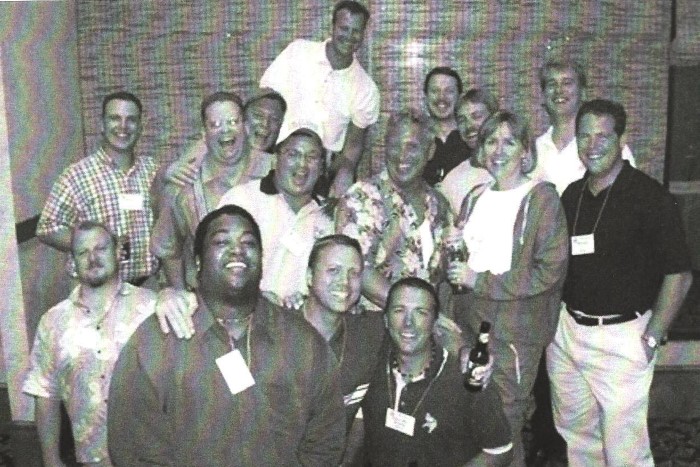
Dean Mollerud, now an instructor of Education at MSUM, feels much the same way. A year younger than Ingersoll when he joined the Owls in the 1960s, Mollerud notes that “when I came to school I felt kind of lost. It was a smaller college then, but it was big to me. When I joined the Owls, I belonged in a group of guys who became best friends and I knew I could count on them, and they knew they could count on me. I was somebody. I had confidence. That’s stayed with me since, in my teaching and everything else.”
The Owls were born in 1901, when James D. Mason, a student in his thirties, agreed to a kind of “mystic society” in which the male students – far outnumbered by the women at the teachers college in those days – could have their own getaway men’s club. Mason aimed to create something similar to the ‘skull and bones’-type fraternity that was a feature of ivy league schools. “I organized an initiation, some rituals with ‘mystical numbers,’ and we met at the old Kurtz mansion,” Mason later recalled. The “mansion” was the Victorian home of the late Thomas Kurtz, Moorhead’s first banker and Moorhead Normal School’s first resident director. The attic of the large, empty house was inhabited by night owls, and there were always rumors of Kurtz’s ghost walking the grounds. So the building became the perfect place for the early “secret ceremonies of this, the first fraternal organization of the school. Edwin Reed, the college’s head of English, helped to create the Owls’ rituals, and wrote many of the sings featured in the fraternity’s 50th Anniversary commemoration book. Reed, Mason recalled, had been part of a couple of societies and knew the kinds of ceremonies that they held.
The Owls grew slowly until by the 1930s they were the largest fraternity on campus. “We were approached many times to merge our group with a large national organization like TKS or Sigma Alpha Epsilon,” a 1940s Owl remembered, “but we were happy to stay the local group closely tied to Moorhead State and the town. With the post-World War II boom in higher education, all the on campus fraternities and sororities grew larger; by the mid ‘50s, there were forty or more Owls each year.
Both Ingersoll and Mollerud were members in the 1960s. “We certainly had our share of parties and beer busts,” Ingersoll notes. Each spring we would schedule our own event to coincide with the annual “Governor’s Ball and Music Festival. The location was kept a secret while the officers planned it, but it would slowly get around so by the time of the party, almost all the students knew where it would be.” Mollerud well remembers those parties. “Most of the time it was at a gravel pit or a farmer’s field. Moorhead State alums who were Owls would happily let us use a place they owned and they always came too. I think in about 1968 we must have had three hundred people at a sandpit near Downer – they just brought in a truck filled with beer.” Karen Kivi, long-serving Moorhead State librarian who lived next door to the House where many Owls rented rooms, recalled watching the Owls make floats for homecoming. “They’d be clutching beers while stuffing tissue paper into a chicken-wire frame, tying on ribbons where needed. By early morning most were gone, but a pretty good looking float would be there on the lawn.”
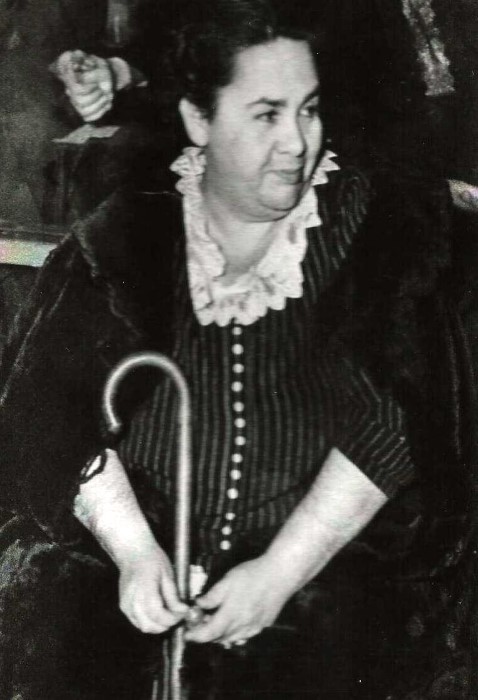
Ma Jackson
Every homecoming, the Owls paired up with Gamma Phi Mu sorority to work on the weekend dance. “Our homecoming queen and our own “Owls queen” was almost always a Gamma Phi.” But the real, full-time queen of the Owls after the 1950s was “Ma Jackson,” (photo, left) the woman who rented rooms in her house to many Owls. Mollerud thinks of her as family -- “Ma was half-mother, half-drill sergeant to all of us. If we had a problem, she’d help solve it. We were like her own sons. But, on Friday nights, when we’d play cards with her, heaven help you if you thought you could drink more than her!”
The Owls had a serious side too. “We had a meeting room in MacLean’s basement,” Ingersoll noted. “We’d plan a fund-raiser for a charity, collect money for a scholarship. I learned a lot about planning that way and got some leadership skills that have served me well since.”
By the 1990s, higher costs of college, and the need to work more hours off-campus, were cutting into memberships of all the Greek societies at Moorhead State. The Owls were no exception. Membership declined until in the mid-2000s the fraternity ceased to exist. “We held a full dress reunion in 2001,” Ingersoll states wistfully, “and it was a great turnout. Soc Glasrud, probably our oldest living member came and shared stories. Others came from all points of the compass, and Moorhead put out the red carpet and welcomed us all back. But sadly it didn’t get the group going again. The students now have new social media in their phones and computers and mostly they’re just too busy trying to pay the bills.”
But the memory of the Owls lives on. “Some of us still get together each year,” says Mollerud. “It made us who we are,” says Ingersoll. “To me,” a member said, “Owldom is the definitive word for brotherhood. Each member takes pride in the organization, but it is a pride earned, not borrowed.” Some fraternities and sororities – mostly professional, a few social – are still at MSUM.
Road Trip: The OWLS' 100th Anniversary (from Alumnews, Spring 2001)
By Jeff Burrill
Centennial Reunion A sun-flavored Friday afternoon; mid-May. Pick a year.
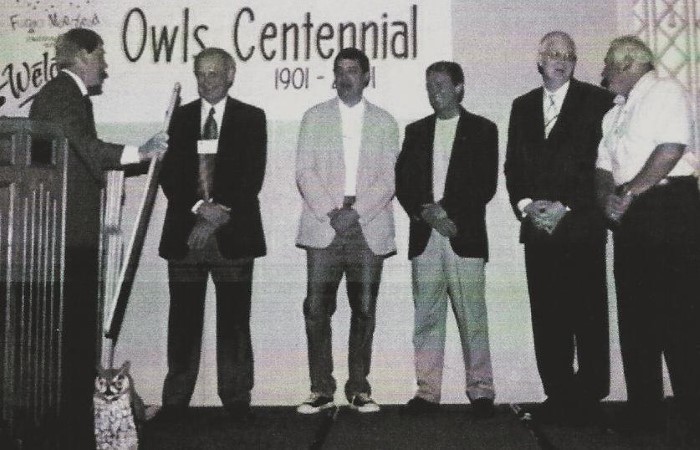
While cruising the back roads somewhere between Audubon and Detroit Lakes, humanities, history, chemistry, and English classes are collectively being cut.
Farmland has thawed, reclaiming its texture. Ephemeral lavender blossoms decorate lilac bushes shading the west side of two-story white houses. Robins bare their brick-red breasts.
Disconcertingly off key, four frat brothers vocalize with lung power usually reserved for shower arias: "A hundred bottles of beer on the wall! A hundred bottles of beer! If one of those bottles should happen to fall there'll be 99 bottles of beer on the wall!"
Converting beers to years, 99 is how many have passed since the Owl Fraternity was founded. And come this July-when 99 turns 100-the Owls will celebrate their centennial reunion in grandiose fashion.
Events begin at 5 p.m. Thursday, July 5, with registration and a social gathering at Fargo's Ramada Plaza Suites.
Friday, July 6, there will be tours of the Minnesota State University Moorhead campus. In planning stages is a golf tournament at the Moorhead Country Club. Concluding the day's events will be a social gathering, featuring a chuck wagon buffet held from 6 p.m. to 1 a.m. at the Ramada.
Scheduled for Saturday, July 7, is a program, banquet, and dance at the Ramada running from 6 p.m. to 1 a.m. The program will include short speeches and a video history of the Owl Fraternity.
In addition, commemorative booklets, videos of the Owls' history, and centennial T-shirts are available for purchase (in advance) via the registration form.
Speaking of which, registration forms have been sent to Owls and Owl Sweethearts. Those who have not received one-or have questions or comments about the 100th anniversary reunion-please contact Wayne Ingersoll at 1324 5th Ave. So. Moorhead, MN 56560. Or e-mail Jeff Burrill at jmpb@prodigy.net. (Registration deadline is May 1, 2001.)
Members of the Owl Centennial Reunion Committee are Mark Boche, Jeff Burrill, Wayne Ingersoll, Dave Miller, and the late, very great Larry "Drone" Peterson. Ted duCharme has also joined the committee and is overseeing the golf event.
Over the past five years, the following Owls have generously donated seed money and indicated they will be attending the Old Order of Owls 100th Anniversary celebration:
Dave Alto, Jerry Amundson, Donald N. Anderson, Erik Anderson, John Anderson, Dr. Lee Antell, Blair Archer, Bill Auten, Karl Dan Bakkum, Terry Bartness, Bruce Bausman, Brant Beeson, Craig Beeson, Larry Beeson, Jim Berg, Al Berglund, Charles Bertness, Darrell Bertness, John Bertrand, Doug Bertsch, Donald Betzen, Bob Billberg, Ken Bjorkman, Mark Boche, Bob Bowlsby, Ted Brill, Chris Bungert, Col. Dr. Julien Burkness, Jeff Burrill, Adam Callow, Ralph Carlson, Rick Cochran, Don Conn, John Conzemius, Charles Cook, Rev. Tim Cook, William Corcoran, Ralph Crews, Mac Dahl, Aaron Davis, Bill Devine, Steve DiBrito, Marshall Doran, Mike Dorsey, Craig Driscoll, Ted duCharme, Donovan Dulski, Shawn Dye, Steve Ehlers, Eugene Eininger, Keith (Skip) Enger, Tim Erholtz, Walt Erickson, Wade Ewing, Lyle Fair, Norm Felde, Vic Fergen, Elvin Foss, Dr. Freeman Fountain, Darcy Frischoltz, Jim Galvin, Joe Gehlen, Russ Gerdin, Dr. Clarence Glasrud, Dr. David Gosslee, Gray Richard, Donn Groth, Roger Haire, Jim Hanson, Gordon Harstad, Tim Hart, John Haugo, Mark Haugo, Mark Hellerud, Erling Herman, Jeff Herman, Dareld Hirschey, Richard Holzer, Bob Hopek, Paul Hopman, John Hough, Jim Howland, Steve Huseman, Dieter Humbert, Wayne Ingersoll, Don Iverson, Richard Jackson, Clifton Jacobson, Jerome (Jerry) Jacobson, William Jacobson, Allen Jensen, Kenneth Jensen, Dennis Johnson, Ronald L. Johnson, Tom W. Johnson, Charlie Jose, Ray Kavanaugh, John Kjera, Mike Kloeckner, John Klug, Rob Knutson, Jeffrey Koehn, Ray Kotchian, Richard Krabbenhoft, Marv Krafve, Herman Krajeck, Jerry Kranz, Gerald Kriesel, Ray (Kirby) Kuklenski, DeWayne Kurpius, Sidney Kurtz, Lowell Kutches, Brian Lachermeier, Bob Lambert, Josh Lamont, Dan LaRock, Brian D. Lauhermeier, Frank Leidenfrost, James Lein, Dale Lestina, Howie Lomsdal, Dave Lund, Charles Luna, Jim McCabe, Larry MacLeod, Bernard McGuire, Dave Mack, Jim Mader, Britton Mattson, Robert Melchior, Dr. Richard Menzel, Richard Mickelson, Jerome Miksche, C. David Miller, Donald Miller, Jerome (Jerry) Miller, Rodney Miller, Ronald Miller, Sherman Moe, Frank Mollner, Russell Monson, Orville Moran, Josh Morgan, Wayne Mosey, Stan Motschenbacher, Larry Murray, John Mytinger, Gordon Nelson, Scott Nelson, David Nibbe, Doug Nick, Jim Nigg, Erik Nilsen, Dr. Orlow Nokken, Tim Norsten, Henry Nubson, Kris Oas, Karl Oelker, Mark Olivieri, David Olness, Keith Olson, Lee Overmoen, John Palacio, Dr. Robert Pawlowski, Roger Pearson, Bill Peschel, Donald Peterson, Greg Peterson, Tom Plant, Leland Pommrehn, Norm Przybilla, Bob Purcell, Bob Quam, Kevin Quinn, Shannon Reck, Kevin Reitz, Victor Robertson, Virgil Robinson, Tom Rockne, Charles Scheel, Wally Scheer, Robert Schmidt, Mark Schmitz, Richard Schmitz, Vern Schnathorst, John Schuster, Larry Scott, Andrew Shellito, Harris Shellito, Jim Shoemaker, Marv Skaar, Dale Skallerud, Dean Skallerud, Gary Smith, Dr. T. Edison Smith, John South, Paul Spafford, Thad Stafford, Fred Stalley, Don Stetson, Harvey Stewart, Earl Stottler, Chuck Strand, David Strand, Bradley Sturn, Mike Sullivan, Bob (Rube) Sullivan, Neil Sussenguth, Alvin Swanson, Dave Sweet, Ryland Syverson, Ronald Thompson, Don Tirk, Dave Torson, Robert Utke, James Van Tassel, James Varichak, Leonard Varriano, Gary Vitali, Von Vold, David Waldon, Jim Wanshura, Charles Warner, Bob Waters, James Weiler, David C. Weitnauer, Scott Wensman, Warren (Max) West, Jack Wilcox, Bobby Williams, Bob Winter, and last but not least, Bernie Zinda.
Classes begin amidst strikes by the AFSCME (American Federation of State, County and Municipal Employees) and MAPE (Minnesota Association of Professional Employees). Some students join pickets in support.
Students are upset by MSUM's decision to forego the traditional "fall breather" break. Many boycott classes in protest.
Difficulties continue with early snows and unhappiness over crowded computer labs.
Mindful of higher education costs, President Barden proposes a study of a single "flat tuition" rate for all students: "this may help us with out-of-state recruitment,"
Smoking now banned in all dormitories and buildings.
MSUM women take 3rd place in NSIC tournament, a "huge step forward for our basketball program, our first post-season win."
State action in suggesting a 9.75 percent tuition increase for 2003 sends shock waves through campus.
Classes begin with higher costs, and 130 fewer work study jobs, as Federal suport for education declines.
MSUM approves plan for "every state, same rate" tuition. "We hope this will maintain enrollment to about 7500."
Dragons close out .500 season and hope for better football next year. "We're at a disadvantage in sport scholarships, against such larger schools."
President Barden freezes 1% of total budget. "I take this precaution in case of state budget cuts next year."
Minnesota's budget deficit makes tuition rise likely. "We've probably reached the maximum that can be covered by tuition," pleads Barden. "The students are strapped enough already."
State funding shortfalls nearly leads to cancellation of Straw Hat Players for 2003, but funds from a campus work program are transferred by Barden to salvage the season.
Dragons heat up courts as both men's and women's teams are vying for first-place standings in their divisions.
MSUM "Oddvocate" marks April 1 by announcing that North Dakota will legalize pot in 2004.
As graduation takes place, enrollment analysis shows that the "average student" can no longer graduate in 4 years -- "off campus jobs take too much of their time."
Despite a "significant rise" in tuition statewide," MSUM classes begin with a larger freshman class. "Our growth is comforting. Having more revenue is definitely better than less," comments registrar.
The modern electronic world poses new question -- is MSUM responsible if students use University equipment to "share music files?"
The average Moorhead State student debt on graduation now rests at $18,227, double that of ten years before.
MSUM women's swim team wins St. Mary's Invitational meet by over 300 points, partly due to superior diving skills.
As textbook costs keep going up, students turn to internet book shopping in greater numbers. "Last fall the average student spent $285 on texts," notes bookstore.
Moorhead Police give "personal safety" workshop tips at seminars sponsored by the Women's Studies Center.
Campus shocked by death of student who "power-houred" whiskey shots on his 21st birthday. "Everyone's grieving" notes friends.
MSUM Theater department's performance of "All My Sons" draws families of servicemen. "We can all learn something about the costs of military service from this play," says director Jim Bartruff.
The "science lab extension" to Hagen Hall will be completed soon after commencement.
MSUM Athletics seeks more scholarship support from alumni, but football team opens season with 77-12 defeat, and ends season 0-11.
Women's volleyball continues undefeated season and is national ranked in 21st place.
New Rivers Press, acquired by MSUM in 2001, publishes 14 books in 3 years and offers on-campus experience in publishing.
College of Humanities celebrates campus approval of new Film Studies major.
STARs program (Student Tele-counseling Admissions Representatives) allows upper class students to help recruit new students.
Minnesota U.S. Senator Norm Coleman and two dozen other senators lobby Washington for an increase to funding for Pell Grant program. "We need the increase now."
With War on Terror approaching its fifth year, a national study shows that the number of foreign students in U.S. colleges is "continually declining."
Fall semester begins with announcement that construction of the long-sought Wellness Center will begin in 2006.
Is it the knowledge or the diploma? -- alumni debate the value of college on Collegeboard.com web site.
Campus health staff seek programs to convince students that "power drinking" is dangerous.
While some students condemn pro-life posters and flyers appearing on campus, others defend "right of free speech."
Dragon pole vaulters Tiffany Spriggs, Derik Brugger, and Jennifer Hensel compete in national NCAA Division II Track and Field championships.
Gay students at MSUM complain that they are harassed at local cafes and bars, and insulted on campus. University looks at strengthening tolerance education via TOCAR.
2005 Poet Laureate Ted Kooser reads his poetry at MSUM, urges students to "read, at all costs."
MSUM makes "Alcohol and College Life" class mandatory for students.
Classes end with University unveiling new graduation requirements -- standard liberal studies system is replaced by "12 competency areas" in new "Dragon Core" to be implemented in fall.
A "makeover" for Kise dining area gets underway, to be completed in 2007.
Advocate debates the merits of the "writing intensive" course requirements for Dragon Core. "It's not that we all teach writing, but we get students to use writing in their major studies," comments faculty committee.
School begins intensive work on "raising our profile in the region," through a new, expanded web site. "A good site is our tool to highlight how we develop talent and knowledge."
As fundraising for a formal Wellness Center continues, upper class students complain that they are paying fees "for a wellness facility we will never use before graduation."
North Central Association for Colleges and Schools visits campus to examine program and re-accredits MSUM for 10 more years.
As the 9th annual Student Academic Conference is held, other colleges in MNSCU system make plans to copy its success.
Classes begin with announcement that MSUM will be "100% smoke free" come January 1. No tobacco may be consumed or sold on campus.
Dragons celebrate homecoming win over Upper Iowa (31-28) as NSIC proceeds with an expansion that brings larger schools (St. Cloud State, UM Duluth and MSU Mankato) into the division.
Roland Barden announces that he will retire as MSUM president after spring semester. Search for successor begins.
Campus mourns death of Harold "Rusty" Casselton, popular film studies professor.
MSUM sophomore Anthony Batesole awarded Bronze Star from U.S. Marines for heroism during service in Iraq.
Difficulties in upgrading e-mail services have students upset by "large queue of undelivered massages."
MSUM announces that after a national search, Edna Mora Szymanski, VP of Student Affairs at U. of Maine, will be the next MSUM president.
Szymanski, who wishes to be called "President Edna," is faced with possibility of a $3 million budget deficit.
National economic crisis, triggered by mortgage woes and bank panics, hits colleges; many non-government funders curtail loans for colleges, causing severe retention problems nationwide. Although layoffs are averted, MSUM is no exception to the 2008-12 money troubles.
Financial Challenges
How has the 2008-12 financial crisis affected higher education? That is a question that educators continue to ask one another. In America, the crisis that began with the collapse of some major mortgage insurers and banks in 2008 swiftly expanded to envelope all facets of the national economy -- thousands of families lost homes, unemployment rose above ten percent, state and local governments had their finances plunge into deficits. No part of education could remain immune to this, and schools nationwide soon felt the pinch of smaller budgets, layoffs and, for colleges and universities, falling enrollments.

In a recent article published in the Chronicle of Higher Education, its author cited a study by the American Council on Education that found that "50 percent of American chief academic officers said insufficient funds were a source of frustration." Colleges and universities, the writer continued, are, of necessity, "becoming more efficient and productive, developing new business models, adjusting their strategic ambitions and their organizational shape."
What effect are these changes having in the medium and long-term? At MSUM, the years 2008 to 2010 were devoted to careful budget management, using a hiring freeze in 2009 to prevent layoffs, and creating a new structure to oversee spending. Beginning in 2011, the president initiated another review of graduation requirements (see the new Liberal Arts and Sciences Curriculum) and established new guidelines for course development and approval. In addition, after a review of the traditional college-department structure, a new organizational shape has emerged through a realignment of departments into new colleges. The ultimate object of the new structure is to manage the University's budget efficiently without sacrificing the quality that students at MSUM have always received in the classrooms.
But it remains a taxing struggle, because for every house lost in the 2008 collapse, every overdrawn credit account closed, every job lost, there was inevitably someone -- often several some ones -- who had to forsake his or her dream of college. Over the past four years, most colleges have seen promising students leave after a semester or two because they simply could not pay for the education they wanted. MSUM's own retention rate, which was at a record high in mid-2008, just before the recession, remains a serious concern.
Which is why the realignment was implemented, and why steps were taken to maintain a reserve fund for the coming years. In the words of President Szymanski at the opening of the Fall 2012 semester, "each student who leaves without a degree costs the university in loss of both tuition revenue and reputation. This is in addition to students’ debt and other losses. But if you were to weigh our challenges against our assets – in particular an exceptional faculty and clear focus on individual student success – the scales tip immediately and clearly in our favor. Yes we have challenges, but being candid about these challenges allows us to overcome these matters. As leaders of this institution, we find assurance by continually remembering and referring to our great grads and excellent faculty and staff. We are truly an excellent university!"
Quotes above on the general state of education are taken from Ellen Hazelkorn, "What Effect Is the Economic Crisis Really Having on Higher Education?" Chronicle of Higher Education (online) June 5, 2012. President Szymanski's remarks from her MSUM Town Hall Handout, September 20, 2012.
As part of a "brand" development campaign, MSUM administration issues "Points of Pride" literature and engages in a media campaign to expand and promote the college's image for excellence.
Red River floods, at higher levels than 1997, threaten to inundate Fargo-Moorhead. Student assistance in sandbagging saves hundreds of homes.
Acting on recommendations from the campus-wide Vision Task Force, MSUM expands recruiting by adding a Twin Cities recruiter, a director of marketing, and a marketing webmaster. Faced with growing competition from Moorhead Tech, Rasmussen College and Minnesota School of Business (later Globe University) MSUM improves enrollment management.
University implements "hiring freeze" to prevent budget deficits. Only the "most essential positions" can be filled.
Freshman Josie Green rescues man who fell into the Red River; "I think anybody would have done something to help, because something needed to happen."
MSUM School of Business is accredited by the International Association to Advance Collegiate Schools of Business.
Music Professor Kenyon Williams is honored as a Yamaha Performing Artist.
Former presidents John Neumaier, Roland Dille and Roland Barden join President Edna in a Founder's Week retrospective of changes in higher education over the previous 50 years.
MSUM students help fight second Red River Flood in two years. Supporters hold 5th Annual Dragon Fire for sports, a flooded ball field ends softball season.
Workers renovating Weld Hall discover a "time capsule" hidden in the building's cornerstone in 1915. Contents of time capsule.
Time Capsule
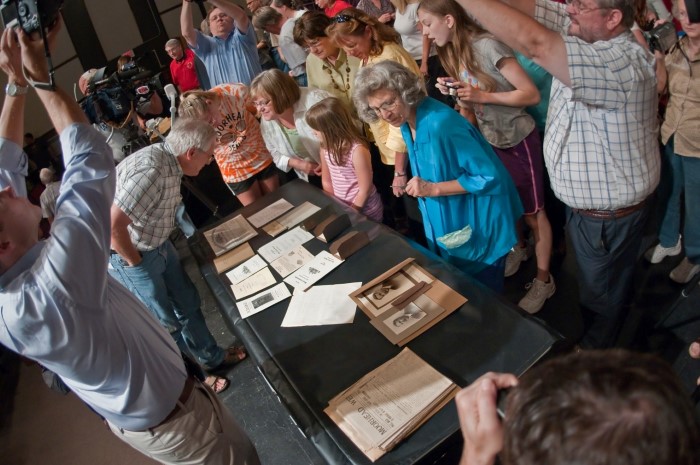
Minnesota State University Moorhead staffers opened a time capsule this afternoon, and they found material from an early period in the university’s history.
In a zinc-and-copper box were a slew of well-preserved photos and documents — playbills and music programs, course descriptions and school publications — depicting life in and around the university in 1915.
One newspaper article told the story of a shooting in Fargo. And another stated that construction of Weld Hall had cost $72,000. It’s all gold for the university, which lost practically all of its records in a 1930 fire.
“This was really a shot in the arm,” said Doug Hamilton, Moorhead’s director of public relations. ”The archivist was so impressed with the condition, and there was some stuff he didn’t have.”
Also in the 15-inch-by-12-inch box was a blank Moorhead Normal School diploma, a publication promoting Moorhead and its Normal School, a funeral notice, a flyer with the school’s educational offerings, and an invitation to an alumni event.
Workers had stumbled upon the capsule just this past Friday while renovating Lommen Hall. To their surprise, they came across the corner stone for Weld Hall. (Apparently, the two buildings are joined.) Within the cornerstone was the capsule.
The memorabilia will be copied and displayed, and Hamilton said the university will likely return the copies to the capsule — along with items from 2010. They’re mulling over what to put in, but so far have considered a video and some material reflecting student opinions of the day.
Story adapted from Minnesota Public Radio news release, August 17, 2010
Objects Recovered from Time Capsule
Newspaper Advertisements
- 1913 Northwestern Hospital
- 1913 Cancer Treatments
- 1913 Star Implements
- 1913 Duke's Tobacco
- 1914 Northern Pacific Railway
- 1914 First State Bank
- 1914 Moorhead Bank
- 1915 Lyceum Appearance
- 1915 Moorhead Lumber
- 1915 Land Sales by Comstock Realty
Newspaper Stories
- April 17, 1913 Normal Notes
- September 4, 1913 Normal Notes
- September 25, 1913 Normal Notes
- Normal School Bill Passes
- Normal Summer School Session
- President Weld has Returned
- Weld to Speak at Congregational Church
- University Farm Notes
- University Alumni Congratulate President Northrop
- Welter Named Normal Director
- Commends State Normal Board
- Red River Navigation
- Brick Laying at New Normal Building
- An Appalling War Spectacle
- Await Outcome of Russia's Plan
- Capture of 60,000 Teutons Claimed
- French Army Commander
- French Declare German Attacks Prove Unavailing
- French Military Commanders See End of Aisne Battle
- German Irritation Grows
- Germans Taking Offensive Against Russians
- Japanese Troops Invest Tsing-Tao
- Wilson Will Act With Firmness
- Minneapolis Men Aboard Lusitania
- Will Report to the German Consul
- Rush Reinforcements Against German Wings
- Russian School Children Killed by German Bomb
- Russians Invade Hungary
- Turkish Abrogation In Effect
- Turkey Enters War
- Sinking of Lusitania
- War Developments
- War Sure to Spread in Eastern Europe
Bulletins
- July 1914 Bulletin
- August 1914 Bulletin
- October 1914 Bulletin
- December 1914 Bulletin
- March 1915 Bulletin
Programs & Special Items
- 1914 Annual Recital Program
- 1914 Concert Program
- 1914 Commencement Program
- 1915 Alumni Reception
- Tribute to Lew Huntoon
- April 15, 1915 Moorhead Federated Women's Club Minutes
Miscellaneous
Administration announces that in fiscal 2009-10, MSUM raised greater sums for scholarships than ever before, bringing in $1,058,024 in endowed funds and $369,902 for annual scholarships.
Mass Comm students win Emmy for their TV Documentary, "Inspired by Nature."
University chapter of Public Relations Student Society of America wins 2nd place in national PR competition with campaign promoting "The Vampire Diaries."
Russ Colson, Professor in the Department of Anthropology and Earth Science, is honored by the Carnegie Foundation as professor of the year.
Men's Basketball celebrates 14-8 season, 2nd place in NSIC conference.
After Sodexo Food Service workers vote to unionize, students hold rallies at Kise to support workers who want a raise.
Flood number 3; Advocate comments "Spring weather officially sucks."
875 students receive degrees, but underclassmen worry about continued rise in costs.
9-11 memorial gathering combines Tower remembrance with celebration of death of Bin Laden.
Brief flurry of worry as U.S. House nearly cuts Pell Grants programs. Can college costs be stabilized?
The Corrick Center is closed, with Murray Commons to be used for other purposes.
Library, Information Technology and Instructional Technology make preparations for major remodel of Livingston Lord Library.
Sanford Health makes $2 million donation to Dragon Athletics. Much of this will be used for scholarships.
Campus Realignment Task Force considers plans to reorganize academic departments into new colleges.
Task Force is formed to plan 125th anniversary of the University in 2013.

